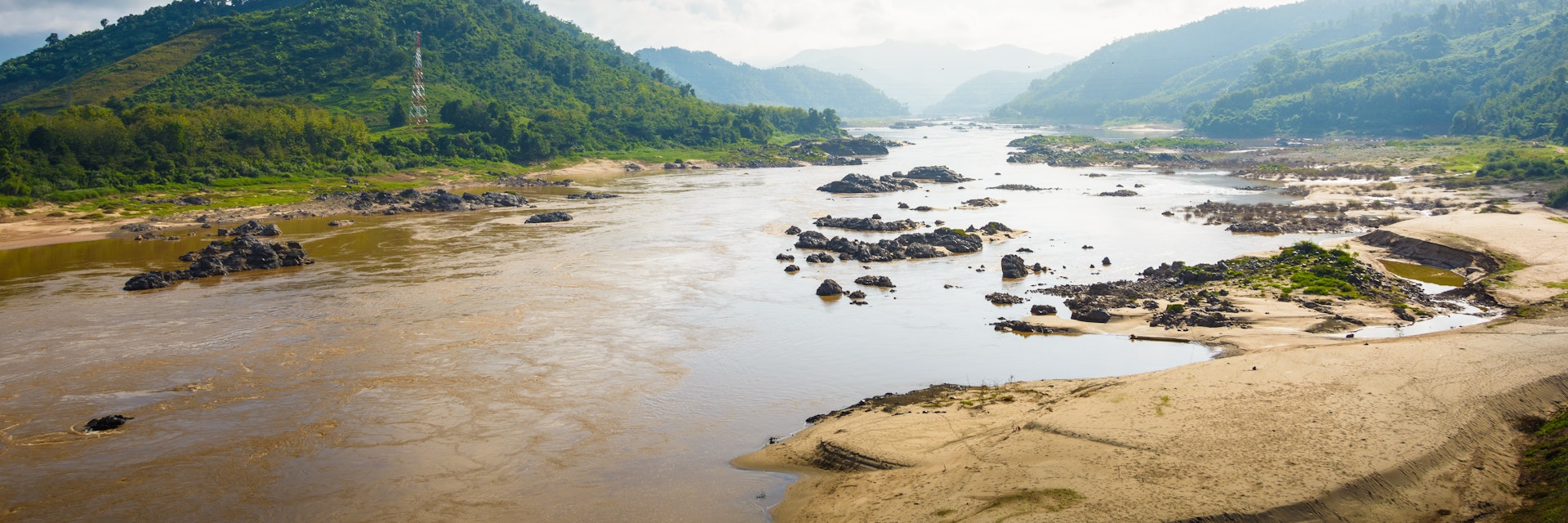
Getty Images/iStockphoto
Northern Laos
Whether it's for trekking, cycling, kayaking, ziplining or a family homestay, a visit to northern Laos is for many the highlight of their trip. Dotted about are unfettered, dense forests home to big cats, gibbons and a cornucopia of animals, with a well-established ecotourism infrastructure to take you into their heart.

Your next trip starts here
Go from dreaming to planning with trip planning options made to help you craft your ideal itinerary.
Attractions
Must-see attractions.

Vieng Xai Caves
Joining a truly fascinating 18-point tour is the only way to see Vieng Xai's seven most important war-shelter cave complexes, set in beautiful gardens…

The 2224-sq-km Nam Ha NPA is one of Laos' most accessible natural preserves and home to clouded leopards and possibly a few remaining tigers. Both around…

UXO Information Centre (MAG)
Decades after America's Secret War on Laos, unexploded bombs and mines remain a devastating problem throughout this region. Visit the thought-provoking…

Hintang Archaeological Park
Almost as mysterious as Xieng Khuang's more famous jars, this unique, unfenced collection of standing stones is thought to be at least 1500 years old…

Phongsali's famous tea village, Ban Komean, lies 14km out of town and commands stupendous valley views that sweep nearly 360 degrees when you stand on the…

Plain of Jars
The biggest and most accessible, Site 1 of the Plain of Jars features over 300 jars relatively close-packed on a pair of hilly slopes pocked with bomb…

Kao Rao Caves
Well-signed beside Rte 3, 1.5km east of Nam Eng village, is this extensive, accessible cave system, which has a 700m section open to visitors. The main…

Phanoy Cave & Viewpoint
Well-signposted from the northern end of the main strip, the Phanoy Cave is a cool relief on a hot day. The cave lies about halfway up a steep track that…
Purchase our award-winning guidebooks
Get to the heart of Northern Laos with one of our in-depth, award-winning guidebooks, covering maps, itineraries, and expert guidance.
Northern Laos and beyond
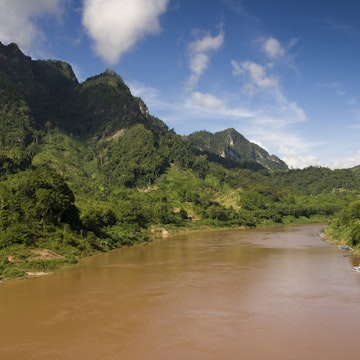

Northern Laos Itinerary: The Perfect 10-Day Loop
This loop Northern Laos itinerary starts and finishes in Vientiane, Laos’ capital city. It doesn’t exactly look like a loop on the map because you actually need to take the same road to leave and go back to Vientiane.
The itinerary covers the two main gateways in the north of Laos – Vang Vieng and Luang Prabang, along with Phonsavan where you will learn about a terrible period of the country’s History. It is a well-balanced itinerary with a good share of cultural discovery and natural beauty.
The Itinerary at a Glance
- Trip Type: Backpacking, independent travel
- Itinerary Shape: Loop
- Starting Point: Vientiane
- Ending Point: Vientiane
- Duration: 10-12 days
- Mean of Transport: Bus
- Main Stops: Vientiane, Vang Vieng, Luang Prabang, Phonsavan
The quiet capital city of Laos was built on the left bank of the mighty Mekong River and is home to about 800,000 inhabitants. It is reachable by air via its international airport, or by bus from Thailand.
It sometimes has a reputation of not having much to see for tourists but it is totally untrue! Obviously, it is not Paris or New York City but you can still find enough things to visit to keep you busy for a couple of days. For example, if your flight arrives in the middle of the day, you can plan to start visiting a few things in the afternoon plus the following full day.
Let’s keep this example of arriving mid-day. The afternoon could be spent relaxing from your long trip and strolling along the Mekong River, discovering the Chao Anouvong Park and the Quai Fa Gnum. Watching the sunset on the river from the promenade is wonderful. In the evening, the night market takes place.
On the next day, after a good sleep, you can spend the day discovering the cultural heritage of Vientiane. The number one attraction you can’t miss is the That Luang golden stupa. It is the most famous landmark of Vientiane and a symbol in the whole country. Another popular visit is the temple of Wat Si Saket.

Vientiane → Vang Vieng
- Bus: 160 km (100 mi), 3-4 hours
Vang Vieng has long been a tourist’s paradise. The incredible beauty of its landscapes has been attracting visitors from all over the world for decades, and the destination is still booming.
The town of Vang Vieng was built along Route 13 and the Nam Song River, and this river alone provides good activity opportunities such as kayaking. Vang Vieng is a paradise for active holidays. Tours and activities include:
- Tour to the Water Cave (Tham Nam): you need to drag yourself by a rope while sitting in a tube, to explore an underground river. It is a little touristy but gives fun memories!
- Blue Lagoon: Often in the package with the Water Cave, the Blue Lagoon is a natural pool with clear waters where tourists like to swim or jump into the water from a big tree. There is also a cave to explore nearby.
- Kayaking the Nam Song River: This is probably the # must-do in Vang Vieng, and many times a bit of kayaking will be included in tours that the local agencies offer.
- Cycle the gorgeous countryside: This is one of my best memories of Vang Vieng. You can find a bicycle or a scooter for rent very easily and venture away from the town exploring villages, rice paddies and find yourself surrounded by the characteristic hills. → Read the full article here!

Vang Vieng → Luang Prabang
- Bus: 185 km (115 mi), 5 hours
You have once again various options that you can find by asking your hotel or by directly going to the bus terminal. Minivans tend to be faster than buses. Old and slow local buses can take something like 8 hours to do this trip.
If you prefer to see bus options and book it directly online, you can use the search form below.
Luang Prabang
Luang Prabang is the former capital of the legendary Kingdom of a Million Elephants, Lan Xang (1354-1707). Nowadays, it is one of the prettiest cities in Laos with splendid temples and charming French colonial architecture.
It has been declared a UNESCO World Heritage site in 1995. Luang Prabang is a great base to explore all the wonders that nature and culture have to offer in the region, starting with the legendary Mekong River.
The region is also renowned for its waterfalls, and if you want to get close to elephants it is the right place to do it. Here are some ideas of what to do for a few days in and around Luang Prabang:
- Temples of Luang Prabang: The city is home to beautiful temples, including Wat Xieng Thong, Wat Mai, and Wat Visounarath.
- The Royal Palace: It is home to a museum telling the history of Luang Prabang.
- The night market: On the street next to the Royal Palace, every evening, the night market takes place. There are many things to be found there, including beautiful souvenirs.
- Mount Phu Si: Again in front of the Royal Palace, starts the trail going up to the top of Mount Phu Si. From there, a fantastic panorama awaits you over the whole of Luang Prabang and the Mekong River. Particularly popular at sunset.
- Tad Sae & Kuang Si Waterfalls: The two most popular and beautiful waterfalls around Luang Prabang. They feature swimming areas where you can relax and enjoy the turquoise waters. If you can, do the trek to the Tad Sae Waterfall, to be immersed in the Lao countryside and villages. → Full Article about the waterfalls of Laos here!
- Elephant camps: Luang Prabang is the ideal place to get close to and ride elephants. I know about the controversy that exists about tourists riding elephants. While we all like wild and free animals, sometimes the elephants are in these camps because they got saved from much worse conditions. In any case, the choice is up to you.
- Pak Ou: Pak Ou is a village famous for its caves overlooking the Mekong, turned into religious shrines. Some elephant camps are also in this area.

Luang Prabang → Phonsavan
- Bus: 260 km (162 mi), 6-7 hours
As always, you can ask your guesthouse or go directly to the bus terminal to buy a ticket. There is a bus leaving every morning for Phonsavan (Xiengkuang) at 8:30 which costs 75,000 kips. The road is once again crossing amazing mountains but the snaky road has many sharp turns.
Phonsavan, in the Xieng Khouang Province, is much less touristic than Vang Vieng and Luang Prabang. Located at a higher altitude, the climate is cooler.
There is not much to see in the city itself, but I found it to be a very interesting stop for the Plain of Jars, and also to learn about a dark page of recent Laos’ History.
The region of Phonsavan was very badly hit by the secret war that the Americans were leading in parallel with the Vietnam War. Nowadays, the country’s development is still penalized by all the mines still buried here and there in the countryside. A touching and interesting story to discover.
In spite of all the efforts made to clean up the mines, some areas are still risky. When I arrived at my guesthouse, the guy explained that they can’t let tourists just go wherever they want because they might put themselves in danger.
You can book a tour from them, it’s the most convenient option. You will be presented with various things to see in the area and you can choose what you want to visit. Here I will list some of them:
- Plain of Jars: Probably the primary attraction of Phonsavan, this strange and mysterious archaeological site is huge and is made of dozens of different sites. As a tourist, you will probably visit one or two. I visited Site 1 and Site 2, Site 1 was the best. → Read the full article here!
- “Bomb Village”: This village of the Hmong community is famous for using bomb remains to build part of their houses or other things.
- Bomb craters: They can take you to a spot in the countryside where you can see impressive craters made by American bombs that got dumped on the Laotian countryside.
- Tham Piu Cave: In 1969, a US jet fired a missile into that cave killing 374 innocent farmers who were trying to hide from the bombings. I personally didn’t visit this cave but it must be quite touching.
- The MAG (Mines Advisory Group) Museum in Phonsavan: A small museum, or rather an exhibition room presenting the UXO that are poisoning the life of this region of Laos. There is also a video you can watch. Entrance is free. An interesting visit for your free time in town. → Read the full article about the Xieng Khouang Province here!

Phonsavan → Vientiane
- Bus: 350 km (220 mi), 10 hours
There are 6 buses per day to Vientiane from 7am to 8pm. Depending on how much time you have available, it can be a good idea to take the 8 pm one and arrive in Vientiane the next morning. The ticket should cost about 110,000 kips.
Last Thoughts About This Itinerary
This is the most common and most convenient way to visit the highlights of Northern Laos. This trip is rich in History (Luang Prabang, Phonsavan), in jaw-dropping landscapes (such as the one around Vang Vieng or Luang Prabang’s waterfalls)) and experiences (like getting close to elephants).
Some of you might notice that another destination could have been included in this Northern Laos itinerary: Luang Namtha.
Luang Namtha is located north of Lang Prabang, and it is a trekking land. I personally did not go there so I don’t have much to recommend here, but if you have the time to include it in this itinerary it’s probably well worth it.
If you have more time (such as 3 weeks for example), you can definitely see more than the north of Laos and venture to the center and the south of the country. For instance, you could take a bus from Phonsavan to Savannakhet or Thakhek to see the nearby caves.
Julien is an exploration-minded, curiosity-driven traveler and blogger. On a mission to witness the planet's natural beauty and diversity, he shares his experiences on this website through articles, videos, and photography, including interactive virtual tours.
Fascinated by animals and plants since young, he is also fond of outdoor and so-called extreme sports, often discovered while traveling and practiced back at home where he focuses on improving his knowledge and skills - so he can explore further on the next trip!
More About Me
You May Also Like

Rare Exploration Of The Gigantic Xe Bang Fai Cave, Laos

Trek To Lost River Waterfalls in Hin Namno National Park, Laos

Most Beautiful Waterfalls in Laos – Where and How To See Them

Meet The National Bird of Laos, The Siamese Fireback

Cycling The Gorgeous Countryside of Vang Vieng, Laos

The Plain Of Jars, Laos – One of The Most Mysterious Sites in The World
20 comments.
Coralie Grassin
Wow , quite a wonderful itinerary, well detailed… and includes so many adventures!
Thanks Coralie!
This is a fantastic itinerary and I would love to do this. I think I would like to visit Vang Vieng more than everything, get on the bike and explore the landscape. Fantastic blog 🙂
Vang Vieng has one of the best landscapes of Laos for sure! Thanks for your kind words 🙂
What a detailed itinerary! You’ve certainly covered a lot here and created a really helpful resource for anyone wanting to explore Laos!
Thank you Holly, glad you find it useful!
I found this post SO informative and well structured, thank you so much for being clear, everything is at hand!
Thanks Dany, happy that you enjoyed it 🙂
That is one detailed itinerary. This is a fabulous road map and a great trip-planning resource.
Thanks Catherine!
Laos has been on my list for over a decade. This is a great itinerary. I would love to go cycling in Vang Vieng. It’s a great way to take in the scenery.
Laos is amazing! And Vang Vieng has the most beautiful scenery
Itineraries like this are so useful, especially for lesser known countries as Laos. Great info and resource. Looks like you’ve also enjoyed this country immensely.
I enjoyed Laos a lot, it’s a fantastic country to discover. Happy that you find this itinerary useful 🙂
I love a well detailed itinerary that offers up everything from markets to waterfalls and everything in between. The bus travel may be difficult for our family, but the information at each destination is super useful! My kids would enjoy alot of these activities.
It’s true that the bus rides are long and the roads are not always easy, but it is often well worth it! Lots of things to discover
This is great! I read a lot about people traveling in Thailand, Cambodia, and Vietnam, but never so much about Laos! Some of these cities I’ve never even heard of before! It sounds like Laos deserves more time than many people give it.
Yes Laos is a little forgotten in the middle of tourism heavyweights, but it is a really charming country with very nice people!
never heard of this wonderful place! I have to visit it, thanks!
Yes you should!
Leave a Comment Cancel reply
Notify me of follow-up comments by email.
Notify me of new posts by email.
Our local experts can design your trip based on your preferences

Warning - You are using an outdated browser. Please upgrade your browser to properly view this website.

- Destinations
- Asia pacific
- Northern laos
Northern Laos travel guide
The northern half of Laos extends from the tiny capital city, Vientiane , to the picturesque old royal capital, Luang Prabang and beyond into the remote forested hills which extend for mile after mile up to the borders of Burma, China and Vietnam. The mighty Mekong river is still a major transport artery in this Asian backwater.
This wild and mountainous region has long been a natural path of migration for a wide variety of peoples; many of them – intentionally or otherwise – ended their peregrination in these hills. The cultural and ethnic ancestors of the Lao people, the Tai, originated just to the north in China’s Yunnan province.
The People of Laos
Northwestern Laos is home to a large number of colourful Tibeto-Burmese peoples, such as the Yao, Hmong and Akha. The Lao government now collectively refers to these groups as Lao Sung or “High Lao”, a reference to the mountain tops that they have historically chosen to inhabit. In Luang Nam Tha province these “ethnic minorities” are in fact a majority, outnumbering the Lao by two to one.
Laos and its neighbour, Vietnam
The northeastern provinces of Xieng Khuang and Hua Phan owe much of their history and character to their proximity to Laos’s eastern neighbour, Vietnam; indeed, both of these provinces have existed more often as independent statelets, or vassal states, of Vietnam than as part of a Lao political entity. Although the scars of war remain, northeastern Laos has much to offer the visitor. The local people have put the past behind them and bear no ill will to foreigners. Fascinating – and as yet not fully explained – archaeological site, notably the Plain of Jars , rugged mountainous terrain and a plethora of ethnic minorities make this remote, sparsely populated region well worth a visit.

Places to visit in Northern Laos
Luang prabang.
The major sight in northern Laos is the beautiful city of Luang Prabang, all mystical golden temples, colonial architecture and quiet streets with a wonderful riverside setting. Read more
The Plain of Jars
To the east of Luang Prabang, the Plain of Jars is a mysterious and compelling experience. Read more
One of the world's smallest capital cities, Vientiane, has a pleasant ambience. Read more
The varied attractions of Vang Vieng, approximately halfway between Vientiane and Luang Prabang, are much loved by backpackers. This small town has an idyllic location, and offers an abundance of adventure activities and a very lively bar scene.
Vieng Xai and the Pathet Lao Caves
Further off the beaten track, even by Lao standards, is the ravishing karst scenery of Vieng Xai in the far northeast. The Pathet Lao caves, where the communist guerilla leaders sheltered from the incessant US bombing in the mid-1970s are a fascinating sight.
The Far North: hilltribes and river adventures
The countless hilltribe villages of Phongsali province in the northwest and exciting river journeys along the Mekong and Nam Ou. The area is one of the last frontiers of true adventure travel in Asia.
Average customers rating

{{_ "pagesAdmin.destinations.overviewCulturalFeaturesIn"}} {{currentName}}
{{_ "pagesAdmin.destinations.overviewViewAllFeatures"}} {{currentName}}
{{_ "pagesAdmin.destinations.overviewHistoricalHighlights"}} {{currentName}}
{{_ "pagesAdmin.destinations.overviewViewAllHighlights"}} {{currentName}}
Places to visit in Northern laos
- Luang prabang
- Plain of jars
Read more from the travel guide to Laos
- Top attractions
- Historical highlights
- Cultural features
- Plan your trip
- Top restaurants
- Top cafes and bars
- Useful phrases


15 Best Things to Do in Nong Khiaw, Laos (2024)
Located in the beautiful northern region of Laos lies Nong Khiaw, a sleepy town nestled between two majestic mountains on the banks of the Ou River. This picturesque landscape provides a peaceful backdrop for a plethora of activities. From climbing mountain peaks to relaxing herbal steam baths, Nong Khiaw offers it all. So if you are looking to explore this stunning region of Laos, here are the 15 best things to do in Nong Khiaw.
Nong Khiaw in Laos
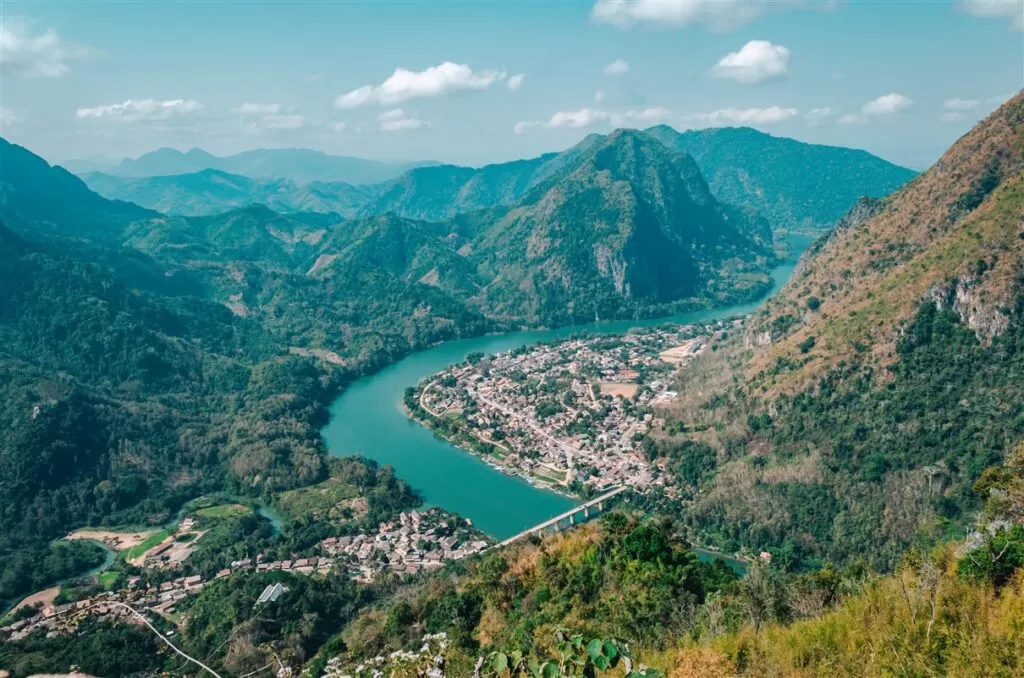
Nong Kiau, Laos
Nong Khiaw’s location is idyllic. Nestled between two mountains and the center divided by the mighty Nam Ou river, it’s a place where dreams are made of.
Tourism is well on its way here and Nong Khiaw counts multiple tour agencies, a plethora of guesthouses, and a bunch of tasty restaurants. Even though it’s the north of Laos, if you’re looking for seclusion, this is not the place to be anymore.
Even though Nong Khiaw is lovely and you can still witness authentic Lao life here, there were a few things that were also a little bit worrying.
The main thing was that children are asking the tourists for money on the streets. Even while holding the hands of their parents, they just stopped on the street, asking you to give them money.
Another sad thing that one of the restaurant holders told me is that almost every building in Nong Khiaw has been bought up by rich Chinese businessmen. The Laotians living in Nong Khiaw now have to pay rent to the Chinese and who knows what other plan they might have with Nong Khiaw.
As a conscious traveler , it’s important to take these things into account when traveling to Nong Khiaw. Don’t give the children money. Even though they might be poor, that’s not the way to help them and they can’t get used to it.
Secondly, try to spend your money as locally as you can. Eat at local restaurants, stay in a homestay, and make conversations with local Laotians that speak a bit of English to learn about their situation.
all that aside: Nong Khiaw is absolutely worth a visit!
Nong Khiaw: Things to do
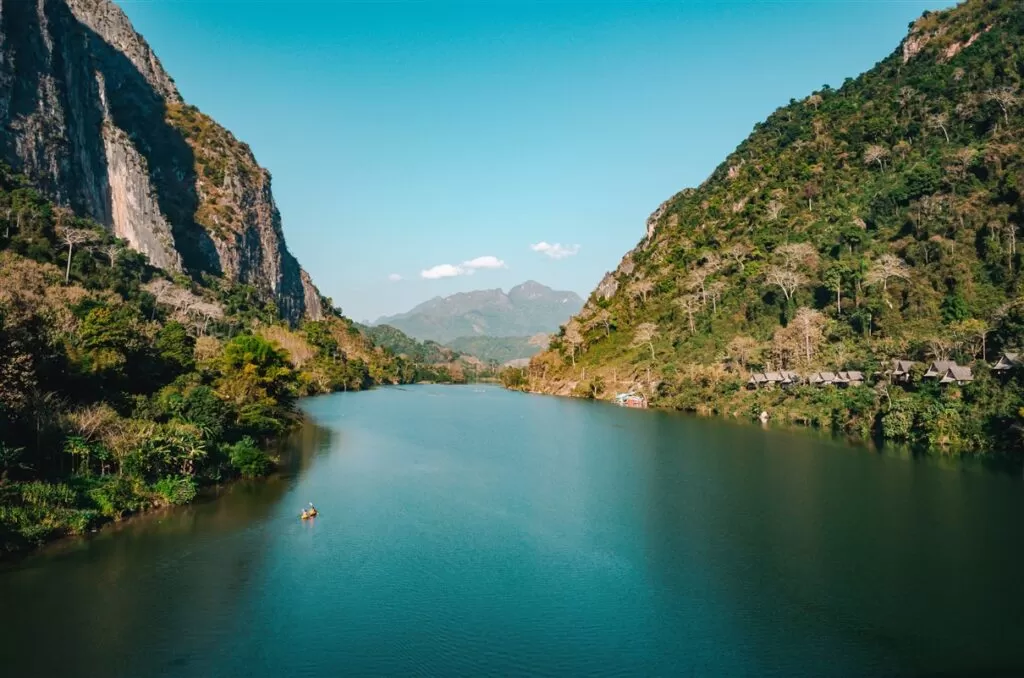
Nam Ou River, Nong Khiaw Laos
If you are wondering what to do in Nong Khiaw, I’ve got you covered! Nong Khiaw’s location between limestone mountains and the views dominated by the river are sensational. Here are the 15 best things to do in Nong Khiaw!
Explore the center of Nong Khiaw
Nong Khiaw’s center is a perfect size. It’s big enough to wander around but small enough to explore all of it on foot. The scenic views on the Nam Ou river are incredible, especially at sunrise and sunset.
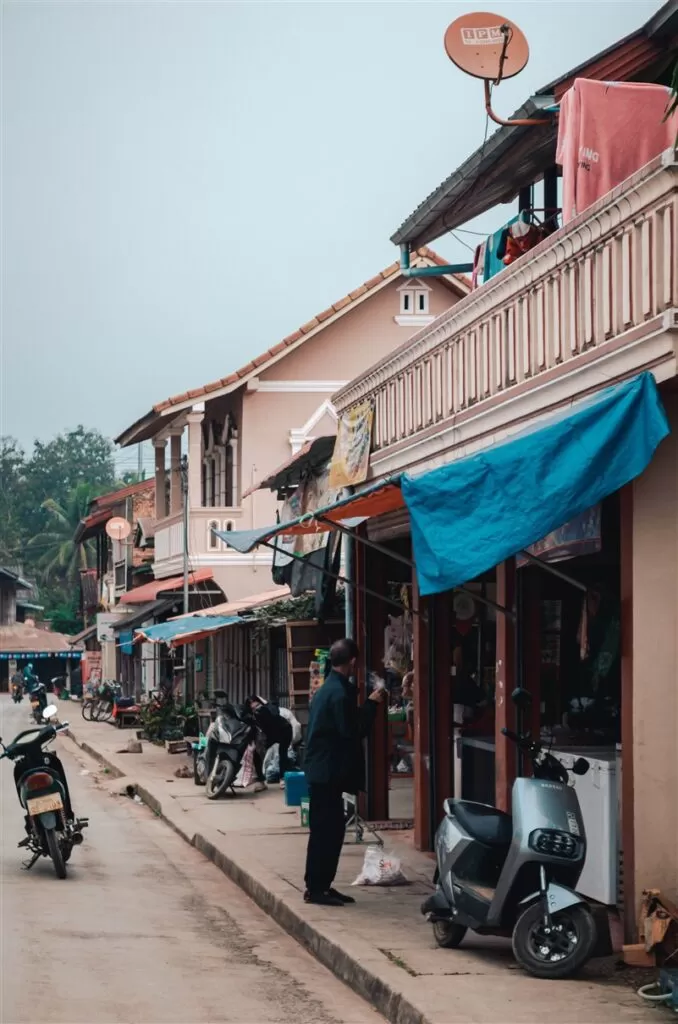
The center of Nong Khiaw
Boats that go up and down the river, hill tribe people coming down from the mountains and rowing their boat across the river to sell their goods on the market. You can sit and watch daily life pass by for hours here, without getting bored!
Most people stay at the touristy side of town on the right hand of the river when facing the direction of Muang Ngoi (which is actually already another village called Sop Houn). But it’s also worth it to explore the “real” center of Nong Khiaw. The small streets between the bus station and the bridge are where true local life is happening away from the tourist spots.
Climb Pha daeng Peak
One of the main attractions in Nong Khiaw is climbing one of the beautiful limestone mountains and Pha Deang Peak is the most scenic one. The starting point of the trail is called Nong Khiaw Viewpoint Trail Entrance and Ticket Office on Google Maps.
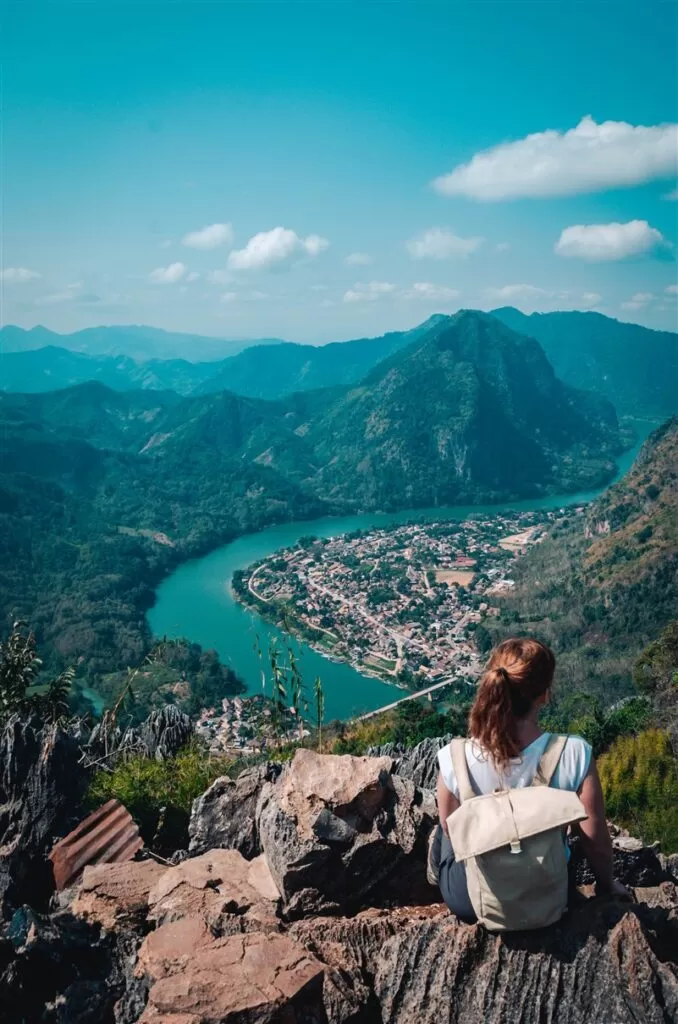
Phadeng Peak, Nong Khiaw viewpoint, Laos
Climbing up the peak takes one and a half hours if you have a normal level of fitness and the entrance fee is 20 000 kips. There are a few resting areas on the way with benches and bins.
Bring enough water en maybe a snack because there’s no possibility to buy this on the way!
Pha Deang Peak is a community project and a part of the money funnels back into the local community. Do be aware to stay on the path when you hike up the mountain. In the area are still unexploded bombs, like in many locations in Laos and Cambodia.
Visit Pha Tok Caves
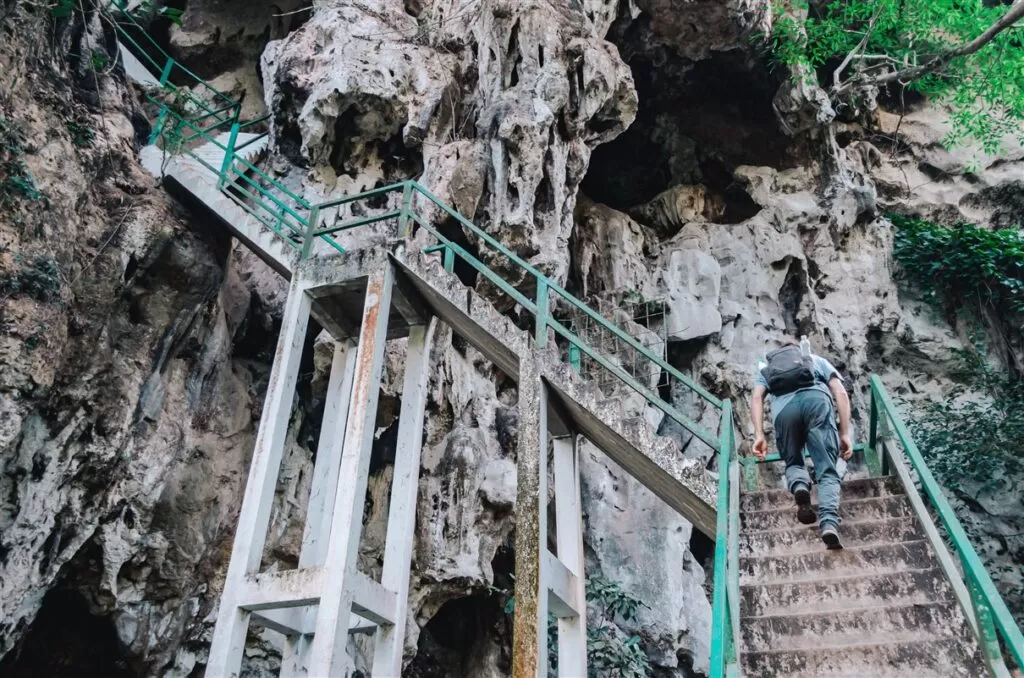
Nong Khiaw things to do: Pha Tok Caves
The Pha Tok caves are located a little bit out of the center of Nong Khiaw, around two kilometers from the bridge. The Pha Tok caves consist of three caves that were of significant importance for the Phatet Lao as a hiding place during the Laotian Civil War.
The caves themselves aren’t that impressive and you mainly come here for the history behind the caves and the beautiful rice paddies and mountains that surround the caves.
The entrance fee was 15 000 kips at the time of my visit (Jan 2023). At the start of my walk, a man started to follow me to the caves. I kindly said that I didn’t need a guide and he took off but I heard from other people that he joined unwantedly and asks for money afterward.
The caves are not that well maintained either. There is no light inside the caves, so you will need a flashlight. There are signs with a little information inside the caves but you can’t read it without a flashlight.
To find the second and third caves you will need to do some hiking through the jungle and banana plantations.
There’s a second cave site in Nong Khiaw called Pha Kuang Cave.
→ Also read: Tham Chang Cave: Everything You Need to Know
Explore the Nam Ou River
There are many ways to enjoy the Nam Ou river in Nong Khiaw. Swimming after a fun day of hiking is one of them but you can also opt to rent a kayak or a boat.
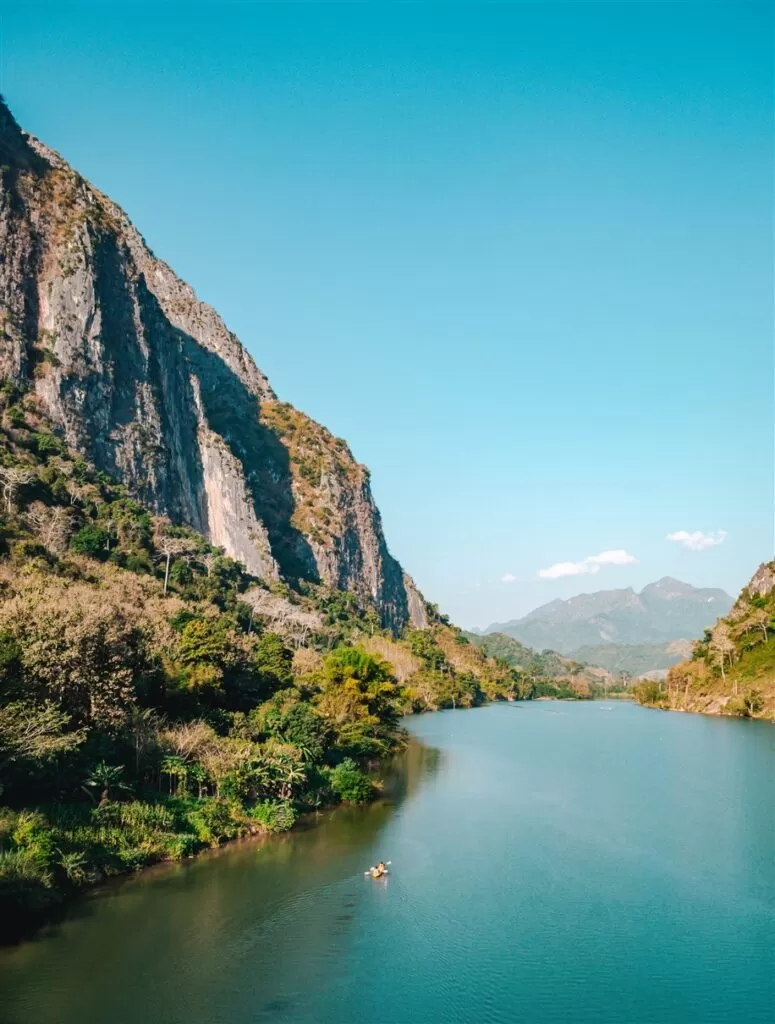
Nong Kiau riverside, Laos
Kayaks can be rented at various travel agencies in Nong Khiaw and even some of the guesthouses have kayaks for rent. Do note that the current can sometimes be strong so watch out that you don’t go too far downstream.
Another way to explore the Nam Ou river is to hire a local boatman for the day to take you around the area. You can arrange a tour with a tour agency but a private boat is more comfortable because you can put together your own itinerary.
Cycle to local villages
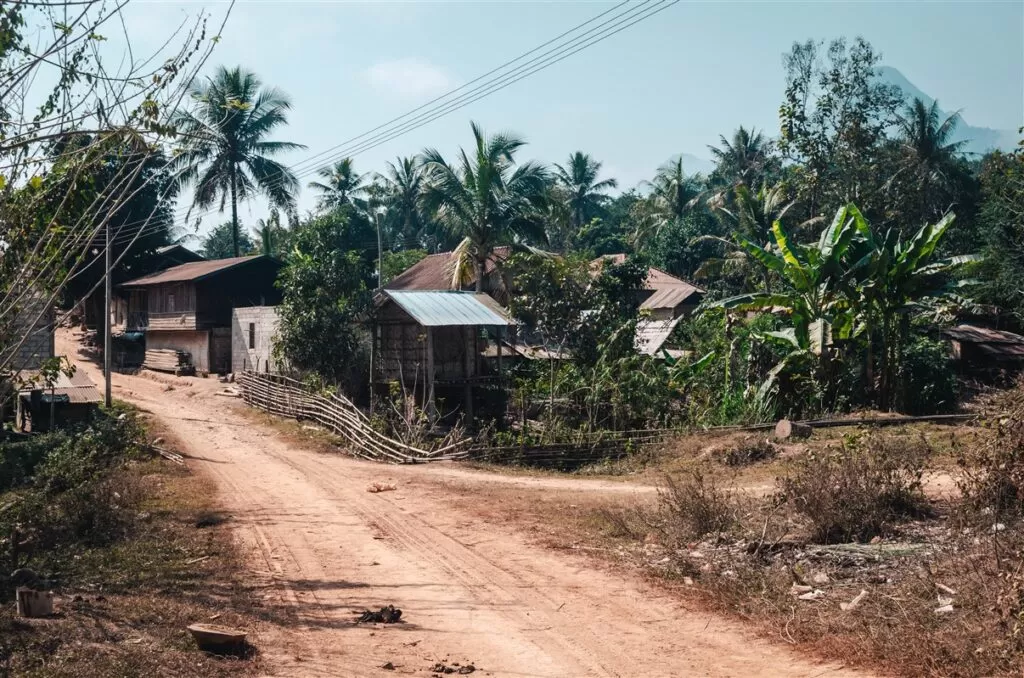
Local villages near Nong Khiaw
There are a dozen of local villages around Nong Khiaw and cycling around is one of the best ways to explore them. Do note that you will need good mountain bikes with gears to explore the area.
The region is pretty hilly and, aside from the main road in Nong Khiaw, the streets are not in the best shape.
The most fun road and villages are the ones located at the banks of the Nam Ou in the direction of Muang Ngoi.
Take a steam bath
For a traditional Lao experience and to relax after a long day of hiking and cycling, try a herbal steam bath in Nong Khiaw.
There is a little place on the main road that is called Traditional Lao massage & herbal steam sauna on Google Maps. It’s very local but you are warmly welcomed and the place is cozy and clean.
Herbal steam baths are possible every evening between 6 and 8 P.M. and only cost 15 000 kips. A good Lao massage costs 80 000 kips.
Sabai Sabai is another massage parlor with a steam bath in Nong Khiaw but I heard mixed stories about their service.
check out local broom making
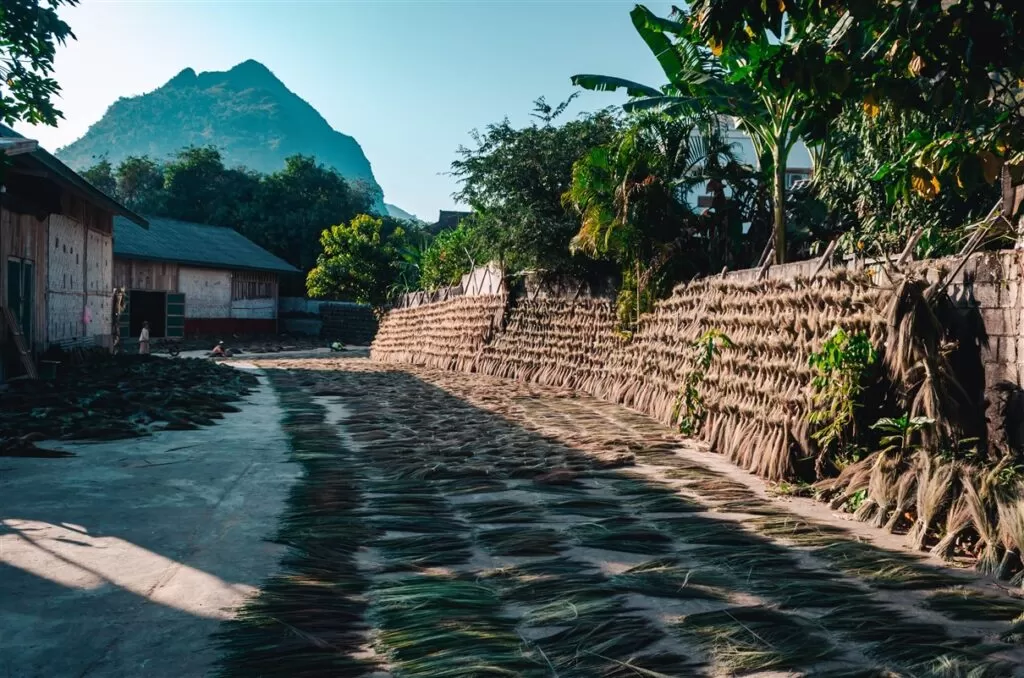
Local broom making, Laos Nong Khiaw
As you walk through the streets of Nong Khiaw and also in the surrounding villages you can witness broom making, one of the main livelihoods of the local Hmong villages.
The brooms are made from local wild grasses that are first dried before they get attached to a stick. Afterward, they are distributed all over Laos!
Tad Mook waterfall
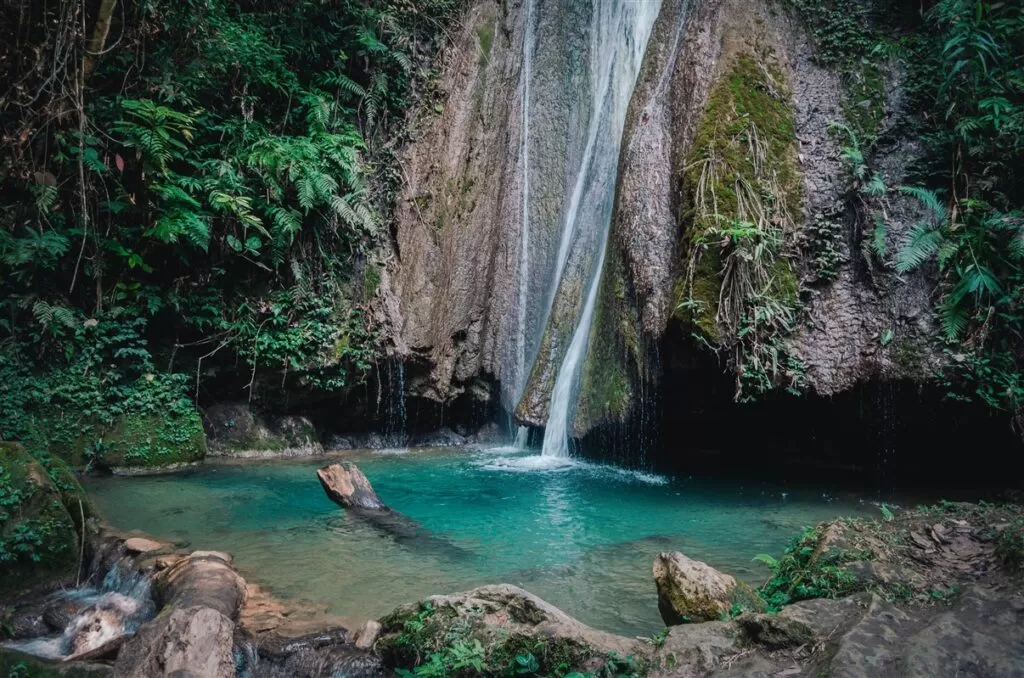
One of the best things to do in Nong Khiaw is to visit Tad Mook waterfall. Tad Moo waterfall is located in Sop Kong village around 15 kilometers from Nong Khiaw.
The location of this waterfall is stunning and the road to get there from Sop Kong village is one of the most scenic in the area through beautiful rice fields and past meandering g streams.
The entrance fee is 10 000 kips and the money goes towards the local community of Sop Kong. The best way to get to Tad Mook from Nong Khiaw is by taking a tour or renting a private boat. Alternatively, you can also ask the boat to Muang Ngoi to drop you off in Sop Kong for 30 000 kips and hike back to Nong Khiaw afterward.
→ Also read: Kuang Si Waterfalls: Heaven on Earth in Laos
Visit the morning market
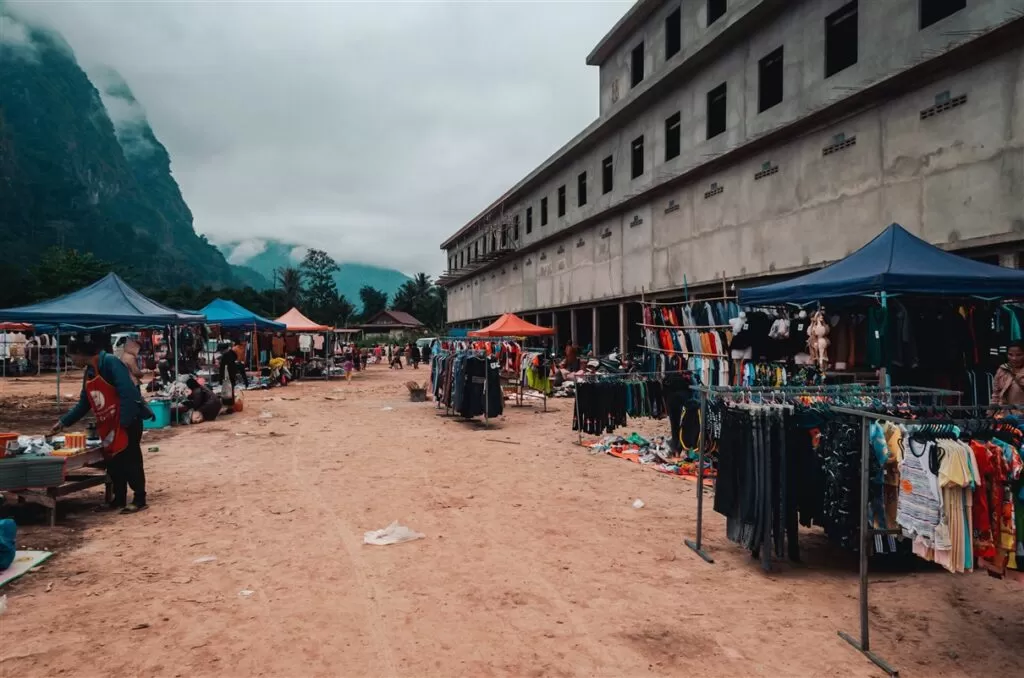
Morning market, Nong Khiaw, Laos
A great way to experience the local culture of the north of Laos is to visit the local market. Early in the morning, you can hear boats cross the Nam Ou river. These are the hill tribe people that come to Nong Khiaw town to sell their goods on the morning market.
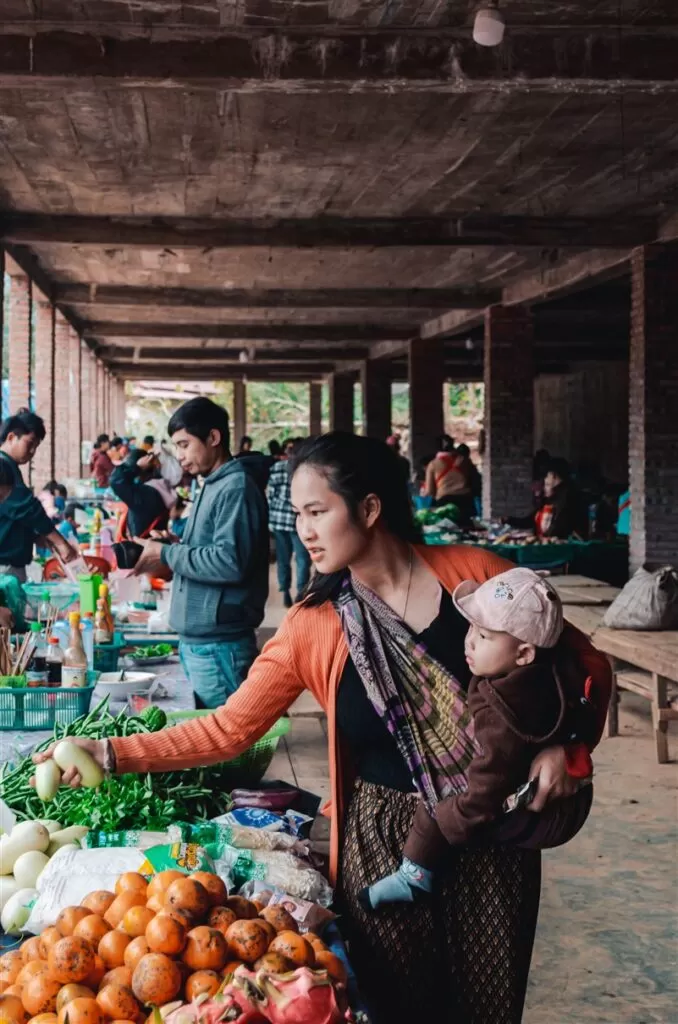
Morning market
At the market, you can find regular things like fruit and vegetables, local cakes and soup and noodles but also a few things that might shock you like rats on a barbeque and poisonous spiders for sale.
The market is more elaborate during the weekend, including extra stalls with clothing and household gear. Note that the location in Google Maps is wrong. The morning market is now located on road 1C near the bus station.
→ Also read: Luang Prabang Night Market: All You Need to Know
100 waterfalls trek
Advertised everywhere in Nong Khiaw by tour agencies is a boat trip plus a hike to the 100 waterfalls in Don Khoun, a village about 15 kilometers downstream from Nong Khiaw. It is only accessible by boat so you will need to book a tour to get there.
As I was traveling on a budget and there are so many other activities on offer in and around Nong Khiaw, I can attest to what the experience is like myself. I did compare prices in Nong Khiaw and it’s worth it to shop around. Prices are based on how many people participate in the tour so the more people, the less you will need to pay!
→ Also read: A Complete Guide to Tat Sae Waterfalls (Luang Prabang)
Take a day trip to Muang Ngoi Neua
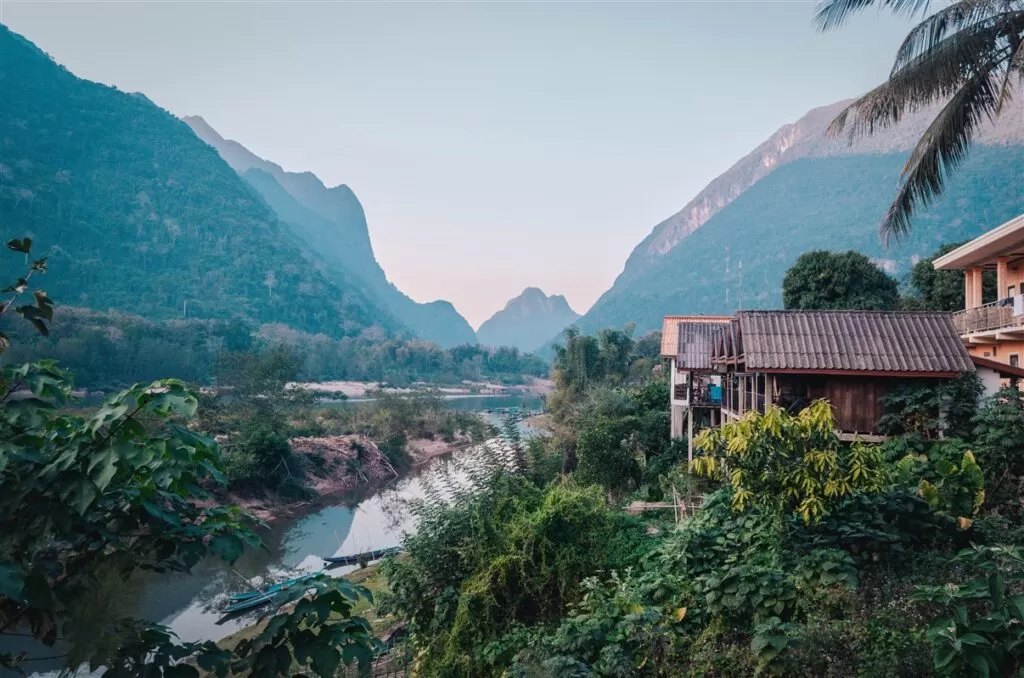
Muang Ngoi, Laos (southeast Asia)
I can highly recommend exploring Muang Ngoi for longer than one day but, if you have little time on your hands, taking a day trip is a great option.
Muang Ngoi is a small Laotian village , about a one-hour boat ride upstream on the Nam Ou River. although it has a pretty isolated location, it has already become a well-known spot on the banana pancake trail and you find a dozen of guesthouses and restaurants here that cater to tourists.
That doesn’t take away the charm of the surrounding area and at Muang Ngoi you can enjoy similar activities as in Nong Khiaw. There are a few interesting viewpoints and caves, you can explore local villages, hike to Tad Mook waterfall or chill on Nam Ou beach.
Go in search of secret waterfalls
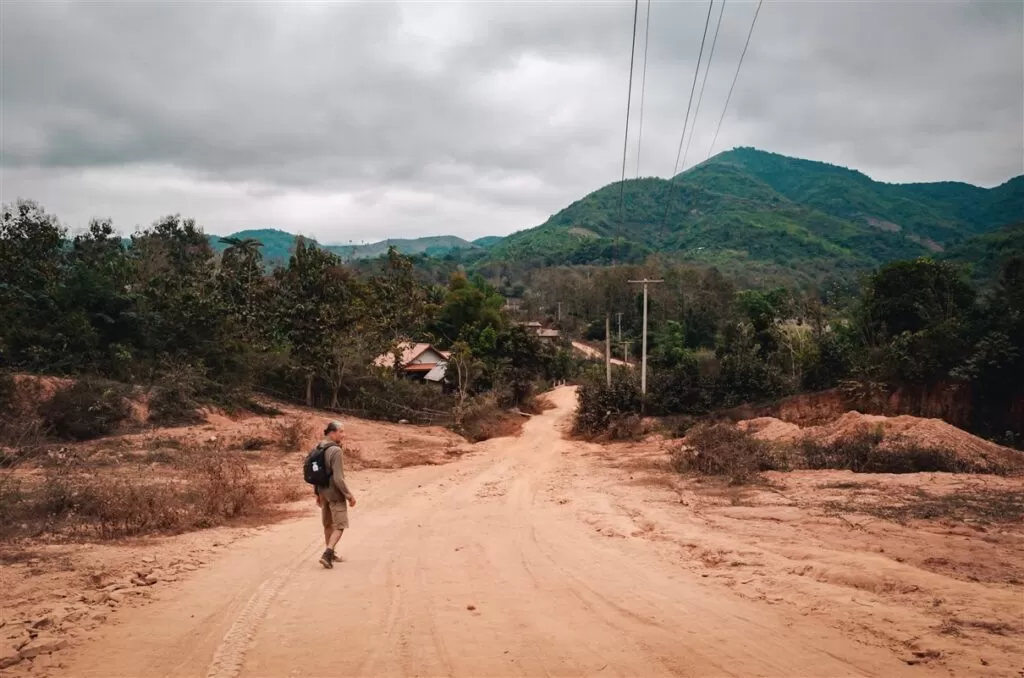
Nong Khiaw, Laos
One of the most memorable days I spent in Nong Khiaw was hiking to the nearby village of Ban Had Sao in search of the Had Sao waterfall. It led us through some wonderful mountainous scenery and there was not a soul around.
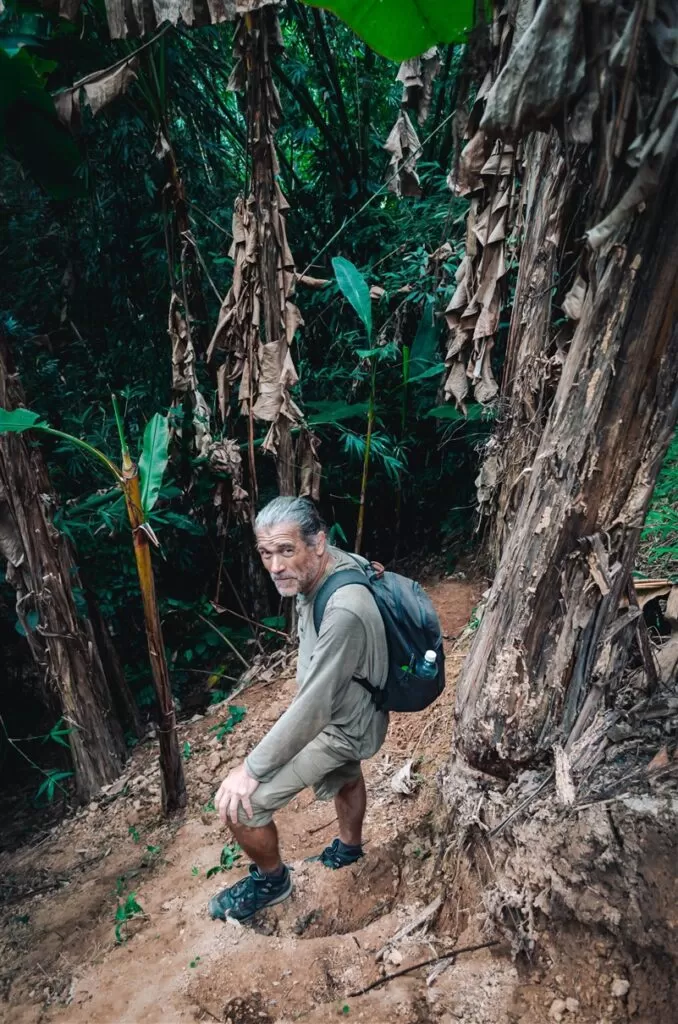
Secret waterfalls near Ban Had Sao village
We weren’t able to find the waterfall (I think it dries up in the winter) but luckily we met a local hunter who showed us the way to another waterfall further down the road that was hidden in between banana plantations.
You can’t compare it to the beautiful waterfalls around Luang Prabang like Kuang Si Falls and Tat Sae waterfalls but the hunt for the waterfall and its off-the-beaten-path location made for an amazing day of hiking.
It’s too long to explain how to get there in this post but you can contact me through my contact page if you want to know its location!
→ Also read: An Easy Guide to Vang Vieng’s Kaeng Nyui Waterfall
Visit Yensaibai organic farm
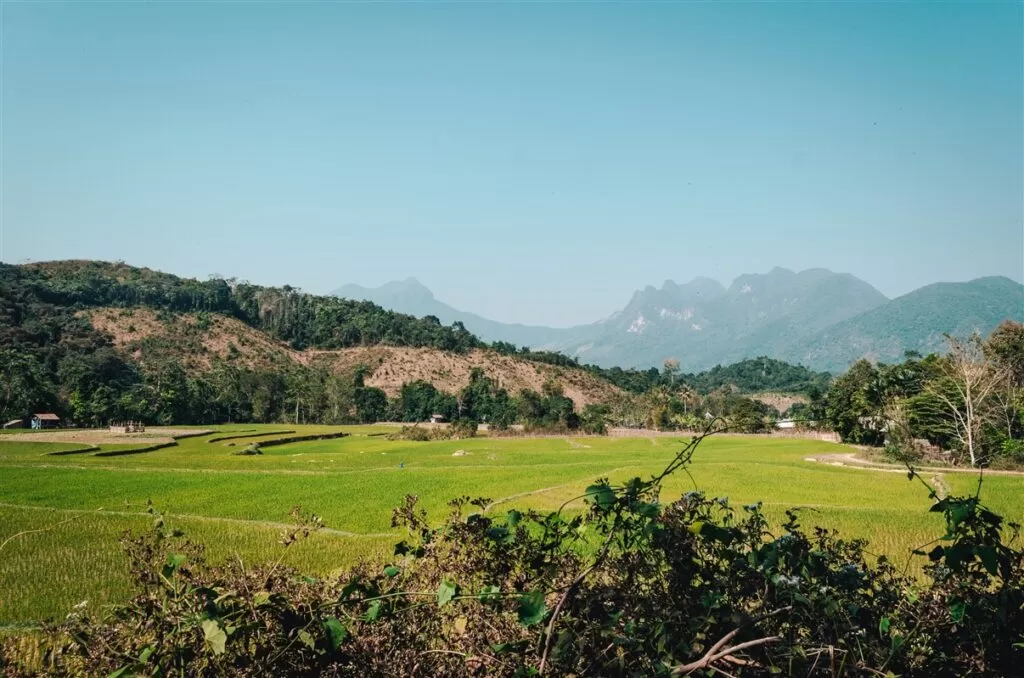
Rice fields
If you want to delve deep in the local Lao culture and agritourism then visiting Yensabai Organic Farm comes in highly recommended. Located on the way to Tad Mook waterfall, hidden between beautiful rice fields, this farm focuses on sustainable living in all its forms.
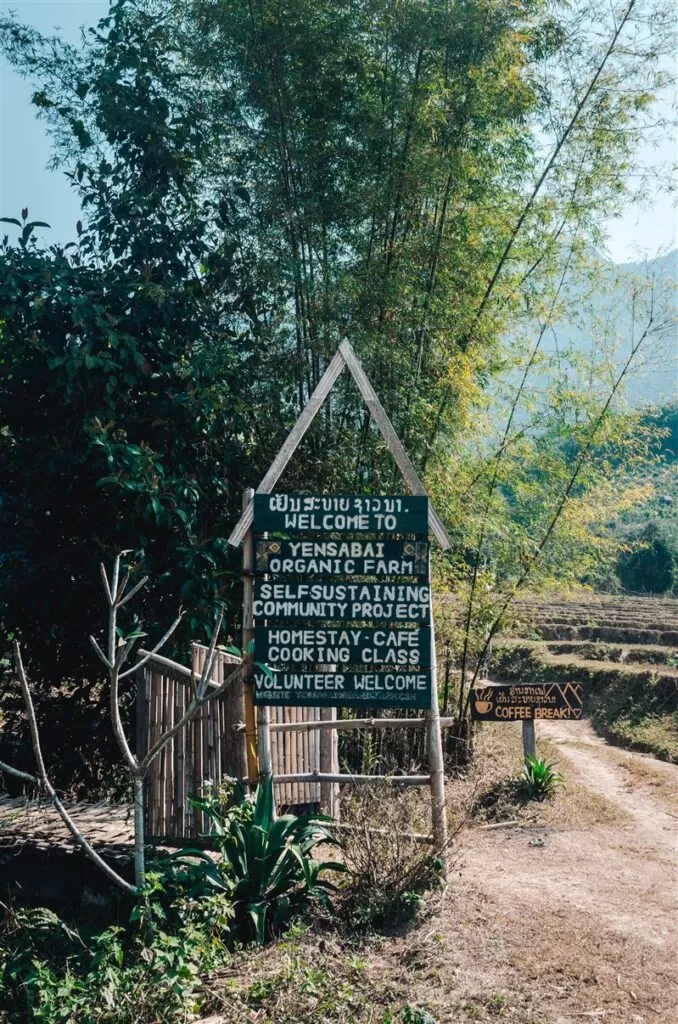
Yensabai organic farm, Laos
Travelers who want to visit Yensabai farm can participate in a variety of ways. You can just pop in for a coffee after visiting Tad Mook at the café but also contribute as a volunteer, sleep at the farm or camping site, or take a cooking class.
They donate 5% of their profits to the local community of Sop Kong. you can find more info on the website of Yensabai Organic Farm .
Go on a multi-day trek
The area around Nong Khiaw with its scenic mountains and small local villages, many of them only accessible by boat lends itself well to multi-day trekking adventures.
Multiple travel agencies in Nong Khiaw offer two, three, or four-day adventures. During these trekking adventures, you will hike from one local village to another, stay in small homestays and explore caves and waterfalls along the way.
Explore the other viewpoints in Nong Khiaw
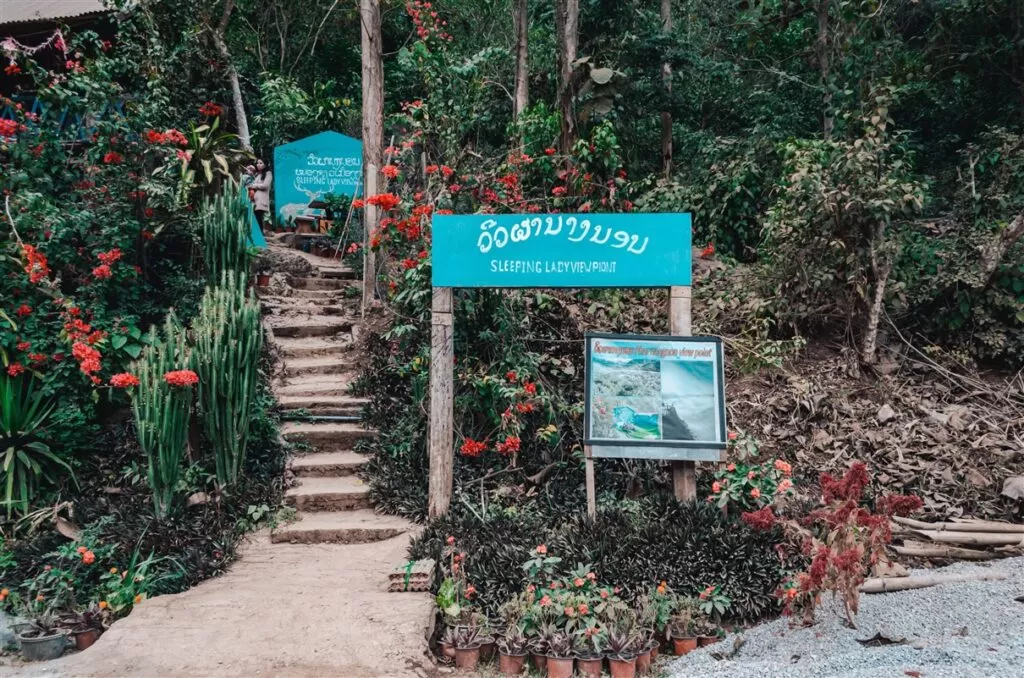
Entrance of Sleeping Lady Viewpoint, Nong Khiaw, Laos
Aside from Pha Daeng Peak, there are a few other viewpoints to explore around Nong Khiaw. Located close to the bus station, you can find the Sleepy Lady Viewpoint and close to the river Som Nang Viewpoint.
At the time of my visit, there was some construction going on at the viewpoints. There are plans in the making to create tours with overnight stays at the top of the viewpoints. Something to look forward to!
Nong Khiaw: how to get there
Nong Khiaw is easy to reach by bus from various locations in the north of Laos. Do remember that the roads in the area are not the best. Expect a lot of dust and potholes!
Luang Prabang to Nong Khiaw
There are e few buses a day that ply the route from Luang Prabang to Nong Khiaw. The most comfortable one is the minibus that leaves every morning at 9.30 A.M. It takes four hours to get from Luang Prabang to Nong Khiaw.
Tickets can be booked on 12GoAsia or through your accommodation. If you book through your accommodation a pick-up is included in the price.
Luang Namtha to Nong Khiaw
You can reach Nong Khiaw from Luang Namtha by minibus. The minibus leaves every morning at 9 A.M. It’s possible to also reach Nong Khiaw by taking a bus first to Oudomay and from there a connecting bus to Nong Khiaw.
Tickets can be bought at the bus station or through your accommodation.
Sam Neua to Nong Khiaw
From Sam Neua there is a daily bus to Bokeo that make stops along the way. it leaves at 11 A.M. Tickets can be bought at the bus station or through your accommodation in Sam Neua.
Muang Khua to Nong Khiaw
Muang Khua is a small city north of Nong Khiaw. It is served by buses that come from Vietnam and is a transit hub for travelers entering Laos. From Muang Khua, you can take a boat to Nong Khiaw, which also stops in Muang Ngoi.
THE BEST TRAVEL RESOURCES FOR LAOS
Here are the websites I personally use whenever I travel to Laos:
ACCOMMODATION
Booking.com : For the best cheap guesthouses, homestays or small hotels
Hostelworld : To find the best hostels located in the cities
Homestay : For a unique immersive homestay experience in Luang Prabang
12GO and Bookaway : The best transport websites for long-distance buses and train travel in Laos
Loca : Uber and Grab don’t operate in Laos but Vientiane has its own ride-hailing app called Loca!
Skyscanner : For affordable flights to Vientiane or Luang Prabang
Viator and Get Your Guide : book all kinds of activities from a Kuang Si waterfall cruise to a private cave and jungle trekking in Vang Vieng !
Get your Visa for Laos online through the Evisa website . Do note that you cannot enter just any border with the Evisa. You can fly with an Evisa into Vientiane, Luang Prabang, and Pakse and cross three borders with Thailand. They don’t accept the Evisa when you want to cross a land border coming from Vietnam, Cambodia, or China. It’s best to contact the Laotian embassies in these countries to obtain a visa.
If you’re looking for travel insurance, the one with the best benefits online is without a doubt Heymondo ! It’s very easy to ask for a quote on the website and if you book with this link you’ll get 5% off!
Get access to mobile data straight away when entering the country with a Laos E-sim or an Asialink E-sim when traveling through multiple countries.
How to get around Nong Khiaw
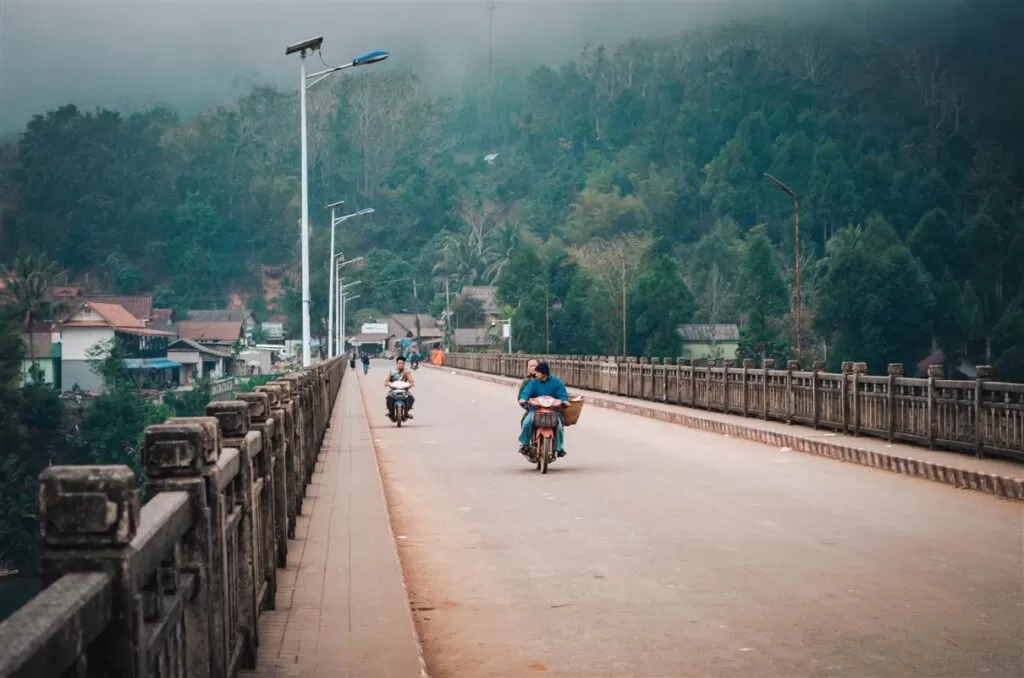
Nong Khiaw bridge, Laos
One thing that’s great about Nong Khiaw is its relatively small size. The town center and nearby attractions are easy to explore on foot and you can rent a mountain bike to visit places that are a little further afield.
Various locations and villages are only accessible by boat. You take a tour, hire a private boat or kayak to these places.
where to stay in Nong Khiaw
Nong Khiaw has become a well-known spot along the tourist trail. It doesn’t see as many people yet as places like Vang Vieng and it is still less developed but guesthouses tend to fill up in high season and it can be difficult to find a place to stay.
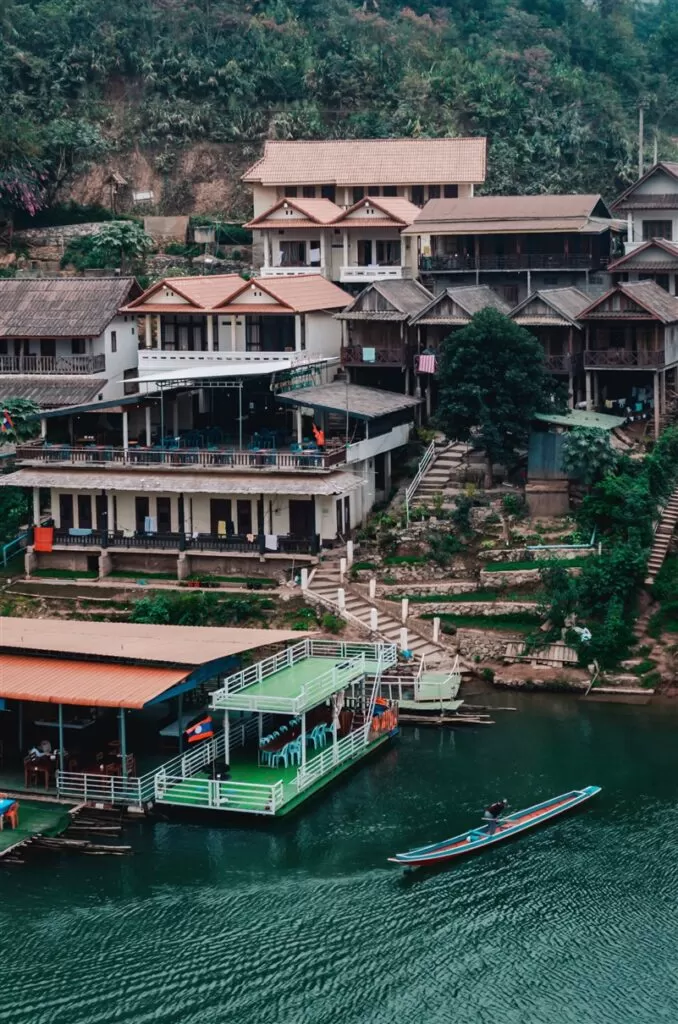
Accommodation in Nong Khiaw, Laos
Note that a lot of guesthouses cannot be found on Booking or Agoda yet. If they are sold out, you’ll have to go back to how backpacking was in the old days and look for a room at your arrival (which is in my opinion still a better option!).
At the time of my visit, most of the rooms online were sold out so I had to hunt for a place after arriving on the bus from Luang Prabang. I found a room at Pho Sai River View Guesthouse , a simple guesthouse on the banks of the Nam Ou River. The room had everything I needed, a good bed, a hot shower, and a lovely terrace with a magnificent view but it was a bit basic and I saw better options around.
Although most restaurants and tour agencies are located on the other side of the bridge in Sop Houn, it’s much more relaxing to stay by the Nam Ou River on the other side of the bridge.
- Sengdao Chittavong Guesthouse : this guesthouse cannot be booked online but is the best price/quality I have seen in Nong Khiaw. The bamboo bungalows are of very good quality and only cost 100 000 kip/per night. The owner is a very friendly man and the restaurant serves tasty food.
- Meexok Guesthouse : A small guesthouse only a few steps from Pho Sai Guesthouse where I stayed. It doesn’t have river views but the rooms are clean, great value for money and you get free tea, coffee, and bananas.
- Nam Ou River Lodge : located right next to Pho Sai, where I was staying. The rooms are better value for money here and are owned by a lovely local family. The view from the rooms is to die for!
Nong Khiaw Riverside Resort is a good option if you like to have a little bit more (rustic) luxury.
→ PRO TIP: Read my complete packing list for Laos for conscious travelers!
Where to eat in Nong Khiaw
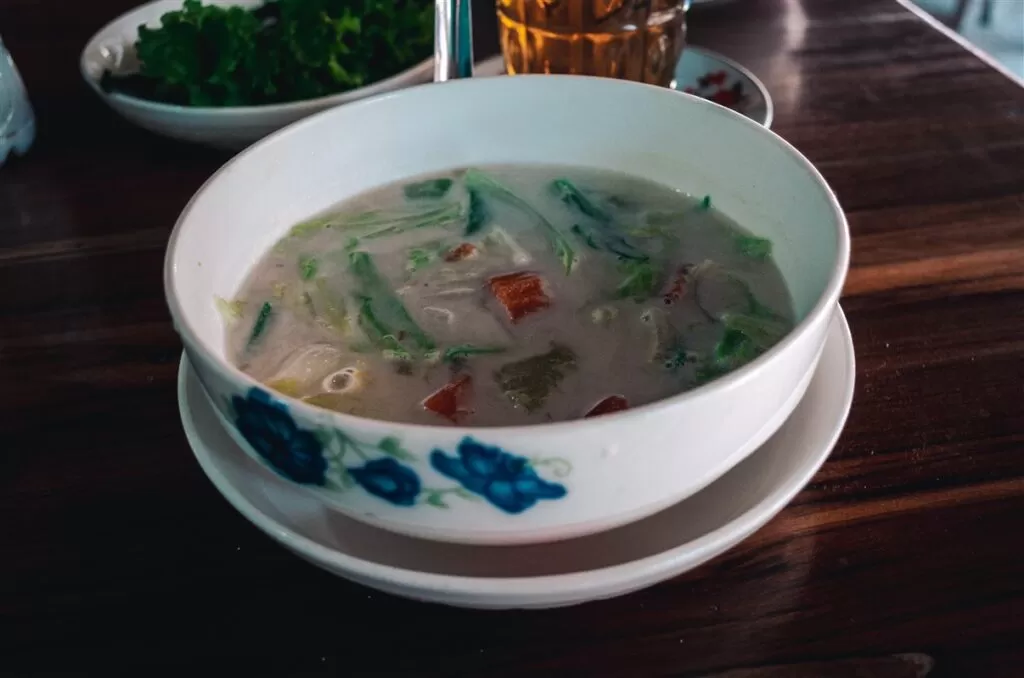
Laotian vegetable Suzy (coconut soup)
Several local restaurants in Nong Khiaw are a delight to eat at! Here are my favorite restaurants in Nong Khiaw:
- Mama Alex : Mama Alex is a lovely old but very fit lady running a small restaurant in the tourist center of Nong Khiaw. The food here was great and the prices were small. Aside from delicious Lao dishes, you can also find some Western food like pizza baguettes and spaghetti.
- Vongmany Guesthouse & Restaurant : Second in place comes this family-owned guesthouse and restaurant with a great selection of Lao dishes on the menu. Be sure to try the fried seaweed here!
- Couleur Cafe Restaurant : This restaurant is run by a chef from Luang Prabang who got sick of city life and is now cooking up great dishes in Nong Khiaw, his birthplace! There are not that many options here but the fried rice and vegetable curry is great!
While not exclusively plant-based, these restaurants are the best choices in Nong Khiaw for vegans traveling through Laos .
Nong Khiaw weather
The best time to visit Nong Khiaw is from November up until March. Outside of these months, it can get very hot and especially very wet. The north of Laos can receive up to 600 milliliters of water per square meter in July and August.
I visited Nong Khiaw in January and the weather was perfect for hiking. During the day time, the temperature was hovering around a pleasant 25 degrees Celsius, and in the evenings it quickly cooled down to 15 degrees or even less.
Is Nong Khiaw worth visiting: final thoughts
To conclude, yes: Nong Khiaw is absolutely worth visiting. If you want to discover the beauty of northern Laos, Nong Khiaw is the perfect place to explore.
From kayaking on the river to climbing Pha Daeng Peak, this charming town offers an abundance of exciting activities that will fill your itinerary. Make sure to add Nong Khiaw to your list of must-see places in Laos and enjoy these 15 best things to do in the area!
Let me know in the comments below if you have any questions or drop me a message through my contact page .
Also, don’t forget to check out my resources page with my favorite booking platforms and tips to start planning your trip. Additionally, have a look at my favorite travel gear if you want to pack more consciously!
Disclaimer: This post may include affiliate links. If you click on them, I may receive a commission at no extra cost to you.
Fancy more Laos travel advice?
- An Easy Guide to Vang Vieng’s Kaeng Nyui Waterfall
- Tham Chang Cave: Everything You Need to Know
- How to Take the Slow Boat From Luang Prabang to Thailand
- Three Ways to Travel Easily From Vientiane to Vang Vieng
- 33 Most Beautiful Temples in Southeast Asia
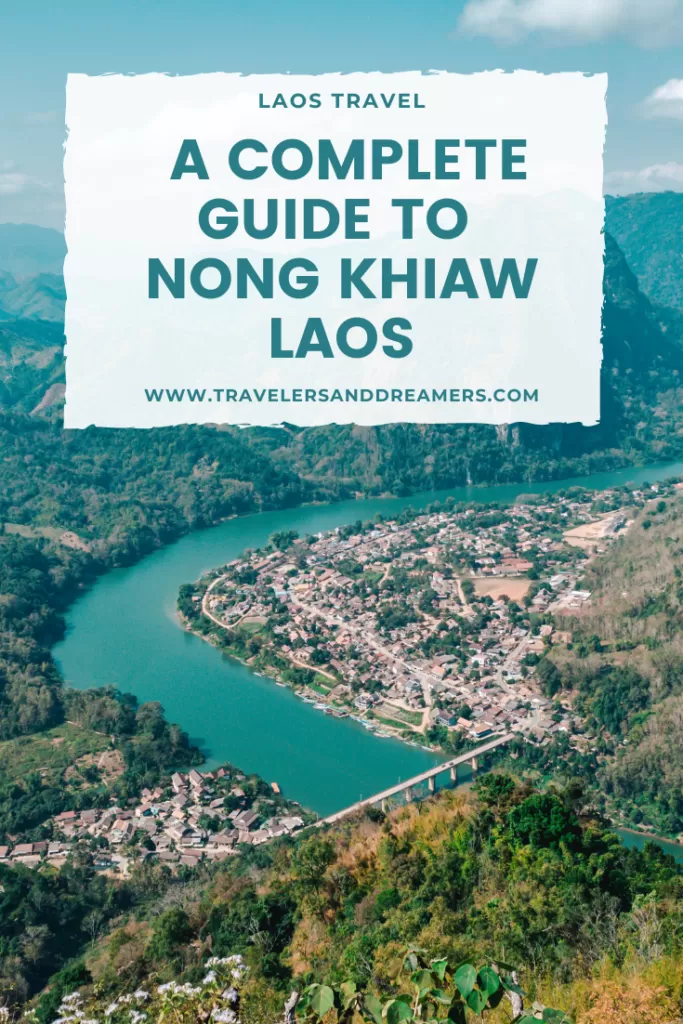
- December 19, 2023
post a comment cancel reply
Save my name, email, and website in this browser for the next time I comment.

Hi! I am Annelies and this is Travelers & Dreamers, a blog about conscious travel which means traveling in a more mindful way, with a positive impact on the world and yourself!
On this website, I cover different topics like slow travel, plant-based food guides, responsible travel, sustainable packing, eco-travel, and more !
Latest Posts
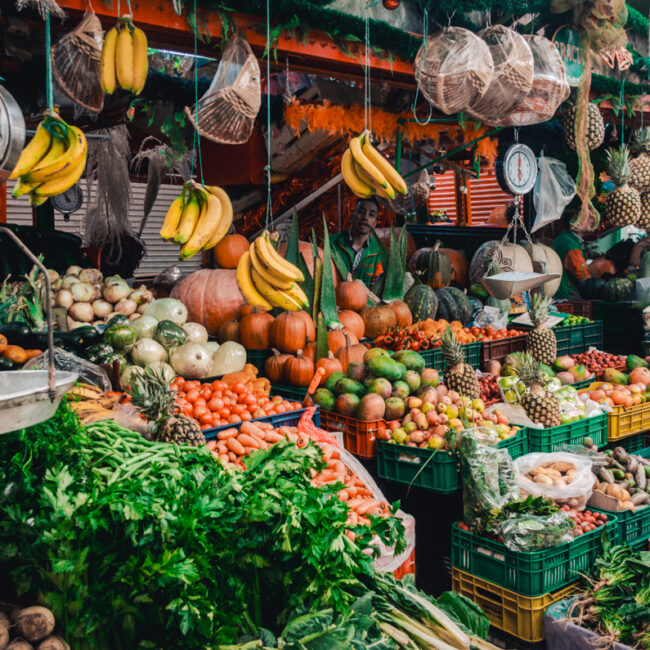
An Easy Guide to Paloquemao Fruit Market in Bogota

Phnom Penh to Kampot: A Complete Transport Guide
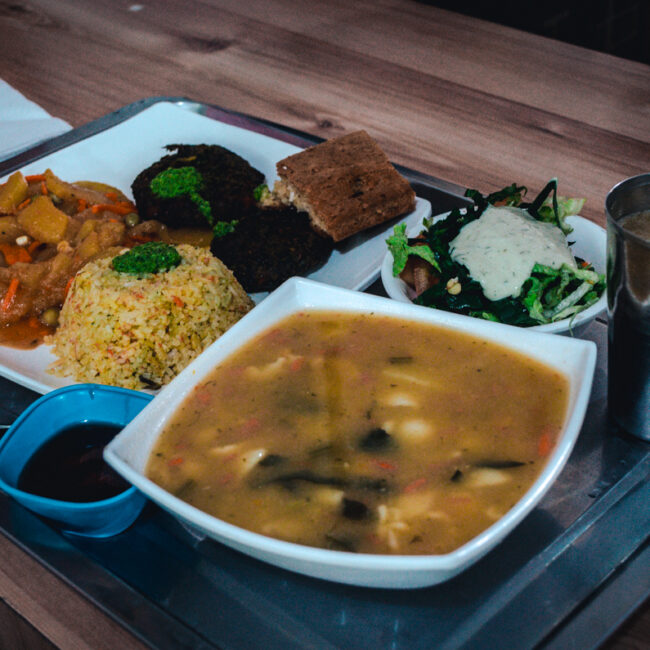
Vegan Restaurants Bogota: Your Guide to The Best Hotspots!
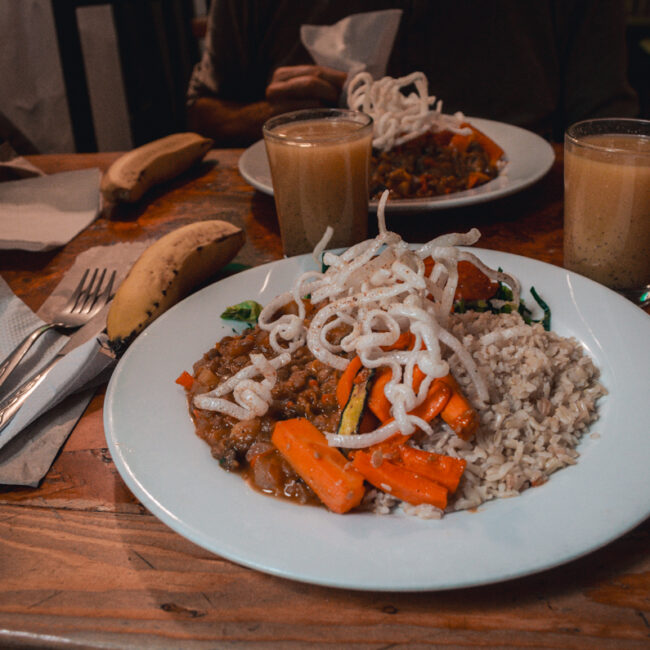
Vegan Colombian Food: Everything You Need to Know!
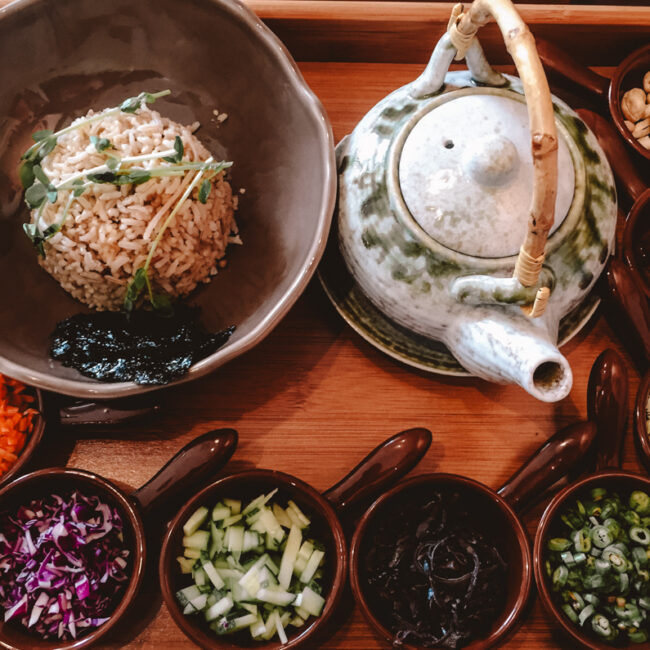
Vegan Kuala Lumpur: Guide to 13 Wonderful Vegan Hotspots!
Do you want to receive my latest finds on conscious and sustainable travel directly to your inbox? Subscribe here!
© COPYRIGHT TRAVELERS&DREAMERS, 2023.
2 week Laos itinerary: best places to visit in Laos (North and South)

Luscious jungle, tropical waterfalls, incense scented temples and not a fraction of the tourists that seem to flock to other parts of Southeast Asia. We simply had to go. There are so many incredible places to visit in Laos! Traveling through this landlocked country is safe, relaxed and packed to the brim with gorgeous views. Though mostly bypassed by travelers focusing on its more famous neighbors like Thailand, Cambodia and Vietnam, you’ll encounter nothing but friendly locals and the most pristine nature we’ve ever seen. Read on to discover the best places to visit in Laos and how to incorporate them into an unforgettable 2 week Laos itinerary!
Assuming you are reading this because you are planning on visiting, we have a ton of helpful Laos content to ease your planning woes! Click below for:
- What to pack when traveling to Southeast Asia during Monsoon season?
- 12 amazing hideaways for a unique stay in Laos
- How to go from Don Det to Siem Reap
- These are the 5 most beautiful waterfalls of Laos you should visit!
- 5 tips for Vang Vieng: the Laotian countryside at its best
- Surrendering to Luang Prabang’s beauty: our detailed guide
- Maison Dalabua, a boutique hotel in Luang Prabang
Is Laos worth visiting?
Think of Laos and imagine an enchanting world of prehistoric volcanic landscapes , limestone rock formations straight out of a fairytale, Buddhistic colonial cities and a gazillion of crystal clear waterfalls . It’s not for nothing Laos is becoming more popular amongst nature lovers and adventure seekers. Is Laos worth visiting? Well, YES!
Best part of it all? It hasn’t been overrun by massive tourist crowds yet. While Laos is slowly making its way out of communism into capitalism, the "forgotten country" will undoubtedly also make its way into more tourist hearts in the future.
Time feels fluid in cities like Luang Prabang and Vang Vieng . Almost no street advertising, no neon signs, more motorcycles than cars and no Heinz ketchup or McDonals in sight. In the evening, strings of lightbulbs illuminate the tranquil riversides and markets.
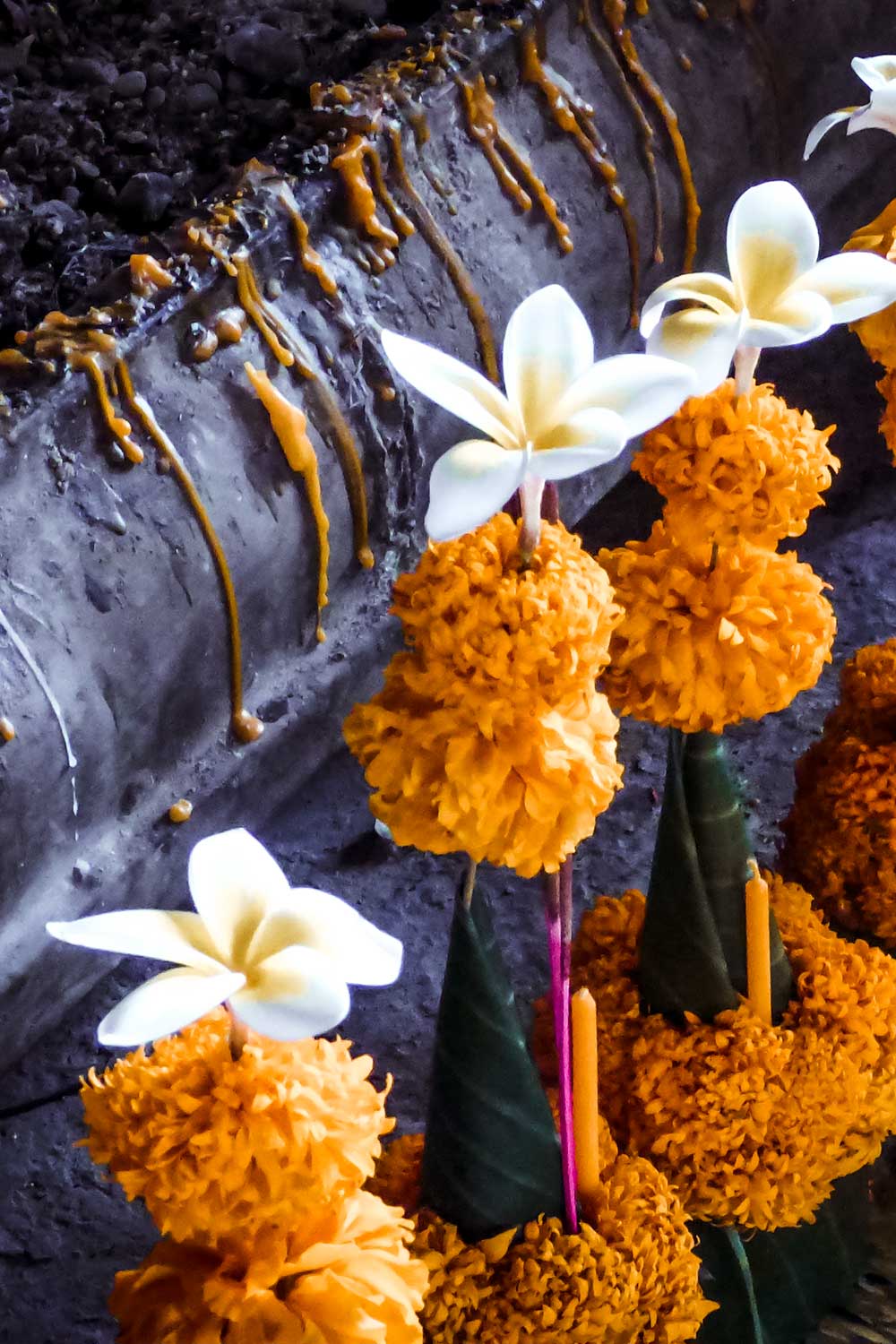
How many days in Laos?
We had two weeks in Laos (14 days). Most visitors tend to spend one to two weeks in Laos and focus on the north or south wile combining with one of its neighboring countries like Cambodia or Vietnam. If you would want to dive further into Laos’ hidden secrets, we'd recommend to dedicate around 3 weeks in Laos.
One week in Laos: Northern Laos itinerary
Laos in one week? Is that even possible? Yes, well only if you focus on one part of the country that is. While Laos doesn't attract hordes of tourists, the main tourist attractions are located in the North, with Luang Prabang being its crown jewel. Easily reached from Chiang Mai and Bangkok in Thailand, its also perfect as a little side trip from Hanoi, Vietnam.
Our Northern Laos itinerary brought us from Luang Prabang (3 nights) to laidback Vang Vieng (2 nights) for some downtime in nature and onward to Vientiane (2 nights), Laos' easygoing capital. Nature lovers might perhaps want to dedicate an extra night in Vang Vieng and shorten their stay in Vientiane or Luang Prabang.
One week in Laos: Southern Laos itinerary
A perfect one week Laos itinerary can be enjoyed in Laos' lesser known southern parts, which ranked high on our travel radar. Easy to combine with Cambodia's jungle covered templed in Siem Reap!
Our Southern Laos itinerary included stops in sleepy Paksé (2 nights), the Jungle of the Bolaven Plateau (3 nights) and the relaxed shores of Don Khone (2 nights), one of Laos' 4000 islands in the lush Mekong River.
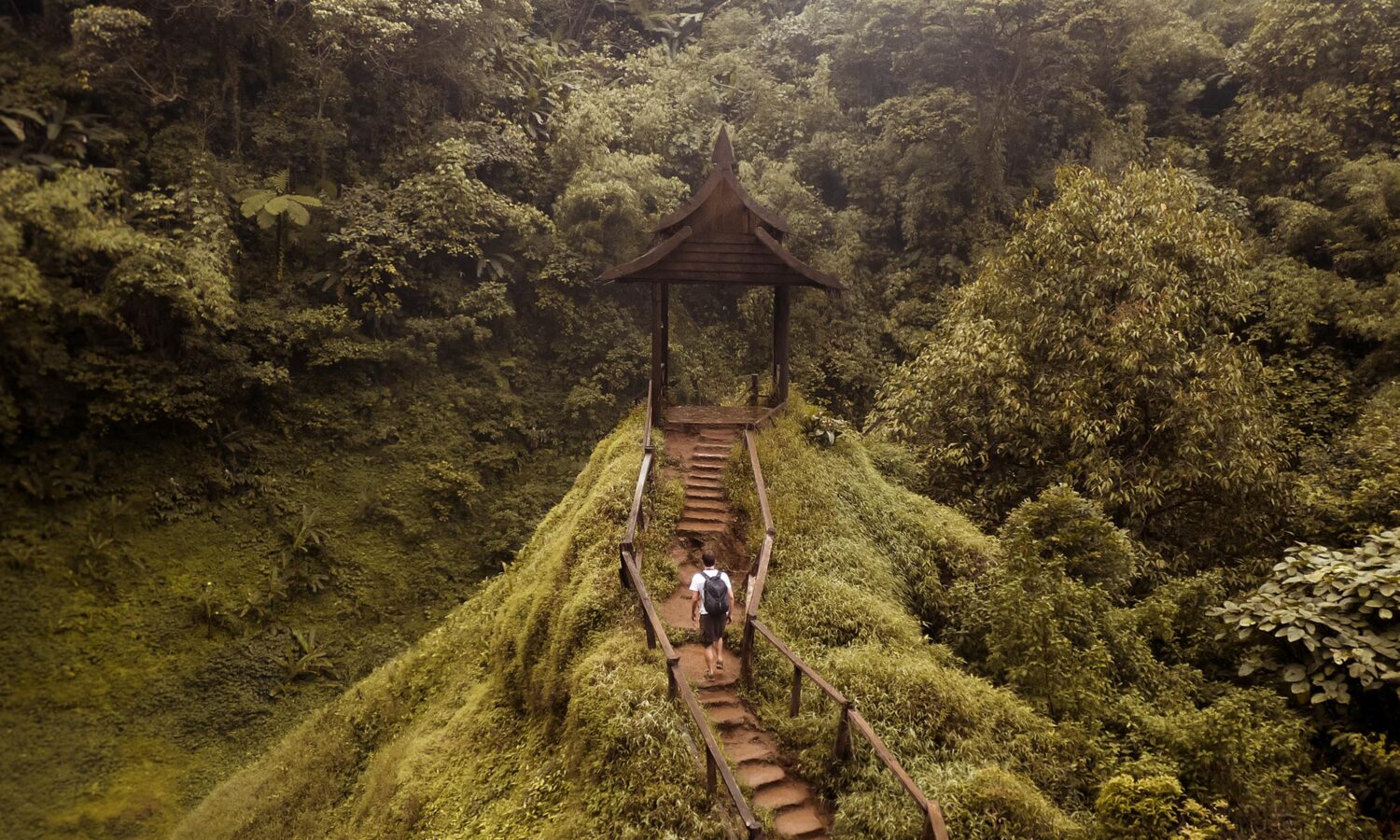
The perfect 2 week Laos itinerary
To give you an idea about what you can expect during your journey through Laos you’ll find a map with our two week Laos itinerary below. All destinations on this itinerary, have a separate mini guide in which you can find all our tips for fun activities, good restaurants and nice hotels. So you can tweet this canvas into your own ideal Laos itinerary and hopefully get a good idea of what each destination has to offer.
We spent 2 weeks in Laos and roughly followed the Mekong River from north to south. Below is a map of Laos showing what places we traveled to and highly recommend. You can click on each highlighted site on the map to get a better impression of that particular destination and the best places to visit in Laos.

Let's do this! Let’s dive into the best places to visit in Laos and best things to do in Laos se you can shape your perfect 2 week Laos itinerary!
Day 1: Arrive in Luang Prabang
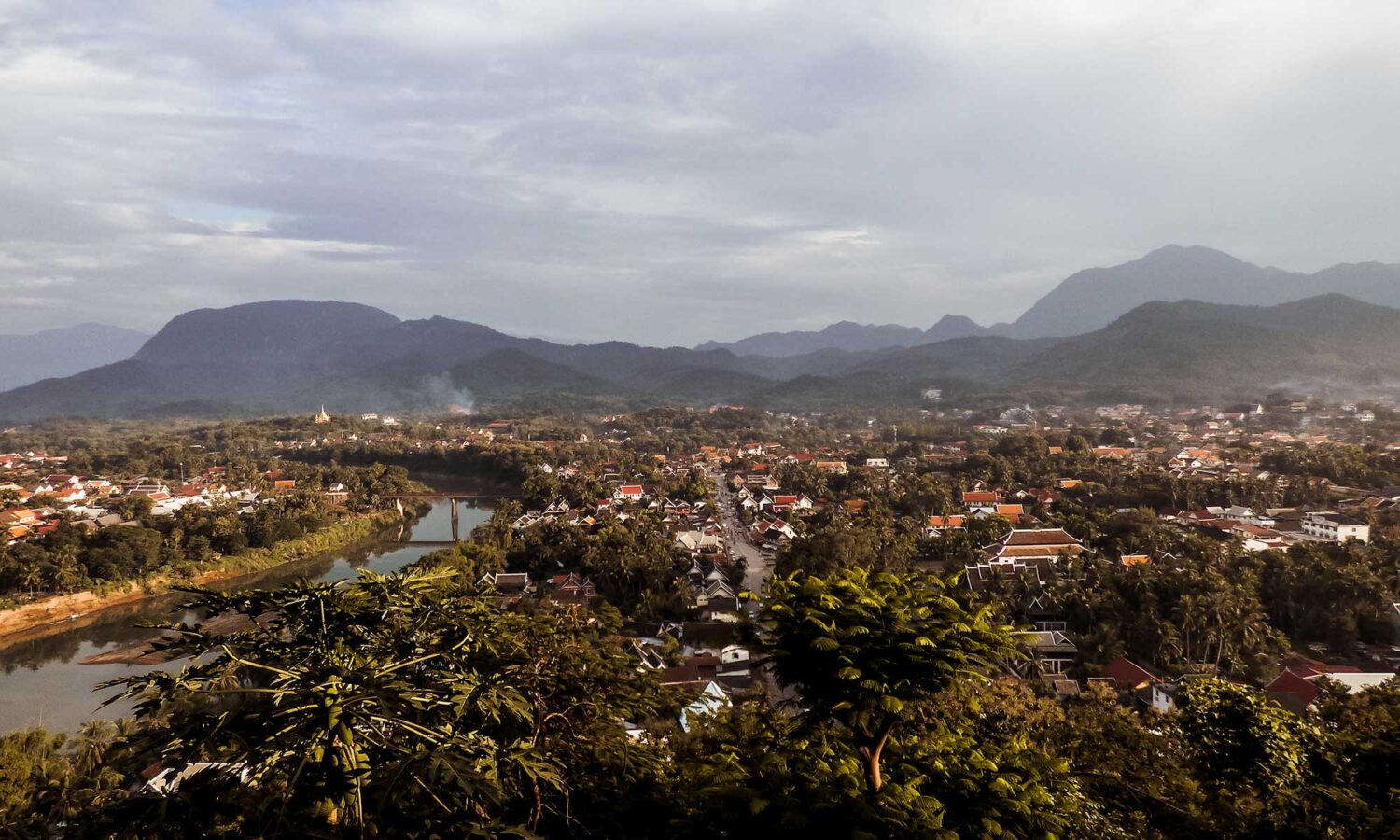
Having never traveled to Asia before, we weren’t too keen to start our travels in a chaotic capital, but preferred a more tranquil kickoff of our trip. So we decided to start our trip in the sleepy town of Luang Prabang !
The flight into Luang Prabang was one of the most scenic flights and landings we’ve ever witnessed! The little propeller plane will take you through majestic mountains, limestone cliffs and over never ending rice fields into the colonial heart of Laos!
Luang Prabang is the perfect place to leisurely start your Asian explorations and recover from your jetlag. Spend your first day getting your bearings at your hotel or head out into the Old Town and explore the sites of Phousi Hill. The golden temple of Phousi Hill towers over the city and gives superb 360 degree views of the city!
Day 2: Luang Prabang - exploring UNESCO heritage sites
Luang Prabang is Laos' cultural epicenter, flaunting a picturesque French colonial old town which is a delight to stroll through. Cultural buffs will eat their heart out as there are over 30 temples dotted around the city and food lovers will drool over the deliciousness that is offered in the street stalls.
Luang Prabang is filled with UNESCO heritage side and is most enjoyably discovered by just walking around and taking in all the beautifully restored colonial buildings. Wander around town and see all the small temples dotted around the historical centre. Don’t skip Haw Pha Bang , Wat Xieng Thong and Vat Sensoukharam , which were our favourite of the bunch.
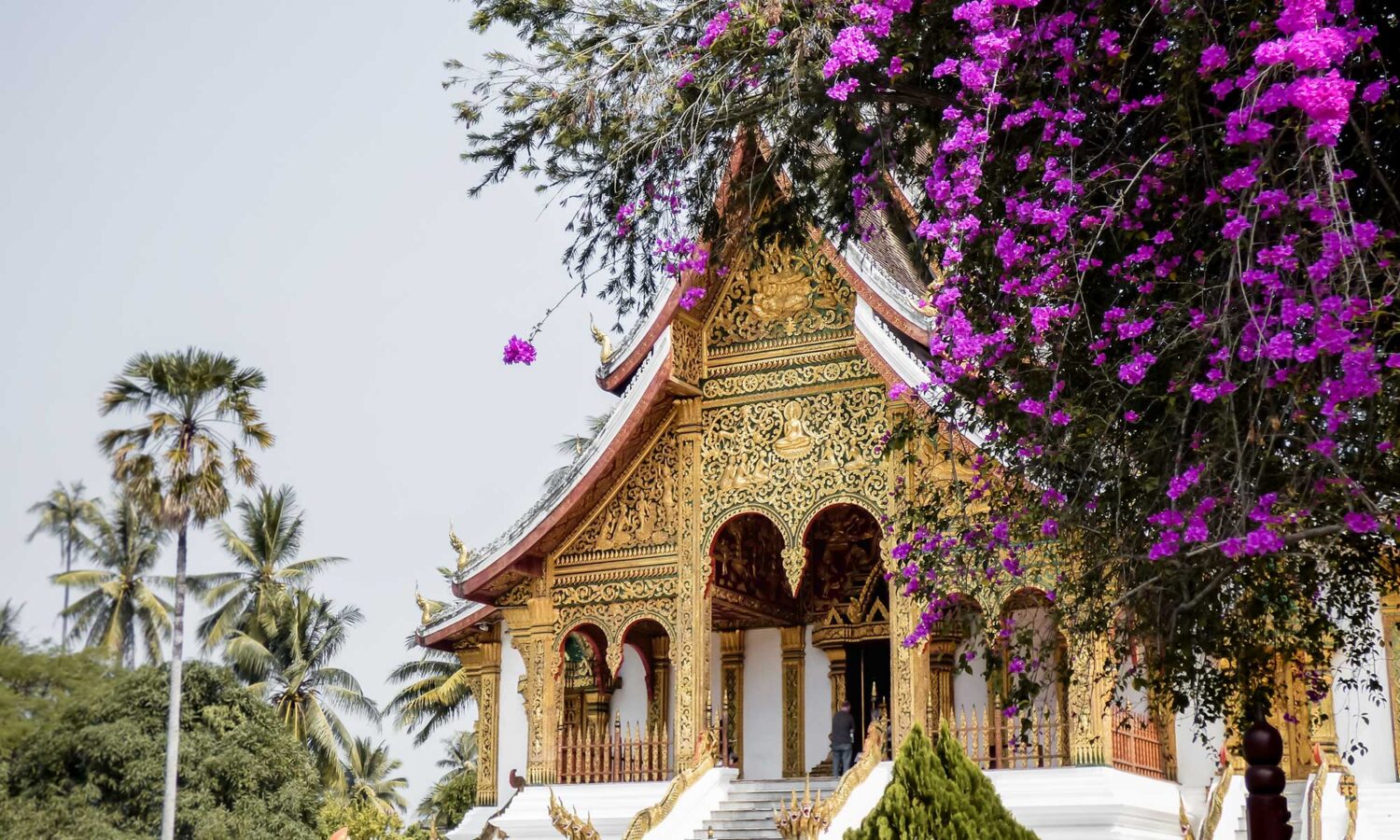
Enjoy lunch at Tamarind and enjoy traditional Lao dishes and tranquil riverfront views from their covered terrace. We highly recommend the Lao Cuisine Explorer set menu which serves two (320,000 LAK for two) and takes you on a culinary journey through Laos.
Enjoy a waterfront stroll, hop into the nearby smaller temples and watch the day to day life of the monks pass by. In the evening, Sisavangvong Road is transformed into an open air market and its side streets are filled with delicious street food stalls.

Day 3: Luang Prabang - Morning alms, Pak Ou Caves and Kuang Si Falls
Rise and shine! The tradition of the morning alms (Sai Bat) is a Buddhist cultural tradition and one to observe in silence and wiht respect. Every morning, the monks walk the streets of Luang Prabang, mostly following the trail of the most important temples, and receive food offerings from devotees.
Pro tip: the morning alms start early morning around 05:30 to 06:30 am in March to October and 06:00 to 07:00 am in November to February.
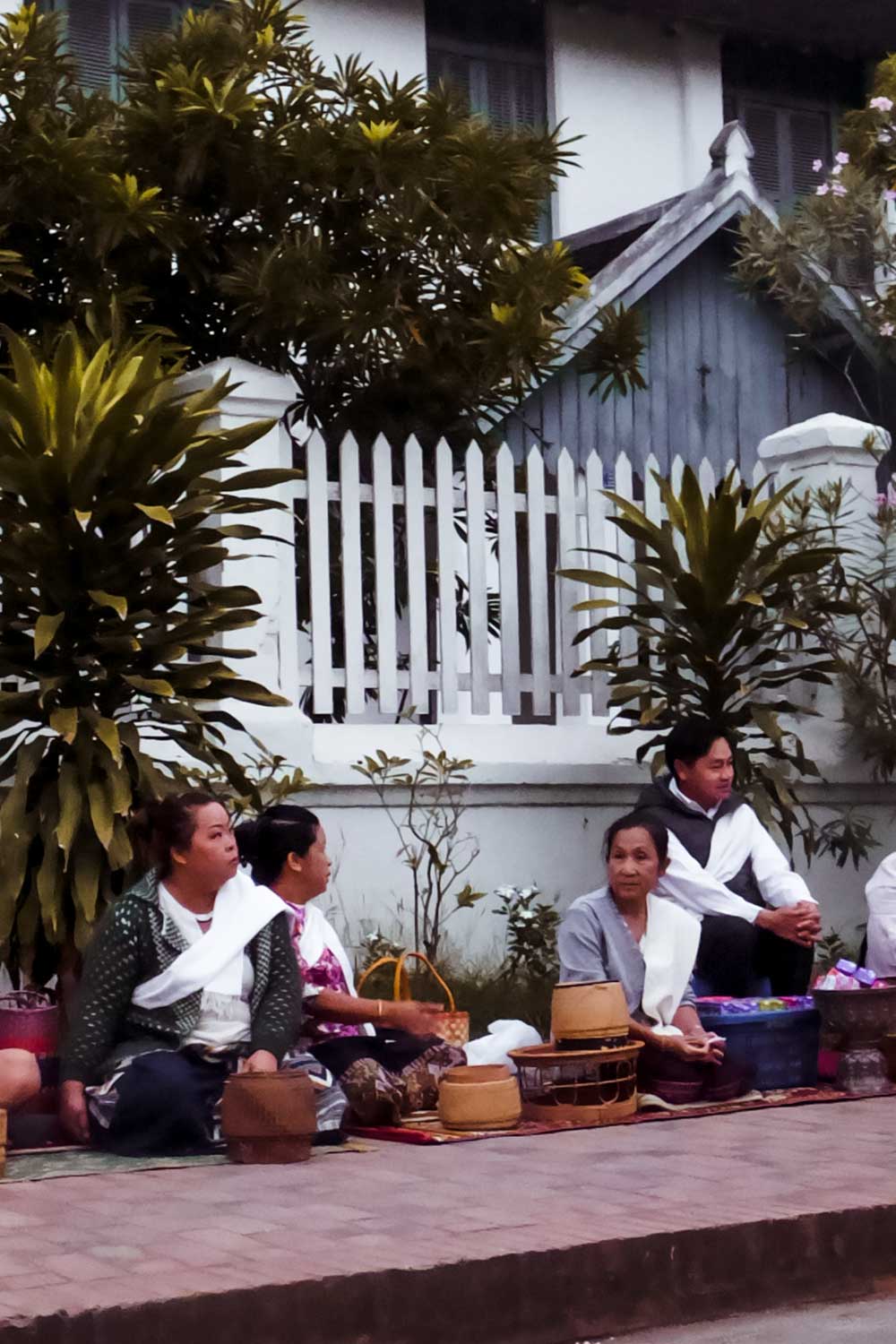
Head back to your hotel for some breakfast or get your morning caffeine fix at Saffron , one of the best breakfast bars and coffee houses in Luang Prabang.
Now you’ve seen the morning alms, it is time to visit another Buddhist site: the Pac Ou Caves. Packed with over 4,000 Buddha statues, the Pak Ou caves are a shrine to the river spirit and Lord Buddha. The Buddha images in the Pak Ou Caves ca be found in different positions, from meditation to peace and nirvana (the reclining Buddha). The caves are shrines to Buddha, offering places of worship with the largest image in Tham Ting being a popular place to burn incense and offer prayers.
It's easy to book a tour to the Pak Ou Caves or you can buy your own ticket at the Luang Prabang Longboat office for boats departing around 8:30 am. (get there by 8am for a ticket)! Price is 65,000 LAK per person, the tour lasts about 2 hours including a stop at Whiskey Village.
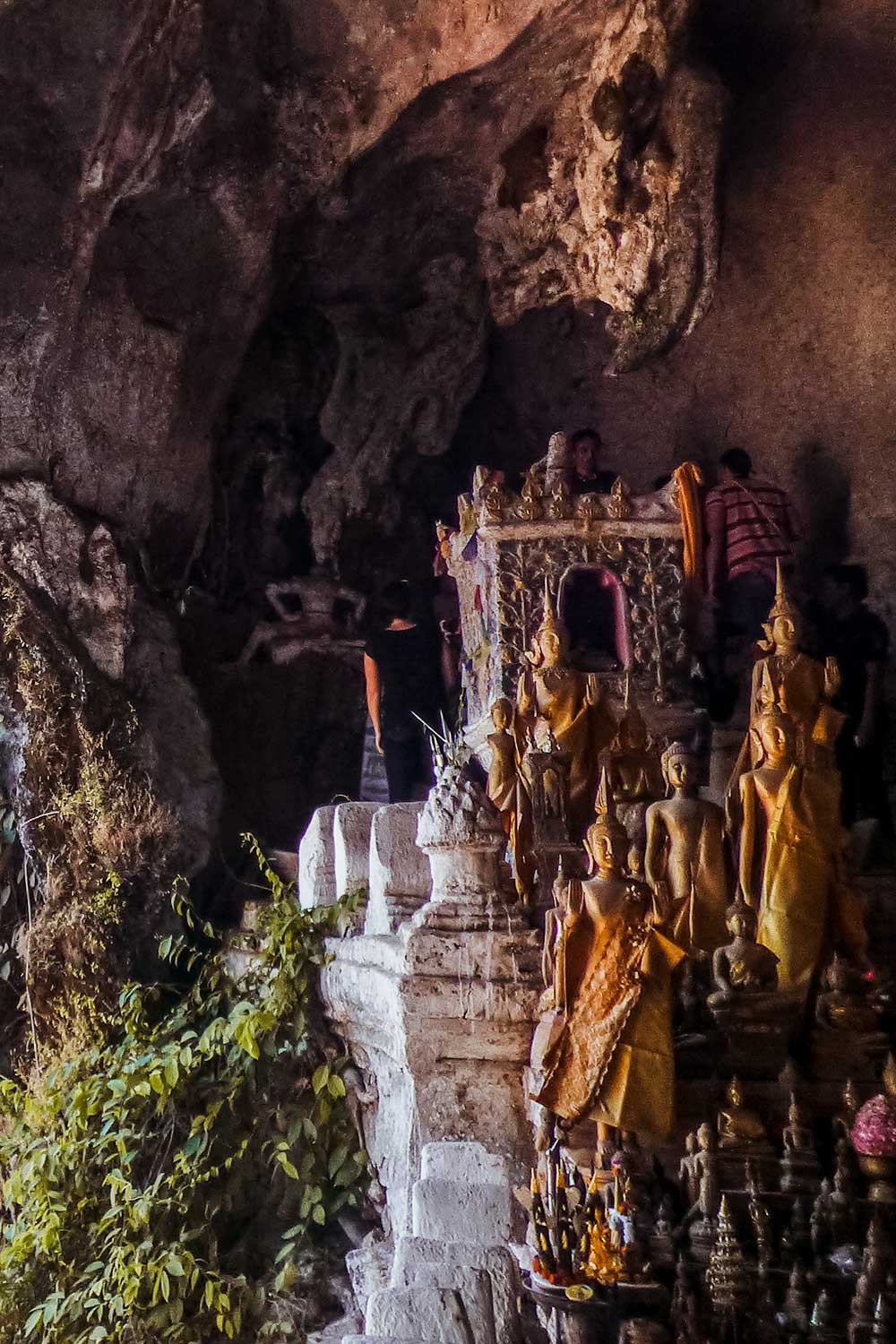
Head to the Indigo Café for lunch, a mere 12 minute walk from where the longboat dropped you back in Luang Prabang. Offering a combination of hot and cold local dishes, Indigo Café is the perfect place to taste the famous Lao sandwiches!
Spend the rest of your afternoon soaking in the mint-blue waters of Kuang Si Falls. Aqua colored pools flow into each other, fed by a magical waterfall. Many pools are big enough to allow for swimming so schedule enough time in the afternoon for some relaxing.
You could easily arrange your own tuk tuk, there are a bunch of them right across the street of Indigo Café, or you can visit the falls with an airconditioned van or by joining a group tour:
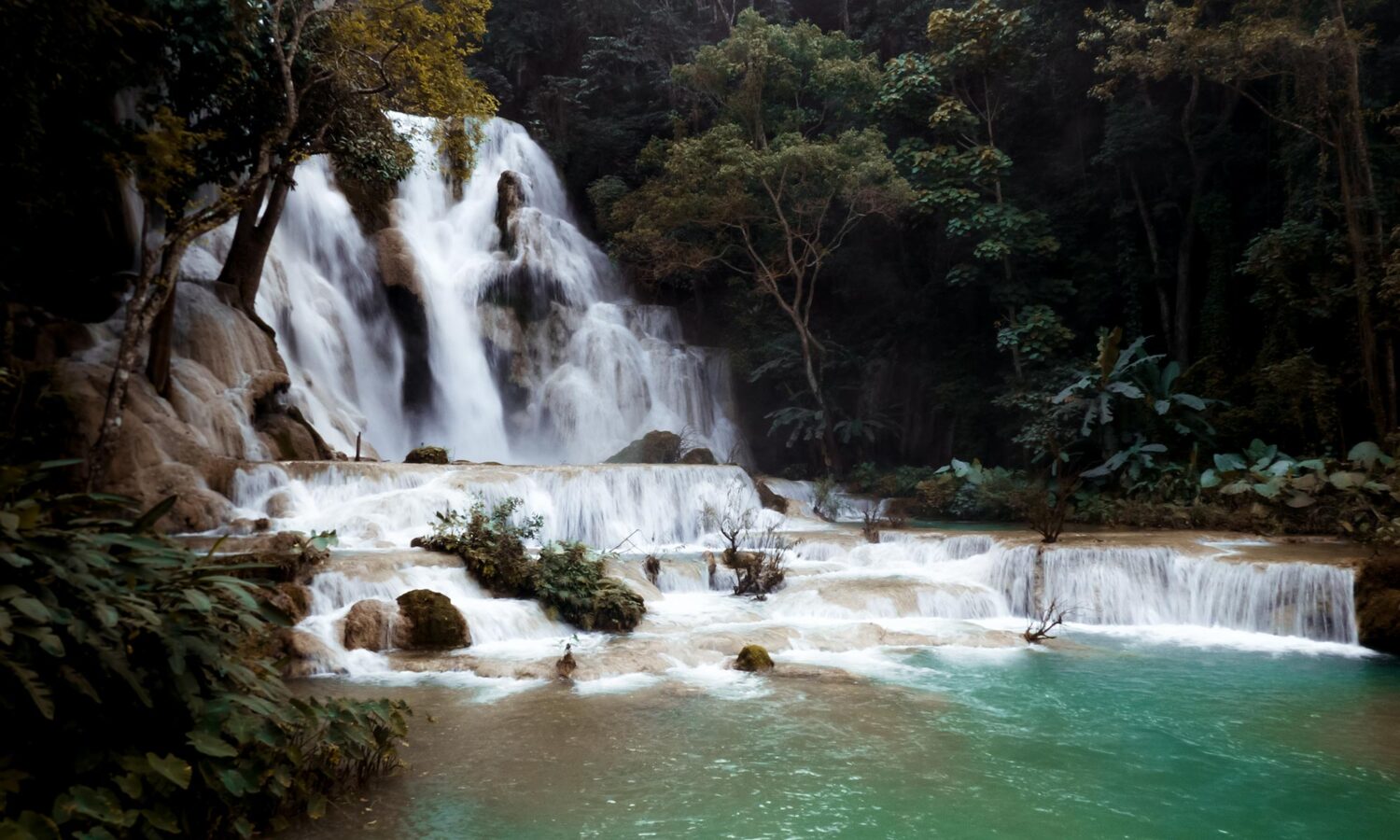
How to get to Luang Prabang
Flying into Luang Prabang from Europe or other continents will require a layover in Bangkok, Thailand most of the time. Lao Airlines operates regularly from Bangkok, Chiang Mai, Siem Raep and Hanoi. From the airport you can easily arrange a taxi or you can arrange an airconditioned transfer beforehand.
Luang Prabang is also the perfect starting point for this 2 week Laos itinerary when you're planning on entering the country overland by slowboat from Thailand .
Where to stay in Luang Prabang
Mid Range (€75-€150 per night): A nice boutique hotel is Maison Dalabua . It is perfectly located in the Old Town and has a swimming pool and spa. Perfect to get your bearings after a long flight and some occasional cooling off after sightseeing.
Luxury Range (> €150 per night): One of the few hotels with an infinity pool in Laos is the Belmond La Residence Phou Vao . Boasting beautiful views over the surrounding jungle, The Belmond offers both unique views and is centrally located to explore Luang Prabang on foot. If you're looking for grand French Colonial interiors and beautifully kept gardens, Satri House might be a perfect hideaway for you. If tropical luxury is what you're after, why not opt for a jungle luxury tent overlooking Luang Prabang at the Rosewood ? Pure luxury at the outskirt of Luang Prabang offering out of this world views and adventure at your doorstep.
KEEP READING: 12 jaw-dropping accommodations in Laos you wish you could stay at!
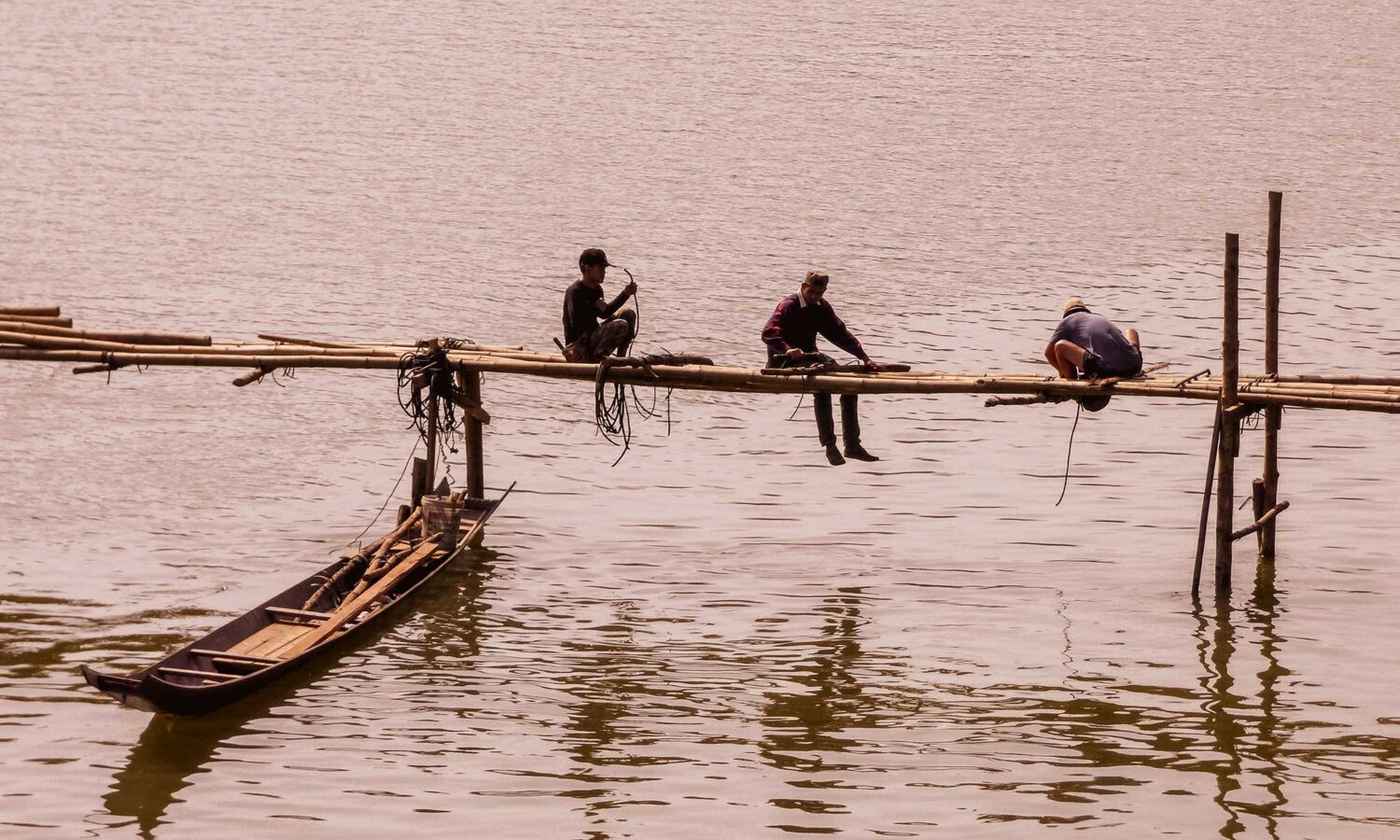
Day 4: the winding road to Vang Vieng
The second destination on this 2 week Laos itinerary is one of the most beautiful. Vang Vieng is wedged between Luang Prabang and the capital Vientiane and smack in the middle of a fairytale landscape. You only need one glimpse of the splendid limestone cliffs to fall completely in love with the Laotian countryside.
Best way to get to Vang Vieng is by using one of the mini vans riding back and forth between Luang Prabang and Vang Vieng. They're comfortable and come with AC. Those that are prone to travel sickness might best bring medication since the road is long and winding. The mini vans leave three timer per day at 7am, 9am or 3pm, cost about $16 per person and will take about 5hours.
Click here to book the minivan to Vang Vieng!
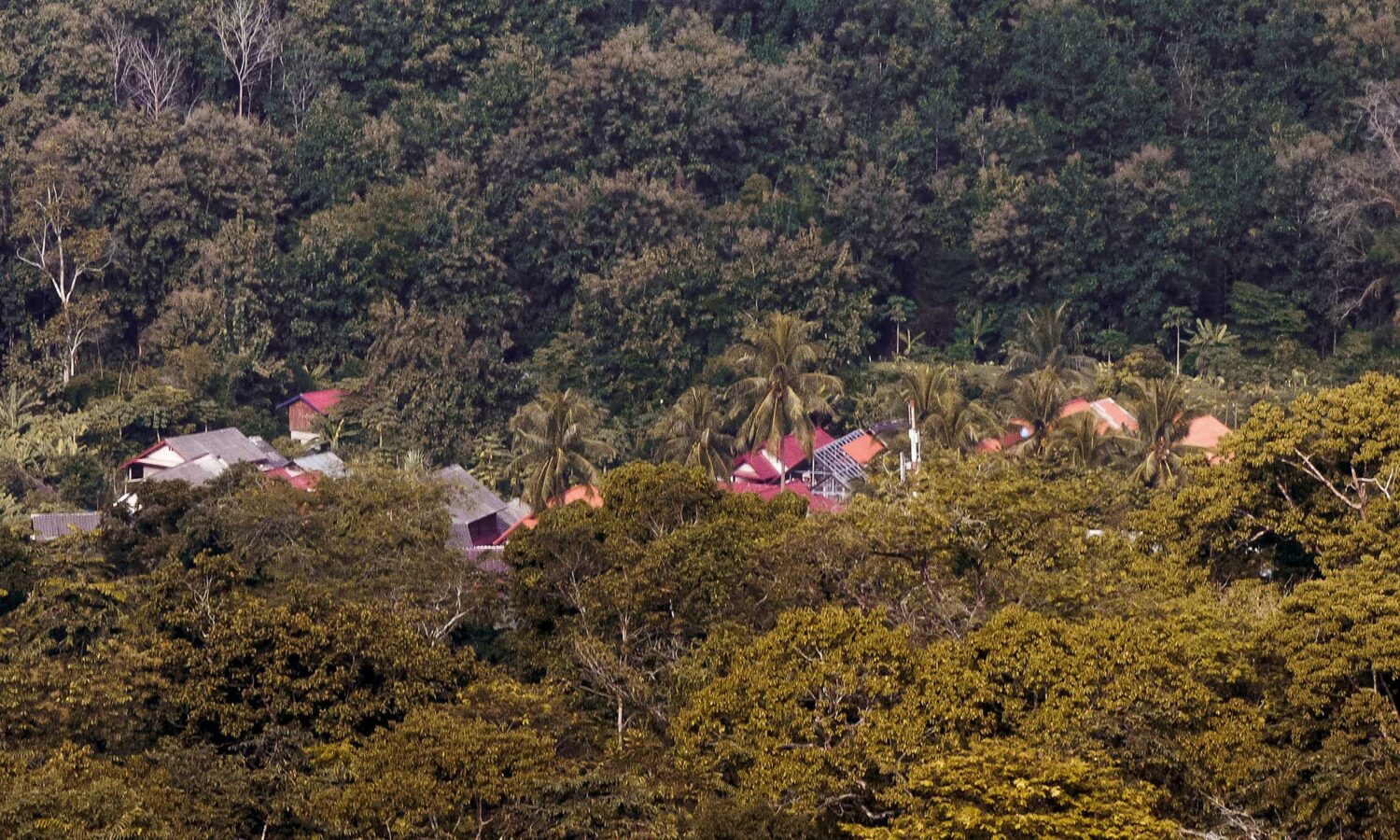
Depending on when you left Luang Prabang for Vang Vieng, you might have time to spend an afternoon river tubing the Nam Song River or visiting the nearby Tham Chang Cave (about 2km from Vieng Tara Villa ).
This tour combines both options: a visit to the Tham Chang Cave and river tubing back to Vang Vieng!
Day 5: Vang Vieng
Vang Vieng is perfect to enjoy incredibly beautiful hikes and let the wind blow your hair during a motorbike trip. Vang Vieng used to be famous for parties and drunk tubing down the Nam Song River, but is now a hub for adventure and nature lovers. Discover natural swimming pools, caves, authentic villages and pass the most stunning viewpoints all in the direct vicinity of Vang Vieng. One of the best places to go in Laos to experience its peaceful countryside.

Start in the early morning by renting out a motorbike. Since we stayed behind the toll bridge, at Vieng Tara Villa , there was no sense in renting a motorbike in town and then having to pay toll to cross the bridge. We ended up renting our motorbikes just across the toll bridge. Most motorbikes are rented out with almost no fuel so your first priority will be to get some gas. Count on 60,000 LAK per bike for a semi-automatic and 40,000 LAK for an automatic.

The major attractions aren't far in between so Vang Vieng is the perfect place to ride a motorbike for the first time. Our first stop of the day was at the Pha Ngern Trailhead. It's a 2,2km drive to the trailhead which leads to three viewpoints. It takes 20-30 minutes to reach the first one, then 45 more minutes to reach the next two which are only 5 minutes apart. The views are really amazing!
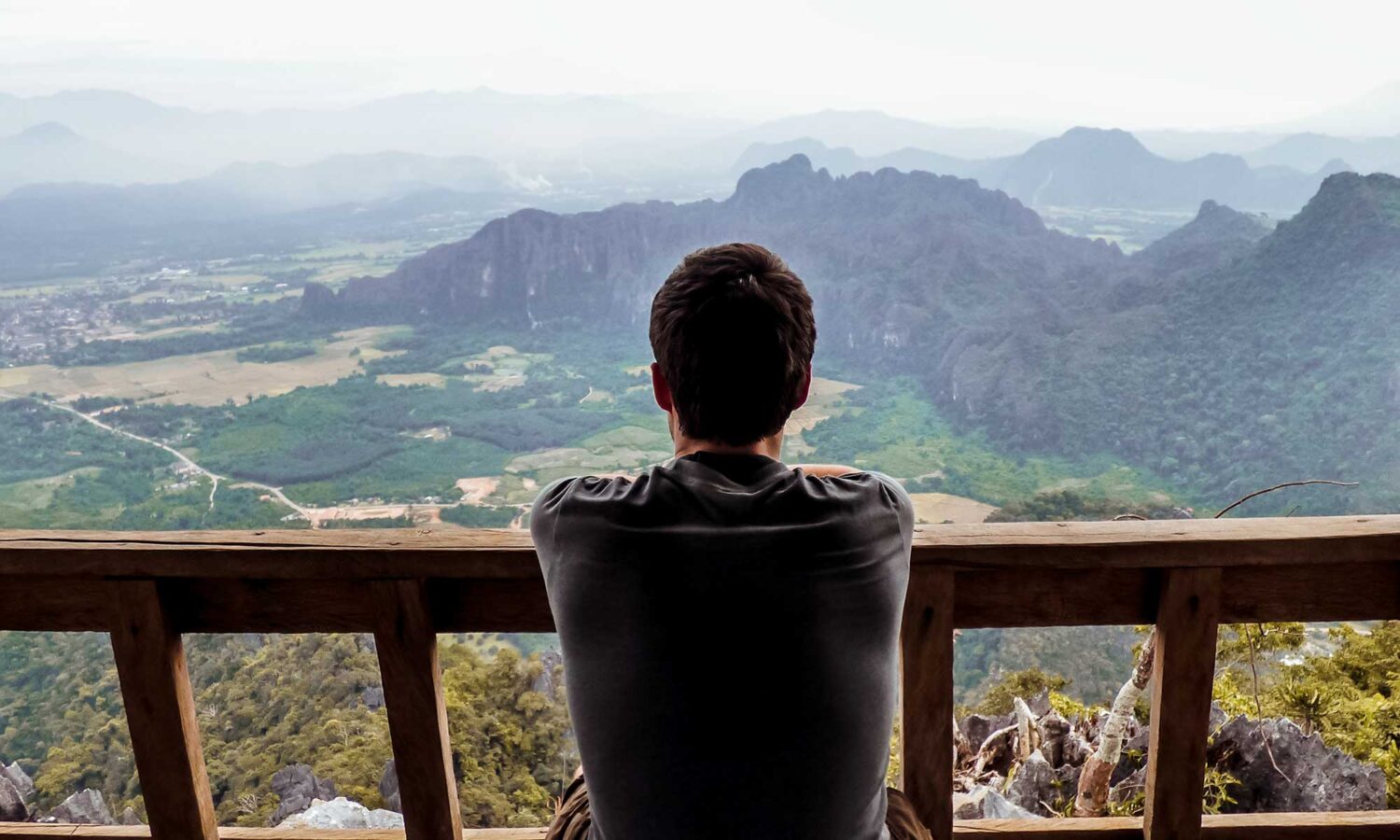
Next up was a stop at the Blue Lagoon. Honestly, I didn't find it spectacular, these types of pools can be found anywhere. This place is also accessible by quad bike so it attracts a lot of tourists. To me it was unfortunately not quite appealing. There are a number of places to eat, go for a toilet break and there is a gas station if you need fuel, so we opted to take our lunch break here. Before heading back out, we briefly explored the Phu Kham Cave on site. The cave was nice to explore, a golden Buddha resting inside.
Phu Kham Cave Opening Hours: 8am – 6pm Entrance Fee: Included in Blue Lagoon entrance fee Headlamp Rental Fee: 10,000 LAK (USD 1.20) - we just use the lights on our phones
The area offers different viewpoints over the surrounding karst mountains, all are locally owned. This means the local families charge the entrance fees and maintain the trails. They are often advertised by billboard type posters along the road to assure you you're still driving in the right direction.
If you still have energy left, there are two incredible viewpoints a bit further than the Blue Lagoon: Namxay Vieuwpoint and Pha Hon Kham cliff Viewpoint . Both take about 40min to reach to the top but can be less if you're very fit. You can find the directions here .
Try to schedule one of these viewpoints, one of the best places to see in Laos at sunset! Try not to linger though and make sure to get down before dark, the paths can be difficult to descend and a lot of bugs tend to come out when dark.
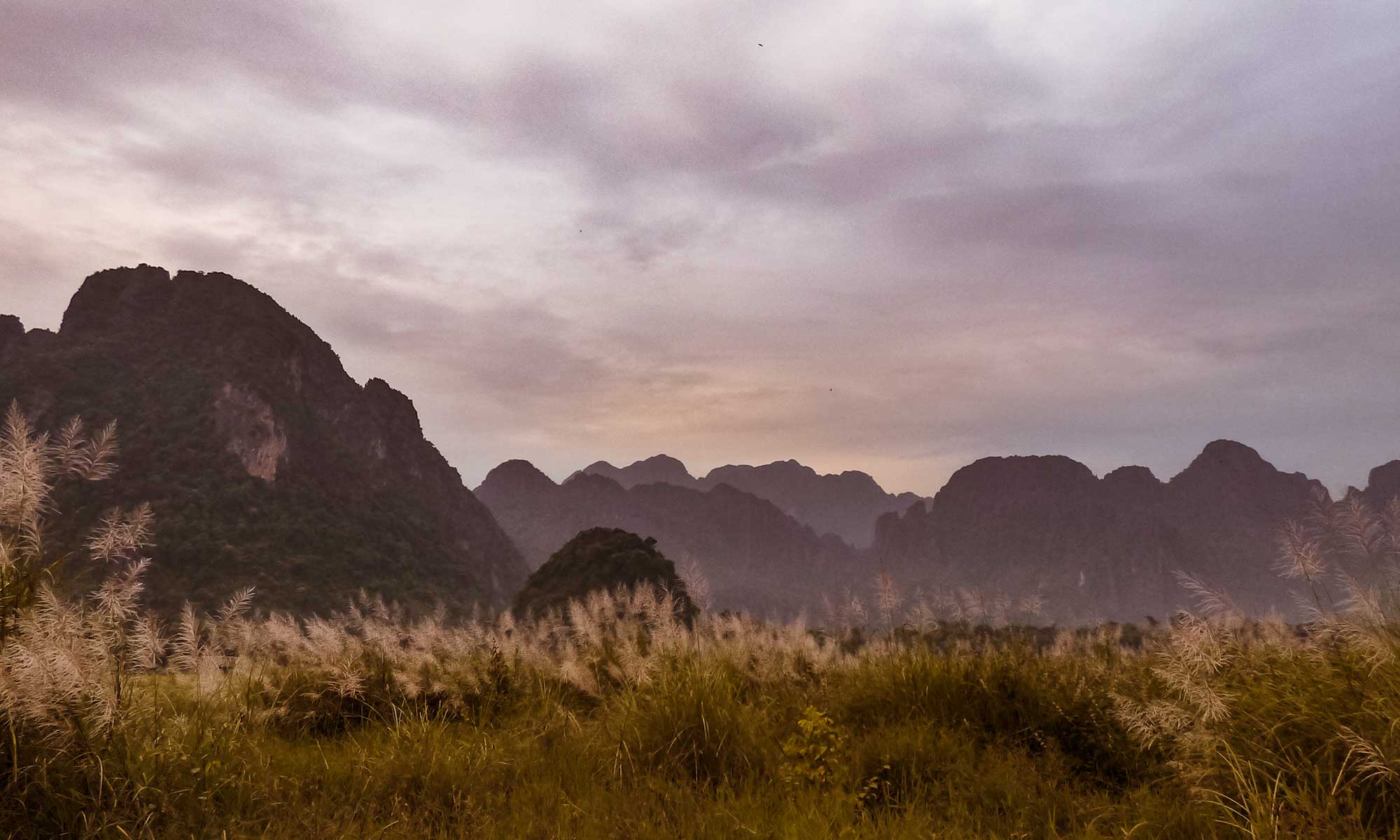
How to get to Vang Vieng
There is no airport in Vang Vieng, so the best way to reach this jungle paradise is to travel there from Luang Prabang or Vientiane. A five hour ride in mini van is your best option. From Luang Prabang you can chose between three departure times per day in a shared mini van .
Where to stay in Vang Vieng
Mid Range (€75-€150 per night): when it comes to unique locations, Vang Vieng surely delivers. We spend two nights at Vieng Tara Villa , a set of bungalows right in the middle of rice fields and surrounded by limestone cliffs. Now that's a view to wake up to!
Luxury Range (>€150 per night): The Riverside Boutique Resort is perfect if you plan to spend a few days in Vang Vieng. The luscious pool screams for relaxing. Sip a cocktail on the terrace while enjoying the sunset dip below the spectacular mountains.
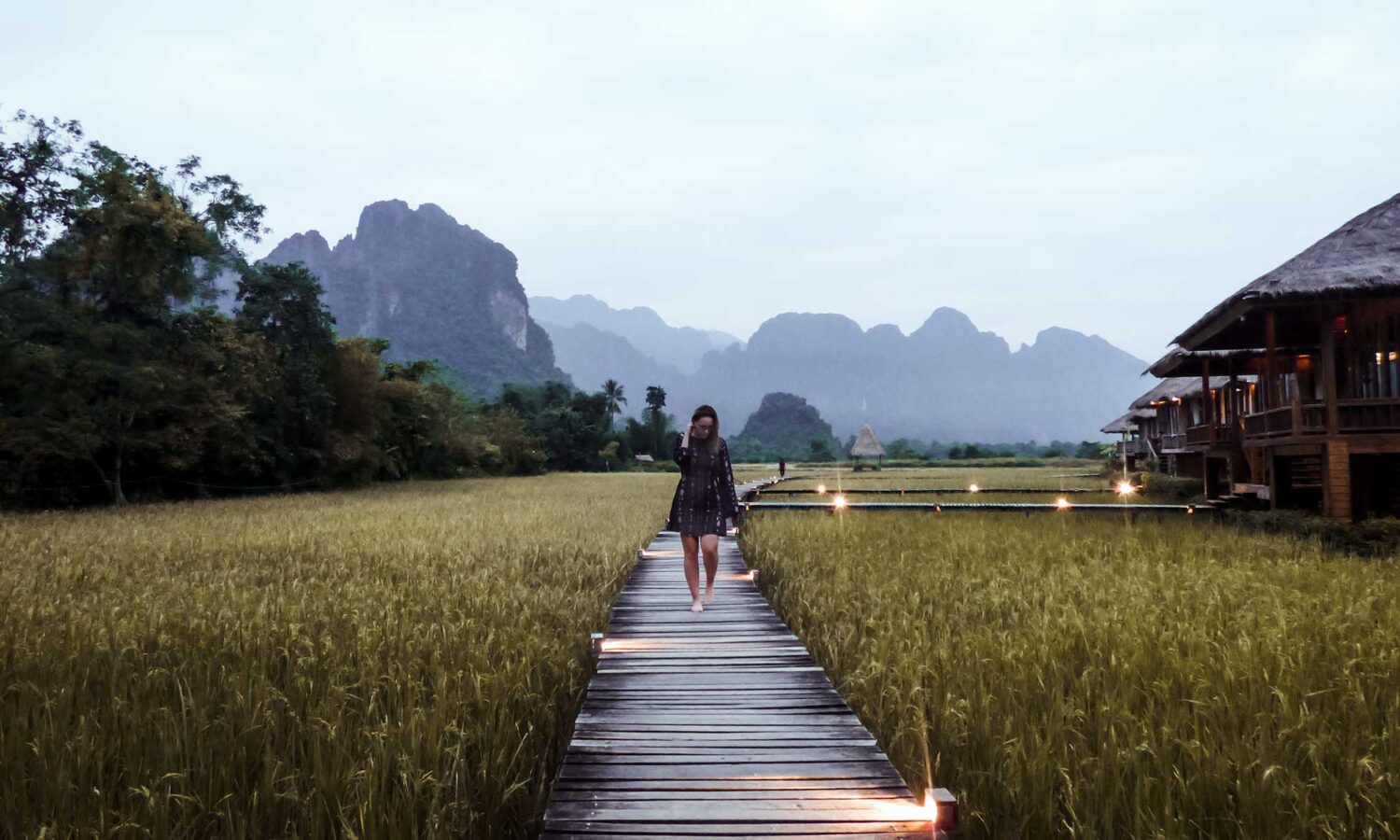
Day 6: travel from Vang Vieng to Vientiane
Traveling to Vientiane can happen two ways:
By bus: you can easily arrange bus tickets through your hotel. In our case a tuk tuk transfer to the Vang Vieng bus terminal was included in the ticket price. You can also book the tickets yourself through Sout Chai Travel .
By private transfer: when traveling in group or in family, it might be more convenient to book private transportation. You can book a private minivan to bring you to Vientiane right here .
Day 7: Vientiane
The third stop on this 2 weeks in Laos trip is in its capital Vientiane, Laos' largest city. Though not as hectic as other Southeast Asian capitals (think Bangkok or Hanoi), it was a brisk awakening from our blissfully tranquil stay in the Laotian countryside.
While it doesn't have the pull of Luang Prabang's culture or Vang Vieng's nature, it has a decent amount of temples to explore. Pha That Luang, Wat Si Saket and Patuxay (Arch Of Triumph van Vientiane) are an excellent way to spend you morning. It's a standard tour offers by most tuk tuks but you could also arrange a tour by car with AC.

For lunch we highly recommend the Timeline Café , where you can fuel up your caffeine intake and enjoy a light lunch.
A large part of our afternoon was dedicated to Laos' war past at the COPE Visitor Centre . COPE provides prosthetic limbs to victims of the 1960s and 1970s bombings of Laos by the USA. Many bombs remain untouched in the Laotian landscape and sadly continue to maim or kill local today.

We spend some time visiting the exhibits and documentaries about the bombings, prosthetics, rehabilitation work and ongoing bomb clearance. A sad reminder of Laos' horrifying war troubled past but one of our most educational moments in Asia, as was our visiting to the S21 prison and Killing fields in Cambodia.
Opening hours: open every day from 9am – 6pm Entrance fee: free but donations are always gladly accepted How to get there: located on the grounds of the Centre for Medical Rehabilitation (CMR), across the street from the Green Park Hotel.

For a more frivolous afternoon you cab opt to explore the small Xieng Khuan Buddha Park which is located 25 km from Vientiane. 200 sculptures of Hindu and Buddhist statues are sprinkled across a meadow by the Mekong River. Count between 1-2 hours to explore at a leisurely pace.
Opening hours: open every day 8am - 5pm Entrance fee: 15,000 LAK per person (about $2). How to get there: - by motorbike, there's an additional 3,000 LAK fee for parking - by shared tuk-tuk that can be arranged by your hotel - by bus route 14 at central bus station in Vientiane, costs 8,000 LAK per person and drops you off at the entrance of the park
Day 8: internal flight from Vientiane to Paksé
The flight from Vientiane to Paksé is a short one, taking around 1h30. The flight operates daily at 8am and on Monday a Saturday a second flight at 4pm is offered. The flight with Lao Airlines can be subject to delays (our flight was rescheduled 1 hour later a few days before it was scheduled) but besides that everything went smooth.
At Paksé airport it's easy to arrange a transfer into town. We chose to use the afternoon to test out the motorbikes we will use the next couple of day, to the nearby UNESCO heritage site of Wat Phu .

CONTINUE READING: 4 days motorbiking through Laos' jungle paradise, the Bolaven Plateau
Day 9-11: waterfall spotting on the Bolaven Plateau
The Bolaven Plateau is located in the South of Laos and was formed by ancient volcanic activity. Nature has had free game here for centuries, creating the most marvelous collection of waterfalls we’ve ever seen.
The local life on the Bolaven Plateau is very basic. It’s like heading back in time and embarking on an expedition with your trusty motorcycle or scooter. The Bolaven Plateau is one of the best places to visit in Laos if you want to see some spectacular waterfalls. Pretended to be Indiana Jones and visit Wat Phu, Laos’ largest temple complex, and tame Laos tropical jungle. While most travelers skip this Southern Laos itinerary, it was our absolute highlight! Far from the busy tourist trail and pristine nature to fall in love with.
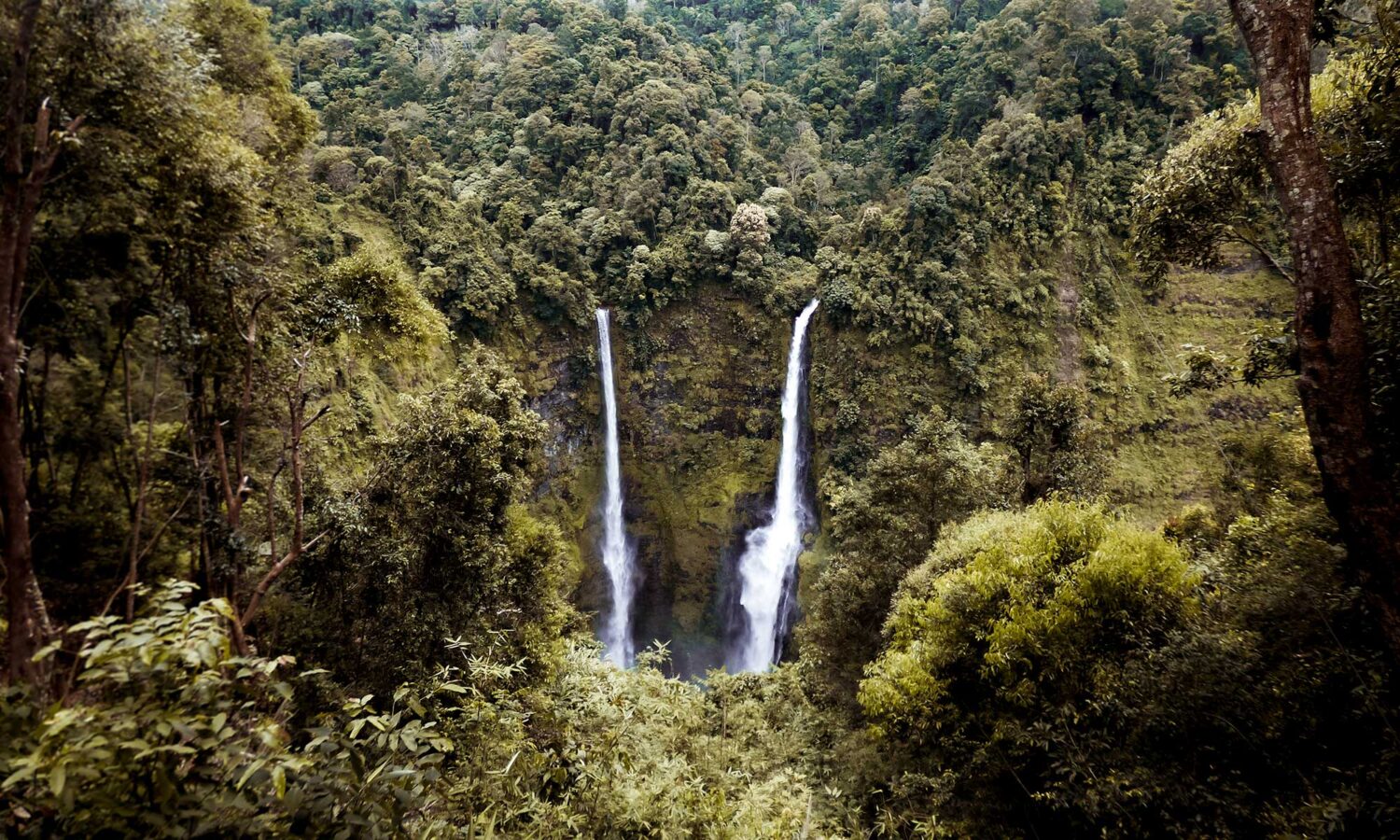
Discovering the Bolaven Plateau is a pure experience which, until now, remains untouched by mass tourism. Because of the elevation of the plateau, it is pleasantly cool. A welcome change after the sulturing heat of Paksé, the launching point for discovering the Bolaven Plateau. You can read our detailed Bolaven Plateau motorbike itinerary here .
CONTINUE READING: these are the most beautiful waterfalls in Laos
Day 12-13: Relax time at Si Phan Don (4000 islands)
What an absolute piece of heaven this is! Nothing should be, anything goes… at the end of your 2 weeks in Laos, it's a necessity to schedule some downtime in your hammock, cycle around the islands of Don Det and Don Khon looking for waterfalls or go river tubing. The laidback atmosphere and fine restaurants make you very much in danger of never wanting to leave!
We picked Don Khone island and the beautiful Sala Done Khone Hotel as our humble abode. Bicycles are available along Don Khone’s main road at 10,000 LAK (1,25$) per day. Try to find some time to get out of your hammock and cycle to the Liphee Falls , the islands’ main attraction.
Whatever you do, do not skip a meal at The Garden Resaurant on Don Khone island!
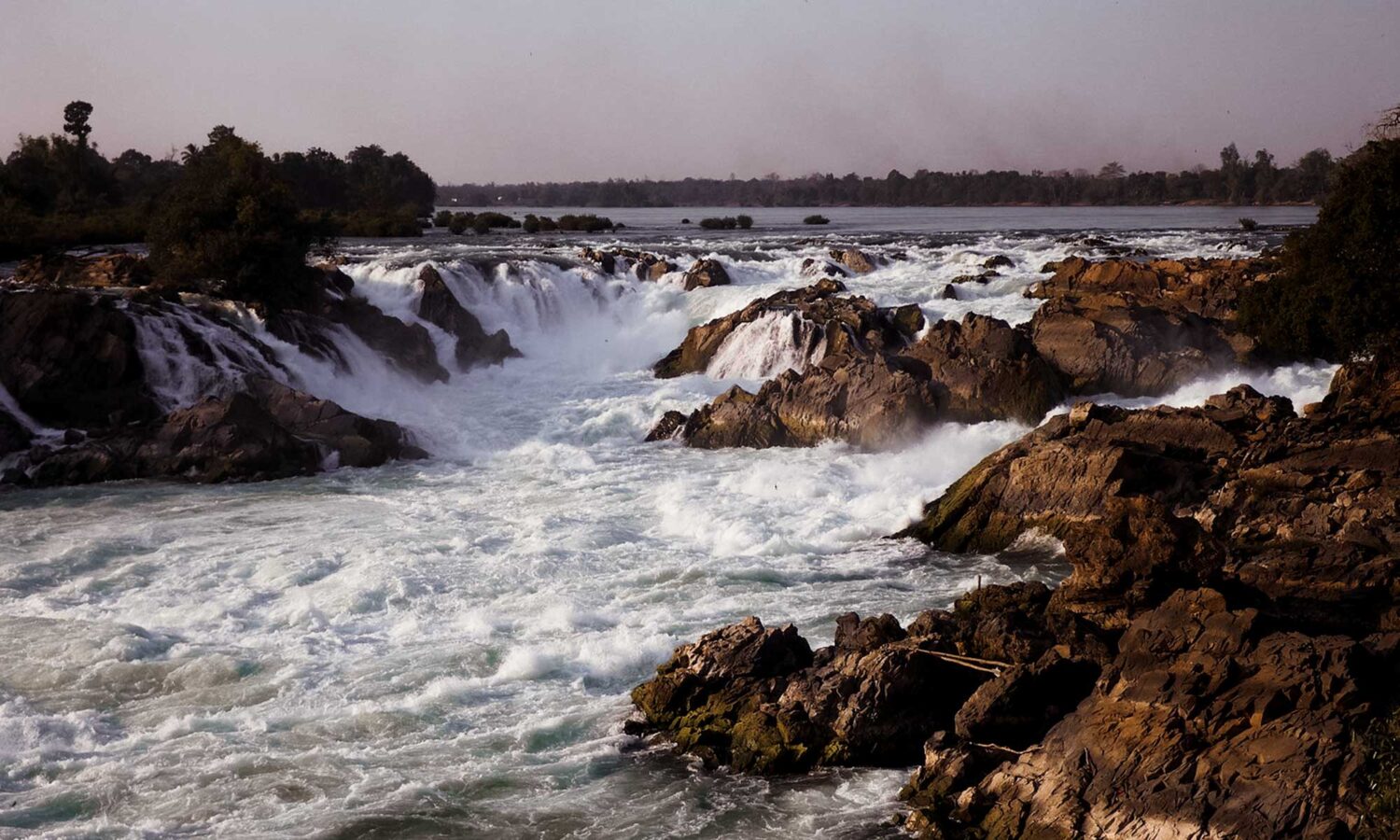
How to get to Si Phan Don (4000 Islands)
The easiest way to get from Pakse to Don Det or Don Khon is by buying a combined bus and ferry ticket. This will cost you $10 and travel time takes about 3,5 hours with Green Paradise Tours.
Busses leave at 8:30 am from Green Paradise office in Pakse and should arrive around noon. You can purchase tickets online here .
Day 14: continue your travels
It's the end of the perfect 2 week Laos itinerary!
Today you'll either continue your trip to one of Laos' neighboring countries or make your way back home. From Don Det you can easily travel overland to Siem Reap , Cambodia without having to backtrack or take a flight.
You can make your way back to Paksé by purchasing the same tickets from Green Paradise Tours. You can purchase your tickets here . You'll leave at 12pm and arrive in Paksé around 4pm.
Paksé offers different international flights. Flying to Bangkok (Thailand), Siem Reap (Cambodia) and Ho Chi Ming City (Vietnam) are easy options to extend your trip or get a connecting flight back home.
What to pack for this 2 week Laos itinerary?
Your Laos travels will take you from Laos mountainous north to the tropical, jungle clad south. Laos' greener side is luscious due to its rainfall, which means you better prepare for some random showers during your two weeks in Laos.
Whether you're visiting for a few days or spending two full weeks in Southeast Asia hidden gem, rain-proof packing is necessary. Luckily we've created a detailed a complete packing guide for humid destinations like Laos!
Pssst, this blog post contains affiliate links. This means that if you click a link, I may receive a small commission at no additional cost to you.
Are there any places on this two week Laos itinerary that we missed?
Love it? Pin it!

The Bolaven Plateau motorbike loop: the ultimate guide
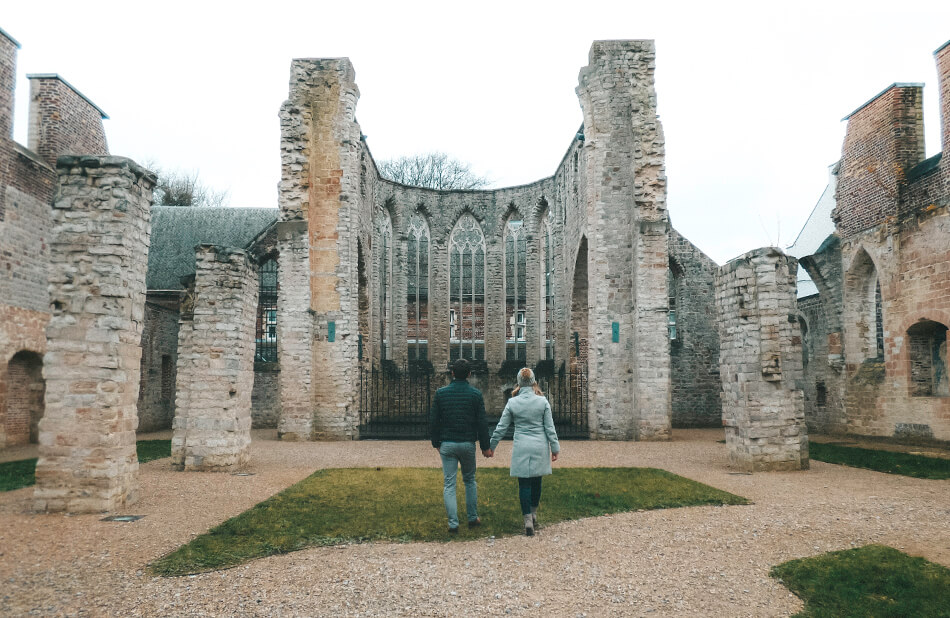
8 shockingly simple hacks to maximize your vacation days!
Great itinerary!
I’ve always wanted to visit Laos, but I kept putting it off to visit its neighbouring countries. This year I finally went there and I was surprised how amazing the country is! I loved the nature in Vang Vieng and cafe culture and architecture in Luang Prabang.
Glad you enjoyed Laos, Oona!
Great itinerary suggestions, hopefully when laos opens up again plenty will be following in these footsteps. some beautiful photos as well/
This is super helpful for my upcoming trip to Laos! And perfect because I’m also looking to visit for 12 days! Thanks for sharing ☺️
So happy you loved it Brit! Enjoy your stay in Laos, you’re going to love it 😉
Hugs, Marlo & Kristof
- Pingback: The perfect 7 day Cambodia Itinerary • Along Came An Elephant
- Pingback: How to go from Don Det to Siem Reap • Along Came An Elephant
Cancel reply
Your email address will not be published. Required fields are marked *
Privacy Overview
The far north Travel Guide
Book your individual trip , stress-free with local travel experts
- roughguides.com
- Travel guide
- Itineraries
- Local Experts
- Travel Advice
- Accommodation
While history has seen the rise and fall of a Lao dynasty enthroned at Luang Prabang, little has changed on the elevated northern fringes of the former kingdom. Decades of war and neglect have done their part to keep this isolated region of Southeast Asia from developing and have unwittingly preserved a way of life that has virtually vanished in neighbouring countries. While the fertile valleys of the Upper Mekong and its tributaries have for centuries been the domain of the Buddhist lowland Lao, the hills and mountains to the north have been the preserve of a scattering of animist tribal peoples, including the Hmong, Mien and Akha. Anthropologists, gleaning evidence largely from oral tradition, speculate that some of these tribal peoples, such as the Khmu, were actually here before the lowland Lao migrated onto the scene; others, such as the Akha, are relative newcomers. The highlanders make their living by painstakingly clearing and cultivating the steep slopes while bartering with the lowland Lao for anything that they themselves cannot harvest, hunt or fashion with their own hands. It is largely the chance to experience first-hand these near-pristine cultures that draws visitors to the region today.
Luang Namtha and around
Muang sing and around, houayxai and around, pakbeng and around, around muang long, xieng kok and around, a brief history of opium.
The far north still has an air of being untamed – and nowhere is this more evident than in Phongsali , a remote, mountainous district where the provincial capital feels as though it hasn’t changed for decades. Improved transport means that it’s now easier to explore the region than ever before, though you can still expect long journeys on endlessly windy roads. The trekking scene in Phongsali is relatively new, which makes it a great opportunity to visit hill tribes that retain a very traditional way of life. Many people come this far north in order to do the amazing boat trip down the Nam Ou, which can take you as far south as Luang Prabang, and allows you to visit otherwise inaccessible Muang Ngoi, long a favourite with visitors to the region wanting to kick back for a few days. An hour south of Muang Ngoi, Nong Khiaw straddles the river, nestling among some of the region’s most dramatic scenery, with limestone mountains all around, and excellent opportunities for exploration.
Striking east from here takes you to Oudomxai – a town with little to recommend it other than as an important transport hub; from here it’s possible to connect to most other places in northern Laos, as well as Vientiane. The most popular northern town is undoubtedly the tourist centre of Luang Namtha, a good place to relax for a few days if you’re after some home comforts. More laidback is nearby Muang Sing, reached by a stunning road journey through Nam Ha NPCA, a pristine and beautiful protected area of the country. Both towns have become popular bases for trekking, due to their comfortable accommodation and easy access to nearby Akha, Mien and Tai Dam villages.
While boat traffic on the rivers isn’t quite what it used to be, the border town of Houayxai is the popular starting point for the memorable slow boat down the Mekong, via the port town of Pakbeng, to gracious Luang Prabang. It’s now also the starting point for the fantastic Gibbon Experience, which provides a great opportunity to explore the jungle, on foot and by zip line.
Many visitors see comparatively little of the region, travelling from the Thai border down to Luang Prabang on the Mekong, perhaps swinging first up to Luang Namtha for a couple of days’ trekking, and then maybe travelling up to Nong Khiaw and Muang Ngoi from Luang Prabang. But if you’ve got time, the area deserves further exploration, and can easily be covered in a broad loop that covers both river and road, beginning with the wonderful journey up the Nam Ou from Luang Prabang to Phongsali (via Nong Khiaw, Muang Ngoi and Muang Khoua), then dropping down to Oudomxai to reach Luang Namtha and Muang Sing before heading to Houayxai to pick up the slow boat back to Luang Prabang.
Tailor-made travel itineraries for Laos, created by local experts

22 days / from 4799 USD
The Ultimate Southeast Asia Grand Tour
Explore the highlights of four countries in a bit over 3 weeks: Halong Bay & the Mekong Delta in Vietnam combined with the cities Hanoi and Ho Chi Minh City. Proceed to Cambodia with Angkor Wat before watching the monks in Luang Prabang/Laos. Your trip ends in Thailand with elephants and Bangkok.

6 days / from 1550 USD
Historical Laos
One of Southeast Asia’s lesser-known countries, Laos is definitely off the beaten track, but it has retained its culture, charm and traditional village life, wild jungle and stunning countryside. Come here for tradition and mystery and a unique adventure.

21 days / from 4545 USD
Impressions of Vietnam, Cambodia and Laos
Start and end your trip in Ho Chi Minh City and visit highlights such as the Mekong Delta, Phnom Penh with the Killing Fields, Angkor Wat, the historic city of Luang Prabang in Laos before heading back to Vietnam - Hanoi, Halong Bay and Hoi An await.
Tailor-made trips for Laos
Any prolonged travel in the north will eventually involve a stop at the rather charmless town of OUDOMXAI, sitting at the junction of routes 1 and 4. However, with good facilities, a few decent places to stay and excellent transport connections, it’s not a bad place to spend the night.
The best way to spend your time in Oudomxai is with a visit to the Red Cross Herbal Sauna and Massage – the perfect way to relax after a bone-numbing bus journey. The money goes towards supporting the Red Cross’s work in helping and educating local people. To get here, bear left off the main road (if coming from the bus station) and follow the signs.
Head up Phou Sai Hill, just southeast of the centre, for a good view over the town; the hill is crowned by a white stupa with a golden spire. The tourist office runs a number of interesting tours and treks in the area, including a walking tour of the town, a one-day visit to beautiful Muang La, stopping at hot springs along the way, and a three-day trek to Khmu villages.
Eating in Oudomxai
There are lots of places to eat along the main road, including a number of Chinese restaurants and the usual fõe places around the bus station. For breakfast, the bus station is the best option, with women selling baguettes, sticky rice and bags of fruit for 2000K each. Alternatively, Sai Jai serves breakfasts, sandwiches and coffee. For dinner, Sinuphet, has a reliable menu of Chinese–Lao dishes including fried fish with chilli (20,000K) and a tasty veg curry (10,000K), served in pleasantly homely surroundings. A good spot for a drink is Khaemkor, with a scattering of tables in a nice position by the river.
Surrounded by forested hills that remain lush even when the rest of the countryside is a dusty brown in the hot season, LUANG NAMTHA is the north’s most touristy town, though it still has a quiet local charm, away from the travellers’ cafés and tour operators. The town is a popular base from which to access beautiful Nam Ha NBCA, with a whole range of activities available, from rafting and kayaking on the Nam Tha, to exploring the surrounding area by bike and trekking to hill-tribe villages. Most of the tourist services are situated in the new town, 6km north of the old town – exploring the latter gives an idea of what Luang Namtha was like before the advent of tourism. It’s a great place in which to hire a bicycle or motorbike – just a few kilometres’ ride will take you into small traditional dusty-street villages, surrounded by rice paddies and grazing buffalo.
In the town itself, the only formal attraction is the Luang Namtha Provincial Museum, now housed in Lao–Vietnam Friendship Centre, where you’ll find displays of traditional hill-tribe costumes and artefacts, a model depicting battles that took place in the area during the civil war and a rusty collection of weaponry.
There are a number of places offering Lao sauna and massage in town – the perfect way to relax after a few days’ trekking. Opposite Panda Restaurant, just west of the main street, is a good but basic place offering both, while further north Manyvone Massage offers a range of massages, including a welcome post-trek foot massage.
The new nightmarket, opposite Manychan on the main street, is rather disappointing, though it’s a good choice for a cheap dinner. The main bulk is made up of a rather tacky mix of clothes, houseware and pirate DVDS, aimed largely at a local crowd. Much more interesting is the daily fresh market, five minutes’ walk west of the main street, where stalls groan under the weight of fruit and vegetables.
The best way to spend a day in Luang Namtha is to hire a bike and explore the local area – the map provided with all hire bikes details some good routes. The best takes you south through the old town to The Boat Landing (a good stop for lunch), from where you head east into the Black Thai villages of Ban Pasak, Ban Pong and Ban Tongkwa, following dusty streets through paddyfields with children shouting sabai di (hello) as you pass. The last stretch is on a generally very quiet main road, which loops past a few more villages before taking you back to the town.
Luang Namtha was heavily contested during Laos’s civil war and was razed to the ground. Once the fighting stopped, the surrounding hills were stripped of their trees and the mammoth logs were trucked away to China. Today, the once devastated and depopulated valley is thriving again, and from the lush surroundings you’d be hard-pressed to believe how recently it had taken place.
Nam Ha NBCA
Established in 1993, the Nam Ha NBCA is one of Laos’s most convenient and easily accessible conservation areas. Covering 1470 square kilometres contiguous with the Xieng Yong Protected Area in Yunnan, China, the park straddles two high mountain chains and boasts two peaks in excess of 2000m. The NBCA is an important biological habitat for many forest creatures, including 37 species of large mammals and 288 species of birds. However, it’s unlikely you’ll see much in the way of wildlife on a trek into the park – though the forest teems with birdsong. The best known of the park’s rivers are the Nam Ha and the Nam Tha, both of which are developed for kayaking and rafting trips.
The park is accessible by car, with Route 3 crossing the NBCA in two separate places. Within the NBCA itself are some 25 hill-tribe villages, the most populous ethnic groups being Akha, Hmong, Khmu and Lantaen, and multi-day trekking tours between these settlements are also possible. More information, as well as bookings for organized tours within the NBCA, can be obtained through the Luang Namtha Guide Services Office, Green Discovery or the Boat Landing Guesthouse.
Trekking and boat trips
At times it can seem as though every other business in Luang Namtha is offering some kind of trek, so it can be difficult to know which company to choose. The best thing is to talk to other travellers who have returned from trips to find out what their experience was like, and to visit a number of operators to gauge what’s on offer. In low season, you’ll probably find that your choice of treks is limited by those that have already been signed up for by other travellers – most companies have whiteboards outside detailing which trips are in need of people joining them.
Green Discovery (t086/211484; www.greendiscoverylaos.com) are undoubtedly one of the best set up and well-regarded operations in town, offering an excellent range of trips and treks, from a two-day kayaking adventure on the Nam Tha, to overnight treks into beautiful Nam Ha NBCA, staying at hill-tribe villages. They are committed to low-impact, eco-conscious tourism, using local staff, and the office staff will help you choose the right trip for you.
Another well-established option is the Nam Ha Eco Guide Service at the tourist office, whose options include a one-day biking tour taking in local villages and waterfalls and an intensive four-day trek to near Sam Yord Mountain.
Note that for all treks and activities, the price you pay is dependent on the number of people on it, and you should make sure that if you’re visiting a local village, a percentage of the money you pay goes towards supporting the community.
MUANG SING, located some 60km northwest of Luang Namtha, has developed a small, low-key tourist scene based around the trekking opportunities in the beautiful surrounding valley. The town makes a nice alternative to Luang Namtha, retaining a much more local feel, and with the market drawing people from the local tribes, you’re likely to encounter a number of women in traditional dress. Though the opportunities for trekking are not quite as developed as in Luang Namtha, for many this remains the premier hill-trekking destination in Northern Laos.
Muang Sing, though small, is fairly spread out; that said, most tourist facilities lie on the main road, though it’s worth exploring the quieter roads behind for a glimpse of local life. On the main road, the tribal museum, a simple but elegant wooden building, houses local textiles, tribal costumes and some Buddha images. Unfortunately, it’s rarely open during its advertised hours – though you might be able to find someone who can let you in if you walk around the building. Tucked behind the museum is the town’s principal temple, the ancient-looking Wat Sing Jai, which has a wonderfully rustic sim painted in festive hues. If you come in the morning there’s usually a lot of activity, mostly the village ladies coming to pray and make offerings.
The principal sight in Muang Sing is its large morning market, situated opposite the bus station in the northwest of town. Clustered around the gates you’ll often find women selling mounds of bright green watermelons, beyond which is the covered food market, a good spot to pick up snacks, such as melt-in-the-mouth fried bananas. A few tribal ladies sell textiles at the far end of the food market, though expect some hard selling, even if you’re just looking. If you want to take a photo of a vendor, it’s only polite to buy something first and ask permission. The market kicks off very early, just after sunrise, and though goods are on sale throughout the day, it’s best to get there before 10am in order to see the best of it. Many wandering street vendors in hill-tribe costume hang around the main street; they aren’t rude but they are extremely persistent. Practise your Lao with them until they get bored and go away.
One of the nicest things in town is the herbal sauna attached to the Puoiu 2 Guesthouse; massages are also available here.
You can explore the surrounding countryside and traditional villages on foot or by motorbike or bicycle. However, to get the most out of the area, join a one- to three-day trek through the surrounding mountains to remote and unspoilt villages where life has barely changed in centuries. A number of tour operators now offer treks in Muang Sing.
Lying within the boundaries of the region known as the Golden Triangle, Muang Sing has a long connection with opium. During the late French colonial era, Muang Sing became an important collection point and way-station for the French colonial government’s opium monopoly. In the post-colonial period and before the communist takeover, quantities of local opium found their way to RLA-controlled refineries near Houayxai. There was a brief tourist rush to Muang Sing during the 1990s, which saw opium dens reappear for a brief period, but the town now, though increasingly well set up for tourists, is a quieter choice than Luang Namtha, and has retained a definite local feel.
Villages and treks around Muang Sing
Muang Sing is located in the centre of a flat, triangular plain surrounded on all sides by high mountains. The Nam Youan River flows down to the plain from China, and numerous other streams water the valley. Scores of hill-tribe settlements are located both in the valley basin and all through the surrounding mountains; ethnic groups in the region include Tai Leu, Tai Dam, Akha, Mien, Hmong and others.
A number of places along the main road now offer a range of treks in the area – it pays to shop around before putting your name down for anything, and make sure you know exactly what you’re signing up for (and paying for) in advance. At quieter times of year, you will probably find that what trek you do is dependent on what other people are signed up for – prices reduce according to the number of people on a trip – though if you can get a group of four or more people together in advance you’re options will be a lot more open.
Trekking etiquette
While it is possible to organize trekking entirely on your own, if you arrange to be accompanied on your trek by a local who will act as a guide and interpreter, your experience will be greatly enhanced. Do-it-yourself trekkers often find that their visit to a hill-tribe village degenerates into an exercise of mutual gawking. A good guide will be able to explain customs and activities that you might otherwise find incomprehensible and can help you to interact with the hill folk, who may be unaccustomed to or apprehensive of outsiders. If you do decide to do a trek independently, using a bit of common sense and following a few rules should make for a smooth, memorable visit.
(1) Never trek alone. While Laos is a relatively safe country in terms of violent crime, there have been robberies of Western tourists in remote areas. Owing to the government’s total control of the Lao media, word of these incidents is suppressed, making it impossible to ascertain just how much risk is involved in solo trekking. Encountering armed men while hiking through the woods does not necessarily mean you are going to be robbed, but it is best to treat all such encounters with caution. If you are approached by armed men and robbery is clearly their intent, do NOT resist.
(2) Most hill-tribe peoples are animists. Offerings to the spirits, often bits of food, left in what may seem like an odd place, should never be touched or tampered with.
(3) The Akha are known for the elaborate gates which they construct at the entrances to their villages. Far from being merely decorative, the gates are designed to demarcate the boundaries between the human and spirit worlds. If you come across a spirit gate at the entrance to a village, you should find another way to walk, skirting the village to avoid disrupting it while it is being “cleansed” of bad spirits. It goes without saying that climbing onto such a gate to pose for a photograph is poor form.
(4) Many hill folk are willing to be photographed, but, just like everyone else, do not appreciate snap-and-run tactics. Old women, particularly of the Hmong and Mien tribes, are not always keen on having their picture taken. It’s best to make it clear to a potential subject that you wish to photograph them and to gauge their response before taking a photo.
(5) Don’t give out sweets or pens to village children, which often leads to them begging the same things off future tourists, and insults the self-sufficient nature of these tribal peoples. Likewise, the indiscriminate handing out of medicine, particularly antibiotics, does more harm than good. Unless you are a trained doctor, you should never attempt to administer medical care to hill people.
HOUAYXAI, sandwiched between the Mekong and a range of hills, is for many visitors their first introduction to Laos, lying across the river from Thailand. It was long an important crossroads for Chinese merchants from Yunnan, who, driving caravans of pack-ponies laden with tea, silk and opium, would pass through Houayxai on their way south to Chiang Mai, and again on the return north with their loads of gold, silver and ivory. Today, Chinese goods are still much in evidence, but exotic cargoes of silks and opium have been replaced by dirt-cheap hand tools and brittle plastic wares that are floated down the Mekong by the barge-load.
Houayxai’s only real sight is Wat Chom Khao Manilat, situated atop a hill, and reached by stairs across the road from the ferry landing. The gaudy modern sim is barely worth doing a lap around, but the adjacent, tall, Shan-style building, which was originally a sim but is now being used as a classroom for novice monks, is made of picturesquely weathered teak. Behind the modern sim is a collection of heuan pha, literally “cloth houses”, built to store belongings of the dead. Originally, these homes for the spirits were fashioned from cloth or mulberry paper, but nowadays many are constructed from plywood – a practice unique to parts of northern Laos and northern Thailand. The top of the stairway leading up to the monastery from the main road is a perfect place to watch the sun set.
There’s a traditional Lao herbal sauna run by the Red Cross, located just past the wooden bridge as you go north up the main road.
Most tourists hurry through Houayxai, either rushing through to Thailand at the end of their visas or entering from Chiang Khong and immediately heading downriver by slow boat. Despite being a border town, it’s not completely devoid of charm, though the main reason to stop here now is to take part in the acclaimed Gibbon Experience.
Down the Mekong
Originally, the Mekong’s slow boats (heua sa) were primarily for cargo and the occasional Lao passengers who relied on them for trade and transport in a part of Laos where roads are sometimes impassable. Since the Lao government eased travel restrictions allowing foreigners to ride these antiquated diesel-powered boats, thousands of tourists have made the two-day journey between Houayxai and Luang Prabang (and vice versa), stopping overnight at the village of Pakbeng.
Many travellers agree that the journey is one of those definitive Southeast Asian experiences. The riverbanks along the Mekong are sparsely populated, though the forest is not as pristine as one might imagine. Logging and decades of slash-and-burn agriculture have left their mark, and, on the more accessible slopes and summits, trees have been supplanted by rows of corn stalks and banana plants. Of as much interest are the glimpses into local village life. Fisher-folk utilizing bamboo fish-traps and prospectors panning for gold can be seen among the sandbars and jagged rocks that make this stretch of the Mekong a treacherous obstacle course. Along the way, boats often call briefly at tiny villages situated at confluences, and the villagers take the opportunity to hawk fish, game and other local products to passengers and crew.
The boats usually carry far more passengers than there are seats – take a cushion with you if possible, which will really make a difference on the long journey, as well as plenty of drinks and snacks. Turn up at the boat landing as early as you can – you may need to sign up in advance so check locally what the situation is.
A couple of luxury tourist boats also make the journey up the Mekong, the pick of which is Luang Say (wwww.luangsay.com), run by the same company as Luang Say Lodge in Pakbeng. The price includes overnight accommodation in Pakbeng, meals and drinks, plus stops at Pak Ou Buddha Cave and minority villages along the way. If you can afford the splurge, its definitely worth it to do this wonderful journey in more comfortable surroundings.
You’d be foolish to risk your life travelling the river in one of the speedboats (heua wai) which also make the journey from Houayxai to Pakbeng (4hr) and Luang Prabang (6hr); crash helmets and life-vests are supposed to be provided, and don’t forget to bring earplugs.
Note that in February 2010, water levels in the Mekong were so low that boats were suspended for a few weeks – those that did run often ended up with tourists having to camp on riverbanks and in nearby villages when the boat couldn’t make it as far as Pakbeng for the night. There seems to be no clear answer about whether it was due to low rainfall or Chinese dams further up the river limiting the flow, so it could certainly happen again. If it does, your best option is to take the bus back to Luang Prabang, rather than risk a very slow, uncomfortable and potentially dangerous journey.
Eating in Houayxai and around
Houayxai is unsurprisingly well set up with eating options. In the evenings, a number of places along the main road sell freshly barbequed fish and chicken.
The Gibbon Experience
One of the country’s pioneering eco-tourism projects takes place just outside of Houayxai in Bokeo Nature Reserve, a pristine area of jungle that had previously been unexplored by tourists. The acclaimed Gibbon Experience (t084/212021, wwww.gibbonexperience.org)is unlike anything else on offer in Laos, and has quickly become a must-do among backpackers (and others), despite its rather high price tag. Groups of no more than eight spend two nights in the reserve, on one of two trips – “Waterfall”, which involves two to three hours of trekking a day and thus gets you further into the reserve, and “Classic” which is a little more relaxed, with only an hour of walking. Each tour runs on alternate days.
Regardless of which tour you do, days are spent zip-lining through the forest canopy (an exhilarating experience) and exploring the reserve (with guides), while nights are spent in the specially crafted tree houses. Guides can be a little hit and miss, but most people say that the overall experience makes up for this. Don’t expect to see the eponymous gibbons, however, though you may hear them calling in the early morning.
Bookings should be made by telephone or in person at the Houayxai office (on the main street); the price includes all meals, accommodation, local guides and transportation to and from Houayxai.
The bustling, river port of PAKBENG is the halfway point between Houayxai and Luang Prabang, and the only sizeable town or roadhead along the 300km stretch of river between them. As slow boats don’t travel the Mekong after dark, a night here is unavoidable if you’re travelling this way – a taste of backcountry Laos complete with hill tribes and rustic accommodation. As you stumble off the slow boat at the end of a long day, the ramshackle settlement of wood-scrap, corrugated tin and hand-painted signs that constitutes the port area can be a bit of a culture shock. Since Pakbeng is many travellers’ first night in Laos, the expression on a lot of faces is one of “What have I got myself into?” Don’t worry: Pakbeng is typical of the northern backwoods only, and provided you don’t miss your morning boat you’ll be sipping lattes in Luang Prabang in no time.
Although first impressions of the town are generally unfavourable, Pakbeng is actually a very interesting place. Once extremely poor, it is now growing rapidly, with even a few big mansions going up. The town’s change of fortune is due to its role as an important trading post; goods from Thailand come down the river from Houayxai and then make their way up into the interior from here. Tourism has also been a big boon for the town, with the slow boats alone disgorging up hundreds of hungry backpackers a day.
Since most tourists to Pakbeng come by slow boat, arriving late and leaving early, many people think the port area around the landing is Pakbeng. In fact, the real town lies past the top of the hill and stretches for a good kilometre along the main road that follows the Mekong before turning north to Muang Beng and Oudomxai. The town is well worth a wander and has a couple of pleasant wats overlooking the Mekong. There’s no accommodation or restaurants in the old town, although you will find a few noodle shops and some stalls selling sausages and sticky rice.
The small market is located right at the top of the landing road past the Donevilasak where the road turns sharply right towards the town proper. There’s not a lot happening here but it’s worth visiting and there are some fõe stalls. The market convenes every morning and goes most of the day, and is frequented by Hmong women and children, although it appears that traditional dress has gone out of fashion among the Hmong in this vicinity. Heading out of town in either direction will quickly take you to very poor, traditional villages where you’ll soon be the centre of attention.
MUANG LONG is an up-and-coming Tai Leu town surrounded by Akha and Hmong villages. If you’re looking for good trekking in unspoilt areas and don’t mind basic food and facilities, then this is the place for you.
In town itself there are a few “sights”. At dawn a parade of tribal peoples comes down from the hills to trade at the makeshift market. Besides the usual basketloads of peppers, tubers and gourds, villagers bring pieces of rare eaglewood which they gather from the dense forest. This resinous wood, used in Middle Eastern countries in the manufacture of perfumes and incense, is warehoused here before being shipped off to Bangkok, where it fetches astonishingly high prices at shops in the small Arab quarter off Bangkok’s Sukhumvit Road. There’s also a diminutive Tai Leu stupa resembling those found in China’s Xishuangbanna region, which stands a few metres off Muang Long’s main road. If you look closely at concrete tablets built into the stupa, you’ll see examples of the Tai Leu script, which differs greatly from written Lao.
Buses going in both directions stop on the main road in the morning before noon. There are a few decent guesthouses in Muang Long, including Ouseng (40,000K and under), near the market, and Jony (40,000K and under); both have basic rooms, and the latter is attached to a decent restaurant.
Muang Long lies in a flat narrow valley bottom, with the Nam Ma River flowing right down the valley to enter the Mekong at Xieng Kok. Two tributaries intersect the Nam Ma right at the junction of Muang Long: the Nam Dok Long flows down from the north while the larger Nam Luang River enters from deep in the mountains to the south. Together, the two river valleys, heavily populated with ethnic tribes, form corridors into the mountains north and south of Muang Long.
There are several easy areas to explore around Long, which can be done as day-trips. To the south of town, you can follow the main road up into the mountains to a scenic waterfall and tribal villages. To the north of town is another road leading to Ban Jamai, which will eventually go all the way to Ban Chak Keun. Another option is to take Route 322 south towards Xieng Kok to the village of Somphammai where you then take a dirt road south into the mountains which leads to a number of Akha villages.
Another good location near Long is up Route 322 to the village of Ban Cha Kham Ping near Kilometre 35. This is the narrowest section of the Ma River valley and the steep mountains come right to the edge of the road. At Ban Cha Kham Ping there’s some amazing pristine subtropical rainforest which, with a guide, is well worth the effort of reaching. Regardless of what routes you take, if you do go for a do-it-yourself trek in this region, keep in mind that wandering around on remote trails in these mountains without a guide is foolhardy – ask around town.
Many people travel to Muang Long from Luang Namtha and Muang Sing by motorbike, which is probably the best option if you want flexibility and independence.
A rowdy frontier town on a remote stretch of the Mekong, XIENG KOK is the last river-town stop before China. The Upper Mekong scenery here is fantastic, the river narrow, fast and studded with islets of craggy stone, and the region’s remoteness gives it a real wilderness feel. Xieng Kok is right on the border with Myanmar, though the crossing isn’t open to foreigners. The town itself has a ramshackle charm, not least because few tourists make the trip out here.
Buses to and from Muang Long and Muang Sing depart around 7/8am, though it can be much later if there aren’t enough passengers. From Xieng Kok it is possible to travel downriver, but note that the boatmen, who know well that many travellers need to get down to Houayxai and exit into Thailand before their visas expire, have a reputation for extorting money from tourists. Expect to pay upwards of $90 for a boat. Unless you can get onto a cargo boat making its way downriver, the only other option is by speedboat, which is not recommended due to their appalling safety record (see Down the Mekong).
Some boats will only agree to travel as far as Muang Mom, about an hour’s trip north of Houayxai by speedboat, from which it should be easy enough to arrange a boat for the final stretch. There’s basic guesthouse accommodation available here (40,000K and under), and the usual noodle stalls.
There’s a handful of places to stay in Xieng Kok, the best of which is the Xieng Kok Resort (40,500–80,000K), on the embankment overlooking the river and landing. The self-contained wooden bungalows all have en-suite bathrooms (with squat toilet) and charming balconies overlooking the Mekong. Another popular choice is Khemkong Guesthouse & Restaurant (40,500–80,000K), above the boat landing and close to where buses normally drop off. The double rooms here are passable; some have en suites with squat toilets and bucket showers. All guesthouses have attached restaurants, though don’t expect any culinary marvels. Electricity in Xieng Kok is from private generators and generally available from dusk until 9pm.
Opium was introduced to Laos from two directions. Opium cultivation and use was known among tribal peoples such as the Hmong and Mien, who brought the poppy’s seeds with them as they migrated south into Laos during the nineteenth century. Because the best parcels of arable land in Laos were already occupied by the lowland Lao and Tai Leu, the tribal immigrants were forced to live at high elevations. But the newly arrived minorities soon made an important discovery: opium poppies used up less of the soil’s nutrients than other crops, reducing the frequency with which farmers had to perform the labour-intensive slash-and-burn technique. Growing opium and trading it for rice made their lives easier. By the early twentieth century, the government of French Indochina began encouraging the migration of Vietnamese and Chinese to Vientiane and the cities of southern Laos, primarily to stimulate trade, and opium addicts among these immigrants created a demand for the drug. Despite these subsequent developments, it is doubtful that the small amounts of opium grown in the hills of northern Laos ever reached the opium dens of the south. Indeed, the French opium monopoly, Opium Régie, suppressed cultivation of the poppy among the tribes of northern Laos in order to tax and control the supply of opium to the licensed dens of Indochina.
By the beginning of World War II, taxes on the sale of opium throughout French Indochina made up fifteen percent of the colonial government’s revenues. When global war disrupted the traditional maritime route of opium into Indochina, Opium Régie turned to the Hmong farmers. Past French attempts to deal with the Hmong on the issue of opium had been disastrous, leading to Hmong uprisings in the provinces of Hoa Phan and Xieng Khuang. Their fear of provoking the obstinate Hmong led the French to select tribal leaders to act as brokers. The result was an eight hundred percent increase in Hmong opium production within four years. By the close of World War II, a weakened France had lost control of much of Laos to the Viet Minh and their protégés, the fledgling Pathet Lao. A rivalry formed between two powerful Hmong opium brokers and they took opposing sides, one supporting the colonialist French, the other the communists. The defeat of the French at Dien Bien Phu in 1954 put them out of the picture for good, but the Americans were soon to fill the vacuum.
America’s efforts at combating the spread of communism in Southeast Asia created what has been termed a “Cold War opium boom”. US involvement in the civil war in Vietnam escalated during the 1950s, leading to all-out intervention and the commitment of American troops in the 1960s. In Laos, a similar situation was occurring, but with a crucial difference. Instead of sending troops into “neutral” Laos, the US sought by unconventional means to preserve the illusion of non-intervention; CIA operatives trained the Hmong guerrillas who had previously sided with the French, using their cash crop to fund their operations. A Byzantine alliance between the Royal Lao Government, opium warlords and the CIA was formed. Utilizing its own fleet of “Air America” aircraft, the CIA coordinated the collection of opium, which was transported to refineries in the Golden Triangle, the resulting heroin eventually finding its way to markets all over the globe. By the war’s end, the production of opium in the Golden Triangle, which overlaps into Myanmar and Thailand, had reached epic proportions.
Opium eradication programmes in Thailand have had much success in curtailing cultivation of the opium poppy there, and although Myanmar and Laos continue to grow opium, most experts agree that the once lucrative poppy crop has been largely replaced by the production of methamphetamine, which is in high demand in Bangkok and other urban centres in the region.
Top image: village near Luang Namtha © Bitfoto/Shutterstock
Discover more places in Laos
- The Nam Ou River Valley
The Rough Guides to Laos and related travel guides
In-depth, easy-to-use travel guides filled with expert advice.

Find even more inspiration here

Planning your own trip? Prepare for your trip
Use Rough Guides' trusted partners for great rates
written by Rough Guides Editors
updated 26.04.2021
Ready to travel and discover Laos?
Get support from our local experts for stress-free planning & worry-free travels.
- Where to stay
- Travel advice

- The Perfect One Week in Laos Itinerary
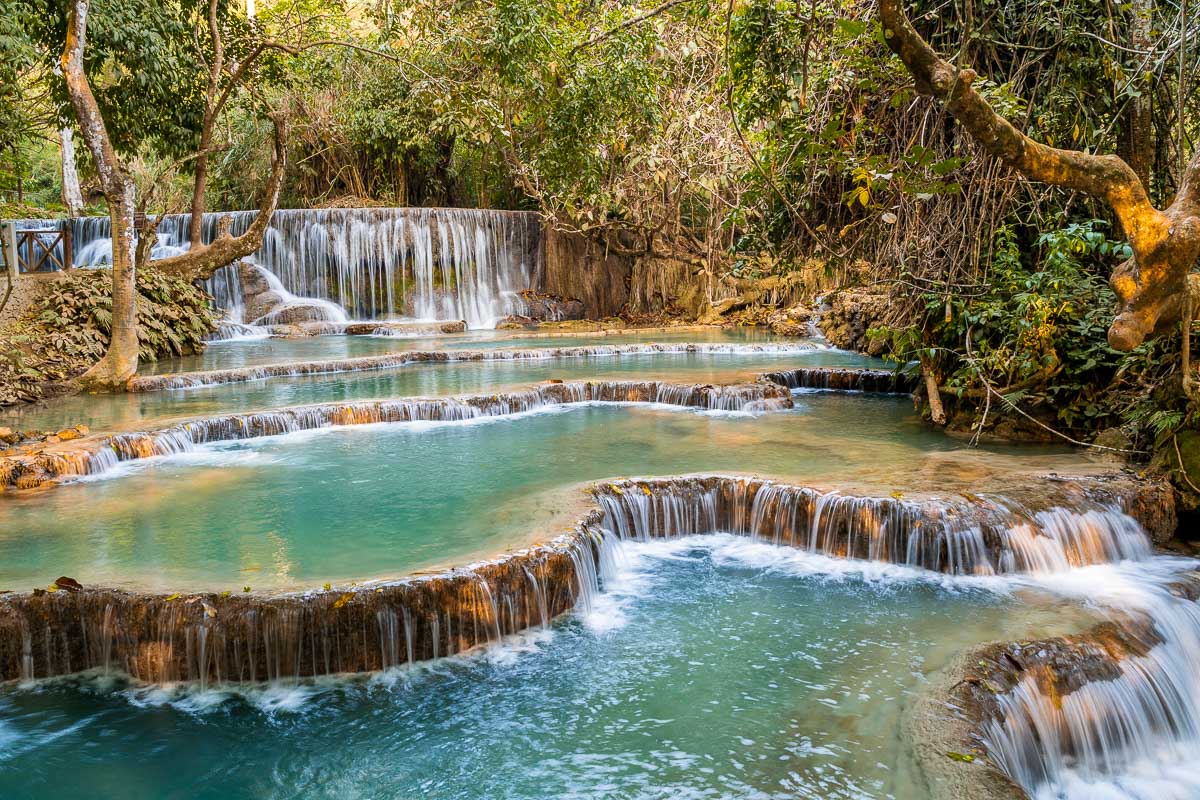
Enigmatic Laos is home to magnificent Buddhist temples, architecture that juxtaposes East and West, pristine natural landscapes, and plenty of outdoor pursuits.
As it’s still relatively untouched by mass tourism, spending one week in Laos provides you with the opportunity to experience the splendor of Southeast Asia without the crowds, hustle, and bustle.
To help you see the best of Laos in one week, I have curated the following itinerary which features where to go, where to stay, how to get around the country, and what to do.
Read on and discover the perfect Laos itinerary which allows you to maximize your time and see all the most beautiful places in Laos!
* Disclosure: This post contains a few affiliate links, which means I may receive a small commission, at no cost to you, if you make a purchase through my link. *
Table of Contents
Overview of Your One Week Laos Itinerary
Rather than telling you exactly how to spend your one week in Laos day by day, this itinerary is divided by region.
For each city, I have suggested where to stay, where to eat, and what to do while you’re there. This way you can choose to spend your days in Laos doing the activities and tours that most appeal to you.
Breakdown of your one week in Laos
The three areas that you will visit during your one week in Laos are the following:
- Luang Prabang (2 days)
- Vang Vieng (3 days)
- Vientiane (2 days)
If it’s more convenient for you, it is also possible to flip this Laos travel itinerary and start in Vientiane which also has its own international airport.
Map for your Laos itinerary
Below you can find a customized map that includes all the locations you’re going to visit on this Laos itinerary.
I marked the 3 main areas you ’ll visit during your one week in Laos with different colors – I used blue for Luang Prabang, green for Vang Vieng, and red for Vientiane, so you can easily see which places you’re going to visit in each city.
How to use this map: This map is fully interactive, so you can move around, zoom in/zoom out, and click on the icons. If you want to see a larger map, click on the bracket in the upper right corner. To see more details and the different layers, click on the tab in the upper left corner. If you want to save it for later, click on the star icon next to the name of the map. Then simply open Google Maps either on your desktop or phone, go to ‘Saved’/’Maps’, and open the map whenever you need it.
Day 1-2: Luang Prabang
Luang Prabang is located in the mountainous north of Laos in a valley at the confluence of the Mekong and Nam Khan rivers.
As a UNESCO World Heritage Site, the town is brimming with ancient architecture that fuses together traditional Lao styles with colonial French builds.
This is a laid-back city where the pace of life is slow. There are no huge skyscrapers or busy highways to contend with.
Spending 2 days in Luang Prabang is the perfect length of time to experience the major sites as part of your Laos itinerary and see why so many travelers consider this one of the loveliest cities in Southeast Asia.
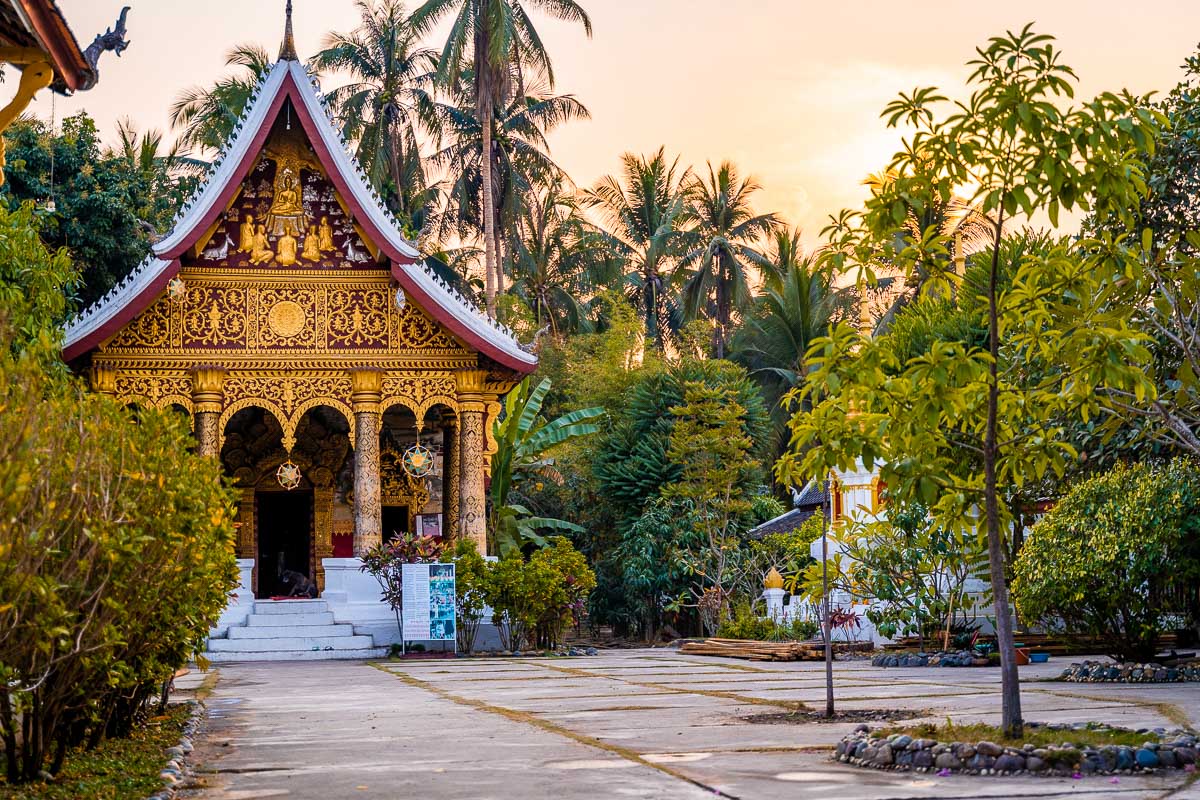
How to get to Luang Prabang
If you are traveling from overseas then you will likely arrive at Luang Prabang International Airport (LPQ). The airport is located 4 km (2.5 miles) northeast of the city.
You can fly direct to Luang Prabang from a select number of major Southeast Asian airports, Hanoi and Bangkok specifically, and if you are traveling from further afield you will likely transfer at one of these airports.
If you are already in Southeast Asia as part of a wider adventure then you could transfer to Luang Prabang by boat from Thailand. Slow boats depart from Chiang Khong (near Chiang Mai) and cruise the Mekong over the course of two days.
Where to stay in Luang Prabang
The historic heart of Luang Prabang sits right at the meeting point of the Mekong and Nam Khan rivers.
It is best to stay as centrally as possible so that you can make the most of the attractions in town and plan some early starts which are mandatory for your one week in Laos. Besides, this way you can save some cash by exploring on foot.
Here are my top picks for where to stay in Luang Prabang for different budgets.
- Luxury | Pullman Luang Prabang
- Mid-range | The Belle Rive Boutique Hotel
- Budget | Villa Mahasok Hotel
Best things to do in Luang Prabang
Cycle or walk around old town.
Luang Prabang features a dreamy fusion of traditional Lao and colonial French architecture. Carve out a few hours to explore and take photographs either on foot or with a rental bicycle.
Alternatively, you can take a tour of Luang Prabang by tuk tuk with a professional tour guide if you want to learn more about the history.
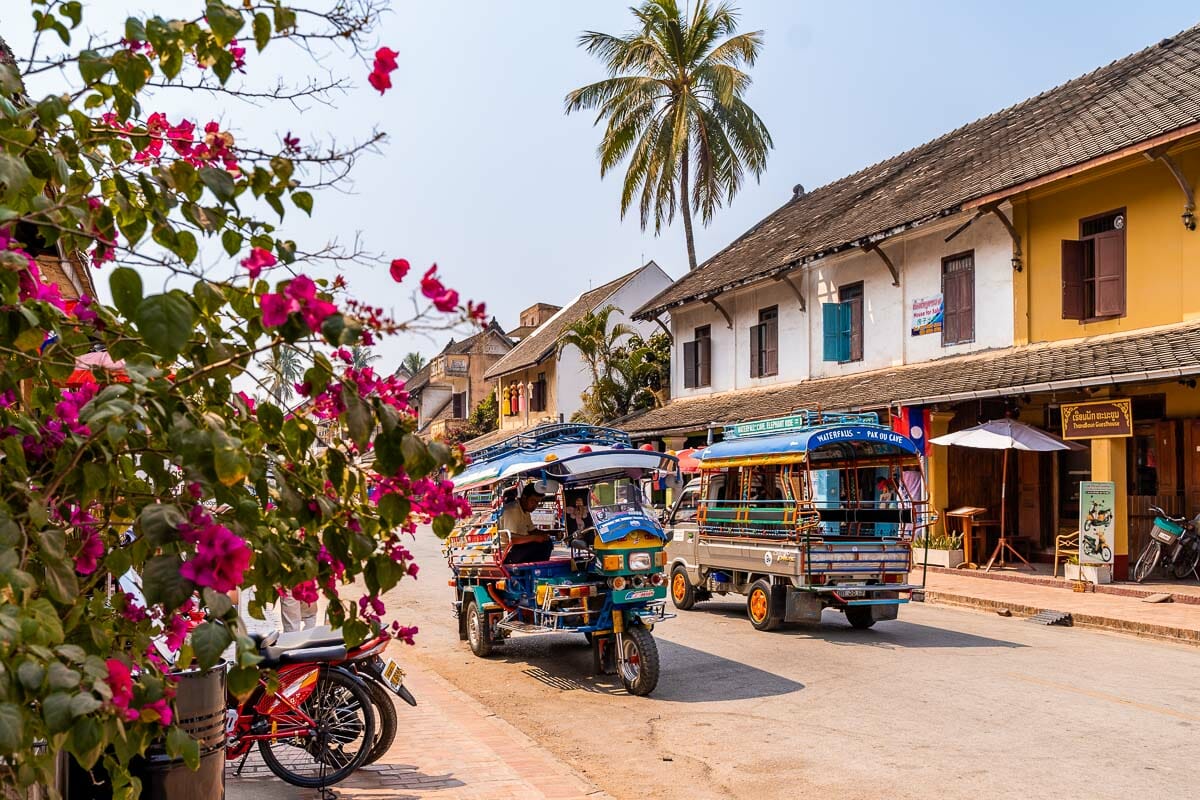
Observe the Alms Giving Ceremony
Alms giving is a ceremony whereby locals hand out offerings of rice and food to the resident monks. This takes place daily in Luang Prabang at dawn.
As a tourist, you are welcome to watch the ritual, however, it’s important to respectfully observe from a distance and not interrupt the procession of monks.
Watch the sunrise at Mount Phu Si (Mount Phousi)
Watching the morning sun flood the city atop its tallest point is a special addition to your one week in Laos itinerary.
Mount Phu Si literally translates into ‘sacred hill’ and the summit (where you will find the golden stupa of Wat Chom Si) is accessible via a climb of over 300 steps.
The 100 meters (328 feet) tall hill is located in the town center so there’s no excuse to hit the snooze button.
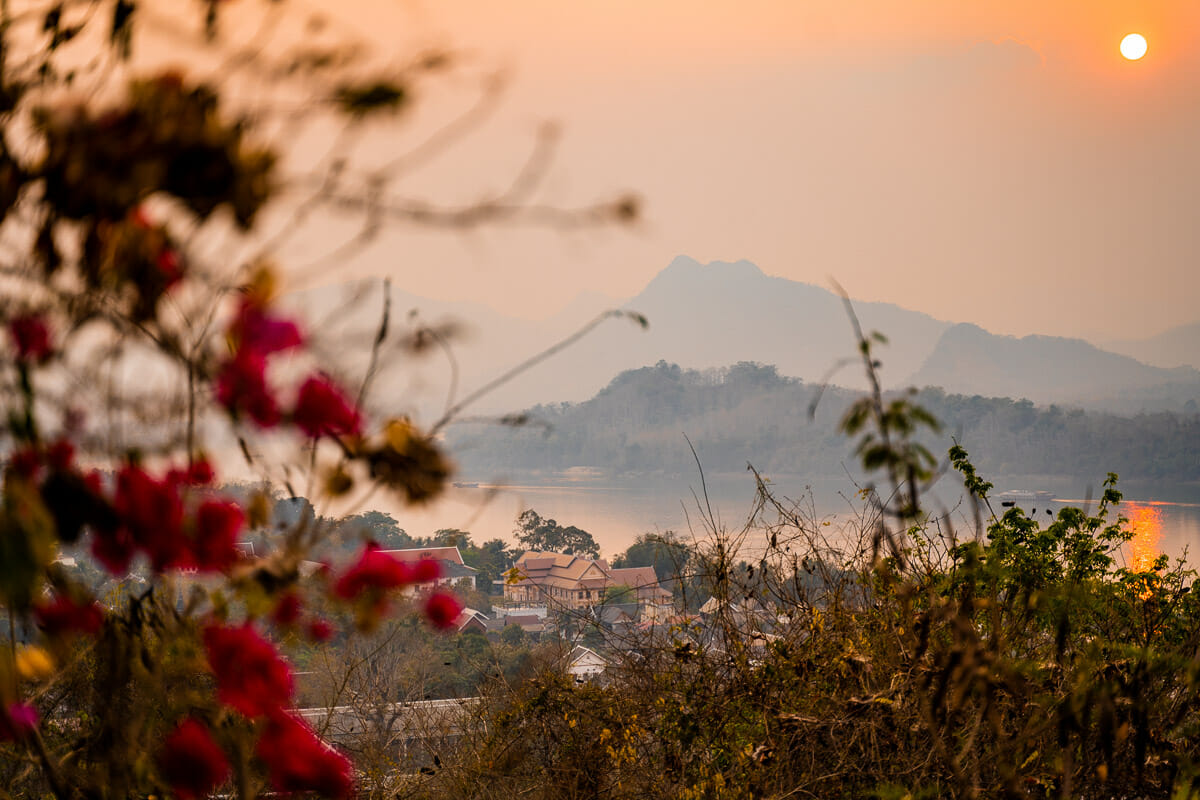
Step into Lao history at the Royal Palace
This former royal residence of King Sisavang Vong was built in 1904 using a blend of Lao and French architectural styles.
It has since been transformed into a museum that houses royal relics, holy Buddhist artifacts, and palatial apartments that show how the royal family lived. The museum is also known as Haw Kham (Golden Hall).
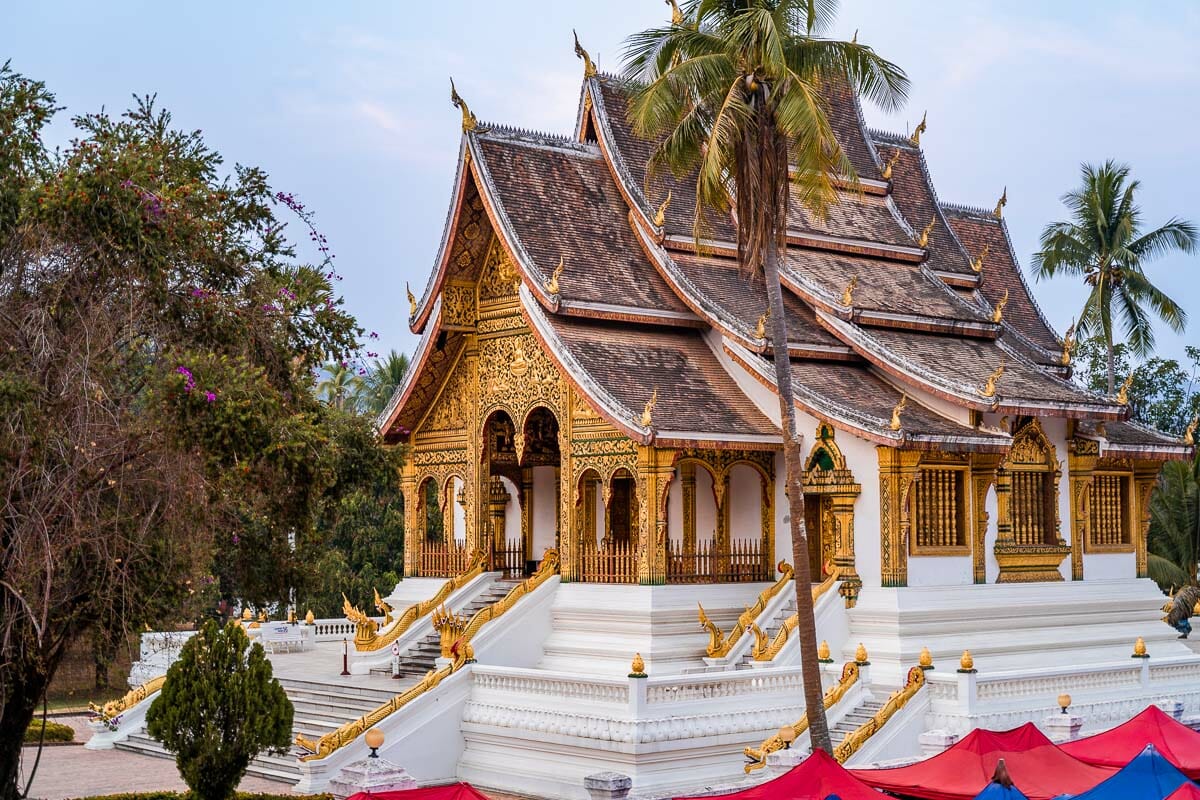
Tick off the temples of Luang Prabang
There are 34 temples awaiting you in Luang Prabang so you could easily spend your entire Laos one week itinerary hopping around them all.
Start with one of the largest and most sacred, Wat Xieng Thong, which was constructed in the 16th century.
You can visit independently or as part of this heritage sites of Luang Prabang guided tour if you want to glean more insight into Laotian culture.
Plunge into the Kuang Si Waterfall
Slip into your hiking boots and visit one of the most beautiful waterfalls in Laos which tumbles down through the jungle foliage.
Taking a dip in the turquoise pool of the Kuang Si Waterfall is the perfect way to launch into your one week in Laos.
It’s possible to climb up through the forest to reach the top of the 50 meters (164 feet) falls but you will require sturdy footwear.
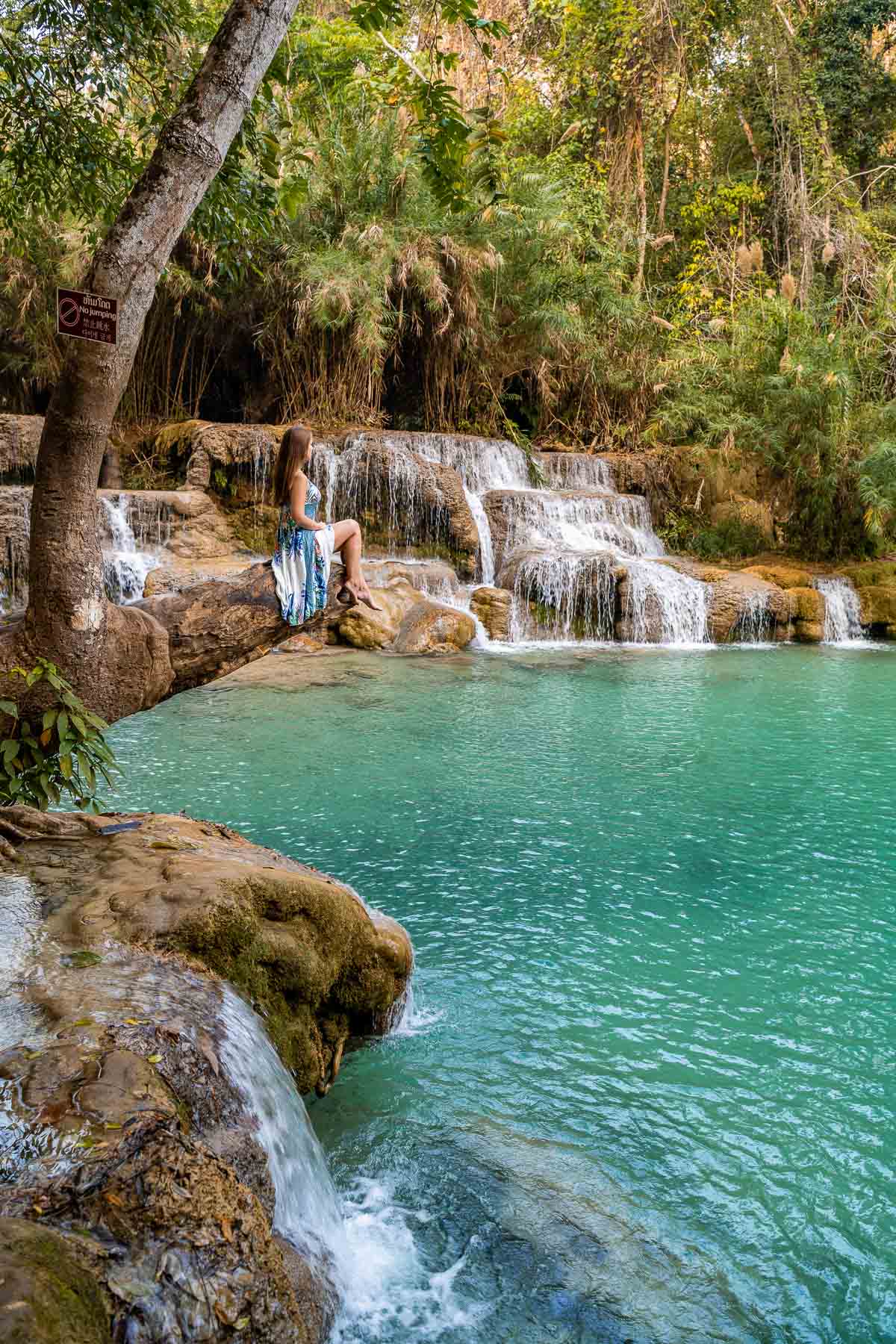
Find sanctuary at the Pha Tad Ke Botanical Garden
Considered the first botanical garden to open in Laos, Pha Tad Ke is teeming with orchids, bamboo, and colorful tropical plant life.
Your ticket includes the boat trip to and from the garden and grants access to a herbal tea tasting and whatever handicraft workshops are scheduled on the day of your visit.
Shop for souvenirs at the Night Market
There are a couple of markets in Luang Prabang where you can shop for keepsakes.
The Night Market opens every evening around 5 pm and provides you with the chance to pick up street food, textile products, and other locally made gift items. You can find it on Phothisalath Road.
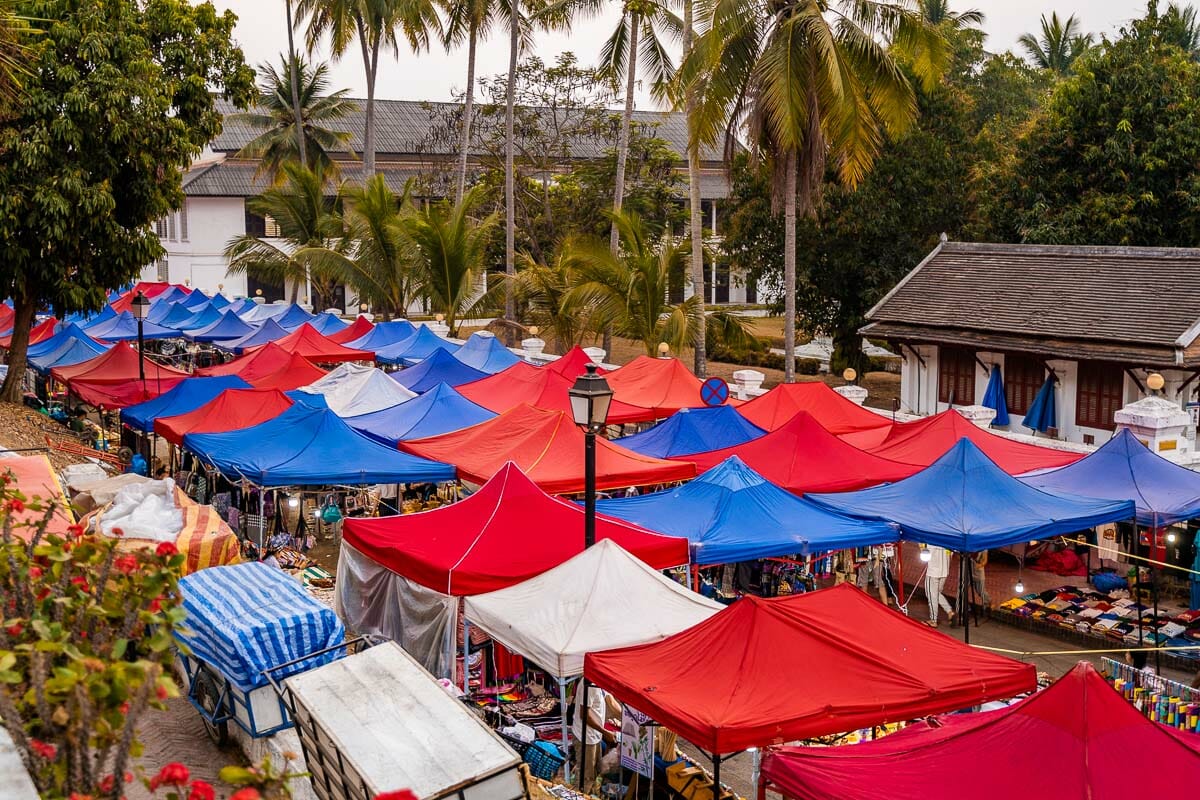
Where to eat in Luang Prabang
- Yuni Youpon : Constantly rated as the number one restaurant in all of Luang Prabang, this charming restaurant prides itself on serving delicious bites from all over the world.
- Le Calao : Situated within a refurbished colonial mansion, this riverside restaurant offers a view of the Mekong from its elegant balcony while you tuck into traditional Lao dishes.
- Saffron Coffee : Grab a morning coffee and observe the peaceful morning landscape across the Mekong. All-day breakfast and light lunch dishes are on the menu.
- Le Banneton Café French Bakery : Get your fix of quintessential French pastries or quality pizza at this popular bakery.
- Two Little Birds Cafe : Serving healthy dishes that fuse East and West, this is one of the best places to eat in town if you’re on a plant-based diet.
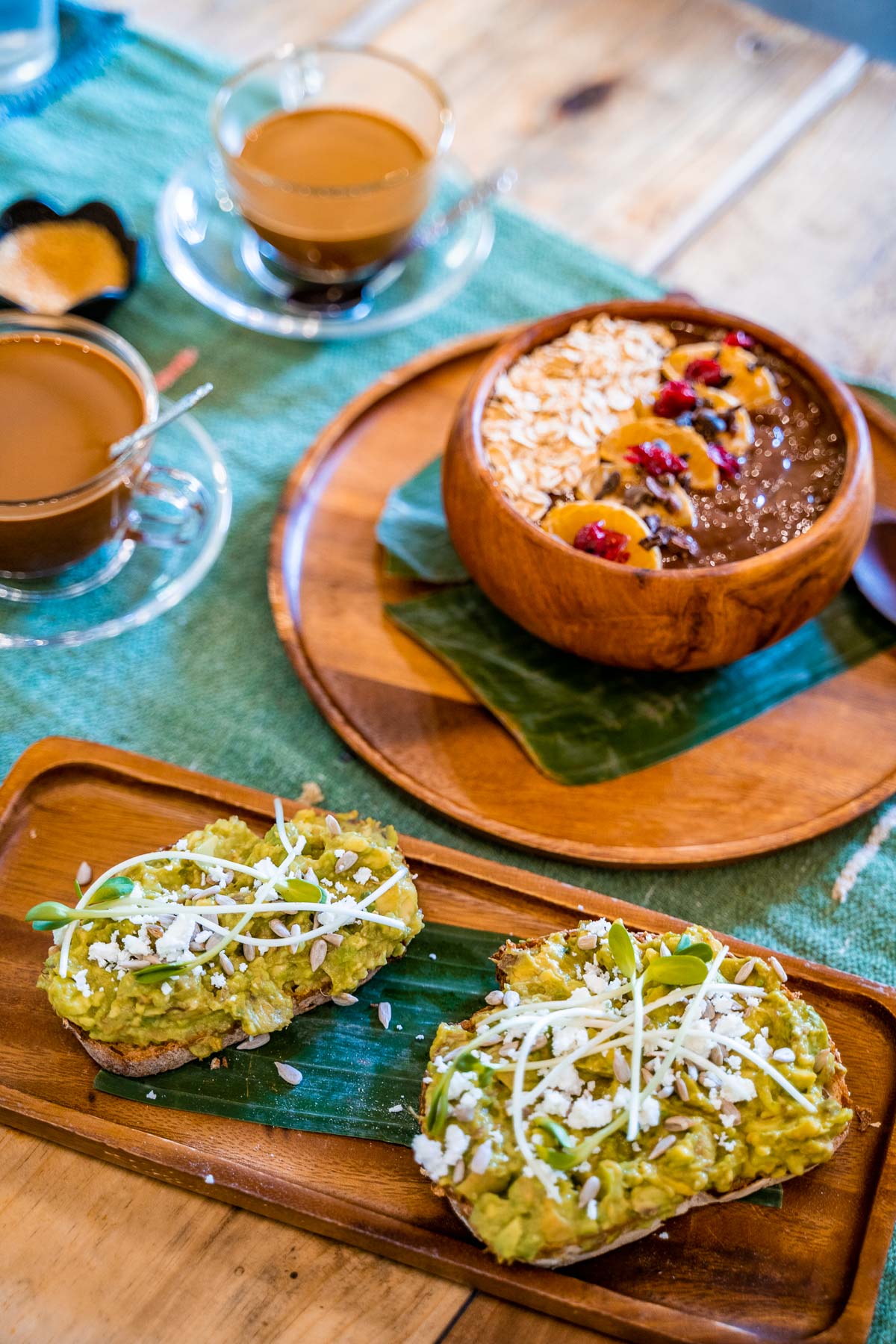
Day 3-5: Vang Vieng
Vang Vieng is one of the most gorgeous places you’ll experience while traveling around Laos in one week, or perhaps in the world.
This rural setting is where you’ll see limestone mountains, blue lagoons, caves, and plains speckled with rice paddies and tufts of greenery. There are so many incredible things to do in Vang Vieng that you can easily fill three days in the area.
When Vang Vieng first arrived on the Laos travel scene it rose to fame as a party hotspot. Nowadays it follows in the footsteps of Luang Prabang and provides a far more tranquil experience.
You’re more likely to encounter travelers waking up for a sunrise hike or taking a yoga class than partying until dawn.
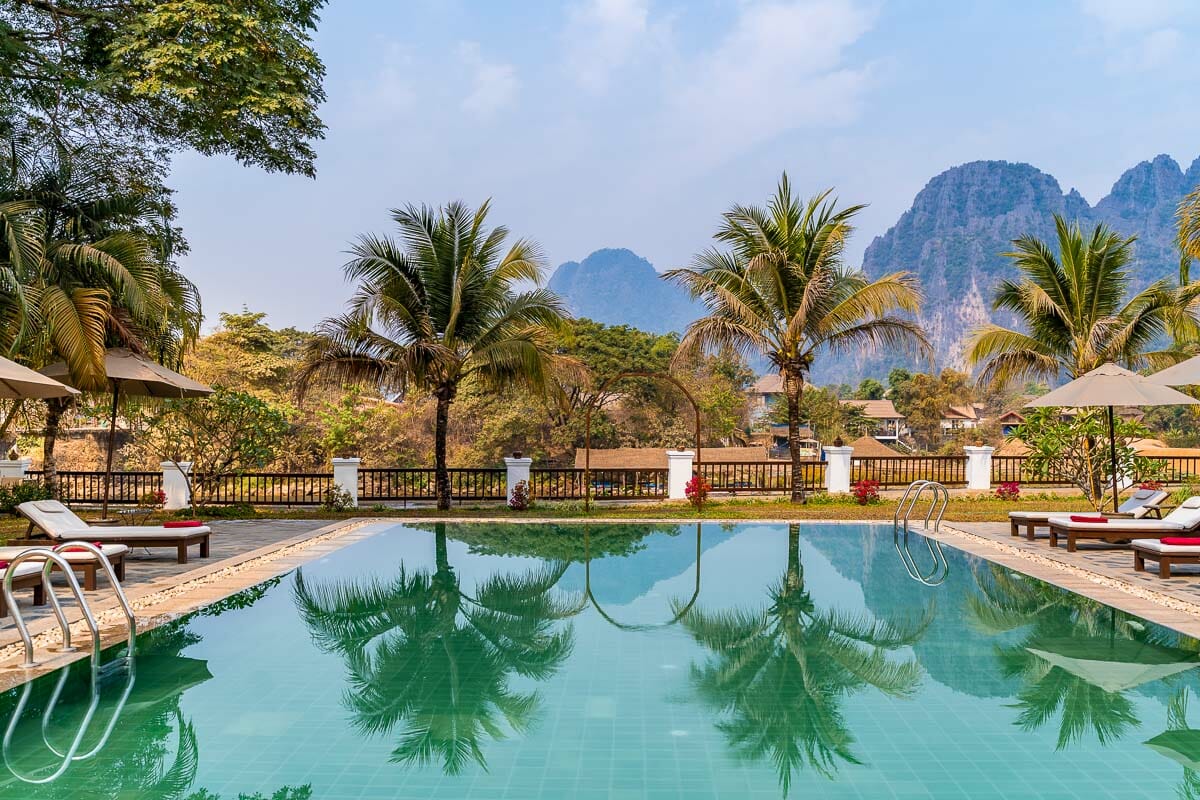
How to get to Vang Vieng
The easiest and most cost-effective way of transferring to Vang Vieng from Luang Prabang is by taking a train.
Back in the day the only way to get there was to take a very long (6-7 hours) bumpy ride through the mountains, but luckily with the newly built Boten-Vientiane railway (which is the Lao section of the Lao-China Railway), things have changed.
Now you can easily board a train in Luang Prabang and in a little more than an hour, you’ll arrive in Vang Vieng. The trains are air-conditioned and quite comfortable too, so traveling to Vang Vieng is really a breeze now.
Where to stay in Vang Vieng
In a similar vein to Luang Prabang, the center of Vang Vieng is compact and walkable.
If you want to avoid hiring a scooter and paying for tuk tuks and taxis then you are best staying as centrally as possible so that you can walk to most of the attractions on this Laos itinerary.
Here are my top hotel recommendations in Vang Vieng.
- Luxury | Riverside Boutique Resort (you can read our complete hotel review here )
- Mid-range | Confetti Garden Resort
- Budget | Sansan Resort
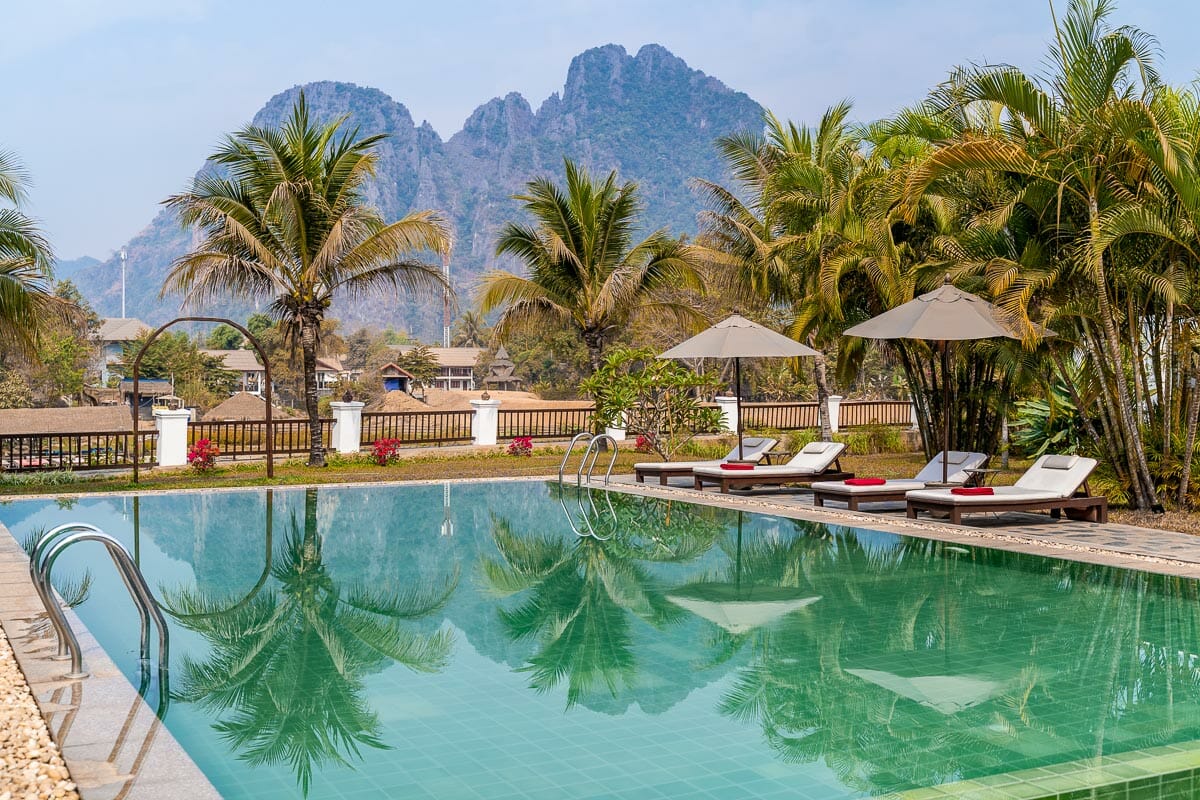
Best things to do in Vang Vieng
Swim in a blue lagoon.
Vang Vieng is famous for its resplendent blue lagoons and there are six located a short drive from the town where you can bathe in the turquoise water.
Choose to hop around the different lagoons (they are named Blue Lagoon 1, 2, 3, etc.) or relax at one for a longer time period.
You can visit independently if you hire a scooter or buggy, or else book a tuk tuk transfer to tour them hassle-free.
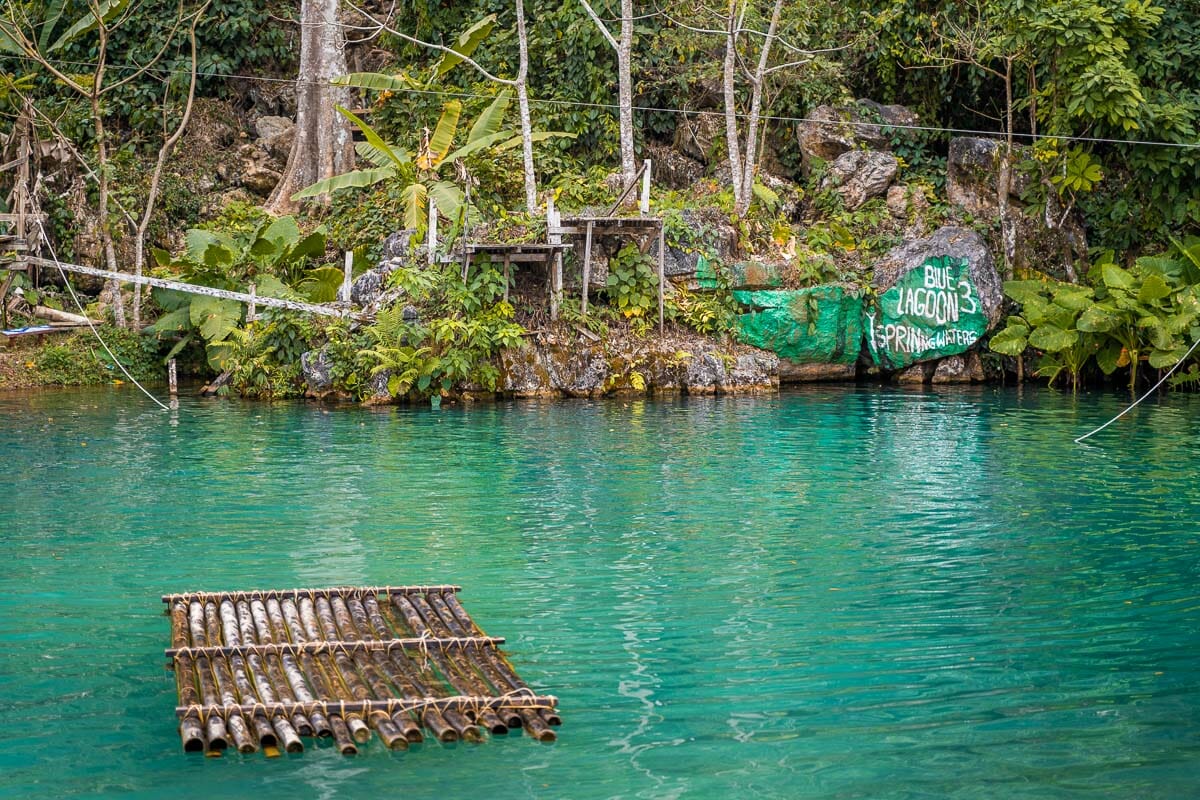
Explore Tham Chang Cave (Tham Xang)
In addition to the lagoons, there are a couple of caves located in Vang Vieng that you can explore.
One of the most accessible, Tham Chang Cave, is a short walk across the Orange Bridge and features a spring where you can take a dip. Keep your eyes peeled for the stalactite shaped like an elephant.
Tour the Nam Song River by Tube, Kayak, or Longtail Boat
You have a variety of options available for exploring the Nam Song River and its caves.
Tubing is one of the popular options for adrenaline seekers and is much safer these days with more emphasis on the experience itself rather than the partying aspect.
Alternatively, you can join a guided kayaking cruise or hop aboard a longtail boat.
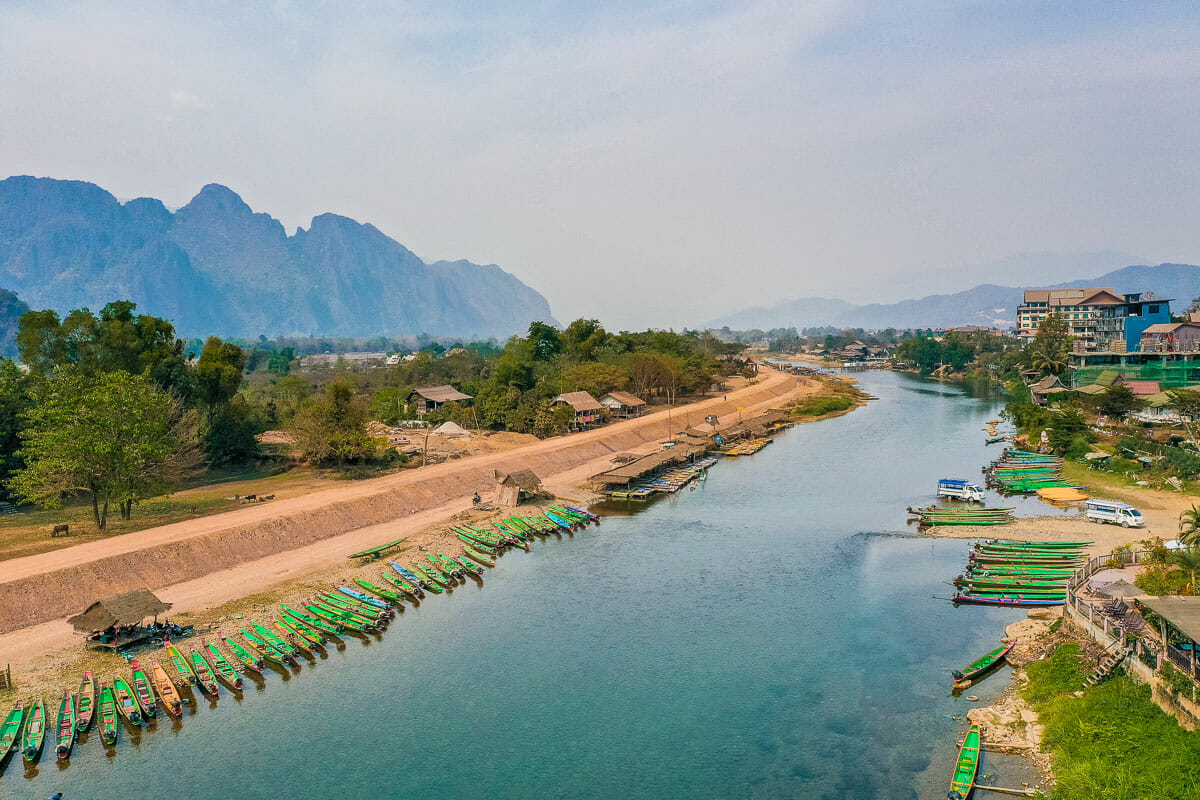
Temple hop in Vang Vieng
Vang Vieng has fewer temples than Luang Prabang so it’s easy to take some time in your Laos travel itinerary to visit them.
Retreat to the largest, Wat That, where you will stumble upon golden buddhas, nagi snakes, and other Buddhist sculptures.
If you fancy a drive through the lush landscape you can head north to Wat Pho Karm Chai Mong Kol which is set amongst the tropical greenery and provides remarkable views.
Hike to the Nam Xay Viewpoint
To appreciate the breathtaking scenery of Vang Vieng you can hike up to one of the nearby viewpoints.
The summit of the Nam Xay Viewpoint takes less than 1 hour to hike so it’s perfectly feasible for your Laos itinerary. Although do prepare for the fact that it is more of a scramble than a hike in some places.
You’ll need to dress appropriately and have your hands free to navigate your way to the incredible finishing point.
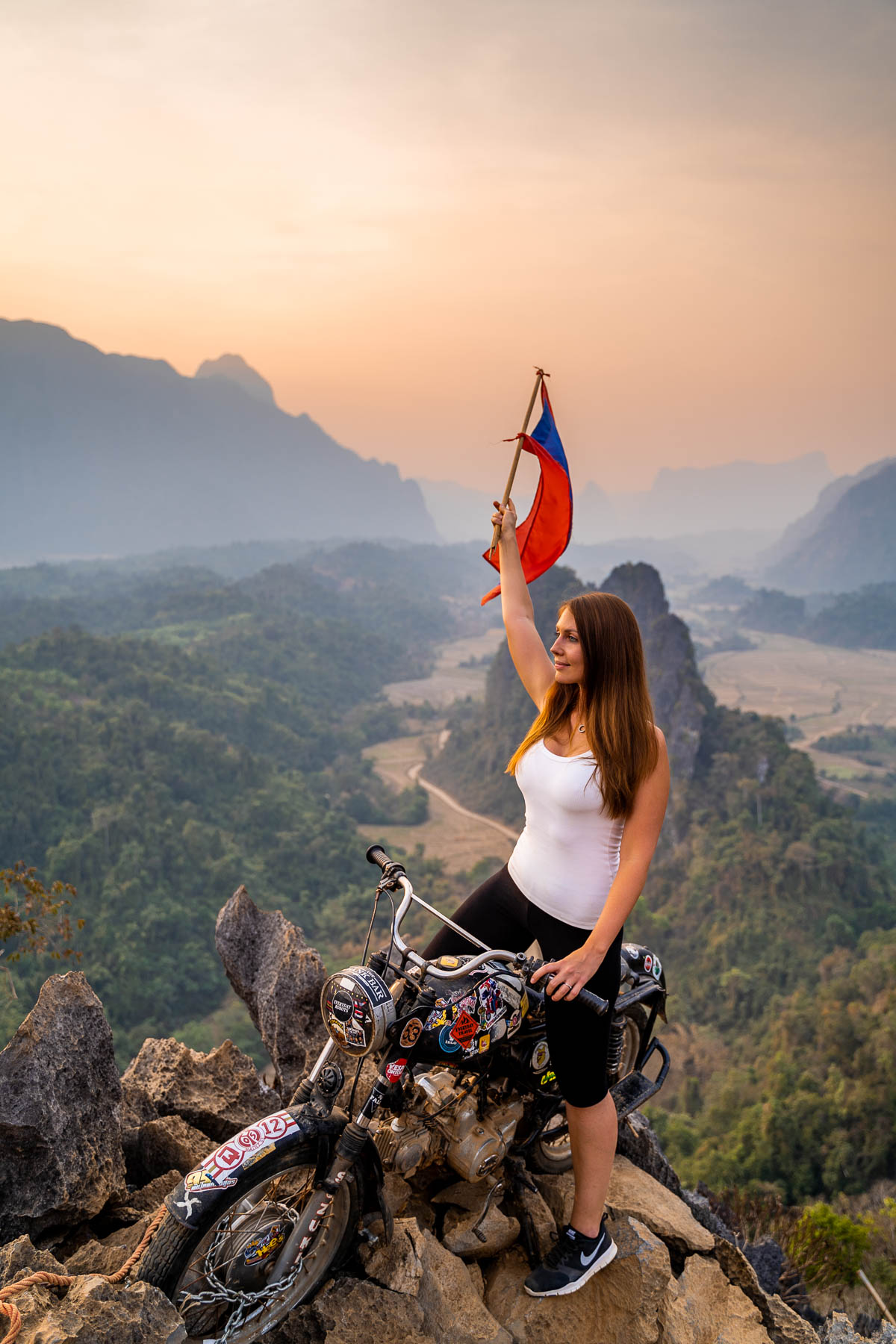
Splash out on a Hot Air Balloon Ride
Vang Vieng is one of the most affordable destinations in the world where you can ride a hot air balloon and gaze out across some of the most spectacular scenery in the world.
Above Laos schedules daily flights at sunrise and sunset, subject to the weather conditions.
Stroll through the rice fields
In between all the water activities and high octane activities, take some time to enjoy the serenity of Vang Vieng by taking a stroll in the surrounding rice fields.
Cross the Namsong Bridge to the western bank of the Nam Song River and you’ll find some of the most picturesque in the area surrounding the hotels of Vieng Tara Villa and Maylin Guest House.
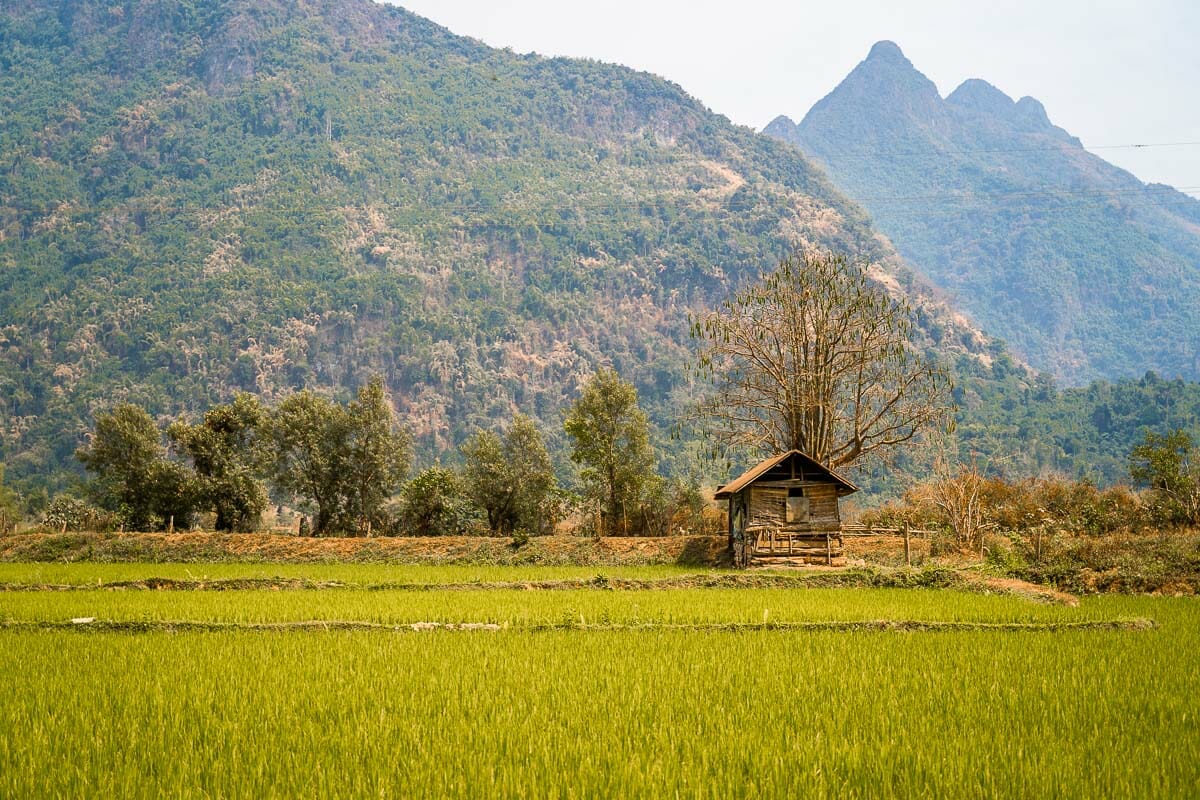
Where to eat in Vang Vieng
- Restaurant du Crabe d’Or : Discover exactly why this is the top-rated restaurant in Vang Vieng! Meals fuse Lao, Asian and French cuisine paired with imported fine wines with a magical view of the Karst mountains.
- Thammada Kitchen : This is a small restaurant with a boutique menu that’s bursting with flavor. Try their signature coconut shrimp curry.
- Phubarn Cafe : A riverside cafe with a good selection of hearty main courses, smoothies, wines, and beers.
- Naked Espresso : Recover from your early morning antics with a flat white or fresh green tea and a slice of cake at this centrally located cafe.
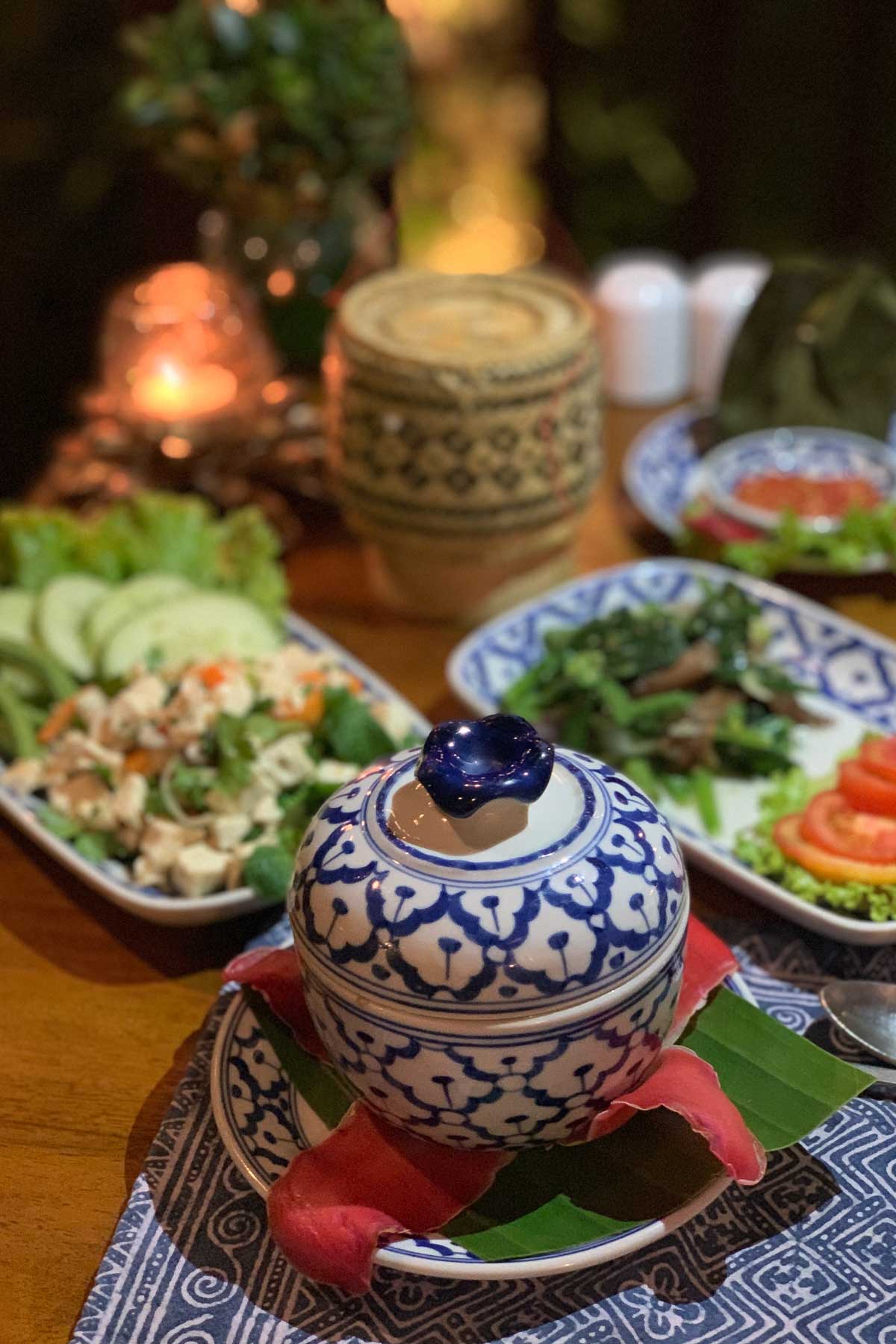
Day 6-7: Vientiane
Located close to the Thai border, Vientiane is the capital and largest city in Laos.
Keeping up with the trend set by Luang Prabang and Vang Vieng, do not travel to Vientiane seeking chaos and noise – the city maintains the level of calmness that is synonymous with Laos.
The city is punctuated by yet more glorious architecture, temples, landmarks, and places to indulge in Lao cuisine.
Dedicating two days of your one week in Laos itinerary is the perfect amount of time to explore the inner city and plan a trip to the outskirts to see some of the unique attractions of Vientiane.
Vientiane is the location of the only other international airport in Laos and so you can choose to start your travels here if you prefer.
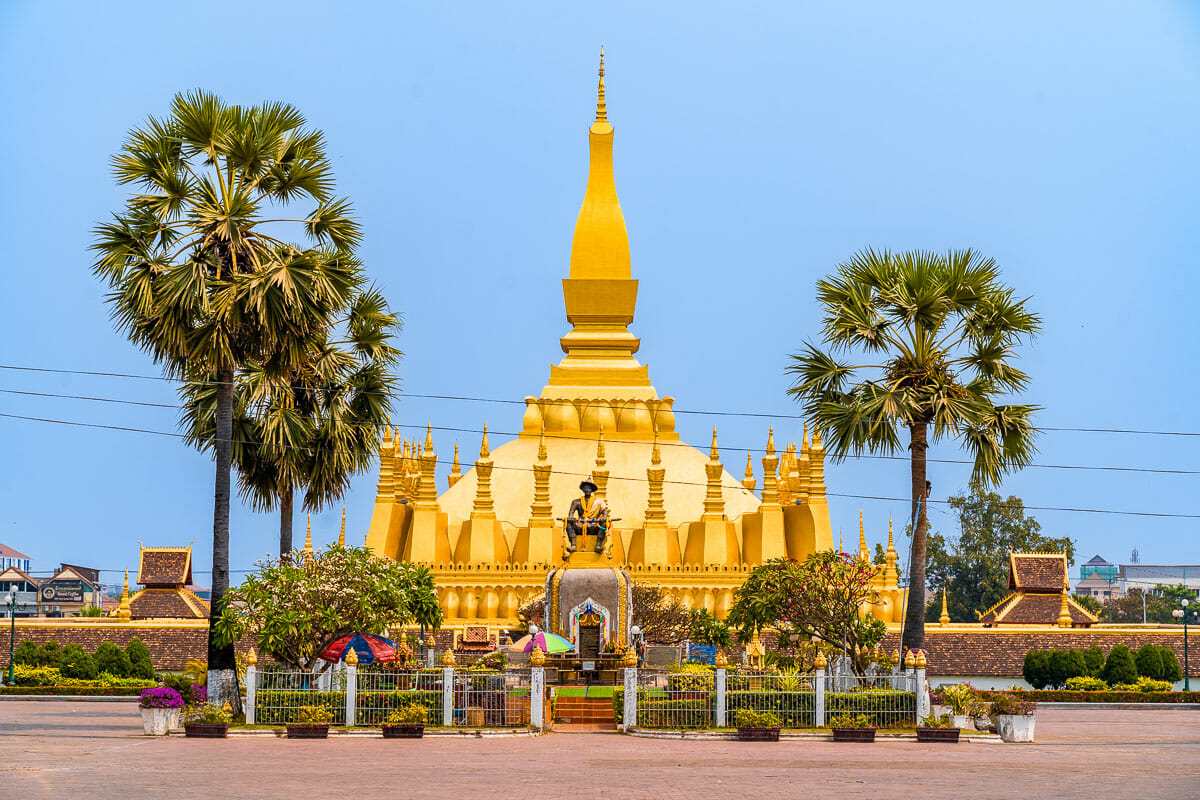
How to get to Vientiane
Again, the easiest way is to travel by train. The journey only takes a bit more than one hour, making it much quicker and more comfortable than the old bus rides.
Where to stay in Vientiane
Vientiane is the largest place that you will visit during your one week in Laos and as such, the city districts are more spread out.
With two days to spend in Vientiane, it’s best to stay centrally and choose a hotel close to the riverfront in the Ban Haysoke and Watchan neighborhoods. This way you can walk to attractions or hop on the public bus or call a taxi with the rideshare app, LocaLaos.
Here are the three top places to stay in Vientiane with different budgets in mind.
- Luxury | La Seine Hotel
- Mid-range | Lao Poet Hotel
- Budget | Vientiane Boutique Hotel
Best things to do in Vientiane
Admire the patuxay monument.
As you pass by this towering memorial archway you might think you’ve teleported to Europe. This landmark was constructed to commemorate the Lao people who fought for independence from the French and in subsequent wars.
It is inspired by the Parisian Arc de Triomphe but once you get up close, you’ll see that it actually features Lao motifs.
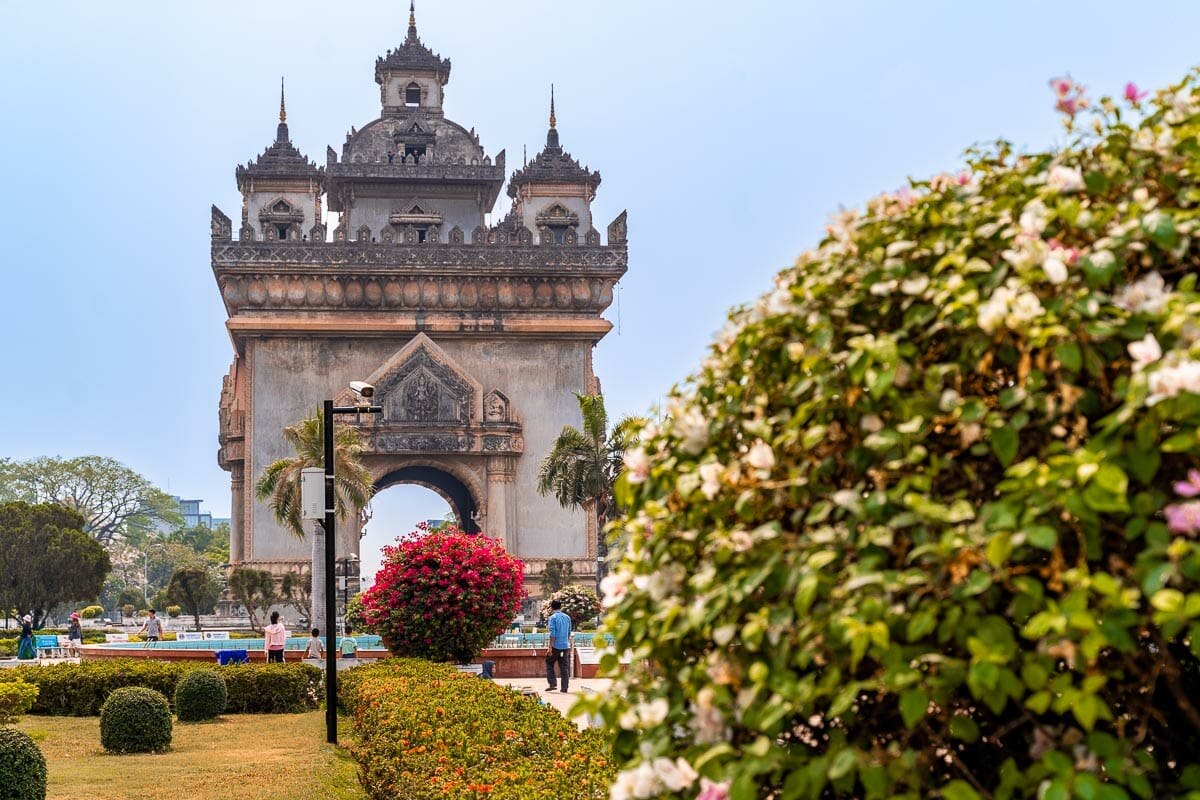
Visit the Haw Phra Kaew (Hophakaew Museum)
Formerly a Buddhist temple, Haw Phra Kaew has since been converted into a museum.
The foundations of the building date back to 1565 when it was erected to house the sacred Emerald Buddha. It has been rebuilt several times and now contains a wide selection of Buddhist relics and artifacts.
Discover textile culture at the Lao Textile Museum
If you can’t help admiring the exquisite textiles of Laos then you might enjoy taking a trip to the Lao Textile Museum and seeing how the women dye and weave fabrics using traditional methods.
The museum is slightly further afield so does require transport to get there and you may want to coincide it with a trip to the nearby Lao National Museum.
Tour the temples of Vientiane
Another city, another list of temples to discover during your one week in Laos!
Visit Wat That Khao to see the colossal reclining Buddha and Pha That Luang to see the 44 meters (144 feet) tall stupa. The early 19th century Wat Si Saket is one of the oldest temples in town and is built in the Siamese style.
Again if you want to gain more understanding of the heritage behind the temples and the Patuxay Monument you might prefer to join a walking or even a cycling tour of Vientiane.
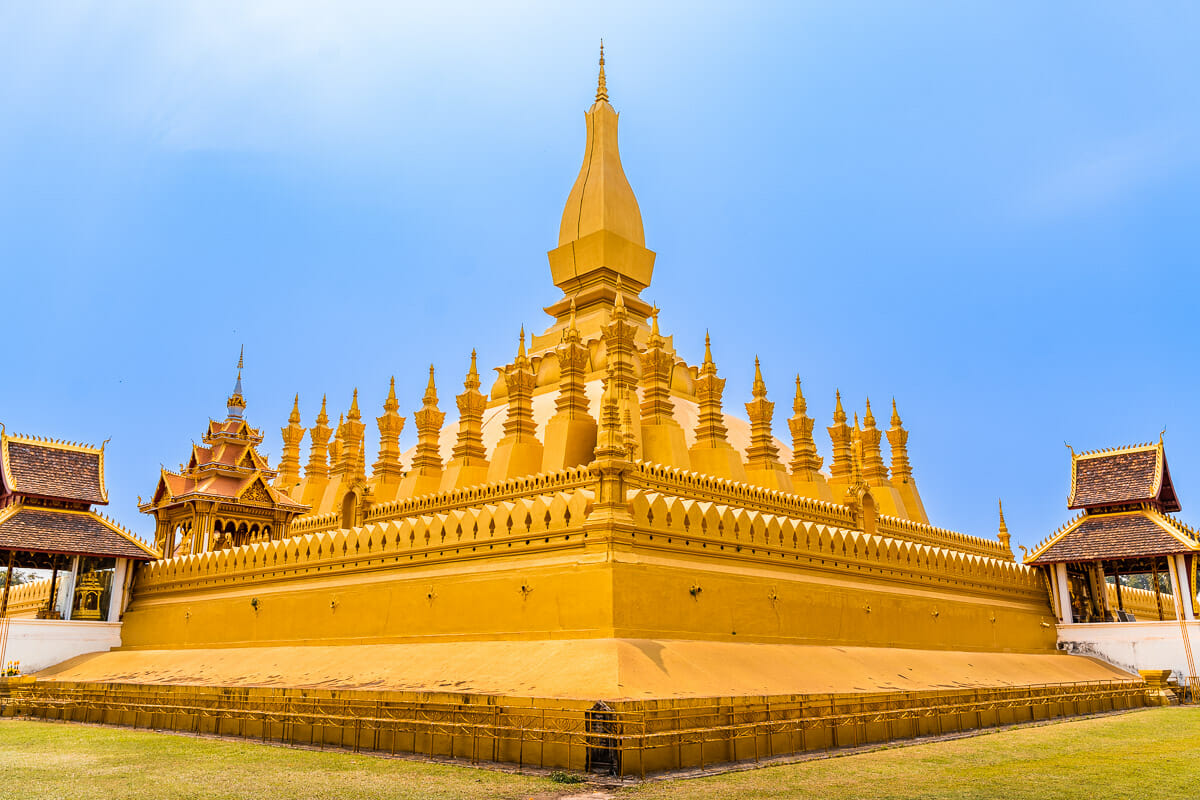
Watch the sunset from Chao Anouvong Park
This riverside park is the perfect place to survey the Mekong river and enjoy watching your final sunset in Laos.
It’s also the setting of the daily night market which springs to life around 6 pm and gives you a chance to pick up some Lao street food, handicrafts, clothing, and other trinkets.
Take a Lao Cooking Class
If you’ve fallen head over heels with Lao cuisine then taking a cooking class that enables you to whip up your own dishes back at home is the ultimate souvenir from your one week in Laos.
Cooking classes in Vientiane typically start with you selecting your own herbs from the garden and learning about the theory behind typical Lao dishes.
Roam in Buddha Park (Xieng Khuan)
Situated 22 km (13.7 miles) southeast of downtown Vientiane, this park is brimming with Buddha statues as well as representations of various other creatures from Buddhist and Hindu mythology.
You can visit independently or book a Vientiane highlights tour that concludes at the park.
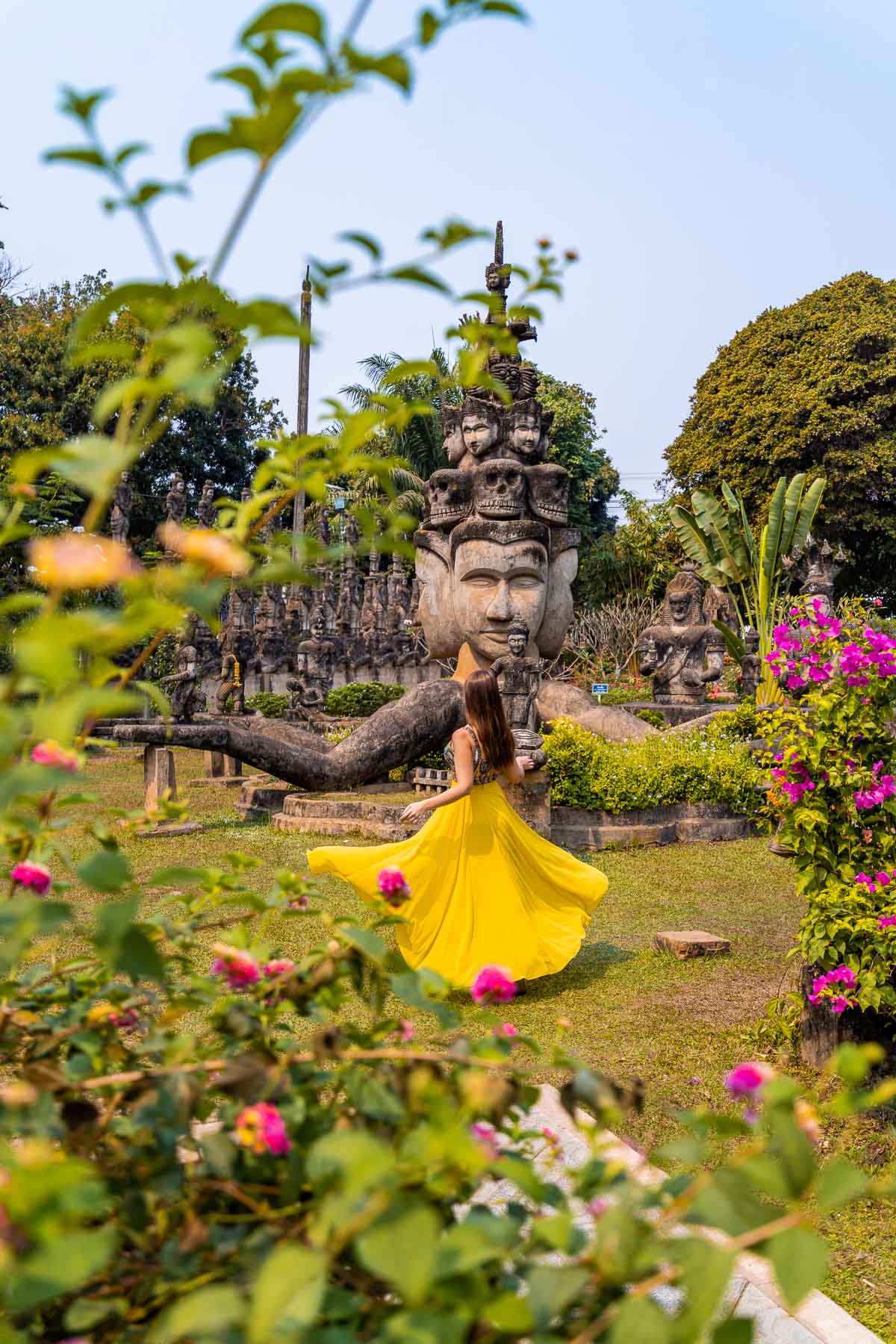
Where to eat in Vientiane
- The Living Library Restaurant : The garden setting is worth it alone but the healthy vegetarian/vegan food makes it all the better. Food is artistically presented and packed with nutrients.
- Belle Époque Brasserie : An elegant dining room where you can choose between French, Lao, and vegetarian sets or browse an extensive a la carte.
- The Cabana Design Studio & Café : An arty cafe where you can indulge in healthy brunch plates and not so healthy cakes. Their coffees and juices are exactly what you need to recoup some energy in between sightseeing.
- Annabelle : There are two outposts of this cafe in Vientiane, one is situated in the city center while the other is located in Saphanthong Village. It’s a dainty setting where you can sip French coffee and enjoy a butter pastry or stuffed croissant.
Planning a trip to Laos?
Then you might want to take a look at all our other travel guides about Laos. I promise, they are just as awesome as this article was!
- Top 10 Best Things to Do in Vang Vieng, Laos
- The Perfect 2 Days in Luang Prabang Itinerary for First Timers
- Hotel Review: Riverside Boutique Resort Vang Vieng
Pin It for Later!
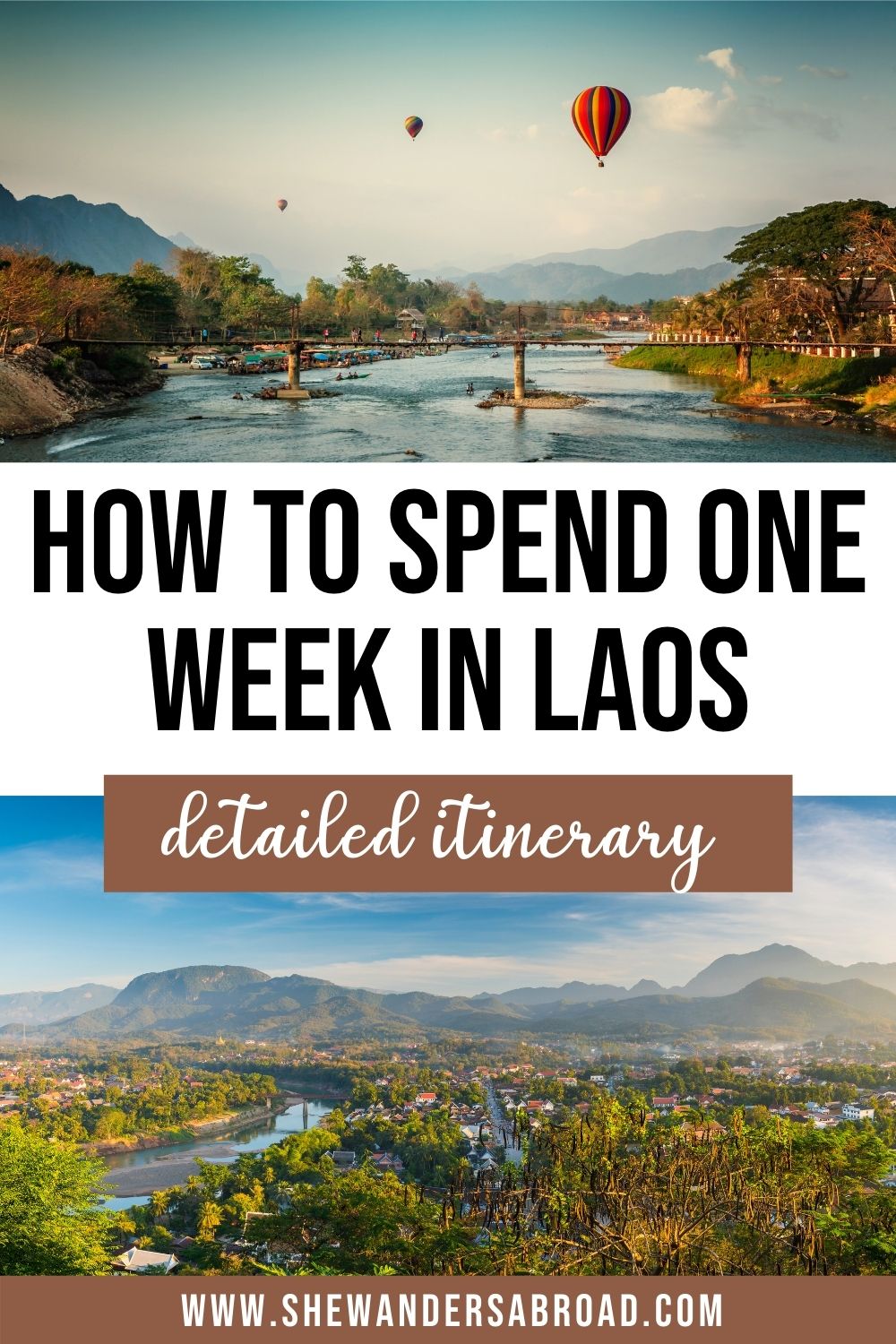
Leave a Comment Cancel reply

Laos Itinerary – Best Places to Visit in Laos for 10 Days
Laos packs a lotta punch for a landlocked country that is often overlooked in favour of its more famous neighbours like Thailand and Vietnam. Other than beaches (duh!), Laos has all the ingredients for a perfect South East Asia escape – quaint towns, beautiful landscapes, wild jungle, adventure activities, fascinating history, friendly locals, good food and of course a cold Beerlao or ten. Phew! Read this post to discover the best places to visit in Laos and how to incorporate them into an unforgettable Laos itinerary.
Why Visit Laos?
Laos is a landlocked country, bordered by Vietnam, Myanmar, Cambodia, Thailand and China. But don’t go discounting Laos just because you’re dreaming of tropical Southeast Asian beaches.
Nope, I’ve been to every country in Southeast Asia bar two (Brunei and Timor-Leste), and it’s a close tie between Laos and Vietnam for my favorite country in Southeast Asia. Got your attention now? I was suprised too, but let me list thy reasons I love Laos.
Reason One – Fewer Crowds: Laos is wilder and more off the beaten track than Thailand and much of Southeast Asia, but is still accessible and tourist friendly. We stuck to fairly touristy towns, and even then it was easy to escape the crowds and find your own piece of paradise only a few kilometres (or less!) from the centre. (I think that’s at least ten reasons in one.)
Reason Two – Natural Paradise: Laos is an outdoor lovers dream. There’s endless outdoorsy things to do in Laos. You’ve got epic waterfalls, hiking, caves, mountains, kayaking, tubing, lagoons, forest, you name it. (Except beaches, don’t name dem.)
Reason Three – Quaint Towns: As well as the great outdoors, Laos boasts one of the best old towns in South East Asia. Luang Prabang is on par with its neighbour Vietnam’s more famous old town of Hoi An .
Reason Four – Somber History: Laos has some interesting, horrific and often overlooked history. Did you know that Laos is the most heavily bombed country in history? Many people don’t realise that Laos was bombed by the US during the Vietnam War in the late 60s and early 70s, and that roughly 80 million unexploded bombs remain today.
OK, this list could go on and on and on, but time is money and all that, so if you’re not convinced yet, keep reading for a little destination inspiration on where to go in Laos.
How Long to Spend in Laos
Most people spend one to two weeks in Laos and focus on the north or south during this time. If you want to visit most of Laos’ highlights and cover both north and south, I recommend 3 to 4 weeks in Laos.
One to Two Weeks in Laos
We had 10 days in Laos and focused on the north. We visited Vientiane (2 nights), Vang Vieng (3 nights) and Luang Prabang (4 nights). If you’re more the outdoor-adventure-type than the old-town-culture-food-type, switch up the number of nights and spend longer in Vang Vieng than Luang Prabang.
You could also squeeze Vientiane, Vang Vieng and Luang Prabang into one week in Laos, or stretch them out into two weeks in Laos for a more relaxed itinerary. In fact, I could happily have spent an entire week in each of Vang Vieng and Luang Prabang alone, both contenders for my favourite town in Southeast Asia!
Three to Four Weeks in Laos
Going to Laos for longer than two weeks? In the north, consider adding Houayxai and Phonsovan. For a cross-country adventure, the highlights in the south are Pakse and 4000 Islands.
Laos Itinerary for 10 Days in Laos
Right, let’s drill down into the best places to visit in Laos and things to do in Laos to build your perfect 10 day Laos itinerary!
Vientiane: 1-2 Days
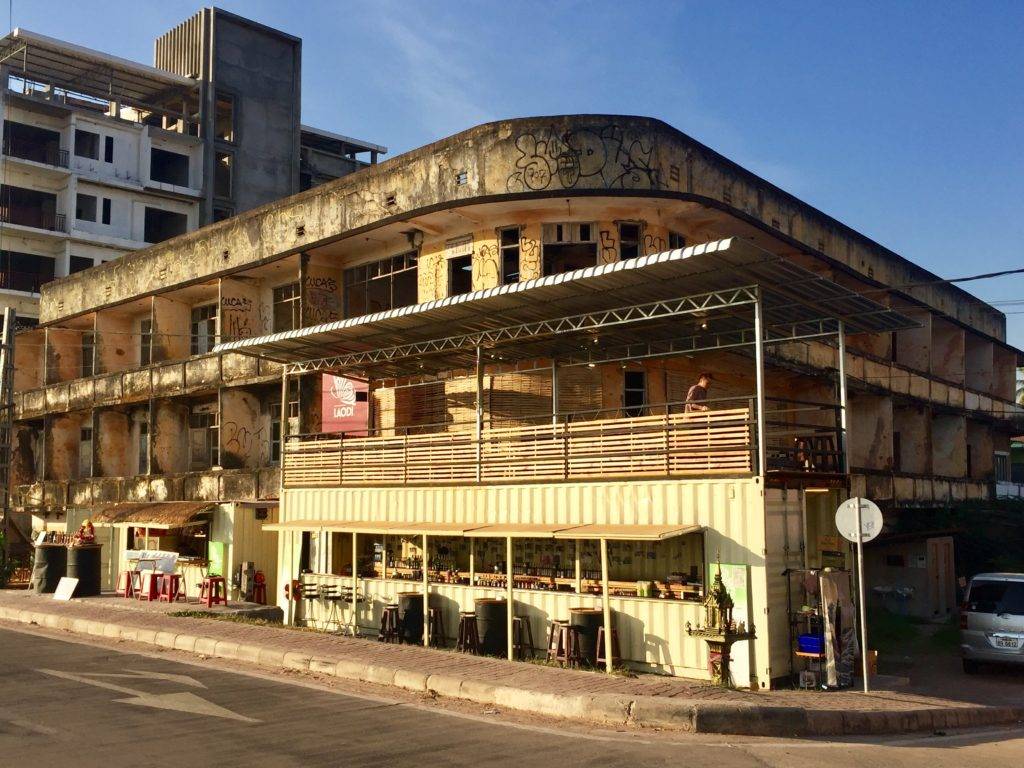
While Vientiane doesn’t have the pull of Luang Prabang or Vang Vieng, there’s definitely enough Vientiane attractions to make a visit worthwhile.
How To Get To Vientiane
Most international flights to Laos land in Vientiane, so it’s often the natural place to start or end your Laos trip.
Once you’re in Southeast Asia, it’s pretty easy to get to Vientiane. There are currently direct flights to Vientiane from Singapore, Thailand (Bangkok), Vietnam (Hanoi) and Malaysia (Kuala Lumpur).
Vientiane Accommodation
Disclaimer: My accommodation recommendations and budget guidelines are for flashpackers, not backpackers! Prices are in USD. I was pretty proud to resist the lure of the luxe in Laos, and stayed in some budget friendly cheaper options. (Well, for me at least. One of my next trips was to the Maldives after all!)
There’s a decent range of well priced hotels in Vientiane. If you stay near the centre, it’s easy to walk or bike to all the main attractions.
$ Budget (<$60): We really only needed somewhere to sleep in Vientiane, so went for a more budget hotel than usual. We stayed at Khampiane Boutique Hotel , which did the trick. Khampiane is basic but comfortable, good value for money and in a central walkable location. I also eyed up Vientiane Golden Sun Hotel and S Park Design Hotel , but preferred Khampiane for its central location.
$$ Mid-Range ($60-100): My picks for a higher end but still good value central hotel in Vientiane are the Crowne Plaza Vientiane or Salana Boutique Hotel .
$$$ Luxury ($100+): Vientiane doesn’t really have any super-luxe hotels, but if you have a bit more cash to splash, try the colonial style Settha Palace Hotel or Ansara Hotel . If you want a peaceful garden location outside the main city area, check out Green Park Boutique Hotel . The pricing for these hotels can drop to mid-range during the off season or if you get a good deal.
Best Things To Do In Vientiane
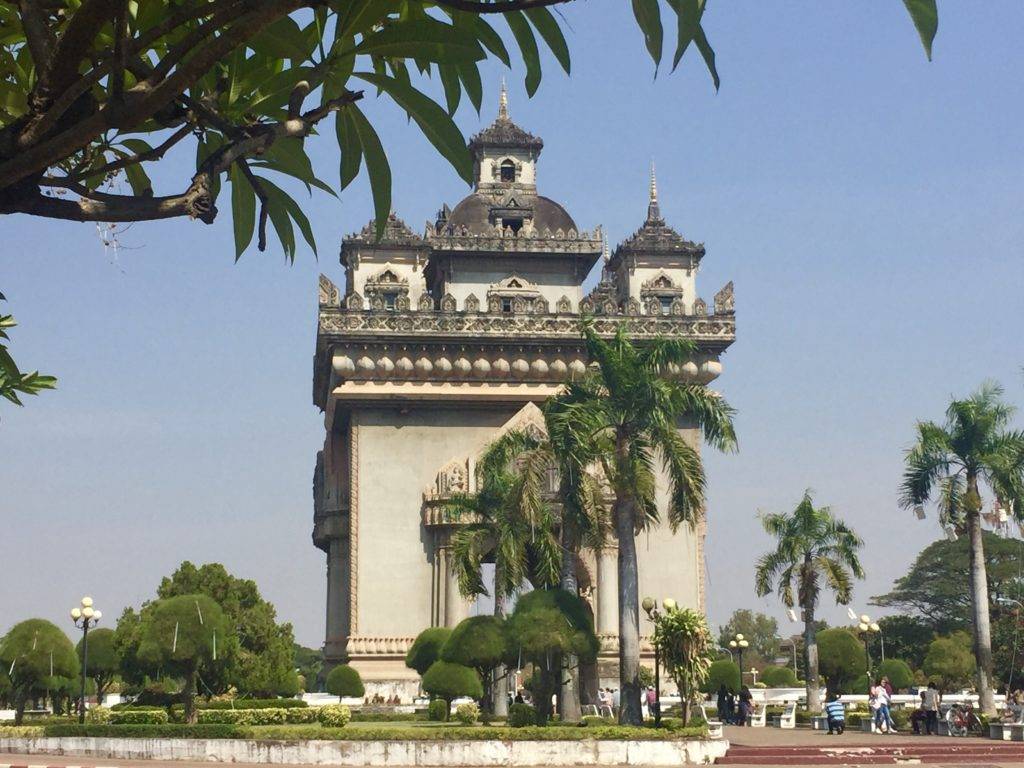
Vientiane’s a fairly compact city, and it’s fast to bike between sites. For us, two nights and one full day was plenty of time to see the sights of Vientiane and even have time to relax. The best Vientiane things to do are:
Temples: There’s Wats galore in Vientiane! You’ll find many small Wats dotted around the central city area. Take a stab at the map, or try the pretty Wat Si Muang and Wat Si Saket. Around five km northeast of the city, you’ll find the Great Sacred Stupa (Pha That Lunag), the largest temple complex in Vientiane. Impressive, but a little over the top for my liking with all that shiny shiny gold hurting the peepers. (In that why-do-people-spend-so-much-money-on-religion-when-there-is-poverty kinda way.)
COPE Visitor Centre : COPE provides prosthetic limbs to victims of the US bombings of Laos during the 1960s and 1970s. Many of the cluster bombs did not detonate and, sadly, continue to maim or kill today, having a devastating impact on the Laotian community. The COPE Visitor Centre has exhibits about the bombings, prosthetics, rehabilitation work and ongoing bomb clearance. Harrowing, somber and moving, but also the most interesting part of our time in Vientiane.
Patuxai: Patuxai (photo above) is a grand war monument in the centre of Vientiane shaped like a gate or archway. Not quite sure it lives up to the title of the ‘Arc de Triomphe’ of Laos (manage expectations accordingly!), but it is worth a quick squiz inside and out. Walk around the surrounding park, check out the ornate detailing inside and then (for a small fee) climb the seven floors of the monument to soak in expansive views of Vientiane.
Cycling: Grab a hire bike in town and you’ll be able to amble around all best things to do in Vientiane in a day or less without rushing. We biked along Rue Setthatirath, stopped at a couple of temples, visited the nearby Cope Visitor Center, then biked a few km to the slightly further afield Great Sacred Stupa, and returned back to the central area via Patuxai. All that and we were back in time for a late lunch and relaxing drink!
Eat + Drink
You won’t go hungry in Vientiane, with plenty of restaurants serving Laotian and international food, and bars filling the town and lining the river front. My fav Vientiane restaurants were:
Noy’s Fruit Heaven : The breakfast at our hotel was pretty average, so I was happy to find Noy’s Fruit Heaven just a few doors along from Khampiane Boutique Hotel. If you don’t like a heavy breakfast, grab a healthy smoothie to start your day.
Lao Kitchen : Lao Kitchen serves traditional and tasty local food for lunch and dinner, and is centrally located.
Riverfront Bars: In the evenings, we walked along the river front for a drink and meal. For a sundowner, we loved Highland Bar (which I think has since closed) or Moon the Night Restaurant . Best for those who like walking, as these are 1-2km from the main drag.
Vang Vieng – 3-4 Days
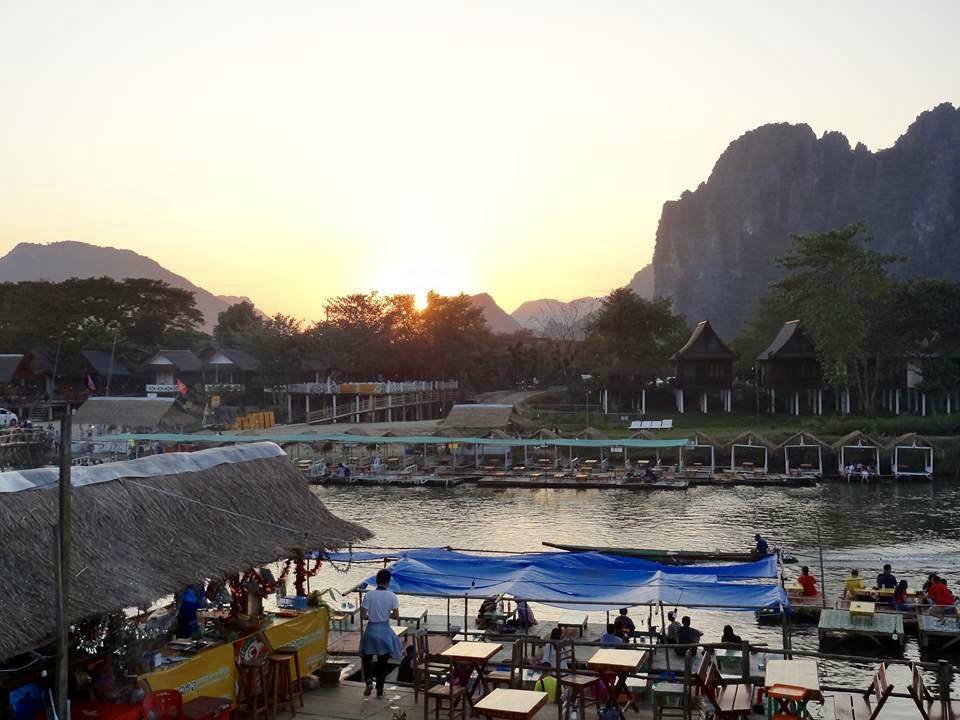
Vang Vieng is the outdoors and adventure capital of Laos. I’m not into adventure sports in the slightest, but absolutely loved the landscapes of Vang Vieng and hiking, biking, caving and swimming my way through the tranquil countryside.
While Vang Vieng has plenty of bars lining the riverside, it now has a more laidback vibe than the party culture it was once known for, after the government cleared up the raucous (and often dangerous) tubing bars.
How to Get to Vang Vieng
Sadly, there’s no airport at Vang Vieng. Vang Vieng is in between Vientiane and Luang Prabang, and is usually reached in a shared or private van from either place.
From Vientiane: The drive from Vientiane to Vang Vieng is roughly 150km and 4 hours. We took a private van organised by our hotel, which was a comfortable and easy drive, albeit a little slow in parts due to the windy roads.
From Luang Prabang: See Luang Prabang below for details of the transfer between Vang Vieng and Luang Prabang. (Warning: Not my most glamorous travel moment.)
Vang Vieng Accommodation
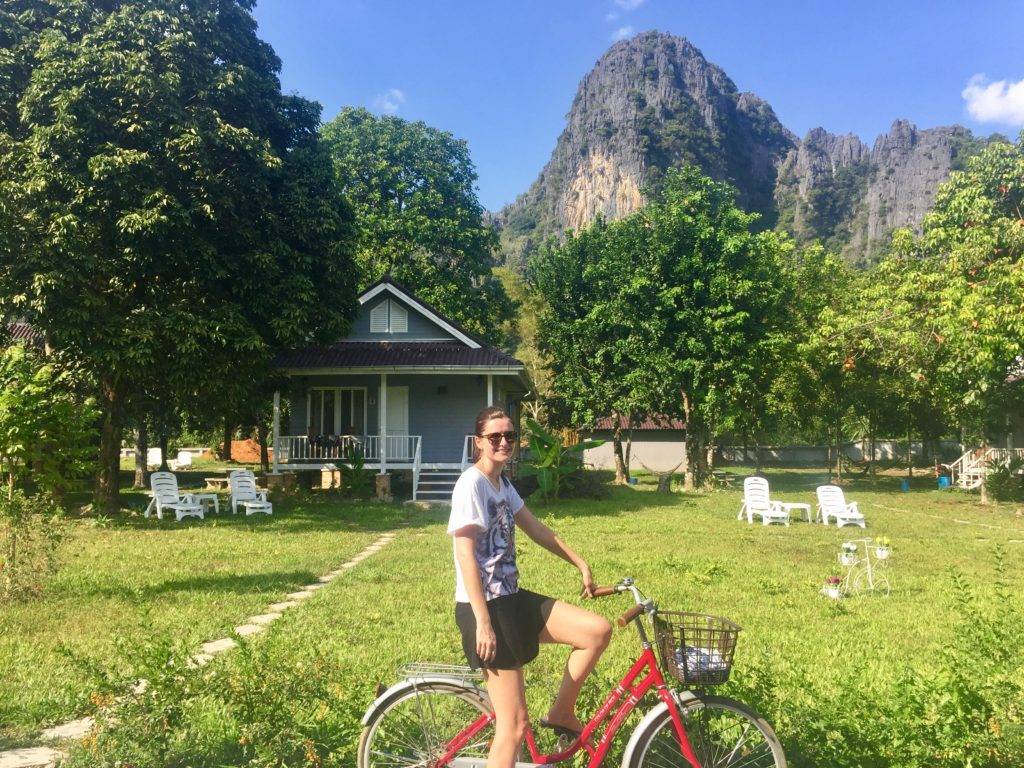
Vang Vieng has great accommodation options, from boutique hotels to homestays, and is very good value for money. I found Vang Vieng to be cheaper than Vientiane or Luang Prabang for comparable quality.
Town vs. countryside: First decide whether you want to stay in town or in the surrounding countryside. The town is set on a pretty river and is convenient for tours, food and nightlife, but can be a little busy and noisy. The countryside is quiet, pretty and one of the main draw cards of Vang Vieng, but has limited food options and requires a short bike, walk or ride to town. We opted for the countryside a couple of km from town, as the region’s natural beauty was our main reason for visiting Vang Vieng.
$ Budget (>$25): My Vang Vieng budget accommodation picks would have been Vang Vieng Boutique Hotel or Laos Haven Hotel , which were both well reviewed and really good value. Alternatively, Maylyn Guest House is an absolute bargain, with rooms from as little as $12.
$$ Mid-Range ($25-60): My heart was set on Bearlin Bungalows from the moment I saw photos of the cute cottages and dramatic mountain backdrop (see photo above). We absolutely loved our stay at Bearlin Bungalows, and thought it was really good value. Bearlin Bungalows is a couple of km outside central Vang Vieng in a quite countryside location, and is only a short bike ride to some of the best caves and swimming holes. There’s a small restaurant on site, and bikes (albeit slow ones!) for getting around. My second pick for a mid-range Vang Vieng hotel would be Green View Resort .
$$$ Luxury ($60+): If Bearlin Bungalows hadn’t been so gosh darn cute, I would have booked Riverside Boutique Resort . Riverside Boutique is a higher end resort, with a central location and excellent restaurant. Alternatively, check out Amari Vang Vieng . Luxury hotels in Vang Vieng come a bit cheaper than elsewhere, but also adjust your standards accordingly!
Best Things To Do In Vang Vieng
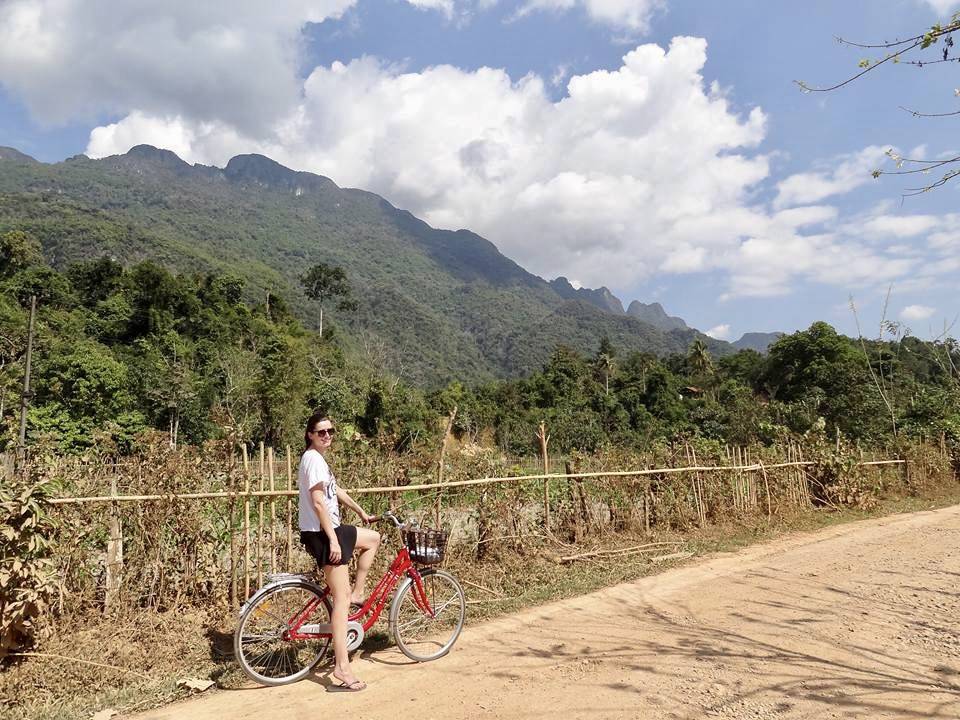
Vang Vieng is all about the great outdoors! There’s no need to plan much in advance, as it’s easy to suss out the lay of the land and get around once you’re there. Here’s all the best things to do in Vang Vieng:
Biking: We grabbed a bike from our accommodation and spent a couple of days cycling around the countryside without much of a plan, stopping in at caves, lagoons and hikes that are well sign posted along the way. We started from Bearlin Bungalows, headed further west away from the main town, and took a couple of the side roads and loop tracks, getting suitably lost once or twice along the way. You’ll find many of the best Vang Vieng things to do along this stretch, including caves, lagoons and hikes. The biking was a little hard going, as the roads were bumpy and our bikes we’re pretty paru (for the non-Kiwis, that’s Maori slang for bit shit). Half the fun though huh?! (She says, with the benefit of hindsight.)
Caves: There’s caves galore around Vang Vieng, of varying styles and difficulties. Some are way impressive, some are less impressive, and some are downright scary (take a torch!). We stuck to caves that we could bike to and explore alone, including popular Tham Phu Kham Cave (home to the Blue Lagoon) and some smaller random caves that we passed along the way on our bikes. One popular cave that we didn’t visit is Tham Nam (Water Cave) around 15km north of Vang Vieng, where you can tube through the cave.
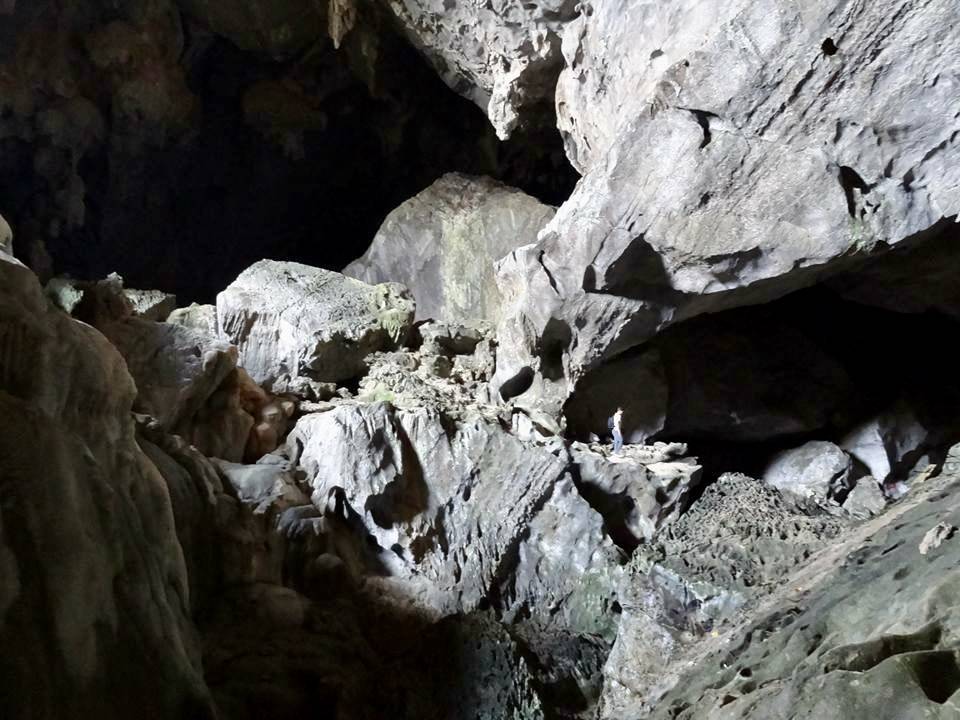
Small small person in large large cave
Blue Lagoon Vang Vieng: On the road west from town, the best Vang Vieng lagoons to visit are Blue Lagoon and Blue Lagoon 3. Blue Lagoon is closer to town and also has a cave (Tham Phu Kham Cave), but Blue Lagoon 3 is much more tranquil with fewer crowds.
View Point Hikes: There’s a few good short hikes to view points around Vang Vieng. Head west out of town past Bearlin Bungalows, and you’ll find Pha Ngern View Point (around 2km past Bearlin Bungalows) and Nam Xay View Point (around 5km past Bearlin Bungalows). Bring plenty of water and wear proper walking shoes, as both hikes are short and steep with rocky trails. The Pha Ngern Hike takes roughly 40-50 minutes, and the Nam Xay Hike takes around 20-30 minutes. Both hikes have sweeping views over the Vang Vieng countryside.
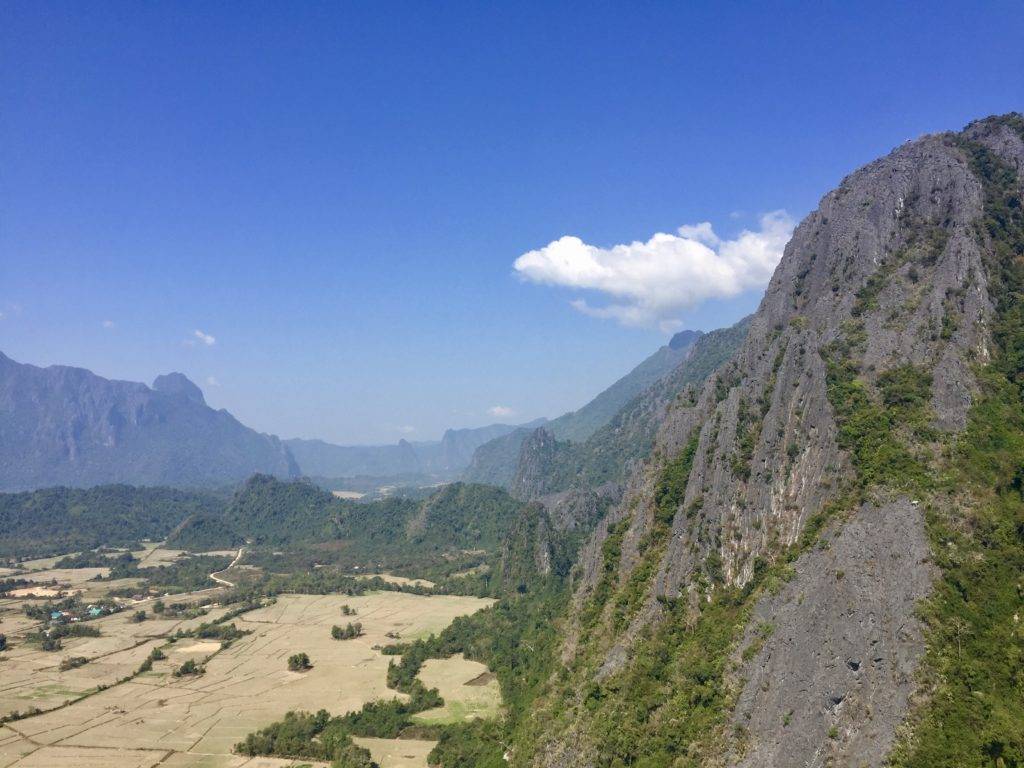
Vang Vieng Tubing: Despite the government crackdown on Vang Vieng river tubing and riverside bars, you can still hire a rubber tube and float your way down the river. I enjoyed river tubing in Vang Vieng much more than I thought I would, probably for the very fact that it’s no longer a massive party of 20-something backpackers risking life and limb by mixing booze, strong currents and flying foxes. There’s still a couple of bars in the first half hour of the tubing, so stock up there (or BYO) if you want to drink your way down the river. It takes a couple of hour to float down the river back to town, give or take depending on water levels and currents. Take a dry bag for your belongings and a rash shirt if you get chilly.
Vang Vieng Kayaking: If tubing’s not your thing, you can also kayak down the river. When we went tubing, there were tonnes of tourists out kayaking who had possibly never been in a kayak in their lives … with ensuing chaos and collisions on the water!
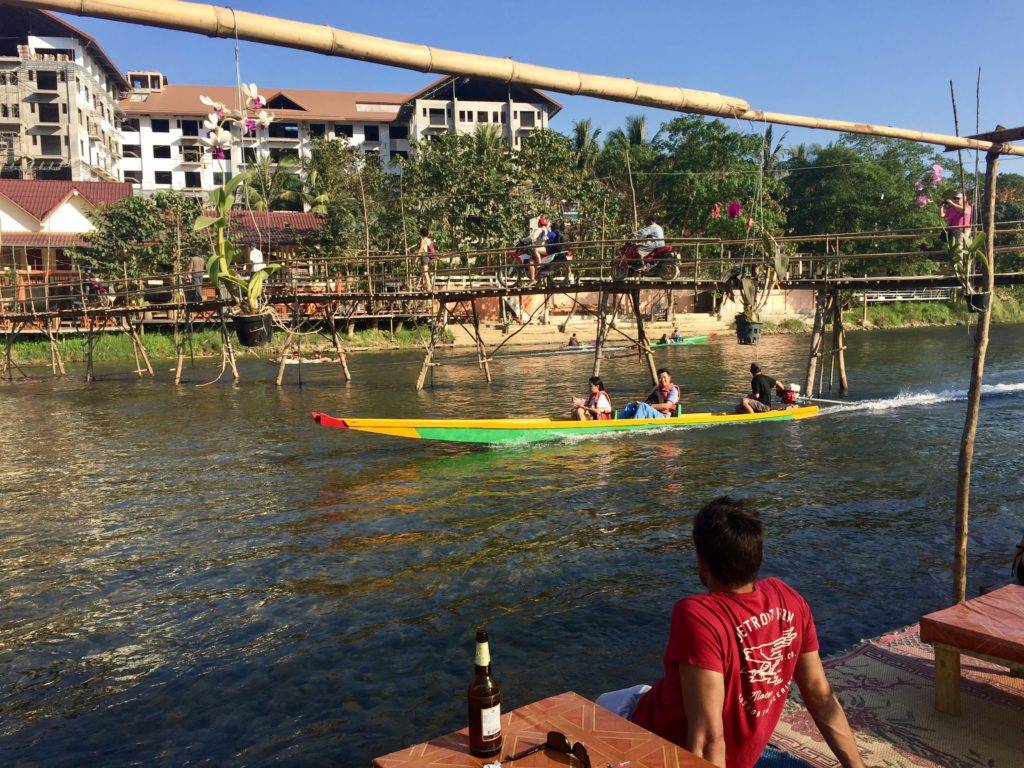
Most of the restaurants in Vang Vieng congregate around the main town area and the riverfront. There’s also some great little local joints dotted around the countryside. We didn’t find any spectacular food, but there were plenty of good restaurants and bars that were perfect for a cold Beerlao and some basic rice, veges and fish.
River Front Bars: I’m a sucker for a scenic view and cold bevvie, so we had many a drink along the riverside restaurants. Try Vanpersay Restaurant or The Elephant Crossing Restaurant & Bar along the river front. While the food’s nothing to write home about, these spots have great views and are perfect for nursing a cold Beerlao while the sun goes down.
The other side of the river (west) is also dotted with local bars where you can relax in little wooden booths with cushions on the river edge. Great for an afternoon of drinking, reading and chilling, but eat at your own risk: quite possibility the spiciest food I have ever eaten!
Countryside Local Eats: In the countryside to the west of the river, there’s a few small local restaurants serving basic but tasty food and cold drinks. Bearlin Bungalows and Lao Valhalla both have good offerings.
Luang Prabang – 4-5 Days
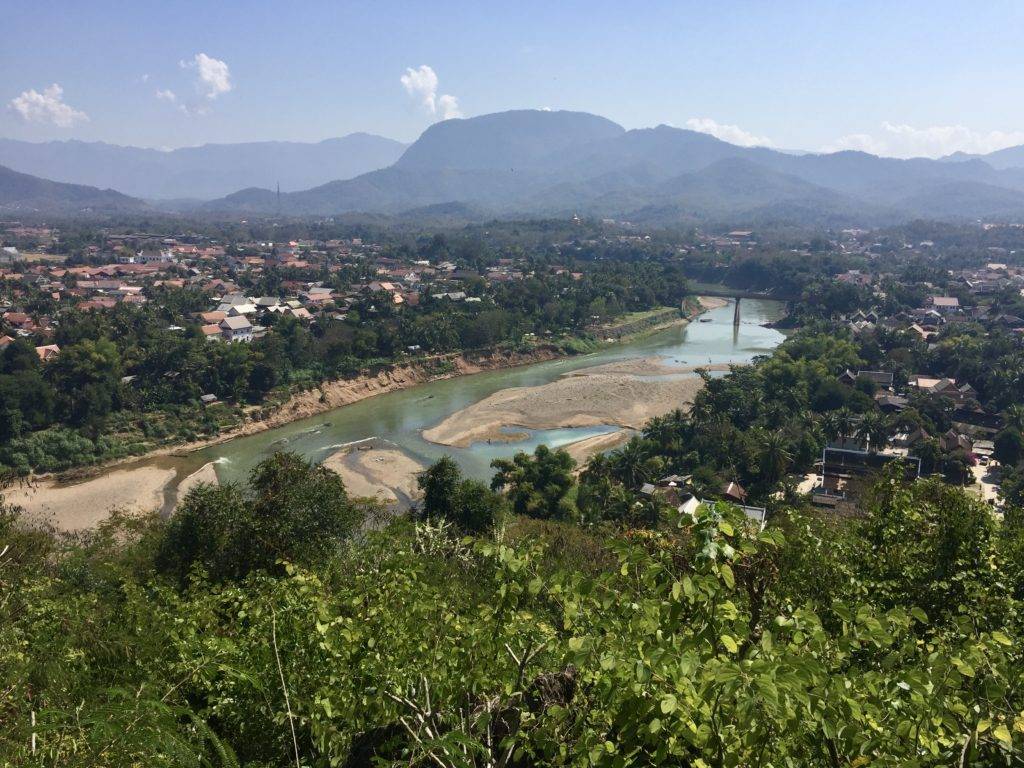
Views of Luang Prabang from Mount Phousi
Luang Prabang is the culture capital of Laos, with a picturesque French colonial old town, intricate temples, foodie culture and beautiful surrounding jungle.
How To Get To Luang Prabang
Luang Prabang has an airport with flights to and from international destinations including Singapore and Bangkok and domestic destinations including Vientiane.
If you’re arriving in Luang Prabang from Vang Vieng, it’s unfortunately a rather long and windy (albeit pretty) overland trip. While the road is only 185km, the drive takes anywhere between 5-8 hours, depending on your transportation. After forking out for a private van transfer from Vientiane to Vang Vieng, we decided to save some pennies on the next leg with a group van transfer. How different could it be?!
For my savings, I was expecting maybe a slightly older model van and seating at full capacity. Ahhm, I was just a little bit wrong. Names can be deceiving, and our ‘luxury’ VIP mini van was a euphamism if I ever did hear one. Expect a puttery old clanger, regular stops at random locales to pick up even more guests, a VERY tight squeeze, and questionable driving ability.
Check out our ride below. Yup, just when you thought the van was full, those are pull down chairs in the aisle! (Reminder to self: private transfers are usually worth the money.) The not-so-glam side of travelling. On the plus side, the scenery was pretty spectacular, and it’s an experience we’ll relive for many years to come.
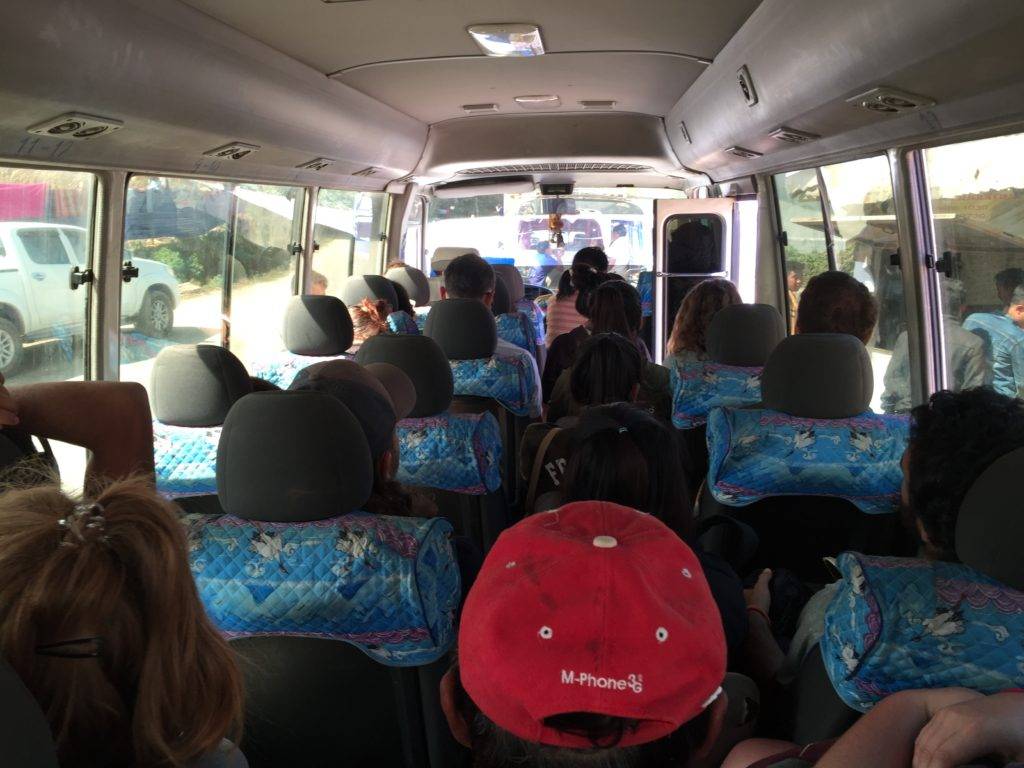
Luxury mini-van: you are duly warned
Tips: Get on the van at the first pick up spot in central Vang Vieng to get a reasonable seat and, if you’re lucky, a seatbelt. Take water and snacks for survival. Think character building thoughts.
Luang Prabang Accommodation
Luang Prabang has the biggest range of accommmodation in Laos, with plenty of choices in the Old Quarter, along the river, and on the outskirts of the city. Expect to pay more in Luang Prabang than elsewhere in Laos.
I chose Le Bel Air Boutique Resort , just across the river from the Old Town. While our hotel was lovely and tranquil, next time I’d stay in the vibrant Old Quarter as I loved it SO much and we spent most of our time there. Plus my absolute favourite style of accommodation is colonial boutique, and Luang Prabang has that in droves! My choices of hotels in Luang Prabang for next time are:
$ Budget (<$60): There’s fewer really good cheap options in Luang Prabang. My top budget(ish) choices in Luang Prabang are Villa Ban Lakkham , Phone Praseuth Guesthouse or Saynamkhan River View .
$$ Mid-Range ($60-$150): There’s some pretty good midrange options in Luang Prabang. In the Old Quarter, I’d go for Lotus Villa Boutique Hotel or The Aspara . Just across the river, check out My Dream Boutique Resort .
$$$ Luxury ($150+): Luang Prabang is the one place in Laos that has true luxury hotels. As you might expect, luxury here costs a lot more (and is of higher standard) than luxury in Vientiane or Vang Vieng. I’m a sucker for luxe boutique hotels, and am little disappointed that I didn’t splash out in Luang Prabang. (Oh well, all the more reason to return!) In the Old Quarter, I was eyeing up The Belle Rive Boutique Hotel or Hotel 3 Nagas . They look so gorgeous! For peaceful luxury just outside the old town, check out The Luang Say Residence or Satri House .
Best Things To Do In Luang Prabang
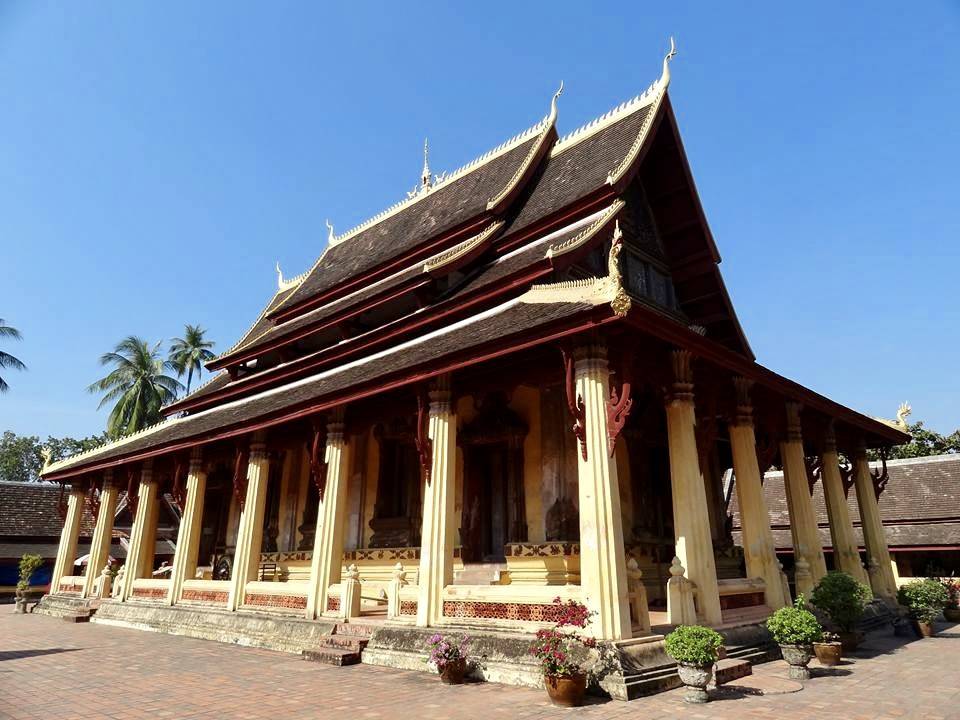
Good news! There’s stacks of fun things to do in Luang Prabang to keep you busy for pretty much as long as you want to stay for. The best Luang Prabang attractions are:
O ld Quarter: Luang Prabang’s Old Quarter is the absolute star of the show. We spent most of our days meandering somewhat aimlessly around the historic Old Quarter, a delightful French colonial old town and UNESCO World Heritage Site to boot. It’s filled with colorful buildings, temples and great roadside bars to watch the world go by.
Temples: You don’t have to look far to find ornate Buddhist temples, known as wats, in Luang Prabang. We were a bit templed out from the rest of our travels in South East Asia , so stuck to admiring the wats from the outside. If you’re keen on exploring a few wats, don’t miss the best temples in Luang Prabang .
Mount Phousi: In the Old Quarter, take a short walk up Mount Phousi hill for epic views over the Old Quarter, Mekong River and surrounding mountains. The walk is steep but short, and is doable for anyone with a reasonable level of fitness and no mobility issues (due to the number of stairs). The most popular time to visit Mount Phousi is sunrise or sunset.
Kuang Si Falls: Kuang Si Waterfalls is probably second to the Old Quarter as the most popular tourist attraction in Luang Prabang. Don’t let its popularity put you off, as the cascading waterfalls are truly beautiful, and it’s not as busy as comparable sites in other countries. Kuang Si is also home to a Bear Rescue Centre, with black asiatic bears rescued from pretty awful circumstances.
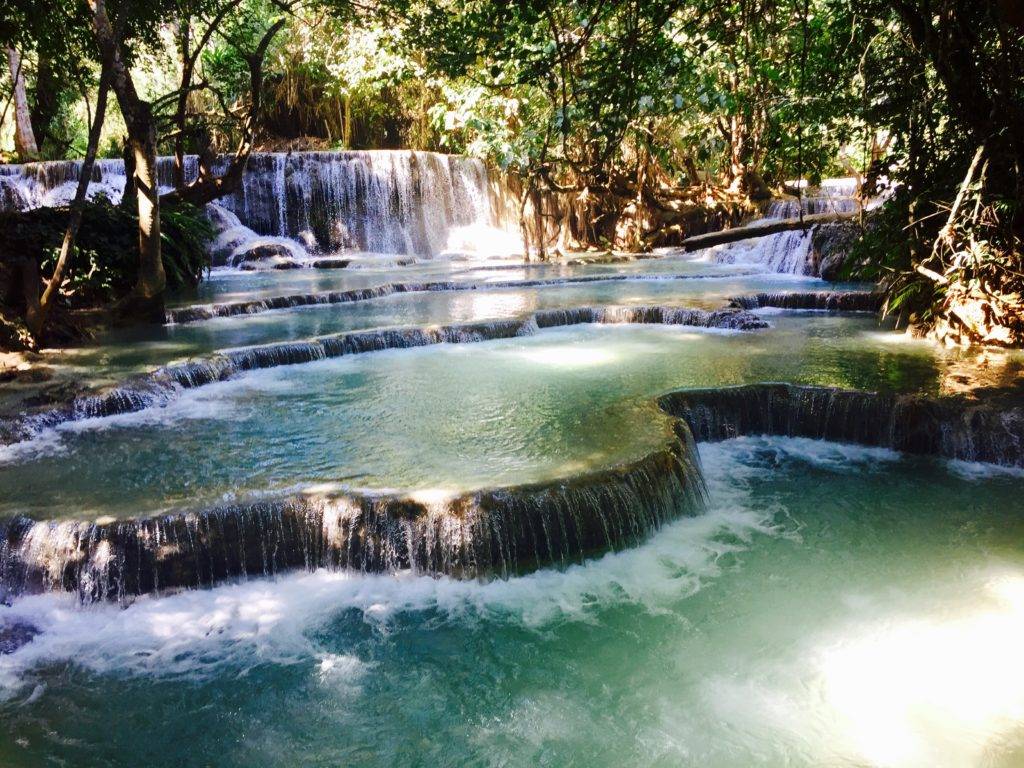
Kuang Si Falls is around 30km south-west of Luang Prabang, so most (sensible) people take a motorbike, tuk tuk or shared van. Not us though! Nope, bouyed by my recent attempts at cycling around Vang Vieng, I decided to bike the rather challenging hilly route to Kuang Si Waterfall, and take a relaxing return boat down the river. I almost didn’t make it and had to push my bike the last kilometre. While I was hating on life at the time, it was pretty satisfying to reach the falls and take a refreshing dip. If you’re a little crazy up for a challenge, we really enjoyed our Kuang Si bike tour with Tiger Trails .
Other Waterfalls: There’s several other waterfalls around Luang Prabang, including Tad Sae Waterfalls. I needed at least a couple of days to recover after biking to Kuang Si, so we gave Tad Sae a miss.
Bamboo Bridges: During the dry season (around November to May), take the bamboo bridge to cross the Nam Khan River. The bridge is an attraction in itself, but you can also reward yourself with a cold bevvie at Dyen Sabi on the other side of the bridge (see Eat + Drink below). The bridge is rebuilt each year after being washed away during the wet season.
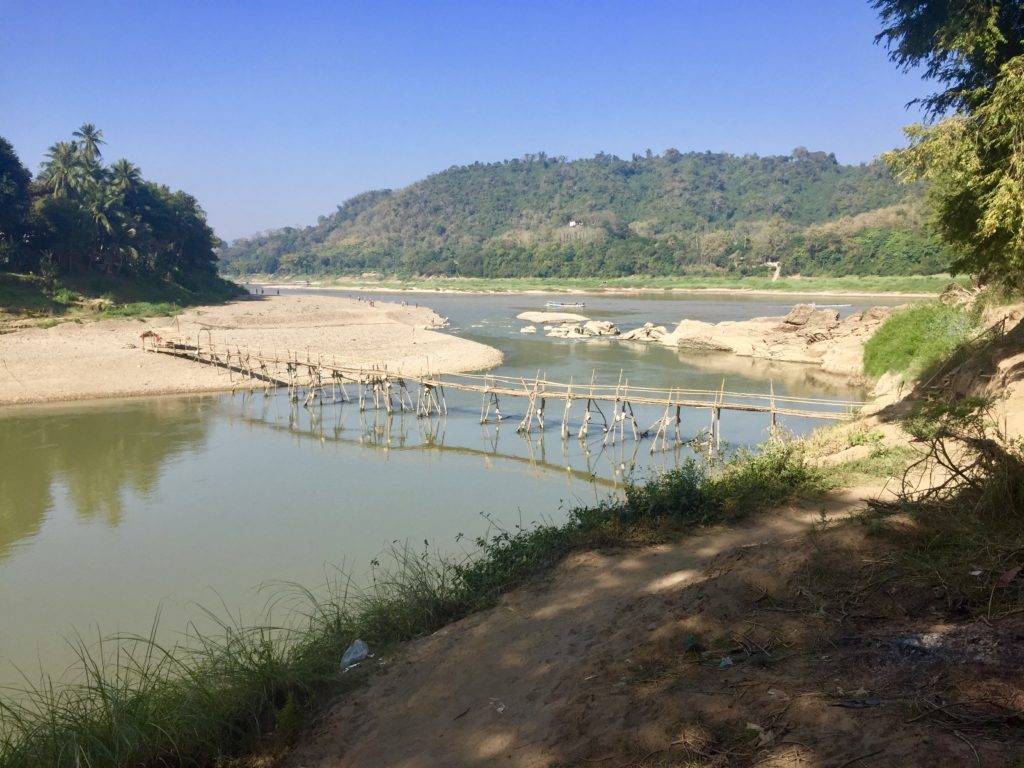
River Cruise: We took a super chilled river cruise back from Kuang Si Falls to Luang Prabang (note: needs to be organised in advance). Alternatively, pop down to the river front in the Old Quarter and take a sunset cruise or a boat ride to Pak Ou Caves.
Pak Ou Caves: Pak Ou Caves are two caves with mini Buddha figures, around 25km or two hours by boat from Luang Prabang.
Biking: Like most of Laos, Luang Prabang is a great spot for exploring on your wheels. As well as the Old Quarter, we loved cycling around the residential area on the outskirts of the old town and the east side of Nam Khan River.
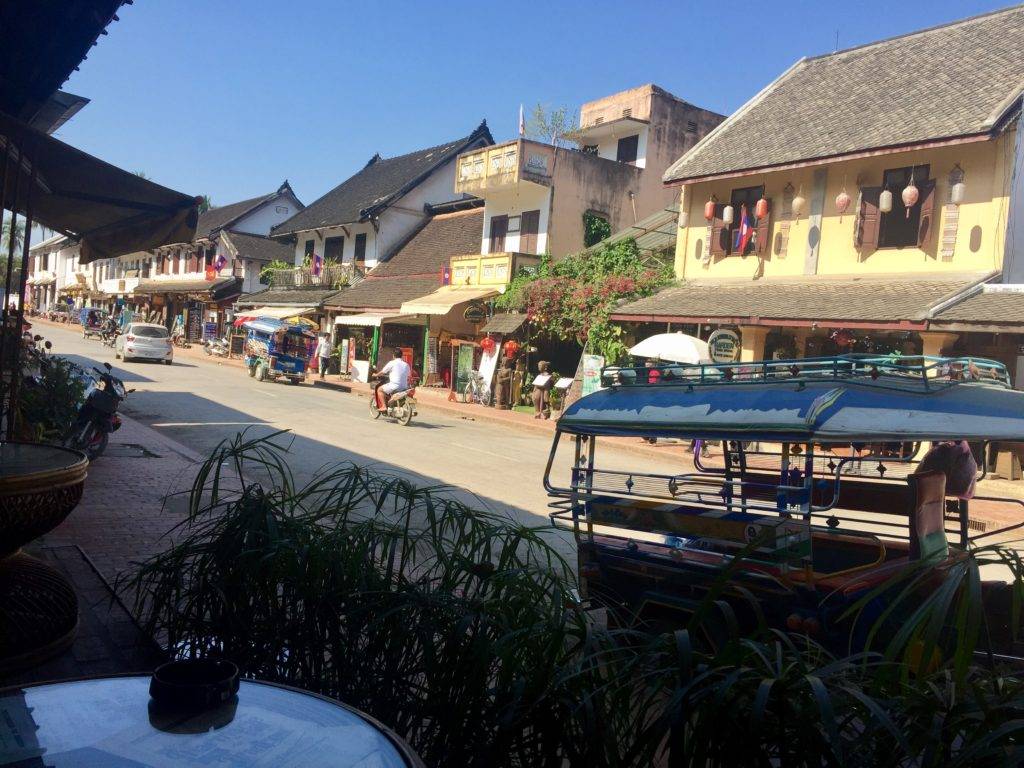
Luang Prabang has hands down the best food we had in Laos, and is the only place we really ate out for the experience. You’ll be happy regardless of your tastes, as Luang Prabang has street food, cafes, bars and restaurants, with a mix of Laotian, French and international food.
There’s scores of well reviewed Luang Prabang restaurants on TripAdvisor , or do as we did and wander into whatever takes your fancy. My favs were:
Tamarind : I highly recommend Tamarind if you want to splash out one night on a delicious Laotian degustation dinner. Booking recommended.
Tangor : Tangor is a French bar and restaurant along the main street of Luang Prabang’s Old Quarter. Tangor quickly became our local, and we had a drink (or three) here every day. Great spot for people watching!
Dyen Sabai : I loved Dyen Sabi for a chilled drink and meal with lovely views over the river. You can reach Dyen Sabai by walking acrosss the bamboo bridge.
Other Places to Visit in Laos
Sadly, we only had ten days in Laos so didn’t have time to visit everywhere on my list. For a longer trip, check out the following locations. Houayxai and Phonsovan are in northern Laos so combine well with my itinerary above. Pakse and 4000 islands are the ‘can’t miss’ locations of southern Laos.
I reluctantly dropped Houayxai from my Laos itinerary due to time constraints. Houayxai borders northern Thailand, so is a popular starting point for travelers entering Laos from Chiang Mai or Chiang Rai.
For me, there’s two pretty good reasons to visit Houay Xai. First, you can take the two day slow boat from Houay Xai to Luang Prabang. I’m not sure if this boat would be all relaxing and romantic, or totally uncomfortable and boring. Not one to risk discomfort, I’d probably opt for the luxury Luang Say Mekong Cruise , where you overnight at the lovely looking Luang Say Lodge (for an equally lovely looking price).
Secondly, I love jungle and wildlife travel experiences, and have heard only good things about the Gibbon Experience in Laos, around 1.5 hours from Houayxai. Here, you stay in treehuts in the forest canopy and zip line around the lodge.
Phonsovan and the Plain of Jars
I also toyed with visiting Phonsovan, where the main attraction is the mysterious Plain of Jars. Yup, this is quite literally, a plain with thousands of stone jars scattered around the valley. Much like Stonehenge, the original purpose of the jars remains a puzzle.
I couldn’t quite decide whether the Plain of Jars would be a fascinating archeological site or whether it was just, well, a plain old plain of jars that I’d be done with in 15 mins. In the end, I decided to give the Plain of Jars a miss due to the long trip. It takes around 8 hours to get to Phonsovan from Vang Vieng or Luang Prabang.
Paske is a charming French colonial old town in southern Laos, and is like a min-less-touristy-more-laid-back Luang Prabang. It’s also the gateway to the Champasak Province, where the highlights include jungles, waterfalls and islands.
Si Phan Don – 4000 Islands
Another highlight of the Champasak Province is Si Phan Don, or 4000 Islands, in southern Laos near the Cambodian border. Si Phan Don is a riverine archipelago, or a collection of islands along the Mekong River. Some of the islands are barely bigger than a rock and disappear when the tide rises, while others house entire villages.
Best Time to Visit to Laos + Laos Climate
Finally, it’s always important to know the best time to visit Laos before you plan your trip!
Best Time: The cool dry season from November to February is generally the best time to visit Laos. We travelled to Laos in early February, for warm to hot days and cool(ish) nights (at least by South East Asia standards!).
Rainfall: Like many places in Asia, Laos has a dry season (October to April) and a wet season (May to September) . The rainy season is usually limited to a good old afternoon downpour rather than all day torrential rain, but can impact overland travel and infrastructure. August is usually the wettest month.
Temperatures: Laos has a tropical warm climate year round. My kinda weather! Expect temperatures to be hotter and more humid from the end of the dry season to the start of the wet season (March to June). It can also be hazy during this time as farmers burn off crops. The climate also varies throughout the country, with (sometimes surprisingly) cooler temperatures as you head north.
I’m looking forward to planning my next trip to Laos. I hope you love Laos as much as I did!
Note: This page contains affiliate links. That means that if you click a link, I may receive a small commission at no additional cost to you.
Like it? Pin it!
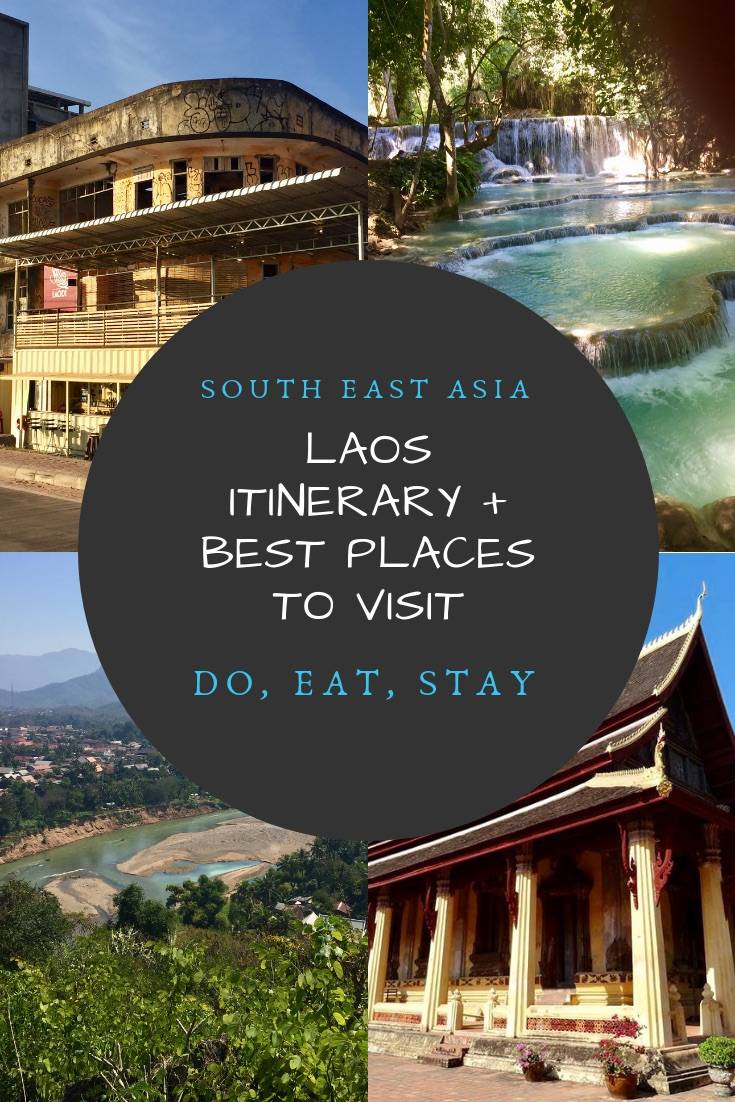
Share This Story: Use the Pin button above or share to your favorite platform below!
About the author: adventurous flashpacker.
Related Posts
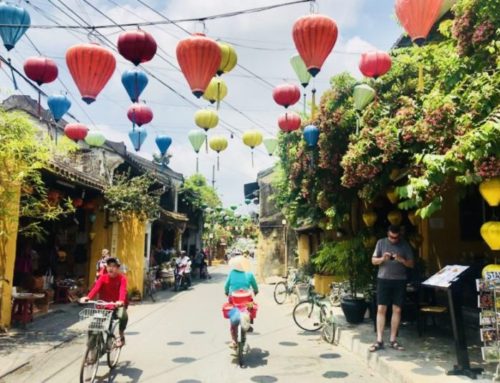
Where To Stay in Hoi An: Best Areas and Hotels
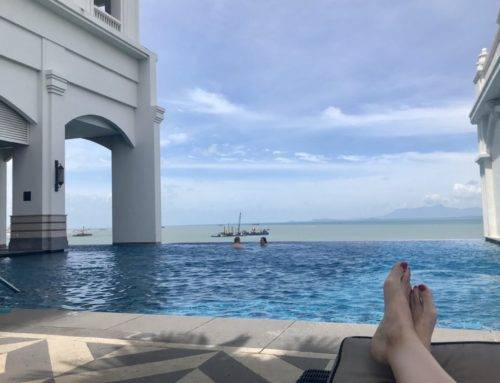
Best Short Trips from Singapore – 15 Weekend Getaways!
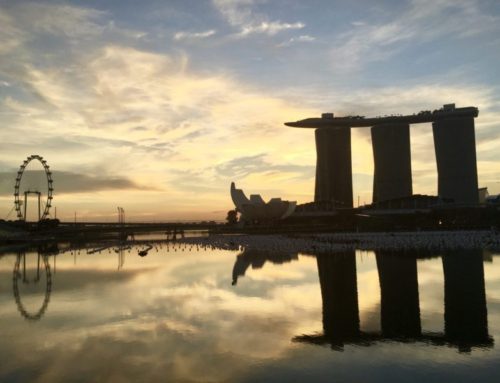
Best Singapore Staycation Ideas – 16 Hotels For a Weekend Treat
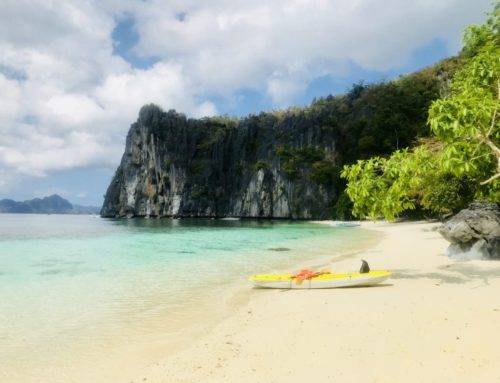
Palawan Travel Guide – Philippines’ Most Beautiful Island!
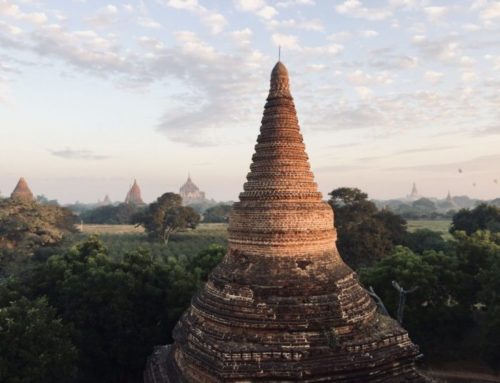
Myanmar Itinerary: Spend an Incredible 10 Days in Myanmar (Burma)
What a thorough guide! I would love to visit Laos and get a bit off the tourist track. I also had no idea that Laos was the most bombed country in the world. So sad.
Thanks Kelly! Laos is a really wonderful country with a tragic history. I’d love to return and get even more off the beaten path next time!
Thanks for sharing! This is a really good overview of the places in Laos to visit and see. Maybe one safety tip we can share is to be wary of boat scams – there are some unscrupulous tour companies or boat captains who will lie to get you to board a more expensive private boat or another variation is to leave you abandoned at a spot 10km from your destination. Of course, that’s a spot where the tuk tuk drivers are waiting at..
Otherwise, enjoy Laos! 🙂
That’s a great Laos travel tip, thanks for adding it! Luckily we didn’t fall prey to any travel scams in Laos.
What a detailed guide to travel in Laos! Laos is indeed a wonderful country but sadly it is often underrated by its famous neighbors such as Vietnam, Thailand and Malaysia. I love the charm and ancient vibe of the country, especially peaceful and homely atmosphere in Luang Prabang. I will definitely return to Laos and visit Vang Vieng. Btw, keep up with your awesome work!
Aw thanks, I totally agree! Laos is one of my fav countries in Southeast Asia and I often recommend it to people. I’m hoping to return to Luang Prabang soon. You should definitely visit Vang Vieng, such a beautiful place!
What a great guide, very thorough and interesting. Hopefully once the borders are open again people will be back to Laos and will pin this for later.
Leave A Comment Cancel reply
This site uses Akismet to reduce spam. Learn how your comment data is processed .
Laos Travel Guide: Complete 10-Day Itinerary
Travel through Laos on an unforgettable 10-day journey. Drive through bright green paddy fields, on empty jungle roads, and only stopping to gaze at the forest-covered cliffs above. Despite sharing a border with Thailand , Cambodia , and Vietnam , Laos is still under the radar as a travel destination. Luckily this gives it serenity and peace, which is the perfect accompaniment to the natural wonders of blue lagoons, epic caves, and crashing waterfalls.
Travelling in Laos: a 10-day Itinerary
Travel in Laos at a slow pace: 10 days allows for relaxation, as well as being able to fit in all the things to see and do. If you have less time and want to do the route faster, it could be easily done in 7-8 days. Here is the day-to-day itinerary to travel in Laos.
* Note that this travel route covers northern Laos.
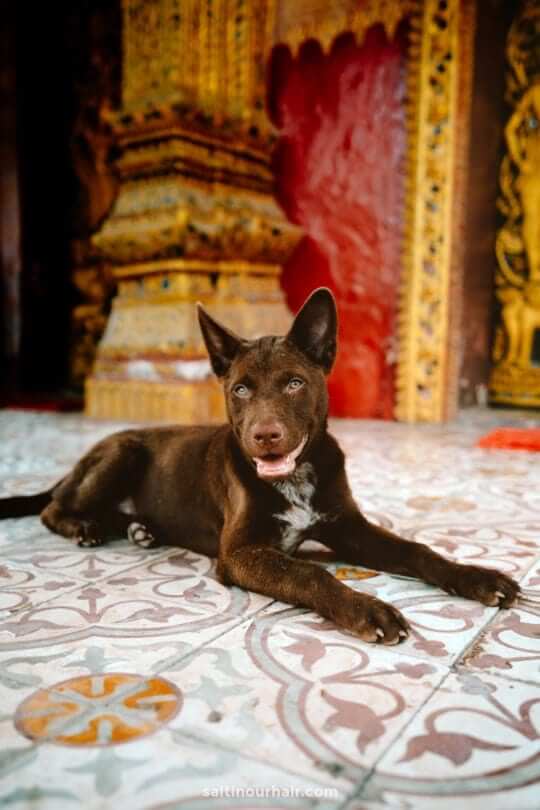
Day 1-4: Luang Prabang
Fly into the enchanting town of Luang Prabang . The town is a UNESCO World Heritage site due to its architectural significance and excellent preservation of spiritual practices and customs.
Read: Things to do in Luang Prabang
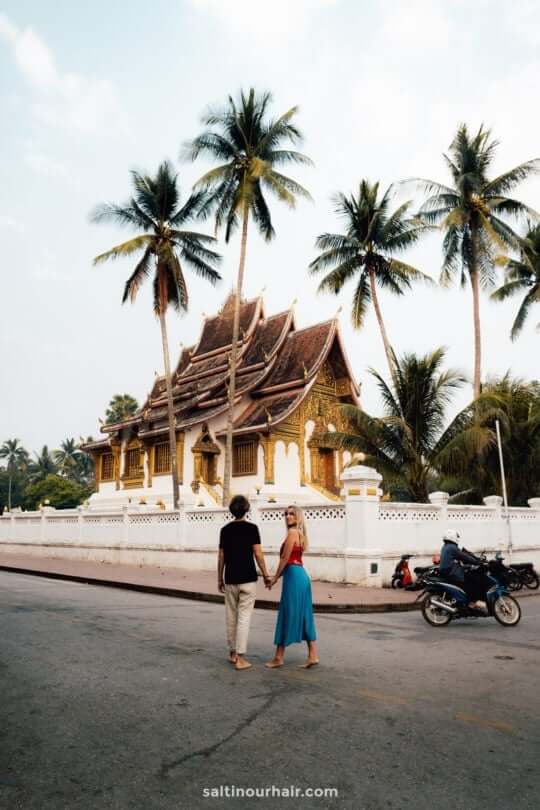
Discover all the stunning gold-detailed temples, surrounded by vibrant purple and pink flowers. The spirituality of the town is at dawn, during the alms-giving ceremony, where orange-robed monks march together through the streets, receiving flowers and food from the town residents.
Hotels in Luang Prabang 😴
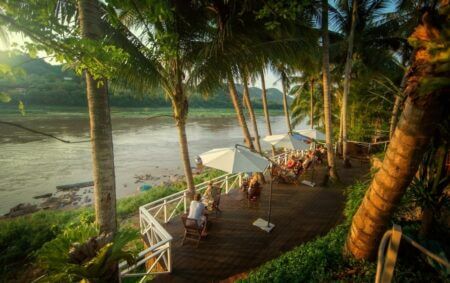
Day 5-8: Vang Vieng
Vang Vieng is a town for adventure lovers. Limestone karsts, providing awesome hikes and panoramic viewpoints, surround the town. Hire a motorbike and drive to one of the many turquoise lagoons and caves nearby.
Read: Vang Vieng – Things to do guide
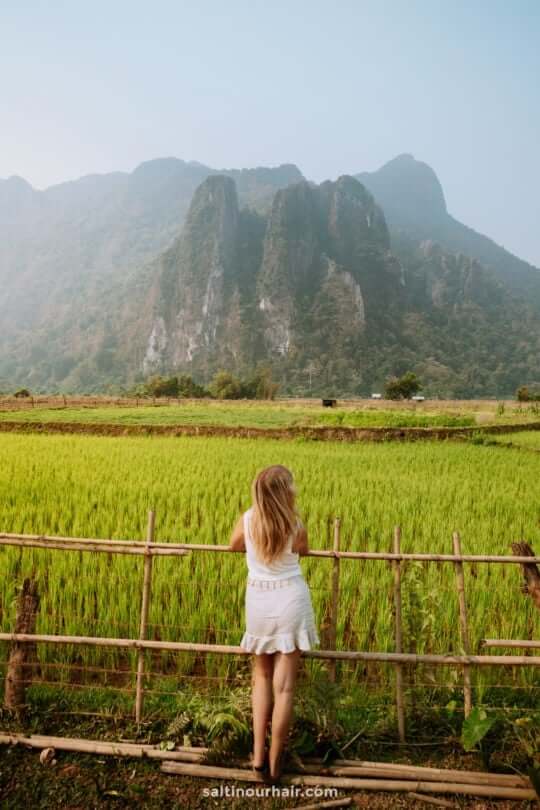
The town, nestled on the banks of the beautiful Nam Song river, provides the perfect water playground for tubing or kayaking. Fill your days with exciting activities and end them by wandering in the stunning paddy fields at sunset.
Hotels in Vang Vieng 😴
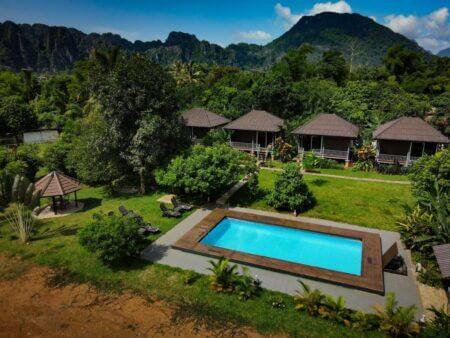
From Luang Prabang to Vang Vieng
The drive by car from Luang Prabang to Vang Vieng takes around 5 hours. Traveling in Laos is a bit difficult as the roads are not (yet) well-developed. There are plenty of shared minivans you can take from the Luang Prabang bus station, leaving either in the morning or the afternoon.
A brand-new train track has opened and now provides a faster travel alternative between destinations.
Find the train or bus timetable and tickets here
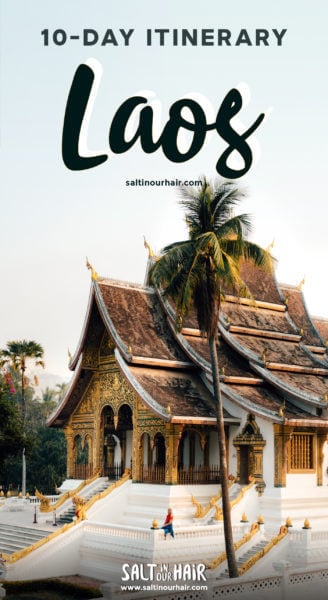
Day 9-10: Vientiane
End your Laos travels in the capital city of Vientiane! Although it has the status of a city, it feels more like a town. As a result, you will only need a day or two to see all the things to do in Vientiane. Home to the grand presidential palace and plenty of impressive temples, the city is the perfect place to get your fix of culture and history.
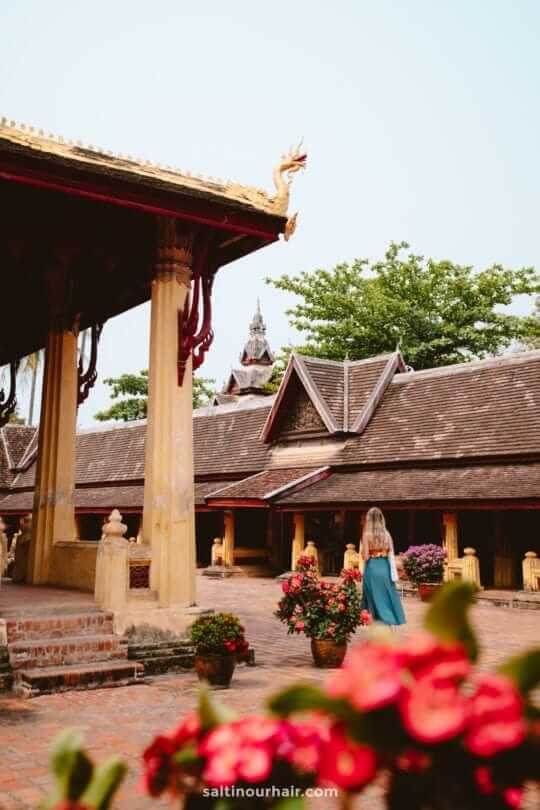
Laos during the war
During the Vietnam war, 2 million tonnes of bombs were dropped on Laos. Still to this day, some remain unexploded, and many Laotians have been hurt or killed as a result.
The COPE visitor center displays artifacts and films to explain the history, and they also work to help rehabilitate victims who have been affected. A very powerful experience and an essential visit in order to better understand the history of this resilient country.
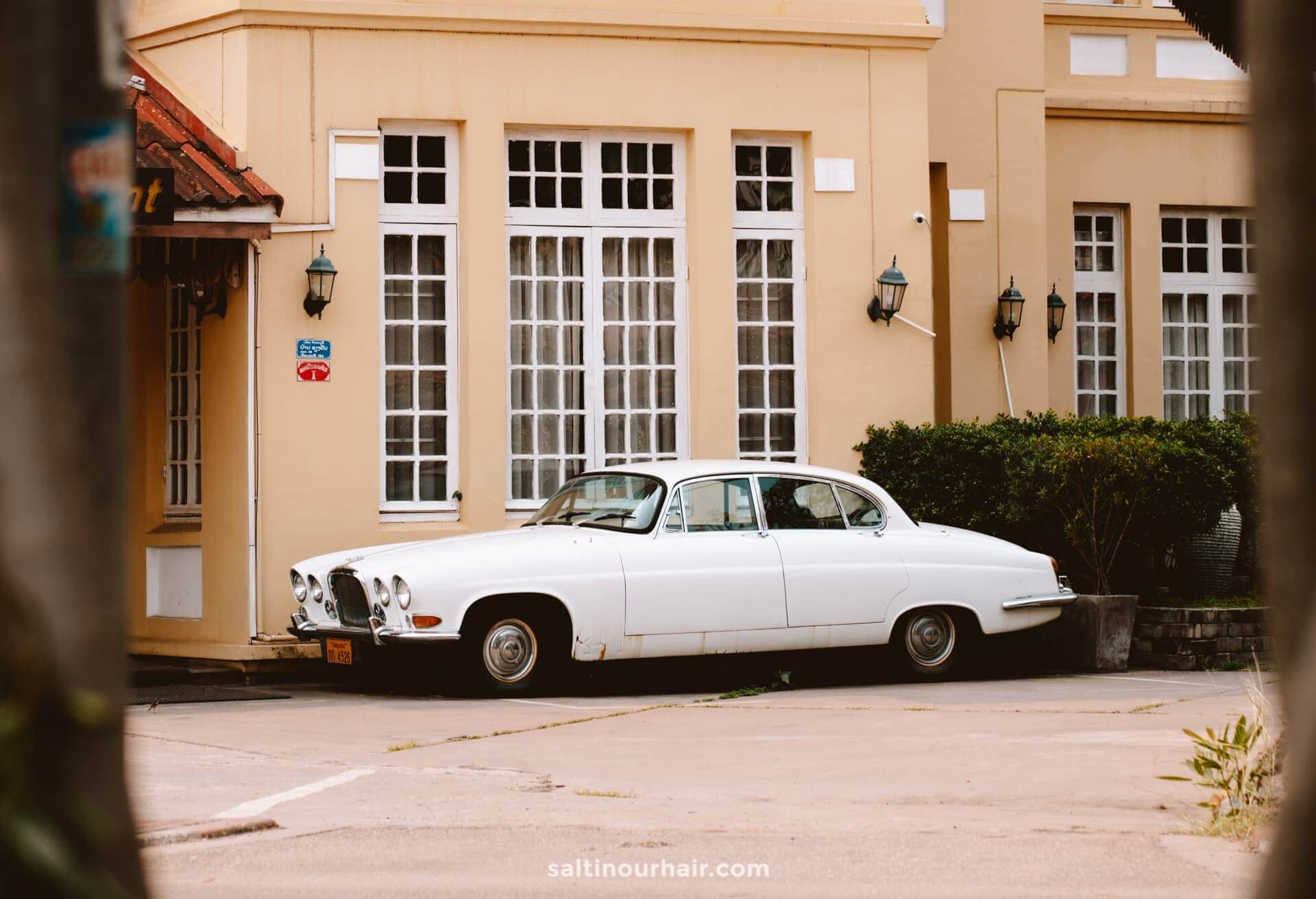
Buddha Park, Vientiane
If you have time, take the morning to travel 25km outside of the city to the incredible Buddha Park. Here you will find a park filled with over 200 giant buddha statues, all with a slightly weird and wonderful look about them. It is a 40-minute bus journey but worth it to see a more unusual attraction.
Hotels in Vientiane 😴
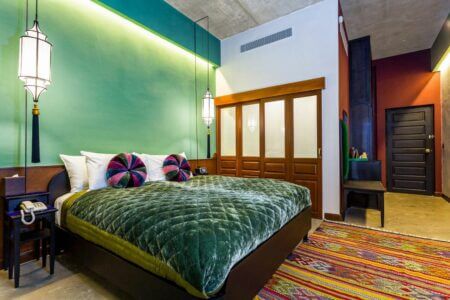
From Vang Vieng to Vientiane
The journey to Vientiane takes approximately 1-2 hours by minibus on the new highway. You can also opt for traveling by the new train; this takes around 2 hours to the city center.
Tip: There is also an international airport in Vientiane, so depending on whether your flight arrives into Vientiane or Luang Prabang, you can reverse this itinerary.

Costs of Traveling in Laos
The cost of travel in Laos is very cheap. This is mainly because all activities are centered around nature. For example hiking to cliff points, exploring caves, or swimming in lagoons or waterfalls. Entrance to caves, lagoons, and also to cross bridges are not normally more than 1-2 USD. On a budget, travelers can expect to spend about 10-20 USD a day. If you’re able to spend a bit more you can stay in more high-end accommodation for a very reasonable price.
Travel on a budget in Laos, from $180 − $270 USD weekly per person, mid-range $300 − $950 USD, and high-end from $930 − $1640 USD. However, costs depend on factors like accommodation, transportation, and activities. We did not include flights. Check flight prices here
- Hotels: $15 − $200 USD Check available hotels
- Hostels: $7 − $25 USD Check available hostels
- Transport: $5 − $10 USD Book public transport
- Food: $5 − $15 USD
- Activities: $5 − $10 USD See tickets & tours
- Sim: $1 − $3 USD Get an eSIM or SIM here
- Travel Insurance: $2 − $6 USD Get Travel Insurance
How to Get Around Laos
The infrastructure in Laos is not yet well developed. Roads are often dirt or unfinished which can make bus journeys slow, especially in the wet season when the roads can flood. Although this makes traveling in Laos more difficult, it is also what gives Laos its charm!
The new train between destinations is very convenient and fast but is also a lot more expensive if you are traveling on a budget.
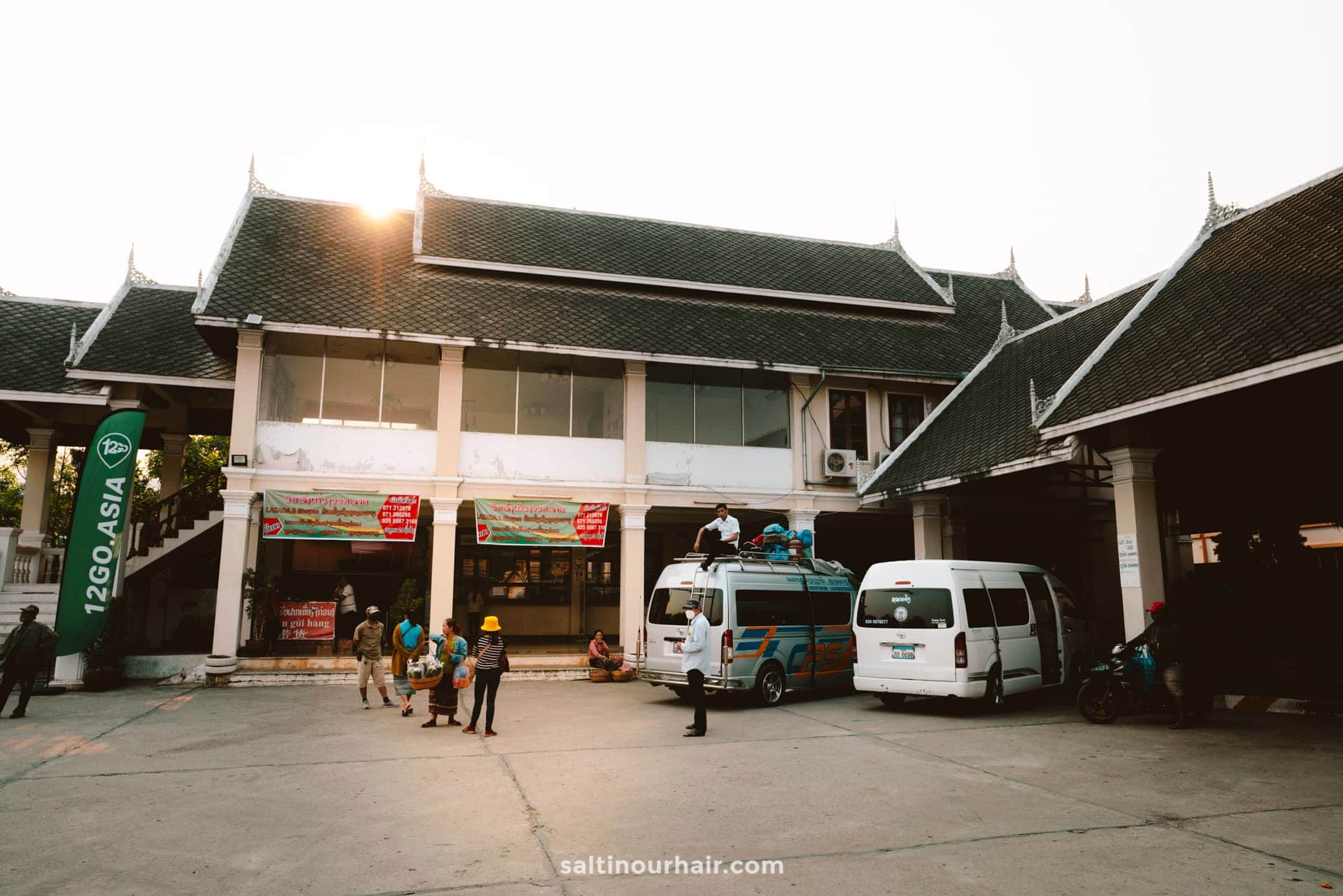
You can travel through Laos by train or bus. Once at your destination, it is very easy to get around, either on foot or by hiring a motorbike. Songthaews are also widely available- a pick-up truck-style taxi.
Tickets: Book your train or bus tickets and flight tickets here.
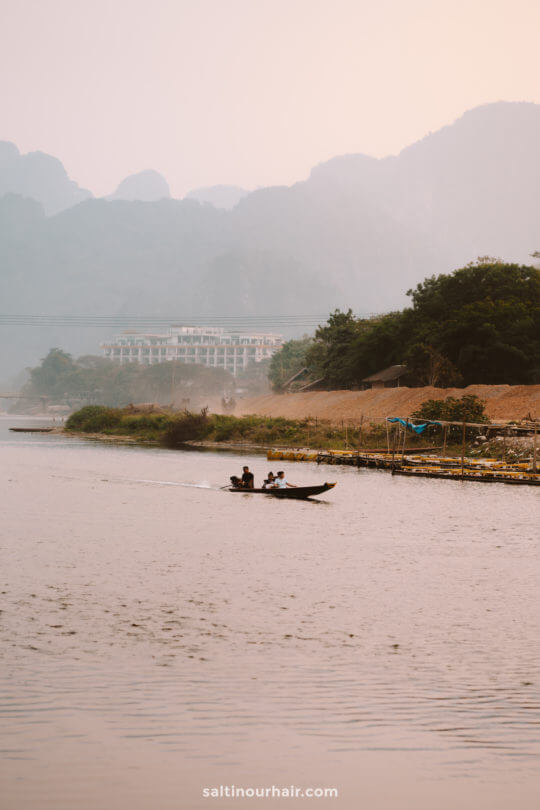
Best Time to Visit Laos
To see the lagoons at their most turquoise blue, visit in the dry months between October to March. Keep in mind that October- February is the cooler part of the dry season. After this, temperatures can be hot, and the farmers start burning season in the fields which can cause the sky to be hazy and smoky.
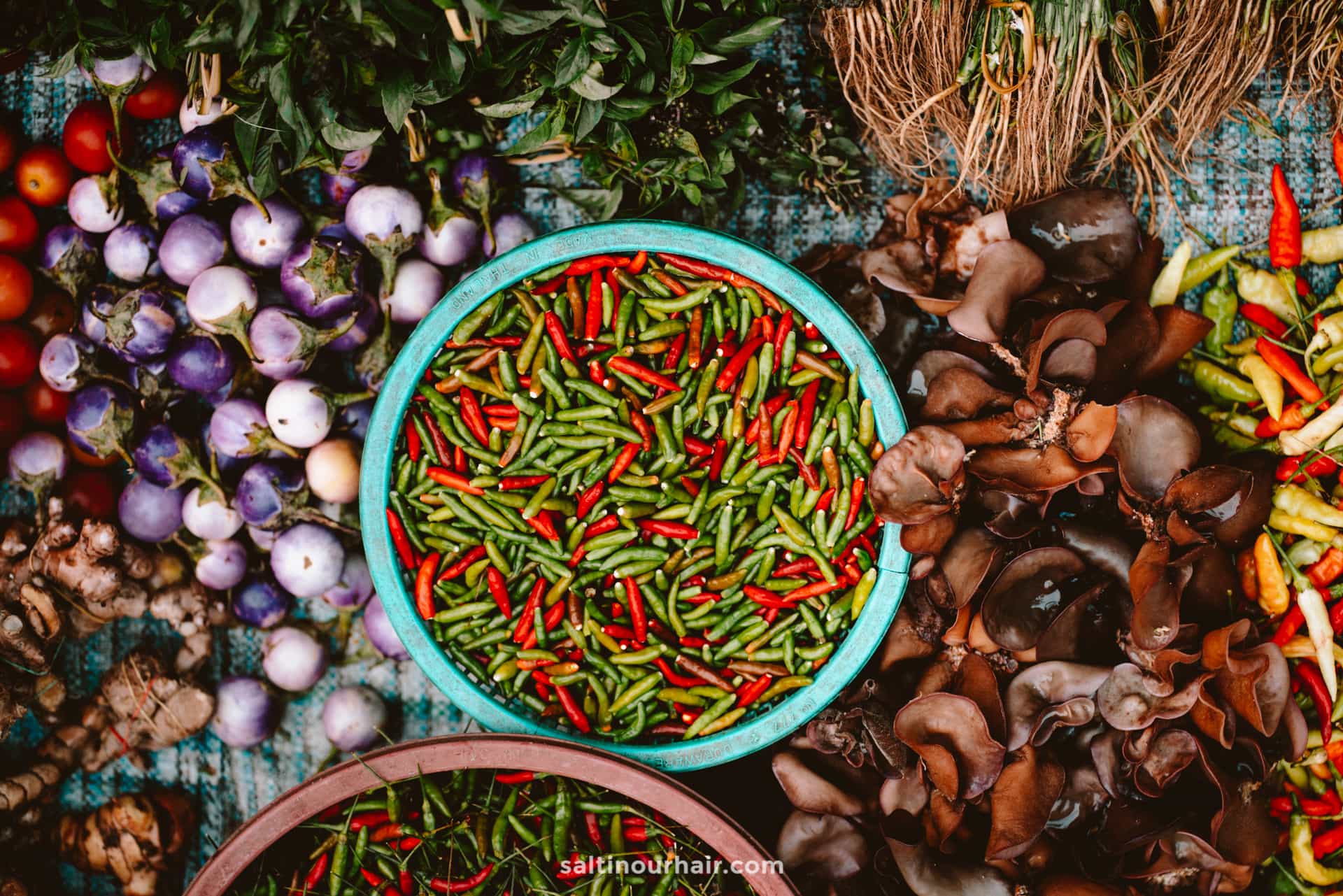
October is a beautiful month to travel to Laos. This is just after the rainy season ends, when the rice fields will still be lush and green, the waterfalls will be running and the lagoons will be starting to look bluer.
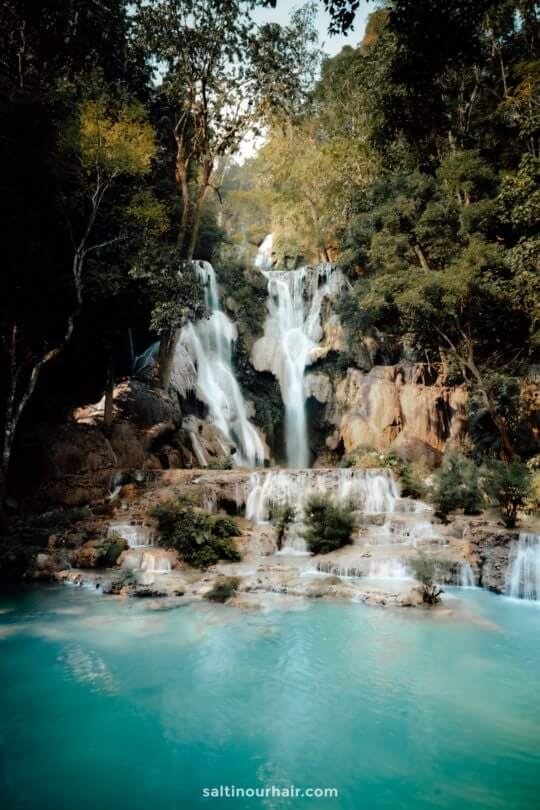
Seasons in Laos
Laos has very different seasons, which can be difficult to navigate. You should choose which time of year you visit based on what you want to see. For instance:
Dry Season : if you are hoping for cooler temperatures, it’s a good idea to visit between October to March. However, at this time, it is likely the waterfalls may be dry and rice won’t be growing. Keep in mind that in March/April farmers begin burning season, which may create smoke that can cause problems for allergy sufferers.
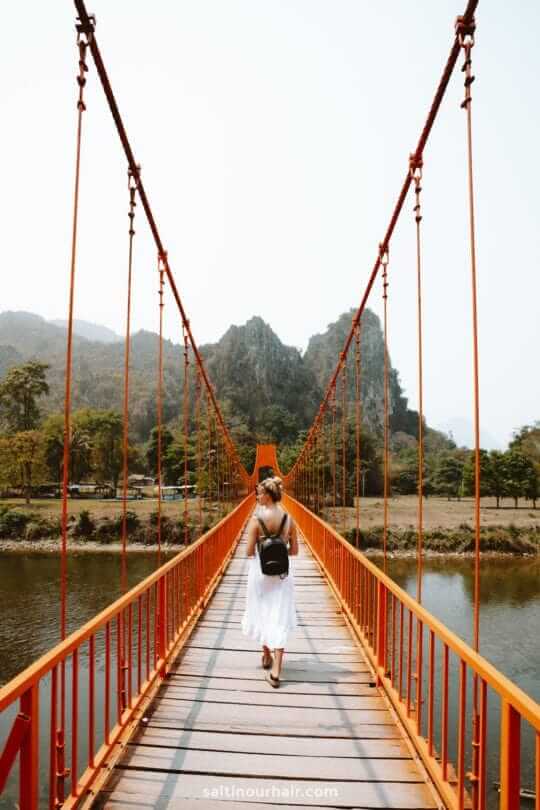
Rainy season : is from March-October and Laos sees it’s hottest temperatures in the first few months of the season. It can also be difficult to travel due to the rain and sometimes dangerous. The rice paddies will be green and luscious though, and it is the best time to see the waterfalls.
Tip: A good month to visit is October because it’s at the start of the dry season. The countryside will still be green and lush from the rainy season which has just ended.
Do I Need a Visa to Travel to Laos?
To travel to Laos, you will need to apply for an e-visa. The e-visa permits travelers to stay in Laos for 30 days and normally costs between 45 USD to 60 USD, depending on your country of residence. It is valid for single entry only to 5 different entry points in Laos and is valid for 60 days after receiving the approval letter.
Easily order your visa online here
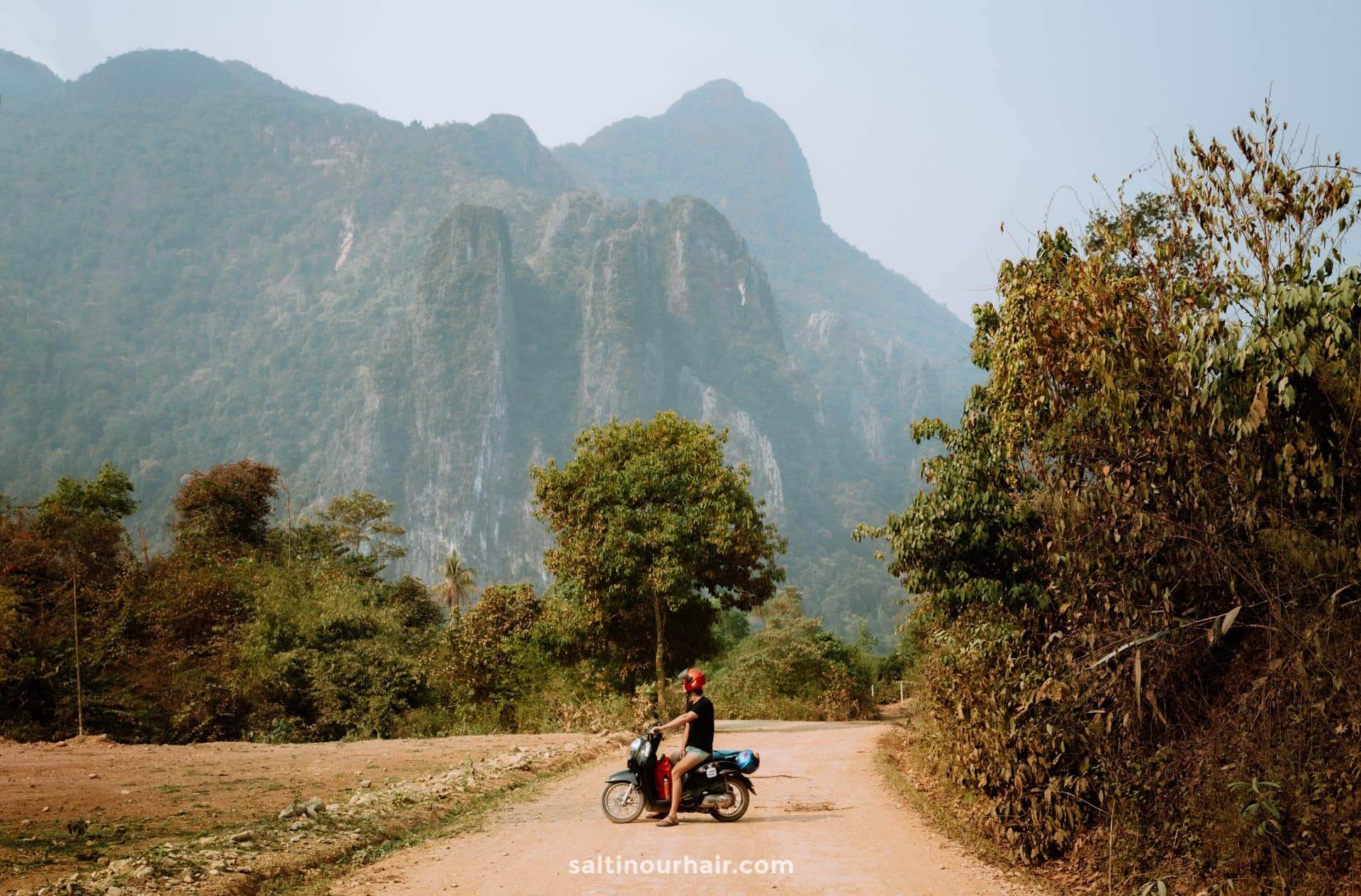
Safety in Laos
Laos is very safe to travel in, and people are exceptionally friendly. Crime is very low, although some minor theft does occur. For this reason, it is good to carry your valuables with you, especially when you’re traveling on buses, as there have been cases of tourists having things taken from their bags.
Travel Insurance Don't forget a travel insurance for your Laos trip! Heymondo covers medical emergencies, theft, delays, cancellations, lost luggage, and more, with 24/7 worldwide assistance and medical chat. As a Salt in our Hair reader, we've got you 5% off! Check Heymondo here
Due to Laos’ history, there are still unexploded bombs in the countryside. Because of this, it is absolutely essential to always stay on the path when hiking. If you are trekking, it is essential to go with a guide.
Here’s how to: find the right travel insurance
By purchasing through our links, you support us at no additional cost. Thank you for your support. ♥️
- Find Hotels via Booking.com
- Find a Rental Car via Sunny Cars
- Find Flights to Laos via Skyscanner
- Get a Travel Insurance via Heymondo
- Book Tours & Attractions via GetYourGuide
- Book a Bus/Train/Transfer via 12Go
9 Best Things To Do in Vang Vieng, Laos
11 best things to do in luang prabang.
Looking for more travel information? Plan a chat with us for personalised travel advice or get an answer from the Salt in our Hair Travel Community on Facebook.
Thank you so much for your detailed itinerary. I will probably follow it for my first visit to Laos. The inclusion of train details was really helpful as were the things to do in each place. Once again many thanks
Your email address will not be published. Required fields are marked *
Notify me when new comments are added.
5 Places to Visit in Laos + Things To Do for First-Timers

Landlocked Laos is not the easiest to get to in Southeast Asia. Most travelers arrive here on land border crossings from Thailand, Cambodia, and Vietnam.
But don’t miss it if you want to avoid crowded cities, enjoy extremely laid-back countrysides, and see pristine natural sights.
Go north if you want to visit Laos’ popular tourist spots including sacred Buddhist temples, old French-colonial heritage districts, and gorgeous riverside scenery.
Make your way down south for majestic waterfalls, spectacular caves, and thousands of river islands where you can experience life in the countryside.
Inspire trip in Laos with these must-visit places and top things to do for first-time travelers.
Follow me on Instagram
1. Luang Prabang

Luang Prabang in Northern Laos is the country’s most popular tourist attraction. This laid-back town is a UNESCO World Heritage Site known for its exquisite Buddhist temples, French colonial buildings, and riverside setting. There’s also a lot to do and see in the area like waterfalls, caves, hiking, and slow boat cruises.
How to go — The quickest way to get to Luang Prabang is by plane. Luang Prabang International Airport (LPQ) serves flights from Kuala Lumpur (3h 5m flight duration), Bangkok (1h 45m), Singapore (3h 25m), Siem Reap (2h 15m), Hanoi (1h 5m), Chiang Mai, Kunming, Haikou, and several domestic destinations including Vientiane (45m) and Pakse. Flights are served by AirAsia, Lao Airlines, Bangkok Airways, Thai AirAsia, Vietnam Airlines & SilkAir.
Most travelers arrive here by land from the North Thailand-Laos border crossing or from the capital, Vientiane. The land journey from Vientiane takes 10 to 12 hours, usually on overnight buses. Meanwhile, the slow ferry from Huay Xai, the northern border town, usually takes two days.
Where to stay Tours + discounts
Top discounts
Pak Ou Cave & Kuang Si Waterfall Day Tour from Luang Prabang
Vang Vieng – Luang Prabang Shuttle – Shared City Transfers
Luang Prabang Private Car Charter by Laos Smile
2. Muang Ngoi & Nong Khiaw

If you want to go deep into the cultural and natural landscapes, go off-the-beaten-path in Northern Laos. Nong Khiaw is one beautiful place to enjoy the riverside scenery dominated by monolith karst cliffs. Go farther down the river onboard a local slow boat to Muang Ngoi Neua and go trekking around off-the-grid farming villages.
How to go — Nong Khiaw is about a 4-hour drive north from Luang Prabang. To get to Muang Ngoi Neua, go on a scenic local ferry ride up the river. Travel time takes only 1 hour.
Where to stay

3. Bolaven Plateau & Champasak

Champasak Province in Southern Laos is the place to go if you love to see nature! The Bolaven Plateau is worth visiting for its majestic waterfalls, some of the most beautiful in Laos and maybe even Southeast Asia. Si Phan Don (Four Thousand Islands) is another popular place in Champasak but only go there for serious riverside relaxing. For a change of scenery, Vat Phu located near Pakse (the main city) is worth a peek for its ancient temple ruins.
How to go — The quickest way is to fly to Pakse, the capital and most populous city in the southern province of Champasak. Pakse International Airport serves direct flights from Ho Chi Minh, Vientiane, Luang Prabang & Savannakhet. Flights are served by Lao Airlines. Vientiane-Paske flights take around 1 hour and 15 minutes.
You can also reach Pakse on overnight buses from Vientiane. Travel time is around 10 hours. Or, from Cambodia. Not including the time spent for the border crossing, travel time is around 12 hours from Phnom Penh and 14 hours from Siem Reap.

4. Vang Vieng

Vang Vieng is infamous as a major party town, but even if you don’t go there to party, the natural scenery is worth at least a day of sightseeing. Take a bicycle and follow the village roads that pass through rice paddies surrounded by steep jungle-covered limestone karst formations.
How to go — Vang Vieng is easy to reach from Vientiane. The drive north to Vang Vieng takes around 3.5 to 5 hours.
Vientiane – Vang Vieng Shuttle – Shared City Transfers
Asia 4G LTE WIFI Hotspot (Manila Airport Pick Up)
5. Vientiane

Vientiane is probably the most laid-back capital city in Southeast Asia. This is a good thing if you want to relax while enjoying the convenience of the big city. If you have a day to spend in Vientiane, check out the Patuxai Victory Monument and Pha That Luang (National Symbol of Laos). Or, simply watch the sunset along the peaceful Mekong riverside.
How to go — Vientiane is the primary flight hub of Laos. Vientiane-Wattay International Airport (VTE) serves flights from Kuala Lumpur (2h 45m), Bangkok (1h 15m), Phnom Penh (1h 25m), Hanoi (1h), Seoul (4h 45m), and Busan. Flights are served by AirAsia, Bangkok Airways, Lao Airlines, Thai Airways & Vietnam Airlines.
You can also reach Vientiane by land from Bangkok, Thailand via the Nong Khai-Thanaleng border crossing. Travel time by train from Bangkok to Nong Khai is around 12 hours. From Thanaleng, the land journey to the center of Vientiane is another 1 hour.
Shared City Transfers between Luang Prabang and Vientiane


Places to visit in Laos
Note: Destinations featured above are not listed by rank.
Don’t Stop Here
Click below for more travel inspiration:

Don’t leave yet. There’s more!

Discover more blogs and travel tips in:
- Luang Prabang
- Muang Ngoi Neua
- Southeast Asia
Find more posts about:
- Best Travel
- Best Places
- Best Things To Do
Leave a Reply Cancel reply
Your email address will not be published. Required fields are marked *
This site uses Akismet to reduce spam. Learn how your comment data is processed .
December 29, 2018 at 9:02 pm
Hi Marcos, nice to see laid-back towns with UNESCO World Heritage sites. Awesome photos!!!

All Destinations , Asia , Laos , Overland Itineraries , Plan Your Trip , Road Trip Itineraries
Complete laos itinerary for the whole country.
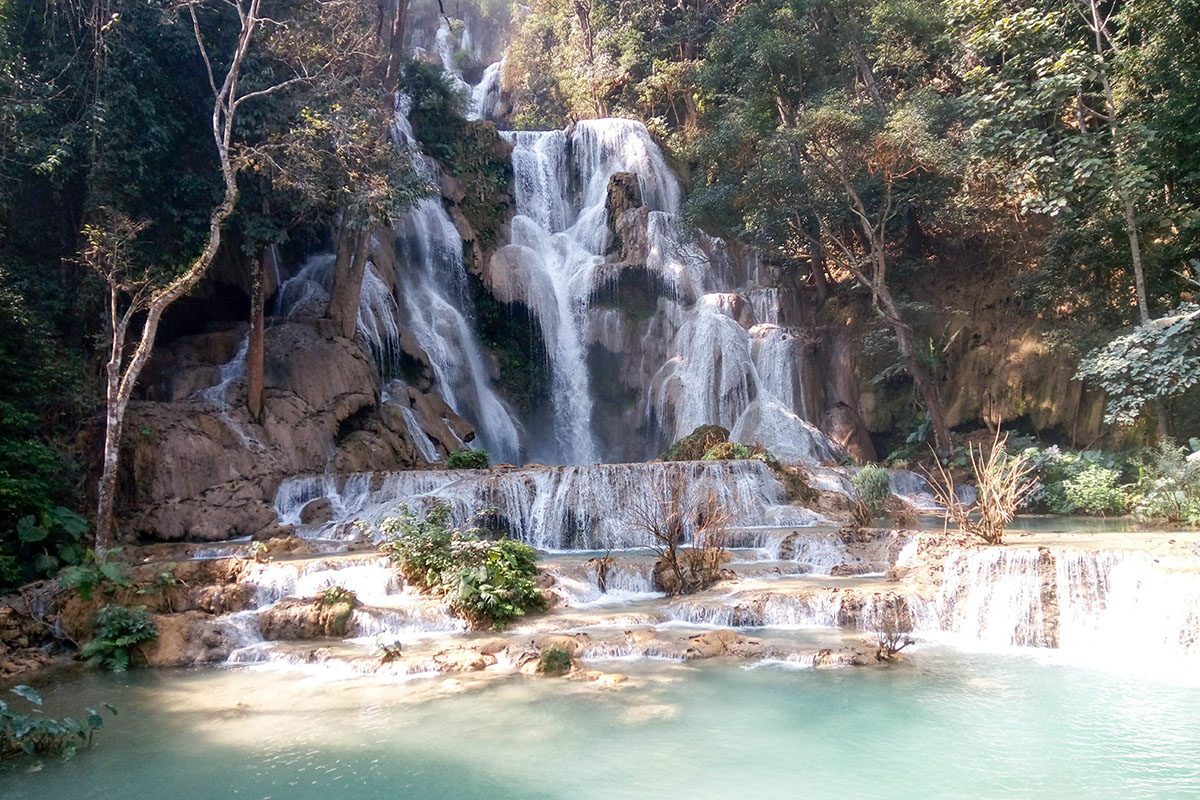
Much of South East Asia is already very well explored.
Everyone knows about Bangkok , Bali and the Vietnamese coastal route (although it’s still very easy to get off the beaten track in these places!). But somewhere that’s not given nearly enough credit is Laos. Laos does have a position on the ‘ banana pancake trail ’, but it is poorly represented.
Many travelers in Laos just go to the UNESCO world heritage site of Luang Prabang, the hedonistic Vang Vieng, and Vientiane – the country’s capital. Now, I’m not saying that these places aren’t worth your time – although I don’t know if I’d return to Vang Vieng, but I’d encourage people to make their own mind up there – but there is so much more in Laos.
The south is much quieter than the north – it’s amazing to be in South East Asia and not be constantly amongst hoards of tourists – and there are spots in the northern mountains that see virtually no foreigners. It’s very easy to get off the beaten path in Laos.
But nonetheless, many travelers and backpackers in Laos want to see the country’s highlights as well; there’s a reason why so many travelers visit them, after all. I spent January 2019 in the country putting together this jazzy Laos itinerary, with all the tips and tricks you need to enjoy your time in the country.
This one month in Laos itinerary (which can be cut to create a 1 week, 2 week or 3 weeks in Laos itinerary, I’ll go into that in detail later) takes you through all of the best places in Laos, including some really off the beaten path Laos attractions and the more touristy places. And yes, there’s even a stop in Vang Vieng.
So buckle in, grab a mug of ginger and lemongrass tea (it’s all I’ve drank for the last month) and read about the very best places to spend up to one month in Laos!
How to get to Laos

As mentioned, many people incorporate their trip to Laos in a longer South East Asia trip – sometimes following the banana pancake trail. So most people fly into Bangkok and travel to Laos from there; you can reach most major cities from either Bangkok or Chiang Mai in northern Thailand.
From Bangkok, you can take a train to Nong Khai and cross the border to Laos, or there are direct buses. There are also direct buses from Chiang Mai to Laos. Laos is also accessible overland from Cambodia, Vietnam, China and Myanmar. It sits so snugly in the middle that I find it surprising that it’s skipped over so much! You can also fly into Vientiane.
As you may or may not know, I heart overland travel, so I can’t advise too much on flights; but I know that Vientiane serves most local destinations and Pakse and Luang Prabang have some international flights. You can book transport around Laos by using Bookaway. Click here to see times and prices.
Visas for Laos
Most countries get a 30 day visa on arrival at Lao borders and airports. The cost for this ranges from $30 – $42 if you’re Canadian (sorry guys). My visa on a UK passport was $35. You’ll need a passport photo of yourself – an extra fee applies if you don’t have one. The visa on arrival process is pretty painless and self-explanatory.
Health and Safety in Laos
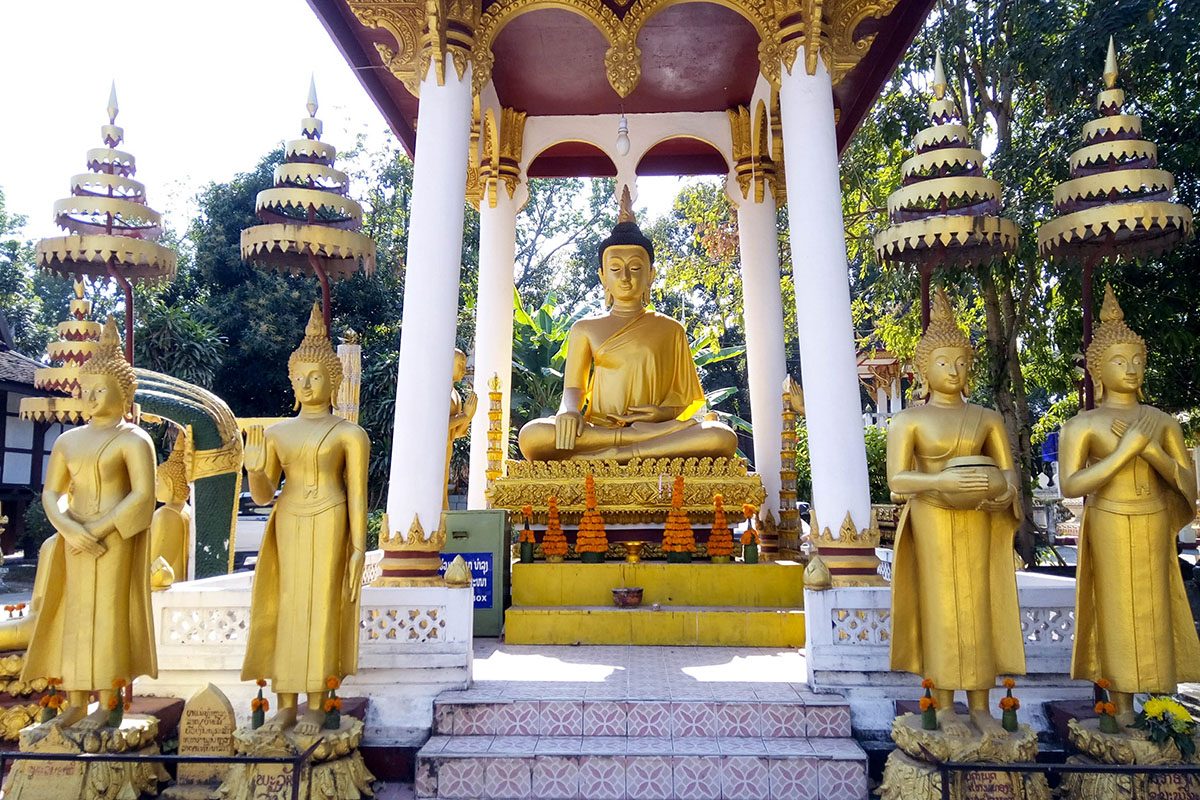
Laos is SO socially safe. Like, if I was dining alone and left my phone on the table while I went to the bathroom, it would probably still be there safe. (Disclosure: If you try that, I take no responsibility for what happens. I’m just trying to illustrate how safe it is).
The people are lovely and I didn’t go anywhere which had a dangerous feel. That’s not to say that pickpocketings don’t happen; I’m sure that they do. But on the whole, it’s suuuper safe. One thing that isn’t as safe is Lao roads. There isn’t really much you can do about this (trains don’t exist, at least not at the moment), but maybe take some travel sickness pills along with you.
If you’re worried, try not to travel at night (I never travelled at night, not because I wouldn’t have but because none of my journeys were long enough. One girl I met said she wouldn’t travel at night because of safety concerns). Health, on the other hand, is a bit iffier. You’ll need to make sure some vaccinations are up to date before you travel to Laos – check fit for travel to see what ones. Some people take malaria tablets (I did), and dengue fever is present so make sure that you use lots of mosquito spray.
It’s best to check with a travel doctor before you head to Laos to get some real medical advice (as much as I try to pretend I know all the illnesses, I really don’t and would hate to misguide anyone!). Minor illnesses are also common in Laos – due to poor food hygiene in some places, change in climate, just general travelling… I managed to contract the following, pretty much one after another (which was just lovely ), while travelling in Laos…
- Esophagitis from swallowing a Doxycycline pill just before bed
- Earwax build up from wearing earplugs to bed every night (I had to get my ears syringed!)
- Food poisoning from eating room temperature food in the night market in Luang Prabang – check out some tips for dealing with travellers’ diarrhoea here .
- A weird cough/ dry throat/ cold from temperature changes
IT WAS SO PLEASANT.
This also means that I visited lots of doctors in Laos, two which I highly recommend. These were Alliance Medical Practice in Vientiane and Phakhan’s Clinic in Luang Prabang .
WiFi in Laos
I was actually very pleasantly surprised with the Wi-Fi in Laos. Sometimes it isn’t great, but in many places I stayed in it worked really well! Many people decide to boycott Wi-Fi and get their own Laos SIM.
I’m always averse to this, I don’t know why – I guess I just love being off the grid. Even when I spent 5 months living in Oaxaca , Mexico, I didn’t get my own SIM! But anyway, it’s very cheap to get a local SIM and they can be purchased from many stores and some hostels.
OR if you are flying via BKK (Bangkok), you could order a pre-paid SIM to collect there – so it’s ready to use as soon as you get to Laos. Click here if you want to learn more about this fab service.
Food in Laos
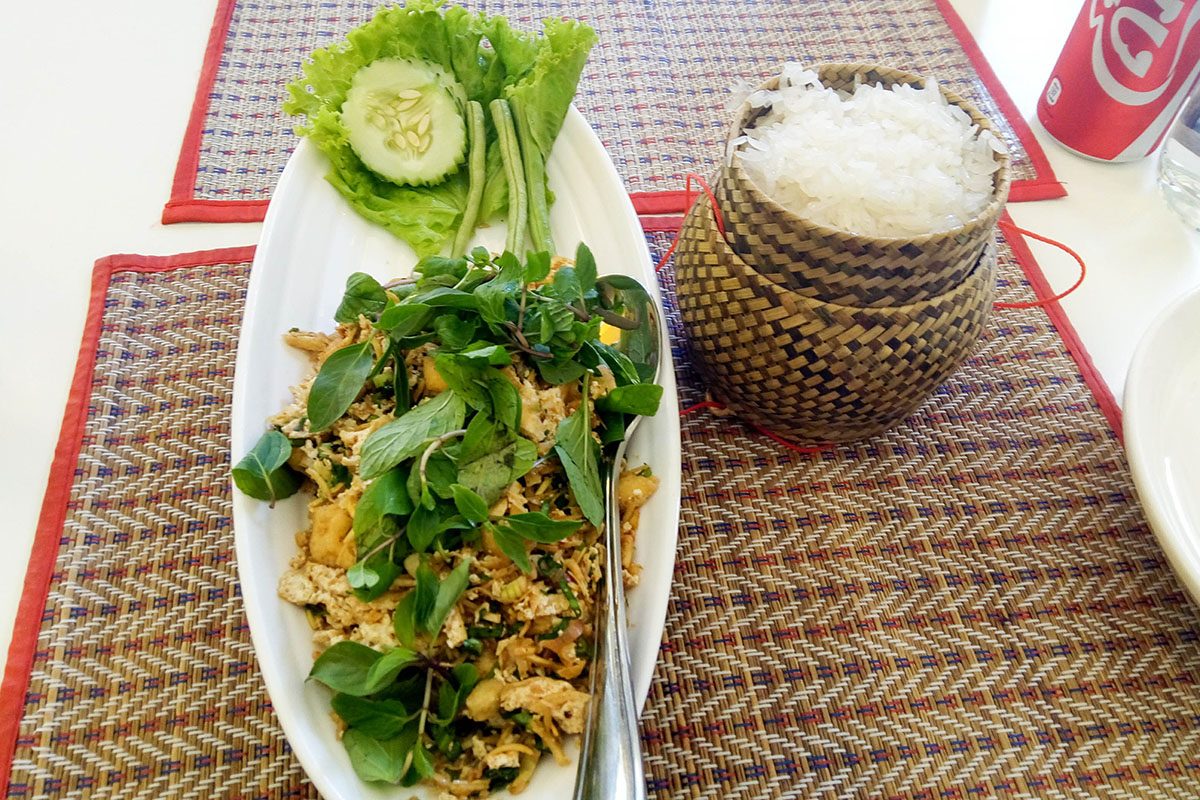
I found the food in Laos variable. A lot of it is very similar to Thai food; curries of different spice levels are popular here. There is also an unavoidable French influence, especially in the colonial cities; it’s the place in South East Asia to get a baguette (whod’a thought it?!).
Lao people eat more sticky rice than any other nation in the world, so many authentic Lao dishes will include this component. You just pick up rice from the container, mold it into a ball and dip it into whatever side dish there is, which can be anything!

There are also a lot of Indian people living in Laos, and we all know what that means… Indian food! There was at least one Indian restaurant in every city I went to. I found it quite easy to be vegan in Laos – I just asked for the vegetable curry with no fish sauce most of the time, or visited an Indian restaurant which are always vegan travellers’ all over the world!
I used Happy Cow to find recommended restaurants, and I managed to grab this delightful tofu larb (featured) in Vientiane. Larb is one of Laos’ traditional dishes, it’s a salad generally made with meat and herbs and served with sticky rice. I was really happy to find a vegan version and can confirm, it’s absolutely delicious!
How to travel around Laos
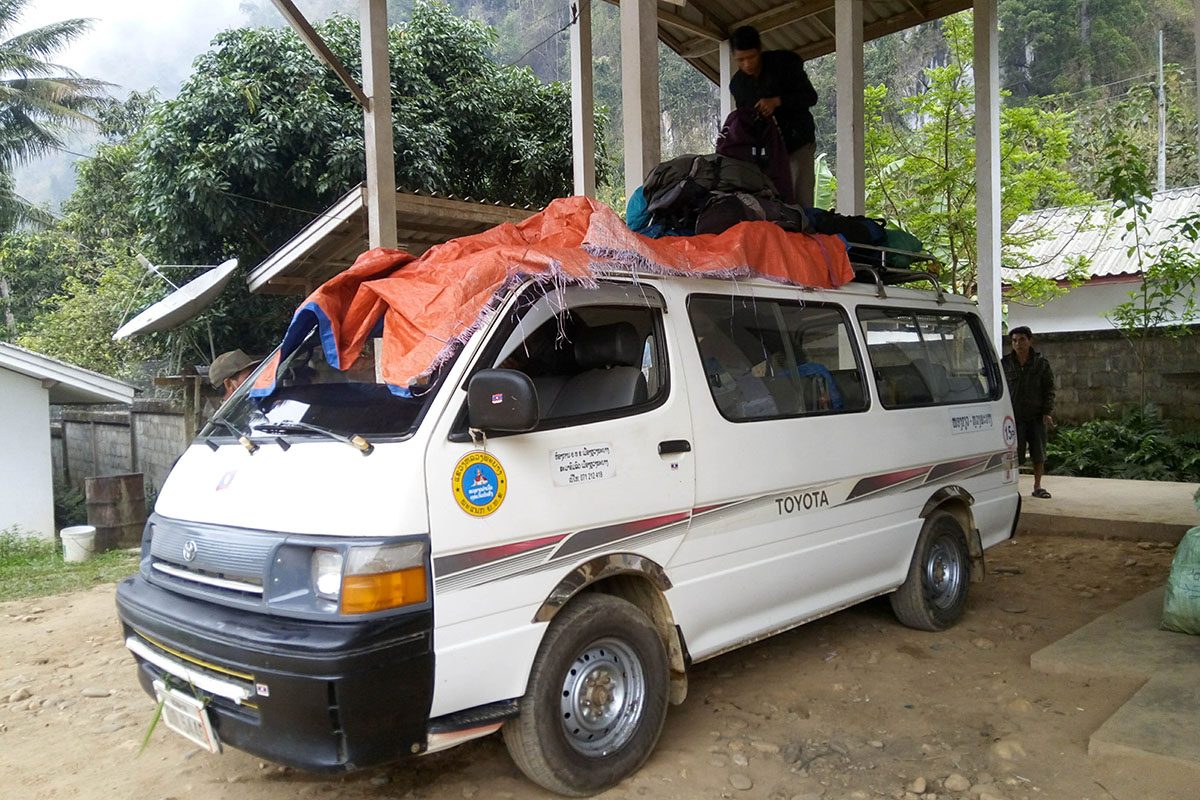
There’s only one feasible way to travel around Laos – good old buses. They’re an adventure in themselves – they generally don’t seem roadworthy and will leave you hanging on for dear life as they navigate bumpy roads and hairpin bends… oh, and they are always absolutely packed with people.
Lao buses actually have a fold-down seat in the aisle for each row, just to fit another person on! You can opt for VIP buses, which are more direct (although they do still stop sometimes) and are slightly more expensive. Or you can take local buses which stop absolutely everywhere, are fairly cheap, and take forever.

Buses in Laos can cost anywhere from 30,000 kip for a three hour local bus (I paid this from Savannakhet to Thakhek) to 110,000 kip for a sleeper VIP bus (this is the cost from Thakhek to Vientiane). The bus from Pakse to Vientiane, the longest direct bus in the country, costs around 270,000 kip. Once you’re in towns and cities, tuk-tuk is the general mode of transportation.
These are probably the most expensive thing about travelling in Laos, and quite often they will be set at a very inflated price which will be incredibly difficult to negotiate down. I found Thakhek to be the worst for this. In smaller towns, like Nong Khiaw and Champasak, your own two feet are perfectly fine for transportation – everything is in walking distance. In Vientiane, there are some local buses which are good value. Click here to book transport on Bookaway!
When to Visit Laos

Much of Laos – unlike a lot of South East Asia – has very distinct rainy and dry seasons.
The rainy season generally runs from May to September, and I wouldn’t recommend travel to Laos during this time. Sure, you can still do things – but it rains a lot, many places are closed, and many others either inaccessible or very dangerous to access. This is more noticeable in Laos than other neighbouring countries because the rainfall is heavier in these months and Laos has less infrastructure than Vietnam, Thailand and even Cambodia.
During the dry season, however, Laos is a dream.
From October to April, you’ll have very little to no rain, blue skies, and the temperatures will still be pretty warm. In the highlands, they can drop during the night, but day temperatures, as a rule, remain quite high. It’s definitely one of the best places to visit in Asia in December and January .
If you visit in December, waterfalls will be at their strongest – and Laos has a lot of them.
I visited in January and enjoyed perfect sunshine every day. It does get a bit misty in the north during the mornings, but this generally clears by about 11am.
Where to Stay in Laos
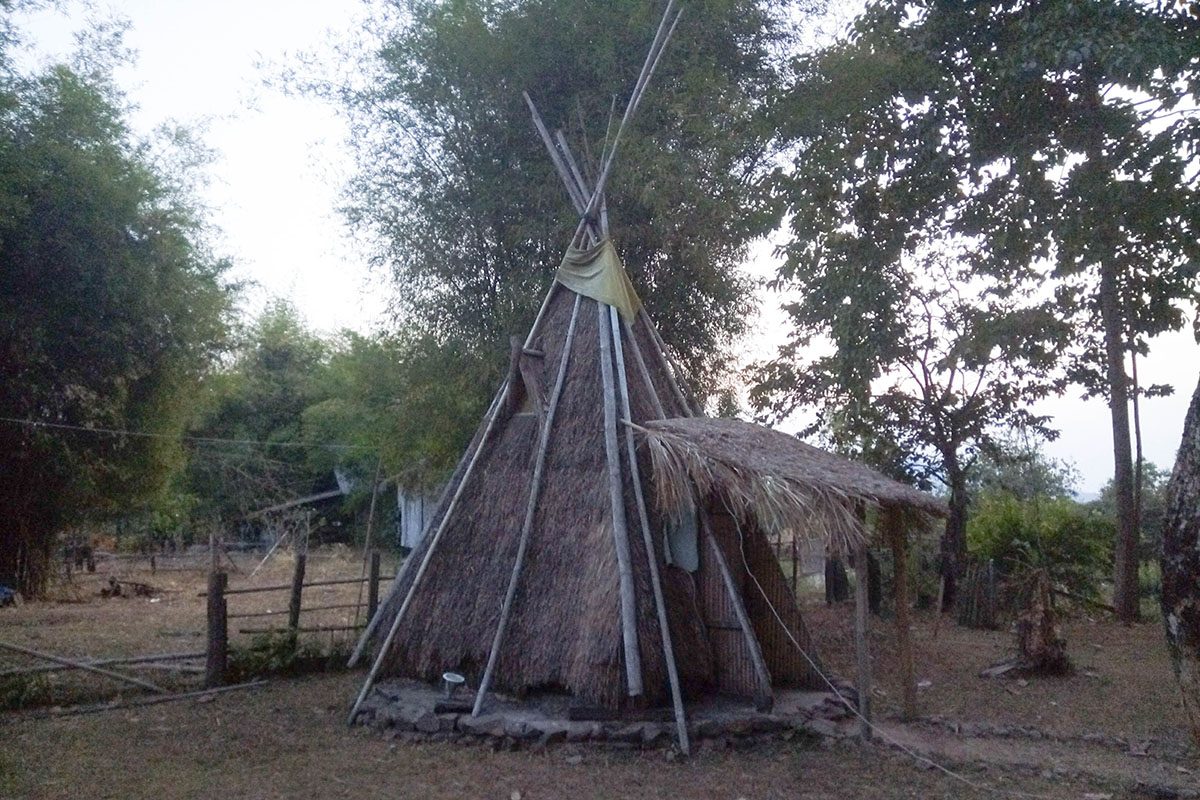
Laos only really has hostels in the main touristy areas.
So if you’re venturing off the beaten path, to places like Savannakhet, Kong Lor, Phonsavan and Nong Khiaw, you’ll be staying in guesthouses (for about the same price, so it’s all good). Lao guesthouses are normally pretty basic but clean – although many don’t have hot water.
It’s all part of the fun of travelling in this part of the world! In Vientiane, Vang Vieng and Luang Prabang, there are more luxury accommodations.
I’ve included hostel, guesthouse and hotel recommendations in each section of this post, but click here if you want to do your own research into where you might stay in Laos.
How long to spend in Laos
As mentioned, most citizens get 30 days visa on arrival at Laos borders (overland or airport). I’d recommend spending the entire one month in Laos – there’s loads to see, and it does take a bit of time to get around! But, understandably, some travelers are on more of a time limit.
If this is you, then one, two or three weeks in Laos might work better. This Laos itinerary focuses on one month in Laos, but if you have less time, think about doing one of the itineraries specified below.
One week in Laos
Luang Namtha – Nong Khiaw – Luang Prabang Luang Prabang – Vang Vieng – Vientiane (this is the typical ‘banana pancake’ route) Thakhek – Kong Lor – Vientiane 4,000 Islands – Pakse – Bolevan Plateau
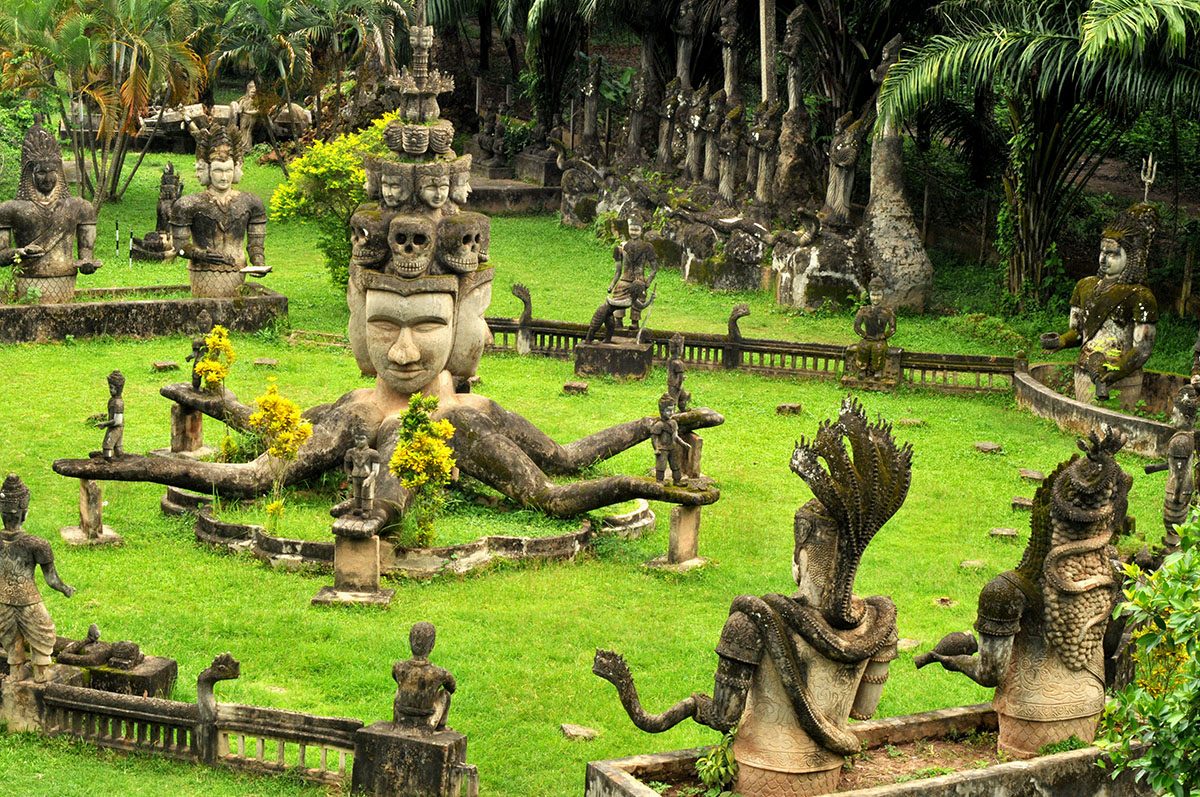
Two Weeks in Laos
Luang Namtha – Nong Khiaw – Luang Prabang – Vang Vieng – Vientiane Luang Prabang – Phonsavan – Vang Vieng – Vientiane Vientiane – Kong Lor – Thakhek – Pakse – Boleavan Plateau 4,000 Islands – Champasak – Pakse – Bolevan Plateau – Savannakhet
Three Weeks in Laos
Luang Namtha – Nong Khiaw – Luang Prabang – Phonsavan – Vang Vieng – Vientiane – Kong Lor – Thakhek – Pakse – Boleavan Plateau – 4,000 Islands
One month in Laos
My itinerary for one month in Laos will take you from north to south, hitting all of the best tourist attractions en route. The Laos itinerary includes:
- Luang Namtha
- Luang Prabang
- Savannakhet
- Boleavan Plateau
- 4,000 Islands
and it’s not too rushed. So, shall we get into it?
Getting to Laos
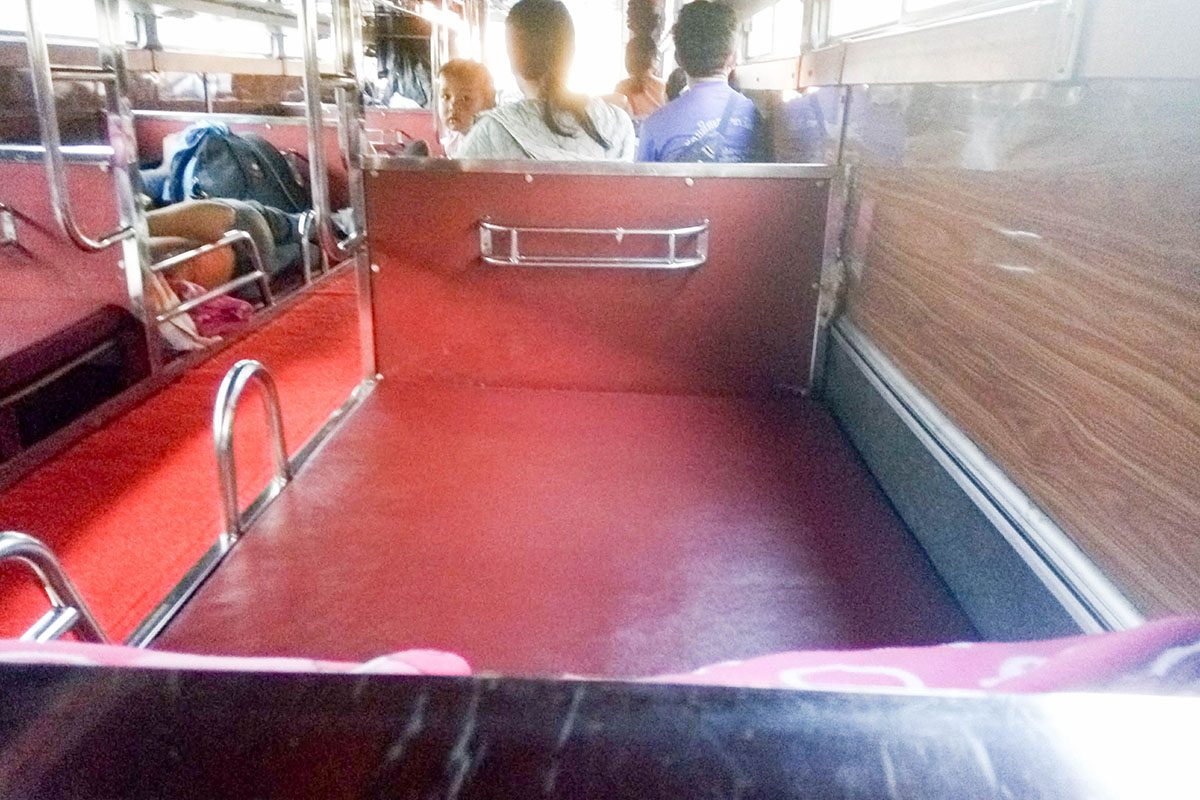
This Laos itinerary starts in the north of the country – imagining that you have crossed overland from Thailand. If this is you, you’ll want to book a bus from Chiang Rai or Chiang Mai to Luang Namtha.
This same bus will, however, go all the way through to Luang Prabang, so if you want to get off there and skip the north (which I highly don’t recommend, Nong Khiaw is one of my favourite places in Laos), that’s possible too. Of course, many people enter Laos via slow boat.
If you want to do this too and still follow this itinerary for Laos, you have two options. You could either take the slow boat from the border to Pak Beng and from there take a bus to Luang Namtha. This cuts your slow boat time in half – although many people have said that they would have been happy with just one day on the river. I guess it’s called the slow boat for a reason…
Your other option is to take the slow boat all the way to Luang Prabang, then take a bus to Nong Khiaw, another to Luang Namtha via Udomxai, and then take a bus back to Luang Prabang. This method does involve a lot of backwards and forwards right at the start of your trip. If you don’t really want to do this (you will be spending a lot of time in buses during your 4 weks in Laos), then you could just visit Nong Khiaw as a side trip from Luang Prabang and cut out Luang Namtha.
You might also enter Laos from the south.
This is actually what I did – but most people I met were going north to south, so I thought it imperative to write it in reverse. If you book a bus from Siem Reap with Asia Van Transfer (book by clicking here), you’ll be guided through the crossing all the way to Don Det.
This is what I did and although a very long journey, it flowed pretty seamlessly. You can also take a bus to Pakse (where you can travel south to the 4,000 islands and then north again to the rest of the country) if you are entering Laos from south Thailand. And this Laos itinerary actually follows the border of Thailand for a lot of the way, so if you want to enter Laos in the centre of the country you can do so by crossing at Savannakhet, Thakhek or Vientiane.
Book transport to Laos on Bookaway by clicking here.
Luang Prabang – 2 days

Note: I’ve put Luang Prabang at the start of this Laos itinerary because it is where a lot of travellers first enter the country, whether they are taking a slow boat or an overnight bus from Thailand, or a long-distance bus from Vietnam. However, if you are entering from China, Thailand or Vietnam and fancy an adventure, you might prefer to travel via the northern highlands and see some local villages – the routes are detailed below. If you are taking the slow boat or a direct bus to Luang Prabang but still want to see the highlands, you can easily travel from Luang Prabang to Nong Khiaw and Muang Ngoy and then return to Luang Prabang before heading south. Luang Namtha is a bit more challenging, but I’ve detailed what you need to know below.
After Vang Vieng, Luang Prabang is the most touristy place in Laos. But unlike Vang Vieng (I’ll get into that shortly…), Luang Prabang is really quite charming. The city is filled with French colonial architecture and it is located on the Mekong. It’s a very religious city and the central area is a UNESCO world heritage site.
There are loads of things to do in Luang Prabang to spend a few days. If you’re taking a morning bus from the north, you’ll get to Luang Prabang at around midday. If you’ve taken the slow boat from the Lao/ Thailand border, you’ll get there in the evening and be able to enjoy a full day the next day. I’d recommend spending your first day in Luang Prabang strolling around the city centre, checking out all of the architecture.
There are plenty of Wats to explore, as well as the Royal Museum which tells the story of Lao royalty and how it intertwines with Buddhist ideals. After exploring these spots, head to Mount Phousi for a spectacular sunset – but try to get there about an hour before sunset as it is incredibly busy! Mount Phousi is a very spiritual place for Lao people, so take some time to absorb the mystical feeling of it and of course, admire the spectacular view.
Follow this link to book a half day tour of Luang Prabang’s best sights.
For dinner, check out Tamarind. Specialising in set menus of Lao cuisine, and with plenty of vegan options, dining here is a must-do in Luang Prabang. Do try and book during the day though, as they are often very busy and don’t always accept walk-ins. If they are booked or you fancy something a bit different, you could think about doing a Luang Prabang food tour – click here for more information and to book.
Day number two in Luang Prabang has a very early start. Wake up at 4:30, ready to see the almsgiving at 5am. This is where the monks walk down the street and are offered different food and products. It really shows you how spiritual Luang Prabang – and all of Laos – is and is certainly one of the most unique things to do in Laos. You can see the almsgiving independently, but to ensure that you get the best spot, to enable you to interact with the monks and to learn all about this sacred tradition, you could book on a local tour. Click here for more information.

Day tripping out to Kuang Si Falls is a must-do while in Luang Prabang. These waterfalls are among the best in South East Asia and, although busy, are well worth it. Hire a motorbike to make the journey or book onto a minivan for around 35,000 kip return.

You’ll get back to Luang Prabang after lunch, and if you still have the energy think about taking a boat to the Pak Ou Caves. If you don’t want to go to the caves independently, you could book a tour that will take you to both the falls and the caves. Considering that you can only get to the waterfall by tourist shuttle or motorbike, this might be a good idea. Learn more about and book the tour here.
An alternative for your afternoon in Luang Prabang is a cooking class. There are a few cooking classes available throughout the city; click here to learn more about a highly rated class. You could also take a course at Tamarind – the place I recommended you eat at the night before. Click here to book it.
Upon returning, and maybe after a power nap (you did wake up at 4:30am after all!) head to Utopia. This bar offers yoga during the day and turns into Luang Prabang’s best club at night. They also offer food with a variety of Asian and Western options. Be sure to stay here for some BeerLao after dinner! If you’re up for a big night out…. You won’t get it in Luang Prabang, sorry. But what you can do is wait until Utopia closes at about 11:30pm, and then head to the bowling alley. Yep, that’s right – the bowling alley in Luang Prabang is the place to be late at night (it’s the only place that sells alcohol past 11pm). Watching a load of rowdy drunks attempt to bowl is an extraordinarily entertaining way to finish off your time in Luang Prabang!
Where to Stay in Luang Prabang
Hostel: Smile Luang Prabang Hostel is a great option for backpackers. With sturdy beds with their own individual light and curtain, good wifi and air conditioning, it is a fantastic place to stay in central Luang Prabang. Click here to book Smile Luang Prabang Hostel. Mid-Range Hotel: Sanctuary Hotel Luang Prabang enjoys a central location, but is indeed a sanctuary, set back from the city. Rooms are air-conditioned and the hotel has free WiFi. Each room has a flat screen TV and safety deposit box, as well as an en-suite with warm shower. Click here for some information about Sanctuary Hotel and to book. Luxury Hotel: Mekong Riverview Hotel is one of the best luxury options in Luang Prabang. With spacious rooms with a balcony and private bathroom (some with a spa bath!), massage facilities, a pool and a bar, you’ll be in the lap of luxury during your stay. An excellent breakfast is included. Click here for more information and to book.
Where to go from Luang Prabang
If you want to check out northern, off-the-beaten-path Laos, keep reading for a Northern Laos itinerary. If you haven’t got time or don’t want to venture too far off the beaten path, click here to go straight to the Vang Vieng section of this Laos itinerary (this is what most travellers do), or click here to see what Nong Khiaw has to offer (this will require a return 3-4 hour journey to Luang Prabang, but I definitely advise you check it out – it was one of my favourite parts of Laos).
Luang Namtha – 1-2 days

Luang Namtha is beautiful and well worth the visit if you have enoguh time during your one month in Laos and don’t mind windy, long bus rides! It’s also a great stop over if you’re entering Laos from Thailand and not taking the slow boat – you’ll pass through the town on the same bus. Here’s the route from Thailand to Luang Prabang via Luang Namtha and Nong Khiaw:
Not many travellers come to Luang Namtha, which is shown in the lack of tourism in the region. This makes it a great place to get in touch with local life! The main highlights of Luang Namtha can be enjoyed by driving a motorbike around the town and local villages. You’ll get to see authentic village life, spectacular views like the one over the Sea of Rice and visit the Nam Dee Waterfall. If you’re feeling really adventurous, you could drive the 64 kilometres along windy mountain roads (or take the bus, that’s totally cool too) to Muang Sing, which is very close to the Chinese border and about as remote as you get. This is even more ‘authentic village life’ than Luang Namtha and has some equally spectacular scenery.
Where to Stay in Luang Namtha
In rural Laos (which is most of the country), there are less flashy hotels, and more basic guesthouses. These are very kind on your wallet, and while basic, you can generally get clean, safe, comfy rooms. Kingmala Guesthouse in Luang Namtha is a budget kinda place; its rooms are no-frills, but they provide an attached bathroom as well as comfy beds, good WiFi and air conditioning. The staff are friendly and helpful. It’s probably your best bet in Luang Namtha whatever your budget – click here to read more about it.
Muang Khua – Muang Ngoy – 1 day

If you’re entering Laos from Vietnam and fancy a route a bit different to the direct bus to Luang Prabang, consider taking a bus frm the border to Muang Khua. From here, you can take a boat down the Nam Ou river, through some of the ‘most dramatic scenery in the country’ (says Lonely Planet). It takes six hours and seeing the water bordered by mountains is absolutely phenomenal. You’ll then be in Nong Khiaw, which has easy access to Luang Prabang. If you’re in Luang Namtha and you want to add on the Nam Ou River boat trip, you might want to think about taking this route and then travelling by boat from Muang Khua to Nong Khiaw:
There isn’t much to do in Muang Khua, it’s generally just a transit town. Muang Ngoy is popular with tourists and does have some epic climbs and viewpoints, but it is very touristy and I personally preferred Nong Khiaw. From Muang Ngoy, you can take a boat to Nong Khiaw – or even kayak there! It takes a couple of hours but is a great way to really take in the spectacular scenery.
Where to Stay in Muang Khua and Muang Ngoy
Remember when I said that Muang Khua is well off the beaten track? This means that there are few guesthouses that are actually online – many of them you need to just rock up and hope they have a room. If you want to be secure and opt for one that’s on Booking.com, Chinese Guesthouse is bookable through this link. (I stayed in a homestay near Muang Khua which was organised through my tour, so I didn’t need to look for accommodation there). There are more options in Muang Ngoy, if you decide to spend the night here. Riverview Bungalows and Guesthouse has a garden, bar and restaurant serving Asian and European food. Bungalows looking over the river have en suite bathrooms and a balcony. Click here for more information.
Nong Khiaw – 3 days

Beautiful Nong Khiaw is one of my favourite towns in Laos. Nestled in the mountains on the river Nam Ou, it’s a great jumping point for exploring the trails and mountains of the region. You could spend a few days hiking in Nong Khiaw; and the town itself is very chilled out and famous for their herbal steam baths. There are two lookouts above the town which can be hiked to independently, and also some great caves in the town. Spend a day just chilling in the town and seeing these sights. Be sure to enjoy a herbal bath and massage at Sabai Sabai. And Deen’s Indian is a great spot for dinner.
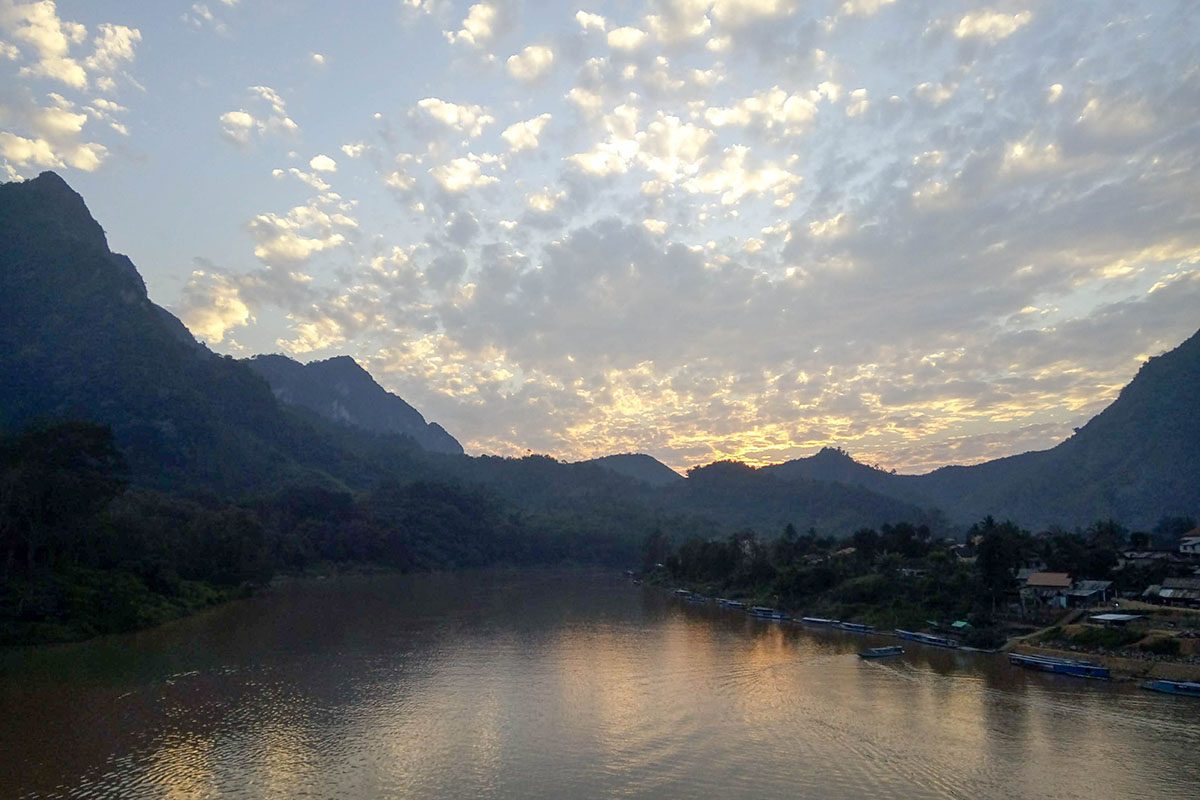
But the best of Nong Khiaw is in the surrounding area. Take a two-day hike to see some of the spectacular nature of the region, including jungle, rice terraces and local villages. You’ll travel from place to place by boat, hike to waterfalls, and stay in a homestay in a local village. Of course, all food will be authentically Lao and Lao Lao (local whiskey) is included! These tours are not bookable online, but you can head to the tour operators when you arrive in Nong Khiaw and see which treks they have leaving while you’re in town.
Where to stay in Nong Khiaw
Hostel: there is one hostel called Delilah’s, which also has an attached restaurant serving some of the best food in town. Dorms are very cheap (just 35,000 kip) but they do not take reservations and are often full. This was the case when I was there, so I haven’t seen the dorms, but the cafe area is nice and pretty chill. However, a word of warning that I read on Wikitravel was that the boss not actually that nice to his staff – so it’s up to you whether you feel comfortable staying/ eating there. I experienced him not being too pleasant to a waiter while there, which made me feel quite awkward! Guesthouse: Sythane Guesthouse is decent and a great price. Rooms have their own en-suite with a shower (it’s traditional over-the-toilet like elsewhere in Laos, but it’s ok!), double beds and their own little outside area, some with hammocks. It’s right next to Deen’s Indian Restaurant, a great eatery where I ate basically every day while in Nong Khiaw… #creative. Click here for rates and to book Sythane Guesthouse.
Where to go from Nong Khiaw
From Nong Khiaw, take a bus back to Luang Prabang. From here, you can take a bus to Phonsavan (you will probably need to stay one more night in Luang Prabang). Click here to book your bus tickets.
Phonsavan – 3 days
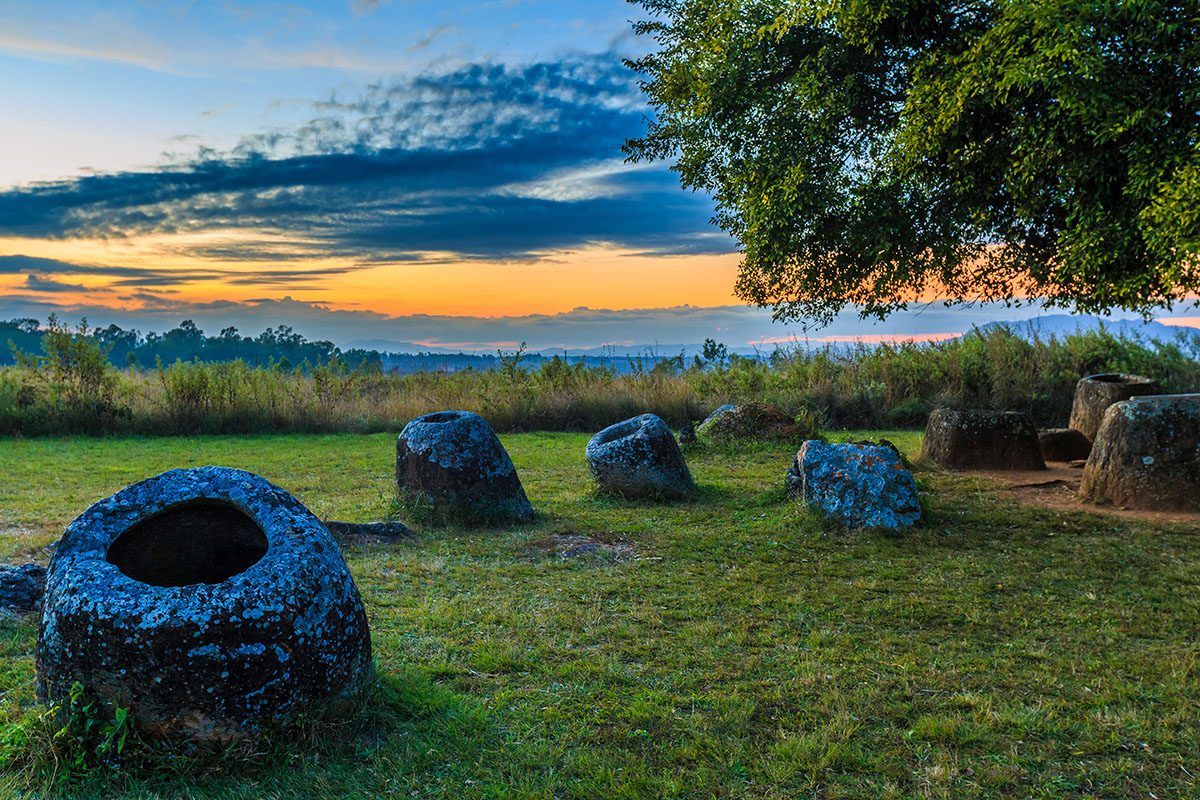
In Phonsavan, there is a grassy expanse which is just full of jars. Nobody knows how they got there. But there’s jar after jar after jar. It’s wild, and it’s definitely worth the 8+ hour bus trip from Luang Prabang and Vang Vieng. It’s the ‘ Strange Plain of Jars ‘ (says BBC travel) and while it is very remote, it’s well worth the journey if you have the time. The urns on the plain date to the iron age, and nobody really knows how they got there or exactly what they were used for. It seems really strange to travel for hundreds of kilometres to check out some stone jars littered around the countryside, but the mystique of it all really adds to the atmosphere. Laos wants to make the Plain of Jars a UNESCO world heritage site , but the area has to be completely cleared of UXOs before this can happen (more on that later). There are three sites that are accessible from Phonsavan by foot, bike, tuk-tuk or tour. Either rent a motorbike and use maps or join a tour. The tour will obviously give you lots of historical information, like the leading theory of why the jars are there (spoiler: it’s related to decomposing bodies..). It also includes a few other stops like a whiskey-making shop and a few war exhibitions. This area was savagely bombed during the Secret War; the bomb craters you see are a sombering reminder of this. But unfortunately, this isn’t something that just existed in the past – bombs exploding are a very real threat to this day. Make sure that you stay on marked paths which have been cleared, and don’t wander off the trail. You’re probably saying ‘Claire that’s obviously only one day worth of activities, why have you advised I stay here for three?’. I haven’t. I’ve just factored in the two travel days that it takes to get there and back out to Vang Vieng. It’s a long ol’ journey, full of twists and turns – maybe not for the faint hearted, but you’ll experience a side of Laos that many tourists miss out on. Even though it’s an absolute mission away from anything, I would still recommend visiting the Plain of Jars. Click here to book a bus from Phonsavan to Vang Vieng
Where to Stay in Phonsavan
Again, there aren’t any hostels in Phonsavan (this is one of the ways that Laos is actually more expensive than Thailand and substantially more than Vietnam to travel, as there is less backpacker-style accommodation. It’s still cheap though, dont’ sweat too much!). But The Hillside Residence is a good find. The rooms are clean and comfortable – extra touches like well-placed lighting make a difference and give it a more deluxe atmosphere than a lot of Lao guesthouses. The staff are really friendly and will happily meet you at the bus station. Rooms have balconies and private bathrooms, and the staff are happy to give lots of information about the local area. Click here for rates and to reserve.
Vang Vieng – 2 days
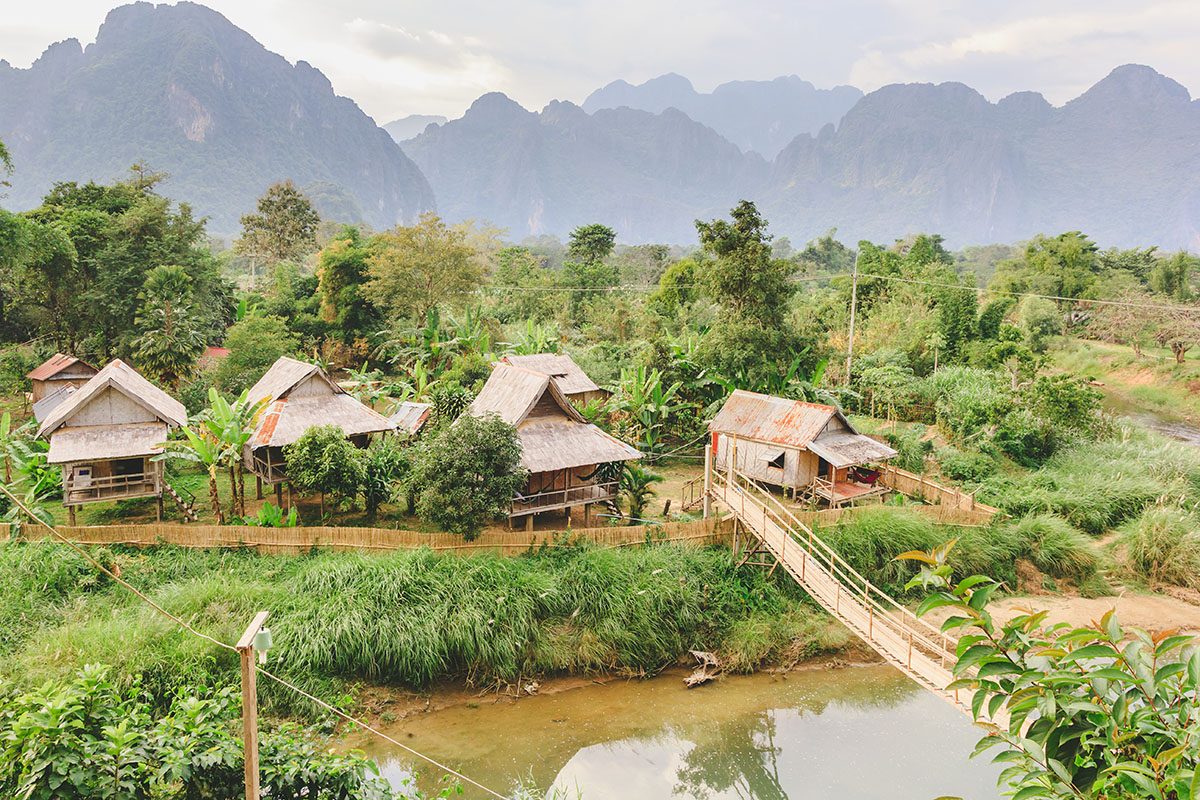
Oh Vang Vieng. What a place. So bearing in mind I arrived here after spending 3 weeks in Southern Laos, honestly – I just disliked it. The main street has absolutely no culture, bar one temple, and is just full of backpacker bars and restaurants. I got called boring by a guy wearing leopard print leggings and fluorescent paint because I didn’t want to go inside the bar he was working for. It was just a shambles. Vang Vieng was once the most hedonistic place in Asia . It was home to infamous tubing, with dozens of bars open on the river, frequented by inebriated backpackers every day. But bad things happened – in one year alone, 27 people died in the river from getting drunk and doing stupid things. That’s a tragic amount of lives lost due to silly drunk mistakes. It has calmed down a lot now. Tubing still exists, but there are only 4 bars to drink at these days, and a lot of the areas that cost people their lives have been removed or fenced off. However, it remains a party town, which is pretty out of touch with Laos. It’s certainly unlike everywhere else I went in Laos.
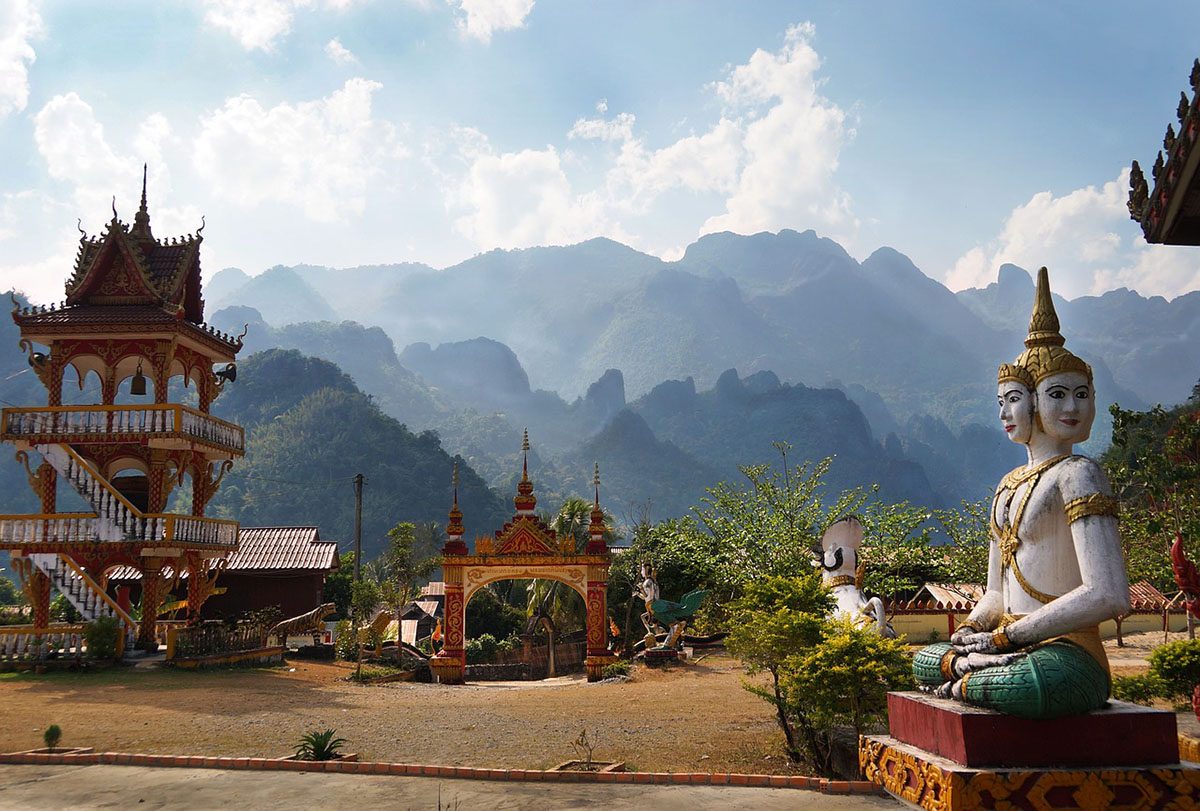
But anyway, the countryside around the town is beautiful. And there are a lot of things to do in Vang Vieng . Plus, I’m not saying that nobody should party in Vang Vieng – but if you do, please be respectful to local culture and don’t be rowdy or do anything offensive. Even though I really didn’t like Vang Vieng, I do understand its appeal. It’s a place where you can adventure in the day and drink throughout the night, as well as meet dozens of new people. If you’re spending two days in Vang Vieng, one of them will probably be taken up with tubing. Believe it or not, you don’t have to drink to do this – but if you do, please don’t take it too far. For day number two, I’d recommend hiring a bicycle or motorbike and seeing some of the lookouts and natural phenomena. The Blue Lagoon is located 7 kilometres from the town and is a great spot to cool off on a hot day. The Pha Ngeun Viewpoint is located on the way to the Blue Lagoon. It takes about 1-1.5 hours to hike up (it’s harder than it looks!) and there are great views of the surrounding nature from the top. Read my post about hiking in Vang Vieng for more information. If you’re feeling adventurous, you could also check out some of the caves and other activities. Some of the adrenaline-boosting activities you can do in Vang Vieng are:
- A rock climbing course – click here for more information
- Visiting the Tham Nam Cave – click here to learn more
- Kayaking and ziplining – click here to read more about it
Where to Stay in Vang Vieng
I had a really hard time trying to find accommodation in Vang Vieng. Let’s be real, I had a hard time doing anything in Vang Vieng (read my hiking post for more information…) Hostel – Many backpackers go to Nanas, which is the party hostel. If you fancy that, click here to check it out. I ended up at Jennin Backpackers in a private room, but it wasn’t my favourite hostel. I think the dorms are good value, especially as the rate includes breakfast, but there are definitely cheaper and nicer places to stay in a private room. Click here if you want to check out the dorms. Mid-Range Hotel – Simon Riverside Hotel is a decent option. With an outdoor pool and garden, as well as views looking out over the mountains, the rooms are all en-suite and are clean, with lots of natural light, balconies and a flat-screen TV. Click here for rates and to reserve. Luxury Hotel – if you’re after somewhere deluxe in Vang Vieng, Riverside Boutique Resort is a fabulous place to stay. With bright, airy rooms that are decorated in a traditional style yet have modern amenities, you’ll be in the lap of luxury while staying here. Click here for rates and to book. Click here to book a bus from Vang Vieng to Vientiane
Vientiane – 2 days
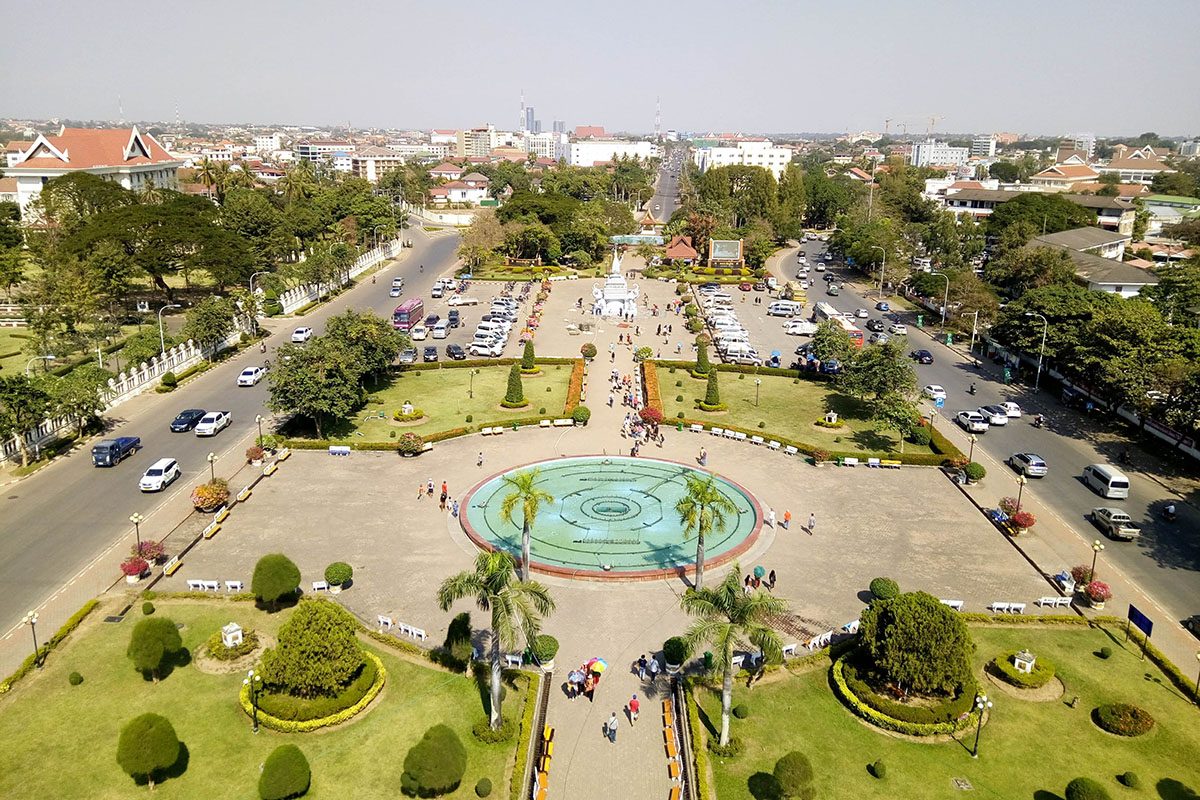
Ok, unpopular opinion, but I loved Vientiane. It’s just so chill, but with a few different things to do. If you arrive into Vientiane on the morning bus from Vang Vieng, getting there early afternoon, I’d recommend spending afternoon number one at the Buddha Park. This park is home to Buddha statues in all shapes and sizes, and it overlooks the Mekong and, on the other side, Thailand. It’s a really zen place, playing the most soothing music, and I loved getting lost amongst the statues. You can hire a motorbike to get there or take a local bus for just 8,000 kip.

For dinner, check out Lao kitchen. Serving Lao’s best cuisine but also tailoring it for Western tastes and dietary requirements, it’s one of Vientiane’s best restaurants. If you want to do a full day tour of Buddha Park and learn about some Lao Textiles to boot, check out this tour. Dedicate your second day in Vientiane to seeing the city. While it does not have as many attractions as most Asian cities, there’s still plenty there to pass some time. The COPE visitor’s centre should be high on any tourists list – here you can learn about the UXOs in Lao’s countryside and how they still very much affect the population today. (UXOs are unexploded bombs from the US bombing of Laos during the Vietnamese War. There are still many in the countryside and they still explode, killing and maiming civilians, to this day). Various wats are worth checking out as well. Sisaket Temple, Wat Si Muang and Wat Phra Kaew are in the city centre and all have their own style and history. At Wat Sok Pa Luang, there is a mediation class led by monks every Saturday! There is also the Patuxai Victory Monument, which looks a lot like the Arc de Triomphe in Paris, but was actually erected in memory of the people who struggled against the French for independence. It can be admired outside and climbed up. If you’d rather see Vientiane on a guided tour, click here to learn more about a cycle tour around the city or here for a car/ van tour of Vientiane’s sights . Obviously, having a guide means that you’ll pick up invaluable information about the capital’s culture and history, so it’s a great idea to do one of these tours while in the city! At night, hit up the market. There are plenty of stalls selling all sorts of food, as well as souvenirs and crafts. And it’s set over the Mekong, where you can gaze over at Thailand. I ended up doing this so much on my Laos itinerary (again in Thakhek and Savannakhet) that I started to feel a bit creepy. Sorry Thailand.
Where to Stay in Vientiane
Hostel: Don’t stay anywhere other than My Box Hostel. It literally is the best hostel I have ever stayed in – I absolutely bladdy loved it here. Each bunk bed has its own ‘pod’ with thick curtains (so you actually can’t see outside lights), individual lights and plugs, super comfy mattresses and nice warm showers. There’s a good free breakfast on offer, plus a coffee shop. It’s not a party place, but it’s absolutely 10/10 lovely. Click here for more details and to book (do it). Mid-Range Hotel: Vientiane Garden Boutique Hotel is a great price, with clean, classy and comfortable rooms. All have their own en-suite with hot shower and there is an outdoor pool. Click here for more information and to book your room. Luxury Hotel: For 5* luxury, check out Muong Thanh Luxury Vientiane which is located just a short drive from the city. Guests at this hotel can enjoy staying in spacious suites with plush velvet furniture, huge beds and breathaking views across the cityscape. On site are tennis courts, a spa and an outdoor pool. Click here for more information and to book your room.
Where to go from Vientiane
Click here to book a bus from Vientiane to Kong Lor (this will involve transferring to a songthaew for the last part of the journey – just make it very obvious that you’re going to Kong Lor and you’ll be directed through the change over).
Kong Lor – 2 days

Note: if you are planning on doing the Thakhek motorbike loop from Thakhek city, you don’t need to stop in Kong Lor on the way as the loop includes it. If you cannot ride a motorbike, don’t try it for the first time here. You can still see Kong Lor Cave by public transport. Get a bus from Vientiane to Kong Lor in the morning. If you’re in a rush, you can see Kong Lor Cave that very afternoon; it doesn’t take long to explore. You’ll need to walk to the park entrance and pay 100,000 kip per boat. Then a guide will take you through the cave (you’ll be on the boat for most of the way but will walk a little) and out the other side to a small village. After a stop here, you’ll get to travel back through the cave and out to the other side, where you can swim or just relax and take in the nature.

If you have more time on your hands, consider a hiking trip in the mountains of Kong Lor. These can be arranged through your guesthouse.
Where to Stay in Kong Lor
Hostel/ Guesthouse: Thongdam Guesthouse has private and dorm rooms – dorm rooms are set in cute little cabins, nestled into the surrounding hills, while the private rooms are in the main building and have their own bathroom. It’s great value and there is a restaurant across the road. It’s just a 15 minute walk from here to Kong Lor Cave and the songthaew will pick you up/ drop you off right outside. Click here for rates and to book. Luxury Hotel: The Kongloview Hotel has self-contained, well furnished cabins with their own bathroom including a spacious shower. There is a bar on site and breakfast is available, and it is located right next to the Kong Lor Cave. Click here for more information and to read reviews. From Kong Lor to Thakhek, you’ll need to get a songthaew. You can pick these up from the main road of the village (it’s pretty self-explanatory when you’re there, there’s only one road that runs through Kong Lor).
Thakhek – 2-4 days
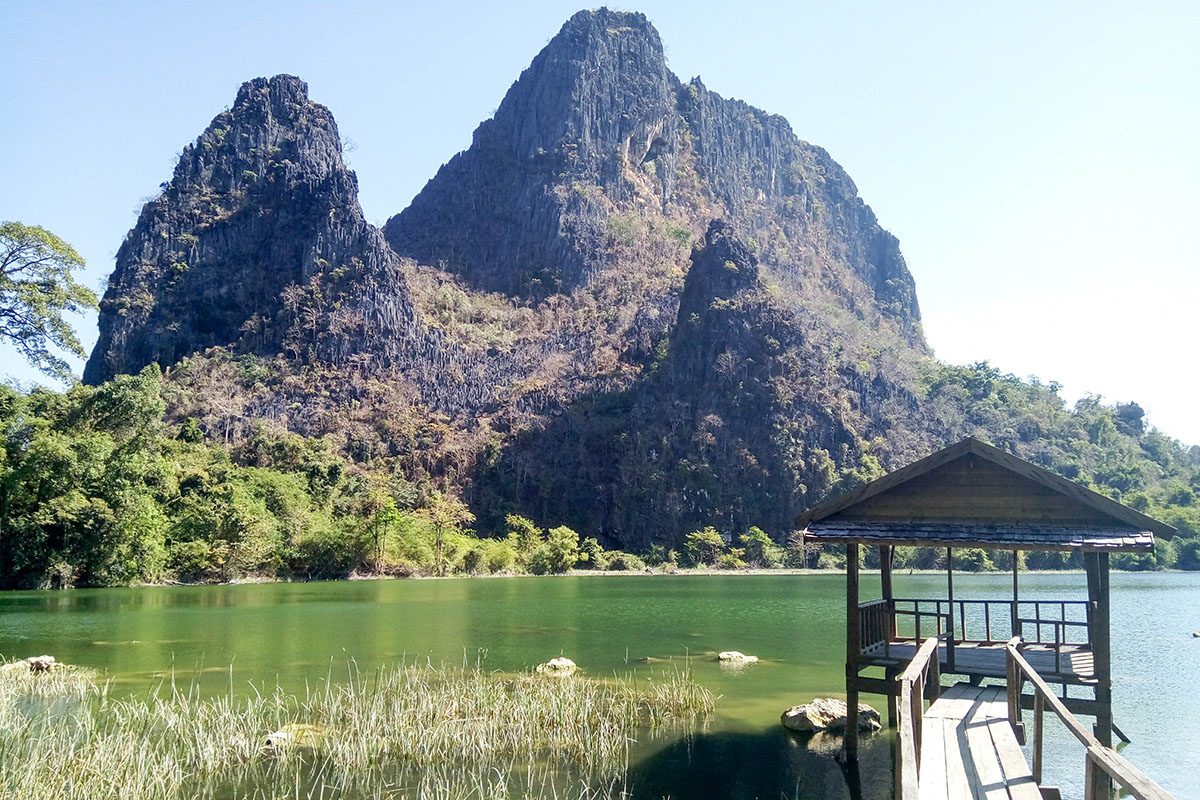
Six hours south of Vientiane, or five hours from Kong Lor on a bumpy songthaew is Thakhek, a small city that’s home to the Thakhek Loop. There isn’t much to do in the city itself, but you could spend your first afternoon there walking along the Mekong, getting a massage and checking out the night market. A great dinner spot is Song Fang Khong (being the adventurous soul I am, I ate here three times in two days while in Thakhek). The next day – if you’re down for it, can ride a bike, or have friends who can ride a bike – take on the loop. This three-day loop is one of South East Asia’s best motorcycle adventures .
Day number one includes the caves in the Thakhek area. If you fancy it, you could do a half day or full day’s climbing at Green Climber’s Home as well. This needs to be booked in advance, and there is accommodation on site but it books up quickly.
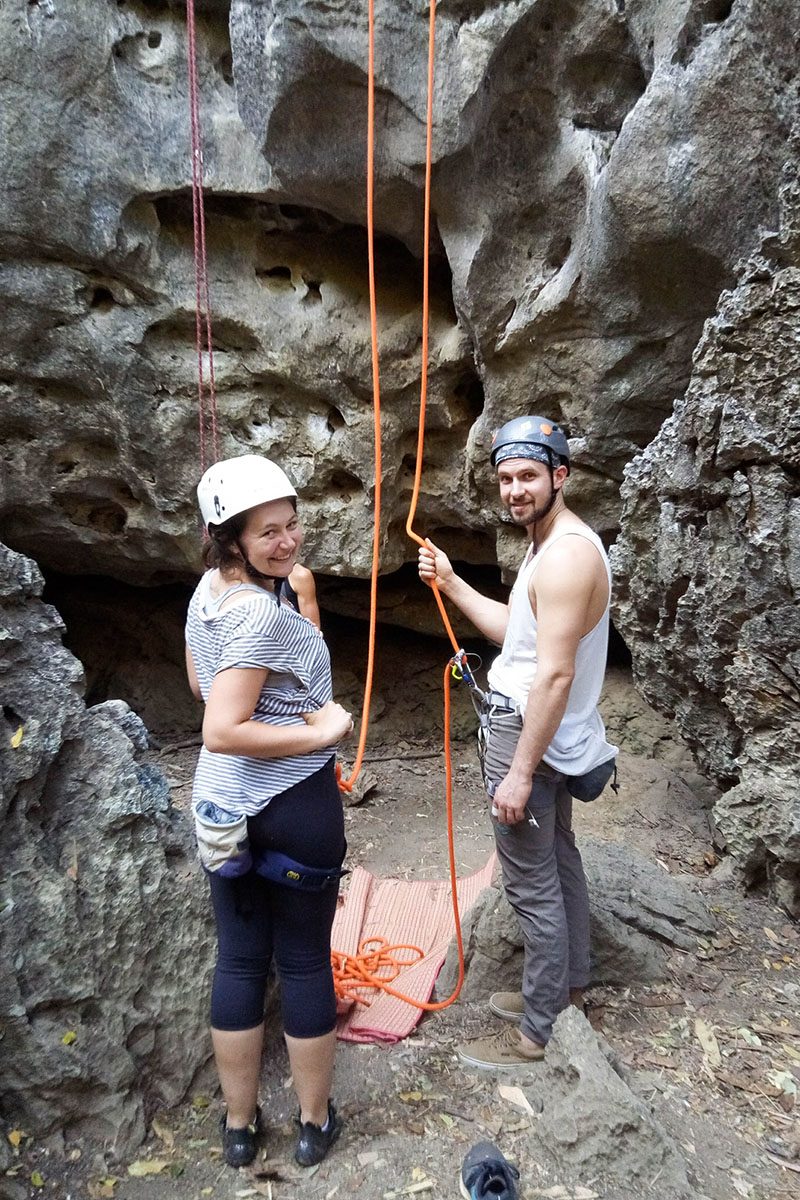
Otherwise, the highlight of the first day is generally Tham Ene Cave. This is a large cavern which offers guided tours. There are plenty of other spots to stop at, photograph and explore, as well.
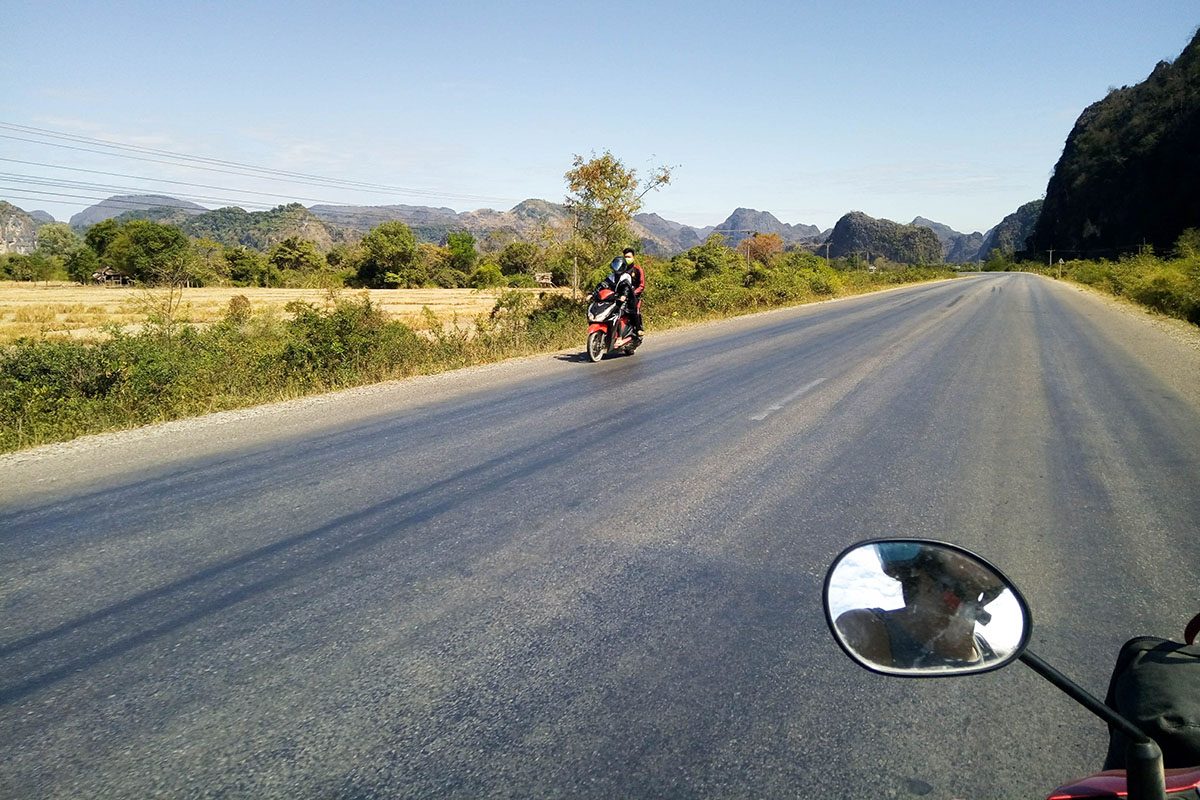
The next day is the drive to Kong Lor, which can be more than hazardous as some of the roads are barely passable! However, there are still more of those absolutely epic views, making it well worth it. Once you arrive at Kong Lor, you’ll get the chance to really embrace the rural surroundings of it. Day three is about exploring Kong Lor Cave (see above) and then heading back to Thakhek!
Where to Stay in Thakhek
Hostel: Bike & Bed is probably the most popular backpacker hangout in Thakhek. It has basic but comfy dorms with spacious, sturdy beds. There are hot showers on the property and the cleanliness standards are impeccable. Bike hire is available from the hostel and free tea, coffee and fruit are provided. Click here for rates and to reserve. Mid-Range Hotel: Set in quiet garden surroundings, Villa Thakhek has air-conditioned rooms with free WiFi. Each room has a private bathroom and tasty food is available on site. Click here for rates and book. Luxury Hotel: Le Bouton D’or Boutique Hotel harks back to colonial days with its period decor. It is located right by the river int he heart of Thakhek, and has a bar and breakfast. Click here for more information and to book. To book a bus from Thakhek to Savannakhet, click here.
Savannakhet – 1 day
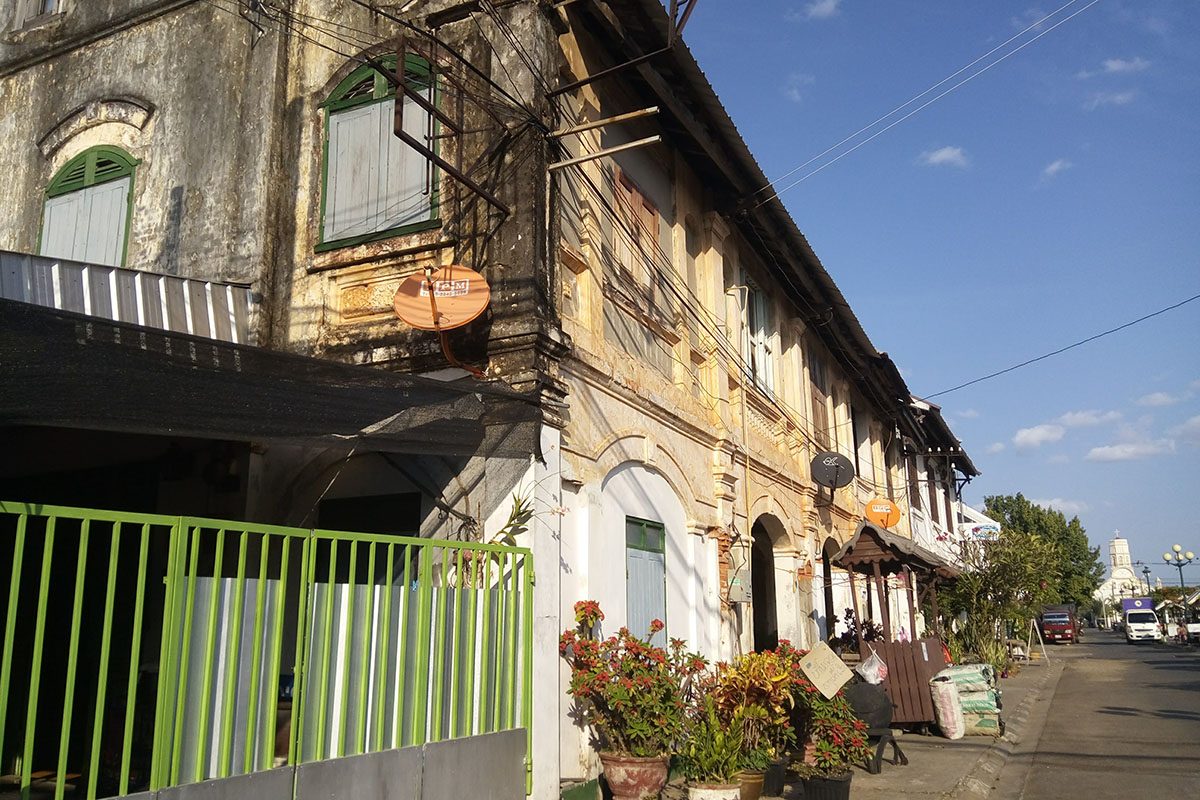
Just three hours south of Thakhek is Savannakhet, a chilled out colonial town that’s the gateway to southern Laos. You only really need one day here – there are a couple of museums, temples, a very good night market with great food and Mekong sunsets. It’s pretty similar to Thakhek in the north, and isn’t an absolute must-do stopover, but it’s quite pleasant nonetheless. Read my blog post about the best things to do in Savannakhet here.
Where to Stay in Savannakhet
Guesthouse: There are no hostels in Savannakhet, but Sala Thongyon Guesthouse is cheap and a lovely quiet place to stay (can you see a trend of all the places I like yet?!). It’s set in a garden atmosphere, contrasting to the city. You can hire a bike from here to explore the surroundings, the WiFi is decent, the rooms are cosy and rustic and have their own shower with hot water. Click here to learn more. Luxury Hotel: Avalon Residence is about as luxury you’re going to get in Savannakhet. It’s a 3* hotel, with modest yet nice rooms with comfy beds, satellite TVs and bathrooms with separate showers. Click here for rates and book today. To book buses from Savannakhet to Pakse, click here.
Pakse – 1 day

Congratulations at making it to Pakse, Laos’ most southern city (and the only place you’ll find an ATM before Siem Reap in Cambodia). The first thing you’ll notice is that Paske is H.O.T – it’s like a furnace. If you take a morning bus from Savannakhet, you’ll reach Pakse by early to midafternoon. This is perfect for a stroll around the city, which is pleasant in its own way but not up to much. The most popular attraction is the Big Buddha, who sits atop the hill and gazes at the city and plateaus. You can rent a bike to drive up there, or take a tuk tuk for about 50,000 kip. It’s got a view over the whole city, and quite a staggering 360 vista as the sun goes down. Laos is home to some incredible sunsets, and Pakse is no exception. Other attractions in Pakse include the Champasak Provincial Museum and various Wats, which you can find while exploring the city centre.
Where to Stay in Pakse
Hostel: Chato Hostel is one of my favourite hostels in South East Asia. It’s got spacious dorms, with thick curtains blocking out light and sturdy beds, kind of ‘pod’ style. Dorms have their own attached bathroom, which has a warm shower. The staff are really friendly and helpful and there is a microwave and fridge that guests can use, as well as food available to be purchased. It’s right in the centre of Pakse. Click here to learn more and to book. Mid-Range Hotel: Intouch Riverside Hotel is a great place to stay if you want a slice of luxury without breaking the bank. The rooms are spacious and have en-suite bathrooms with separate showers. Rooms are clean and there is an open-air swimming pool. Click here to make a reservation. Luxury Hotel: Le Jardin Hotel is perfect for those who want to live in luxury while in Pakse. Decorated with classy red wallpaper and furnishings, and offering a swimming pool and breakfast facilities, this hotel has everything you coul d want in upmarket accommodation. Click here for rates and to book.
Bolevan Plateau – 3-5 days
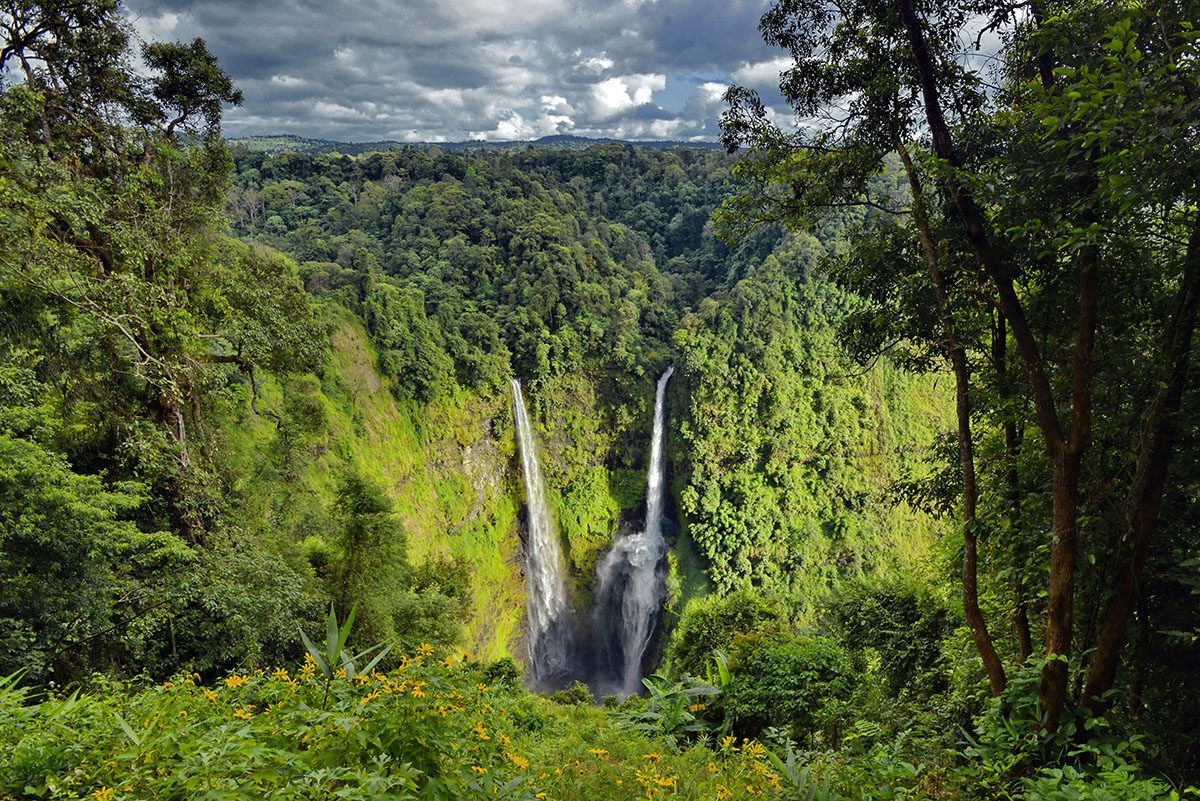
As mentioned before, I cannot ride a scooter and I’m terrified to try. So I didn’t actually do the motorbike loop – although I visited Miss Noy’s, the main scooter rental shop for travelers – and got all the information, just for you guys. I did, however, see the Bolevan Plateau on a guided tour. This included the main waterfalls, coffee plantations, a local homestay with delicious food, a jungle trek, and transfers to and from Pakse. The guide had great English and was very knowledgeable – it was more like hiking with a friend than a guide. You can book a tour here. I also did encounter some people in a tuk tuk going around the main sites of the Bolevan Plateau. I’m really not sure how a tuk tuk got up there, but it may be possible. If you don’t want to pay for a tour and can’t ride a bike, it’s worth an ask I guess?! The motorbike loop, however, remains the most popular way to see the Bolevan Plateau and for good reason; the scenes are incredible, there are local homestays to stay at, there’s plenty of places to stop off and you go completely at your own pace. You can spend anywhere from 2 to 5 days on the loop (there’s a short one and a long one), enjoying waterfalls, hiking, local villages and more. For the best information about the motorbike loop, head to Miss Noy’s who will tell you all you need to know.
Where to Stay on the Bolevan Plateau
Guesthouses on the Boleavan Plateau tend to just take walk ins only, and they will generally have space. If you go to Miss Noy’s presentation, they will give you all the information you need! From the Bolevan Plateau, you will need to return to Champasak to take onward travel. To book a bus from Pakse to Champasak, click here.
Champasak – 1 day
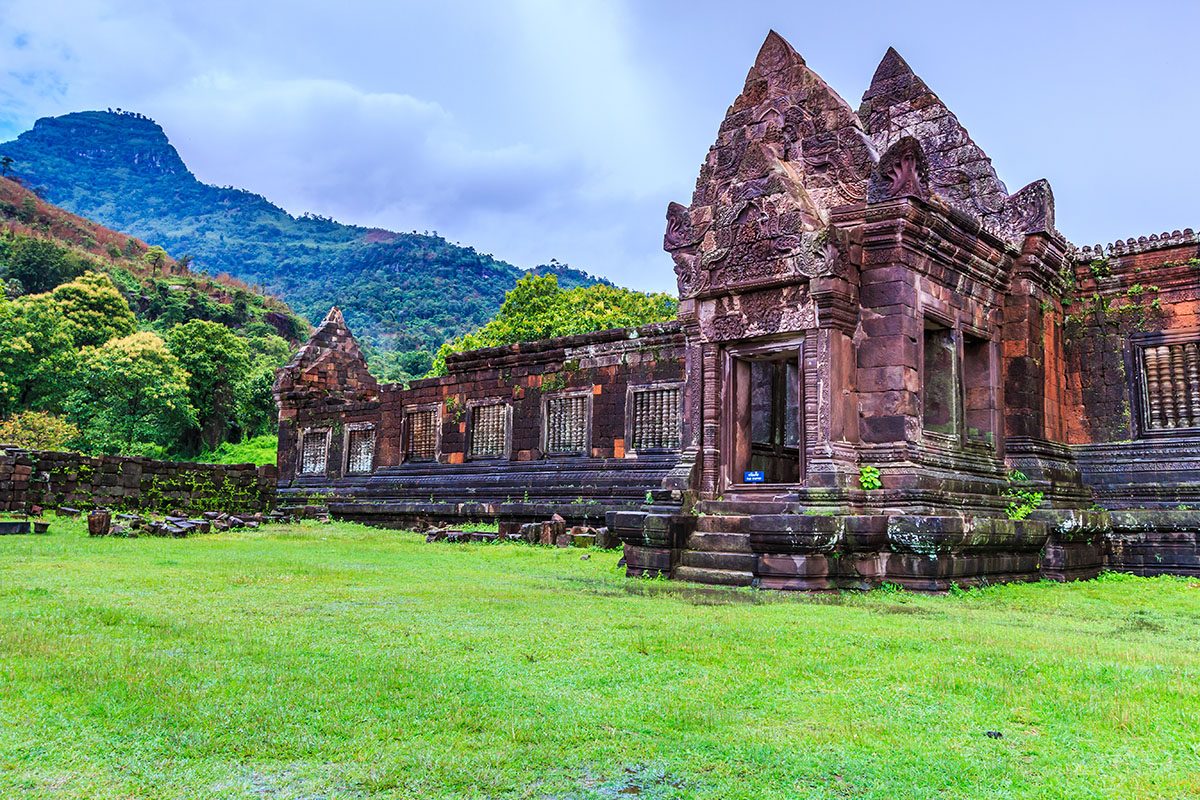
Just an hour or so south of Pakse is the charming town of Champasak. It’s a lot more visually appealing than Pakse, with run down streets, riverside stalls and bicycle trails. Spending a day here will enable you to visit Vat Phu, which is an impressive set of ruins somewhat similar to Angkor Wat (but still well worth seeing if you have already been/ are planning on going to its more famous Cambodian cousins). It is also possible to do Champasak as a day trip from Pakse by renting a bike or taking a tuk tuk. But if you’re heading south anyway, you may as well take the bus and stay there for a night!
Where to Stay in Champasak
Guesthouse: Kamphouy Guesthouse is a quiet, clean and comfortable guesthouse, with an owner who speaks great English and is very helpful about travel around Laos. It is located right next to the bus stop andhas good WiFi. Rooms are basic but adequate for a value stay. Click here for rates and to book. Hotel: Nakorn Riverview has a classy eastern feel, with ornate archtiecture and beautiful decor. It overlooks the beautiful river and has an on-site bar. Rooms enjoy an en-suite with separate shower and comfy beds. Click here for rates and to book. Click here for transport from Champasak to the 4,000 islands
4,000 islands (Si Phan Don) – 3 days
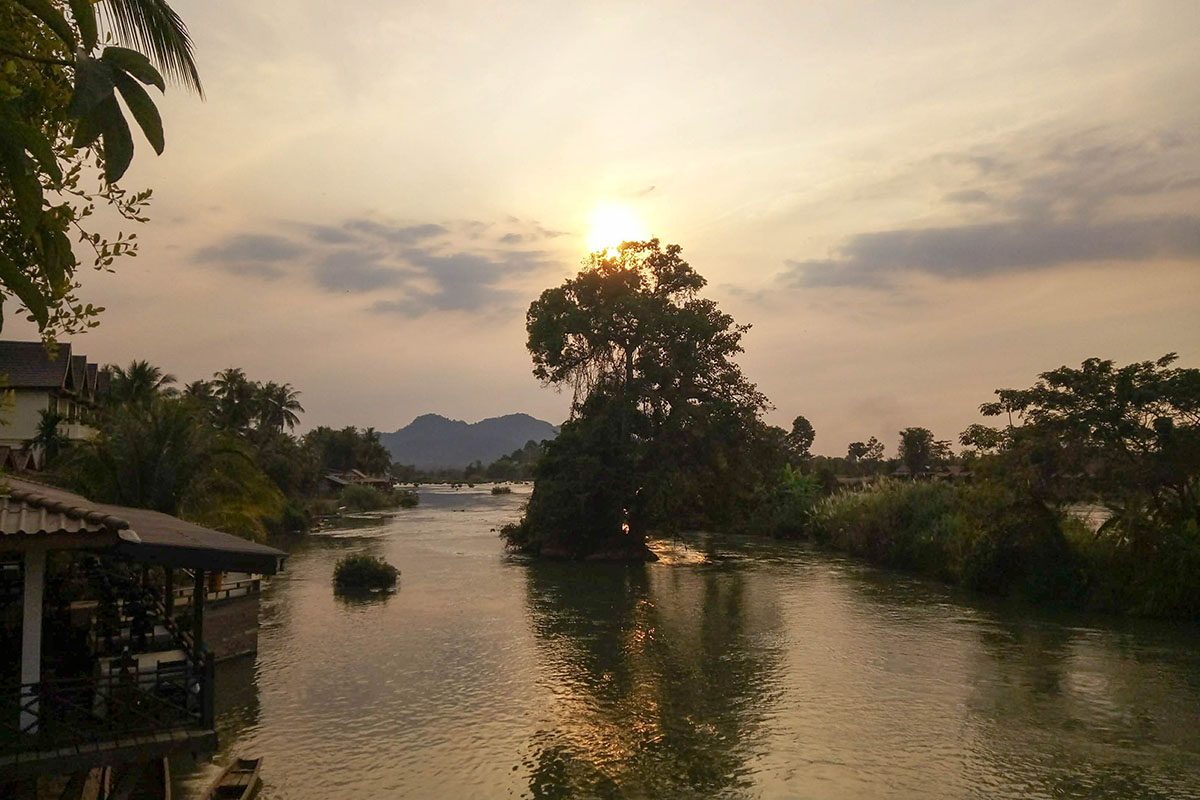
Yep, the landlocked country of Laos has not just one island, but 4,000 (give or take, nobody’s sure of the exact number). Our good friend, the Mekong, delivers again with these chilled out land masses that wouldn’t be out of place in Thailand’s Andaman sea. While there are literally thousands of islands, only three of them are inhabitable; and the huge majority of visitors stick to Don Det. Don Det kind of tries to be a party island, but it doesn’t really work – but it’s still very nice! Don Khon is a lot more local and chilled out. I’d recommend spending two days in the 4,000 islands. Day number one can be spent just cycling around, enjoying the views of the Mekong and taking in local life. There are plenty of great places to eat in Don Det, and quite a few in Don Khon.
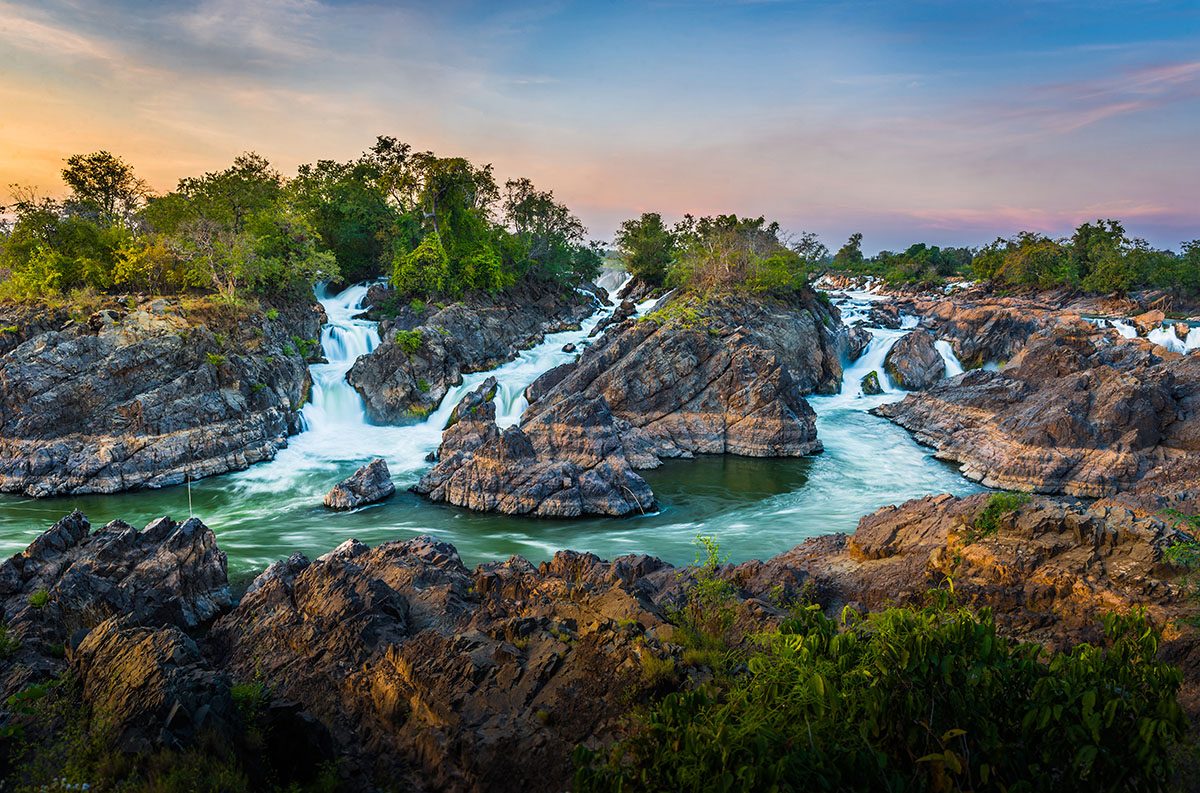
Visit the waterfalls of Don Khon, as well as lookouts on both islands. You can even enjoy the beach and apparently, you can swim in the Mekong – I can’t say I fancied it though.

Day number two should be spent doing a kayaking tour to try and find the endangered Irwaddy River Dolphins. Southern Laos is the only place in the world that you’ll see these creatures; which hopefully you’ll get the chance to! You’ll also head over to the mainland where you can see Khon Phapheng Falls, the largest waterfall in South East Asia.
Where to Stay in Si Phan Don
Hostel: For a budget stay with a difference, The Last Resort offers tipi style acommodation. Tipis are very basic but still very nice, with electricity, a comfy bed and a mosquito net. It’s probably not the place for anyone who doesn’t like bugs, but it’s a great glamping-style experience. Click here to learn more information. Mid-Range Hotel: Champa Mekong Bungalows has a lovely restaurant over the river, where you can enjoy dinner and a gorgeous Don Det sunset. Rooms are basic but comfy, with double beds and private bathrooms. Click here for rates and to reserve. Luxury Hotel: Little Eden Hotel is probably the most luxurious place to stay in Si Phan Don. It has a great swimming pool, which is welcomed in Don Det – it’s hot here – as well as stylish, airy and spacious rooms. Breakfast is included in the room rate. Click here for rates and to book.
Where to go from Si Phan Don
From Don Det, you can book a transfer to Siem Reap, ready for your Cambodia explorations! Or, if you’re just sticking to Laos, you’ll need to head back up to Pakse where you can find onwards travel (it costs $30 to enter Cambodia for any amount of time, so it’s best to get onward transport to Thailand or Vietnam from Pakse if you’re not planning on seeing Cambodia). If you’re searching for a lively hostel in Siem Reap, check out my review of Mad Monkey Siem Reap. Booking onward travel? You can use Bookaway to reserve all your buses in Laos.
What to Pack for Laos
Laos is generally warm all year round, although some places in the mountainous north do have a cold snap in the winter – and in many places, including the northern mountains and the Bolevan Plateau, it can get cold at night. So what should you pack for Laos? Clothing wise, you’ll probably need…
- Hiking boots and gear for the many treks in the country
- Something a little warmer in case you get cold days in the mountains
- A swimsuit for the many waterfalls
- Comfy shoes for walking around the towns
- A rain jacket if you’re visiting during the rainy season
- Long trousers and cover-ups for temples
- A badass style sense like the following fashonista…

And for gear, I’d recommend including…
- A Laos guidebook – this will be very helpful when you’re exploring all the different attractions.
- A travel adaptor – Vietnam uses European-style adaptors. So if you’re coming from anywhere else in the world, you’ll need your own adaptor.
- Suncream – Vietnam can be absolutely roasting, and many suncreams sold here have whitening in them. Plus suncream is one of the only things that’s a lot more expensive in Asia than back home.
- A Water-to-go-Bottle – You can’t drink the tap water in Vietnam – unless you have one of these jazzy gadgets. After flushing the filter initially, you’re good to drink tap water from it for up to 2 months – then you’ll need to change the filter.
- Metal Straws – Vietnam erm, loves plastic. And with its long coastline and the Mekong River, it’s somewhere where a lot less plastic would be very welcomed. Be a sustainable tourist by using metal straws (you can ask for no straw using the phrase ?).
- Power bank – Vietnam’s home to some long bus and train journeys, so you’ll probably want to keep your device charged.
- Camera – you’ll want a good camera for all your Vietnam pictures! I use and recommend the Fujifilm x-a3 –
Being Respectful in Laos
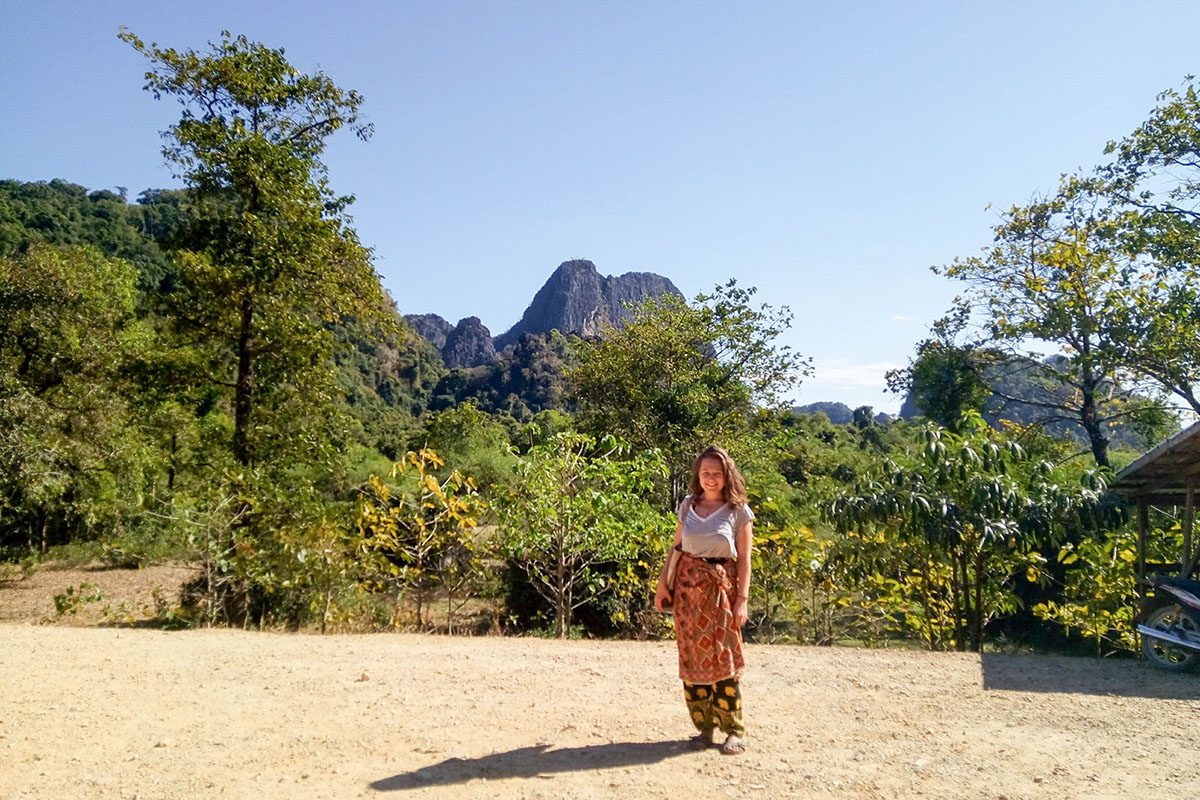
I could probably sit here for a couple of days talking about this, but I’m guessing that you probably have other things to do than read about me ranting about drunk idiots in Vang Vieng . So I’ll keep it fairly short: Laos has been through a lot in the last century. It’s not as commonly known, but the Vietnamese War also took place in Laos. Here, it was called ‘ the Secret War ‘ but for the people of this country, it was anything but secret. So many bombs were dropped on the country that wasn’t even involved in this war, that it has become the most bombed country of all time . The US dropped 270 million bombs on the country during the Vietnamese War.

Many people died during these raids, but over a thrid of bombs didn’t explode. This means that UXOs (unexploded ordanance) litter the Lao countryside to this day. They are still being cleared and people still die from these bombs exploding today. Laos is a developing country, and tourism only became unrestricted there in the 1990s . Nowadays, tourism is one of the most important economies in the country, so if we’re doing it right, us being there can help Laos and its people. Key phrase – if we’re doing it right. I’m not saying don’t go to Vang Vieng, or even don’t go tubing in Vang Vieng. But I’m saying that Vang Vieng’s life as a hedonistic paradise/ hell-hole (depending which way you look at it) wasn’t the kind of tourism that Laos needs. This Guardian article gives a thorough perspective on it from a Lao point of view: how their “traditional way of living has been eaten alive”, how parents would dread that their sons would find “work by the river” and get sucked into the party atmosphere, how Lao people were having to deal with the dead bodies of tourists who took it too far. Vang Vieng is different now, but there is still a lot of emphasis on partying . And being here made me wonder – does this have any benefit on locals? Are any of these businesses locally owned? Is it beneficial for the staff to be working here? One thing I know is that every Lao person I met outside of Vang Vieng seemed much happier than those in Vang Vieng. And don’t get me started on the drugs – they’re illegal in Laos, guys . Like very illegal. Even if you don’t care about taking the risk, should we really be buying drugs off locals who are doing an illegal line of work because of tourist demand?! Or should we be supporting local businesses, helping them grow and employ more locals? You vote with your Laos kip. Please don’t vote to support the drug industry. I’m not saying that you need to be a martyr to travel in Laos, but just do be considerate to Laos’ traditions and way of life. Respect their conservative culture, if you want to drink don’t be that idiot falling around on the street. Try not to get involved in any in-your-face backpacker bar crawls that you can guarantee local people would hate to see, and understand that things aren’t going to be the same as they are at home. Support local businesses, buy fruit from local vendors, stay in homestays. These all give monetary benefit to the people of Laos working in tourism. But more than anything, get to know the people. Lao people are lovely, will want to know all about you and your life, and will be really happy that you’re in their country. Be a tourist that Lao people want to have. Due to language barriers and the fact that a lot of Lao people stilll work in agricultural industries which don’t see many tourists, it can be difficult to interact with locals. But do what you can: stay in homestays, speak to your tour guides as much as possible, spark up conversations with wait staff. Also, try and learn a little about Laos culture and history – including its not so nice past. Having an all round understanding of this country will really help you be a more responsible traveller in Laos.
Useful Lao Phrases
Lao is very different to European languages, and it’s not expected to even know a little when travelling in Laos. But if you learn some basic words and phrases, I can guarantee that the locals be incredibly grateful. It’s also a lifesaver outside of touristy spots where most people don’t speak English! See below for some basic phrases…
Books to Read About Laos

- Culture Shock! Laos: A Survival Guide to Customs and Etiquette is the must read guide to Lao culture, how it differs from its neighbours and how to act around Lao people. It’s essential reading to be that responsible tourist in Laos I was talking about…
- Love Began in Laos is an absolutely heartwarming story of a woman meeting, marrying nad having kids with a Lao man. It really shows how love can blossom literally, anywhere (did I ever mention I am 100% a hopeless romantic and any kind of love story makes me cry?)
- One Foot in Laos by Devla Murphy is a travelogue about her bicycle ride in the country; where she’s pretty disdainful towards Western tourists!
- The Edge of Tomorrow follows Tom Dooley’s humanitarian work in the country in the 1950s – when Laos was still very much a closed-off country and before the Secret War even happened.
- Shooting at the Moon tells the story of the Secret War and how it affected Laos; detailling the story of a Hmong tribe who put up resistance.
Your Perfect Laos Itinerary!
That’s a wrap, and I’ve just succeeded in writing another post that was longer than my dissertation. I hope this is a fantastic resource when planning your Laos itinerary! If you’ve enjoyed this post – you know what to do. Share it far and wide with any other travellers in Laos, and follow me on Instagram and Facebook .
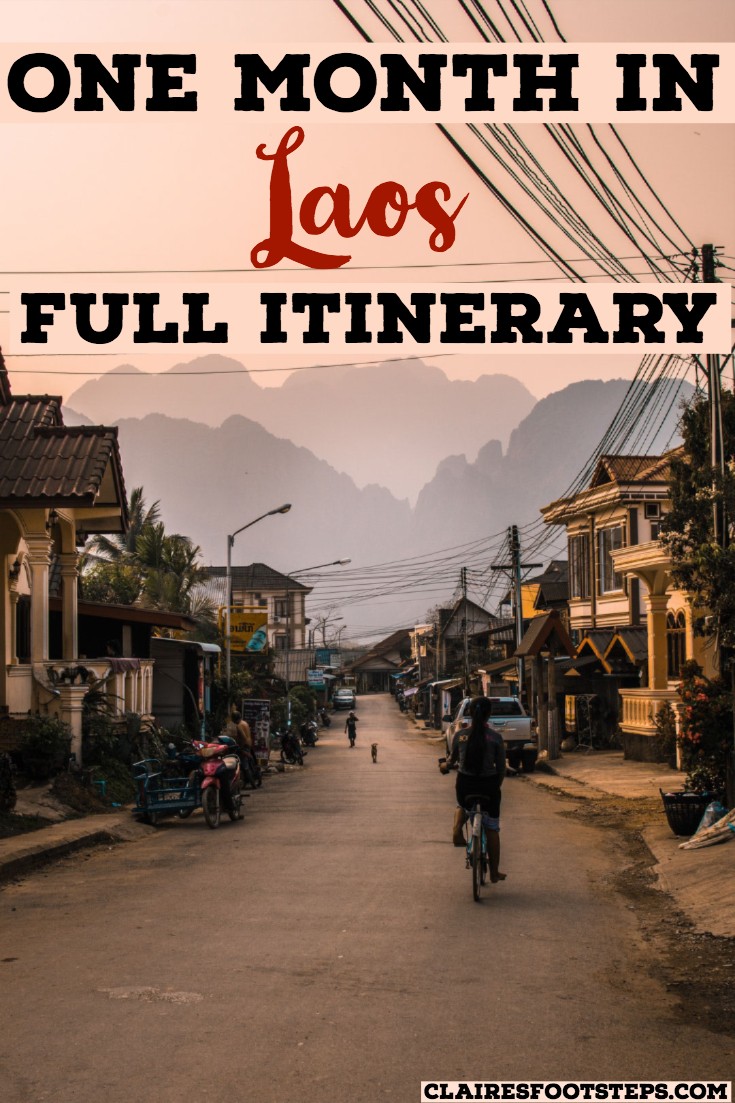
8 thoughts on “ Complete Laos Itinerary for the Whole Country ”
Thank you for all this detailed information. It’s been really helpful. Greetings from Peru
We are starting our 4 weeks laos from tomorrow and your program is sure important template for us. We also love and support ethenic and traditional tourism and feel locals should always love to welcome tourism. Such wonderfully well written blog. Thanks clair
Great post Claire I’m hoping to travel around by bicycle but find it confusing to see if I can rent bikes from Ventiane where I would probably arrive. I see some suggest getting fitted out in Thailand and bringing one’s bike across from there. Do you have any advice on the subject?
Hi Claire! I read your Laos story just before heading here after Thailand. We had already planned a brief route – south from Luang Prabang but I just fancied a read at what other trails people tend to do. (Currently in Vientiane and loving Laos) 🙂 I basically just wanted to say that I, sadly, 110% agree with you about Vang Vieng 🙁 We had done the trekking / caves/ waterfalls already in Luang Prabang and so other than tubing, which we didn’t fancy anyway, there was nothing for us to do. After being so spoilt in LP with all of the lovely food options too, it was such a huge letdown! (We also got funny looks because we didn’t take up drink offers on the street – you’re not the only one who should feel old!) We did have a fantastic Lao meal at the Riverside boutique hotel restaurant which I would definitely recommend to anyone who would rather spend more on food than booze! I enjoyed reading your page anyway, take care and enjoy your future travels! 🙂
Thanks Rachel! Yeah Vang Vieng is pretty nasty, the rest of Laos makes up for it though! Did you go to Nong Khiaw? I loved it there! Safe travels 🙂
Totally agree with JD. We are back to LP again but this time via mekong two day cruise from N. Thailand. Now is probably the time to visit Laos (but easily miss Vientiane ) before tourist explosion. Save Vietnam for seperate visit.
Hi! Great blog and super helpful for a solo traveller! Just to let you/travellers know if you go to the right places you can get a night bus from Pakse to Vientiane for a measly 150,000kip (I bought from Miss Noy bike rentals in Pakse) – not sure if it’s more expensive north to south!
Thanks for the updated information!
Comments are closed.
- New Zealand
- The Philippines
- The Netherlands
- United Kingdom
- Inspiration
- Overland Itineraries
- Packing Lists
- Travel Tips
- Working Abroad
- Accomodation Guides
- Overland Travel
- Preserving Cultures
- Protecting Animals
- Living Abroad
Nomadic Matt's Travel Site
Travel Better, Cheaper, Longer
Laos Travel Guide
Last Updated: September 2, 2023
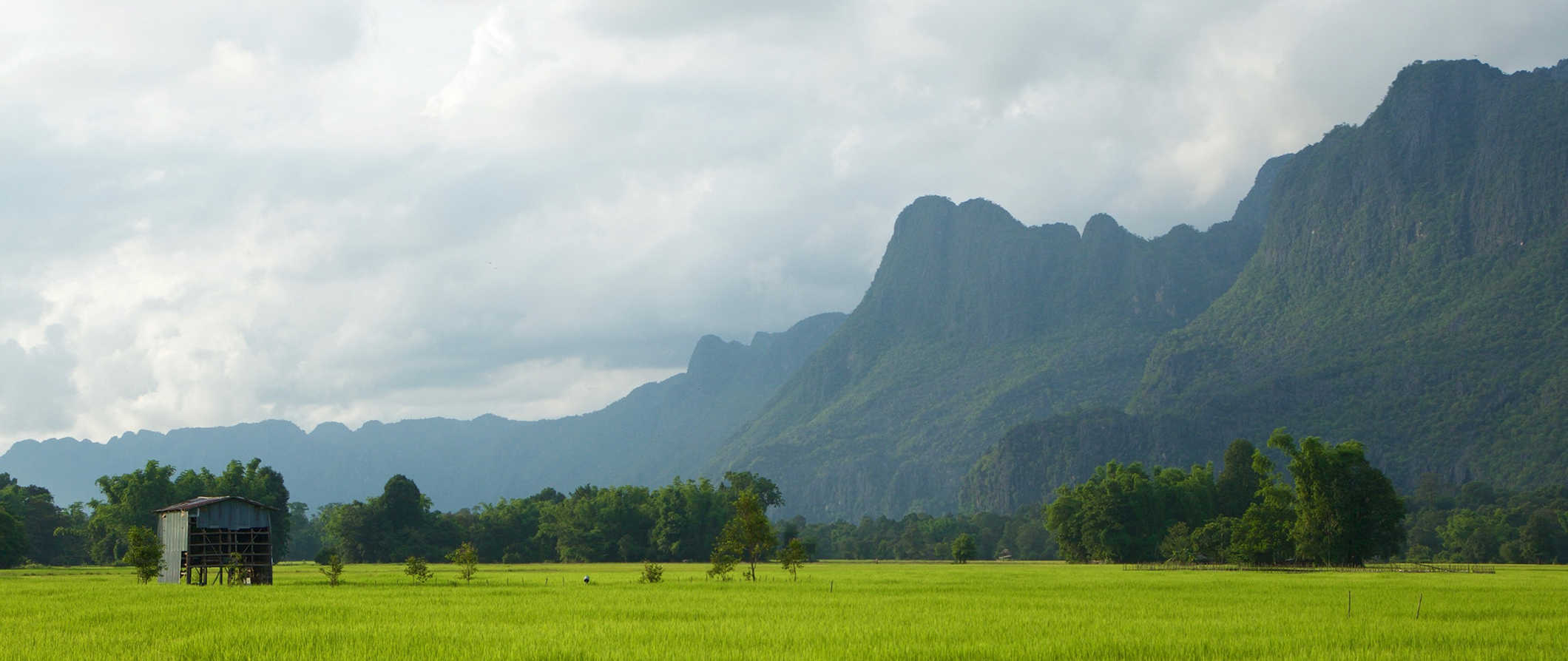
Laos is a landlocked country steeped in nature, food, history, and Buddhism. The country is wrapped in a mountainous landscape, making it one of the most beautiful places in all of Southeast Asia .
While it lacks the beautiful beaches of neighboring countries, adventure travel is big here. You can go zip-lining, kayaking, hiking, and cave tubing all in one day.
I loved my time there and, while the country is no longer a “secret,” it’s still a lot less visited than its neighbors.
From the bustling night markets and stunning waterfalls of Luang Prabang to the epic mountain sunsets in Vang Vieng , I’m always amazed that more people don’t make the journey to this beautiful country.
This travel guide to Laos can help you plan your trip, save money, and make the most of your time in this stunning country.
Table of Contents
- Things to See and Do
- Typical Costs
- Suggested Budget
- Money-Saving Tips
- Where to Stay
- How to Get Around
- How to Stay Safe
- Best Places to Book Your Trip
- Related Blogs on Laos
Click Here for City Guides
Top 5 things to see and do in laos.
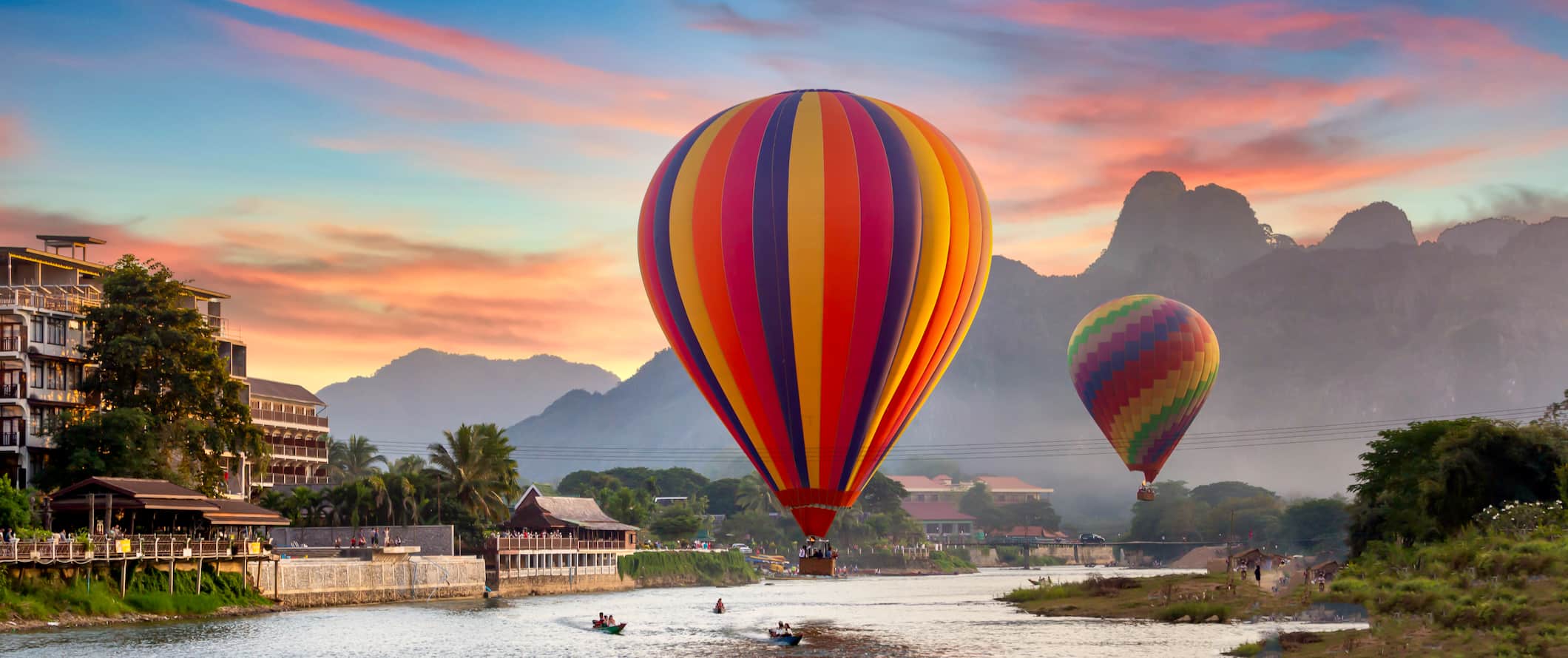
1. Visit Vang Vieng
Backpackers “discovered” this little town in the late 1990s. It didn’t take long to develop into a crazy, hedonistic city. There’s still a party scene but now it’s focused on a handful of bars. It’s definitely not like the old days but I think that’s a good thing. Nowadays, things have calmed down and the center of Vang Vieng is thriving, with boutique hotels and high-end restaurants replacing some of the party-laden backpacker bars that used to pack the waterfront. The town has also become a hub for outdoor adventure, jungle hikes, and lazy days on the river. It’s worth spending a few days here.
2. Explore the 4,000 Islands
Located in Southern Laos, the 4,000 Islands (also known as ‘Si Phan Don’ in Lao) is an area of tiny, largely uninhabited islands in the Mekong River in Champasak Province near the Cambodian border. They are popular with backpackers and the vibe is laid-back and chill. Accommodation is only available on three of the islands: Don Khong, Don Kon, and Don Det. What’s available is cheap and you can spend a few days here reading in hammocks and slowly exploring by bike. Other than that, there’s really not much to do here besides chill in the river and relax at night. To reach the islands you need to take a boat from Pakse.
3. Relax in Luang Prabang
Luang Prabang is a slow-paced city. There is not much to do here other than enjoy epic sunsets over the Mekong River, wander the streets filled with colonial French architecture, spend time at the incredible Kuang Si Waterfalls, and shop at the bustling night market. You can also take a river tour, or explore some of the dozens of temples in town. Every morning at sunrise, the monks walk through the main streets receiving alms from the local residents. I went for two days but actually stayed for a week because I enjoyed it so much!
4. Trek to the Kuang Si Falls
This gorgeous waterfall near Luang Prabang is breathtaking. Turquoise waters flow over rock ledges into dramatic tiered limestone pools perfect for swimming. You can float about in some of these natural infinity pools or jump from trees into others. It’s a really cool place to visit. Admission is 20,000 LAK, and a shared tuk-tuk from Luang Prabang costs 30,000-40,000 LAK per person.
5. See the Plain of Jars
The UNESCO-recognized Plain of Jars has thousands of stone jars scattered around three different sites. Believed to be part of the burial practices from the Iron Age, this is one of the biggest and most important prehistoric sites in Southeast Asia. Legend has it that the jars were made by a race of giants to store alcohol. Take care not to stray too far from the cleared areas as there are still some landmines in the area. There are eight sites open for visiting: sites 1, 2, and 3 are all close to each other at Phonsavan so they are easy to visit together. Admission to Site 1 (with the best-preserved jars) is 15,000 LAK while entry to Sites 2 and 3 is 10,000 LAK.
Other Things to See and Do in Laos
1. explore the vieng xai cave city.
Located close to Sam Nua (near the Vietnamese border), Vieng Xai Cave City served as living quarters for Laotian soldiers during the 1960s. You can see the living quarters as they were; the Kaysone Phomvihane Cave even has a working air-circulation pump. Guided tours are found at the Vieng Xai Caves Visitor Centre. Admission is 60,000 LAK and includes an audio tour. The bus there is 20,000 LAK while a tuk-tuk is 150,000 LAK.
2. Try the Gibbon Experience
This is one of the best activities in Laos. It’s a series of zip lines connecting the world’s highest treehouses in Bokeo Forest, where you can stay for one or two nights. You’re completely off the grid there, surrounded by gibbons, and it has some intense nature hikes. The three-day, two-night “Classic” package costs around 5,600,000 LAK per person.
3. See the Great Stupa (Pha That Luang)
The Great Stupa in Vientiane is a 45-meter (148-foot) gold-covered stupa (a dome-shaped Buddhist shrine). It’s considered the greatest monument in the country. Its exterior looks like a fortress with high walls, but the inside has numerous Buddhist, floral, and animal imagery throughout. You can admire the stupa from outside for free.
4. Head to Vientiane
The capital and largest city in Laos is full of important national monuments and temples, like the Great Stupa and the Sisaket Temple. While there, be sure to check out Buddha Park, a sculpture garden full of giant Buddha statues. It’s the most cosmopolitan city in the country, and there’s an up-and-coming foodie scene there as well. It’s worth spending a few days here exploring.
5. Visit the Elephant Conservation Center
Located in Sainyabuli, the ECC was launched in 2011 by a team of elephant specialists working towards protecting the elephant population in Laos. It’s the best way to see elephants in a responsible way that doesn’t harm them or involve exploitation. You can stay for one, two, or three nights and prices start at 3,800,000 LAK. A 7-day volunteering session costs around 8,500,000 LAK.
6. Take the slow boat on the Mekong
Drift down the Mekong River on a long, narrow boat with comfortable seating, home-cooked meals, and a unique view of the countryside. You can find a ride typically from the border at Huay-Xai that drops you off in Luang Prabang. Slow boats take two to three days. Prices vary depending on the quality of your tour company. There’s also a public boat that leaves daily at 11am.
7. Trek through Phou Hin Poun Conservation Area
Mountains, a limestone forest, rivers full of rapids, and caves await you in the protected Phou Hin Poun area of Laos. The entire area is filled with unique species of flora and fauna, including macaques, tigers, and gibbons. (Yes, tigers.) It’s a stunning area for guided treks, which usually last a couple of days. Your accommodation can help you book a guide on arrival.
8. Get outdoors in Nong Kiew (Muang Ngoi)
Life in this quaint village on the Nam Ou River is slow and peaceful, but Nong Kiew is a popular draw for outdoor lovers. The towering limestone cliffs are ideal for experienced climbers, and there are many hiking trails leading to nearby waterfalls and caves. To get there, take a bus from Luang Prabang to Pak Mong and then a tuk-tuk the rest of the way.
9. Chat with a monk
On the first Sunday of every month, monks gather at the Sangha College in Vientiane to chat with tourists. You’re able to ask them about their practice and daily life, and in return, they can practice their English. It’s a fun and eye-opening way to learn about the culture and the religion from someone whose daily life is much different than yours.
10. Visit the Buddha Caves
The Buddha Caves (Pak Ou Caves) hold over 6,000 Buddha statues that the locals still use for worship. There are standing Buddhas, sitting Buddhas, reclining Buddhas — you name it! To get there you take a scenic 25-kilometer (16-mile) boat trip up the Mekong River or you can take a songthaew (a truck converted into a shared taxi). From there, you’re able to explore the two main caves on foot. It’s about 20,000 LAK to enter the caves, and a shared boat costs 65,000 LAK round-trip (the boat takes two hours there and one hour to get back).
11. Take a Lao cooking class
Take a cooking class to learn how to make traditional dishes like laap (salad with minced meat and spices), orh (spicy stew), and mok pa (steamed fish in banana leaf). Most classes include a visit to the market and include several dishes, ending with everyone feasting on the food they have just cooked. Prices vary but expect to pay between 250,000-400,000 LAK for a class. If you’re in Vientiane, I recommend taking Madam Phasouk’s class. She’s an amazing cook and her private classes are 150,000 LAK, which includes making 3-4 dishes.
For more information on specific destinations in Laos, check out these guides:
- Luang Prabang Travel Guide
- Vang Vieng Travel Guide
- Vientiane Travel Guide
Laos Travel Costs
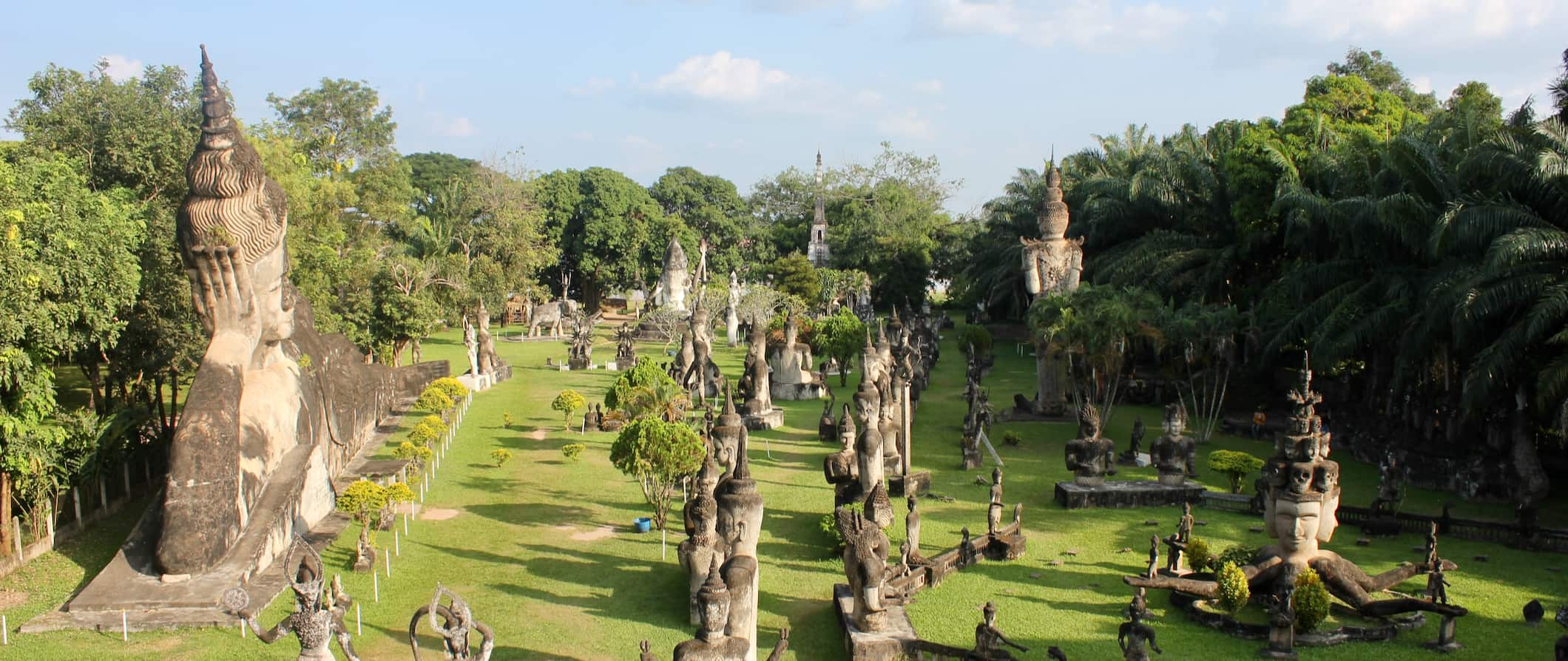
Accommodation – Accommodation in Laos is cheap. Hostel dorm rooms start at around 65,000 LAK per night, although they average closer to 80,000 LAK. Hostels in Vientiane start at slightly higher prices. Private rooms with air-con start at 190,000 LAK but average around 350,000 LAK. Almost every hostel offers free Wi-Fi and most also include free breakfast. It’s very rare for a hostel to have a kitchen, so don’t count on cooking your meals.
Budget hotels and guesthouses are widely available, usually starting around 150,000 LAK for a twin or double room. If you’re looking to splurge on a four-star hotel with a pool, expect to pay at least 400,000 LAK per night.
Airbnb is also available in Laos, with private rooms starting from around 200,000 LAK. An entire home or apartment goes for as little as 500,000 LAK, although prices are generally closer to 1,000,000 LAK. Book early to find the best deals.
Food – Food in Laos has many similarities to its neighbors, with rice and noodle dishes forming the backbone of most meals. Prominent staples include green papaya salad and laap (also known as larb ) (a minced-meat salad that is the national dish, usually featuring fermented fish). Grilled meats, such as chicken, pork, and duck are also very popular, as is feu , the local version of pho.
Most street food and cheap meals of local cuisine cost less than 22,000 LAK, especially in the night market where you can find things like barbecued meats, spicy papaya salad, and noodle soup.
If you want to splash out on a fancy meal, expect to pay around 150,000 LAK for a three-course meal with a drink.
Beer is very cheap here, costing around 14,000 LAK. If you want a latte or cappuccino, expect to pay around 30,000 LAK. Bottled water is around 5,000 LAK.
If you have access to a kitchen, a week’s worth of groceries costs around 250,000-300,000 LAK for basic staples like rice, pasta, produce, and some meat.
Backpacking Laos Suggested Budgets
On a backpacker budget, expect to spend around 300,000 LAK per day. This budget covers staying in a hostel dorm, eating street food, drinking a couple beers, renting a bicycle to get around, and enjoying mostly cheap activities like hiking and swimming. Add another 15,000-30,000 LAK to your daily budget if you plan on drinking more.
On a mid-range budget of 650,000 LAK per day, you can stay in a private hostel dorm or Airbnb, drink more, enjoy lots of street food, take some taxis or tuk-tuks, and do more activities like go rock climbing or ATV riding.
On a “luxury” budget of around 1,800,000 LAK per day, you can stay in a hotel, eat all your meals out anywhere you want, enjoy lots of drinks, hire tuk-tuks or rent a motorbike/scooter, and do whatever activities you want. This is just the ground floor for luxury though. The sky is the limit!
You can use the chart below to get some idea of how much you need to budget daily, depending on your travel style. Keep in mind these are daily averages — some days you’ll spend more, some days you’ll spend less (you might spend less every day). We just want to give you a general idea of how to make your budget. Prices are in LAK.
Laos Travel Guide: Money-Saving Tips
Laos is very affordable so it’s hard to save tons of money if you are already traveling on a budget. Sticking to hostels or inexpensive guest houses, public transportation, and street food will ensure you don’t break the bank. It’s hard to spend a lot when you just do normal travel. That said, here are some ways to save money in Laos:
- Buy from market stalls – Buying your own food is infinitely cheaper than going to restaurants (not that they are even that expensive, however). If you’re on a budget, though, stick to the local markets. Fresh food is the cheapest there.
- Use public transportation – Taxis and tuk-tuks may be convenient, but they slowly ruin your budget. Stick to public transportation if you need to get around. If you do need to take a tuk-tuk or taxi, ask your hotel/hostel staff what you should expect to pay to make sure you don’t get ripped off!
- Avoid western food – Western food is always more expensive than local cuisine. While the prices aren’t that high, it slowly adds up throughout your trip.
- Bring a reusable water bottle – The tap water here isn’t safe to drink. To save money and reduce your plastic use, bring a reusable water bottle with a filter. LifeStraw makes a reusable bottle with a built-in filter so you can be sure your water is always safe and clean.
Where to Stay in Laos
Laos has plenty of budget-friendly hostels around the country. Here are my suggested places to stay:
- Indigo House Hotel (Luang Prabang)
- Nana Backpackers Hostel (Vang Vieng)
- Vang Vieng Freedom Hostel (Vang Vieng)
- Dream Home Hostel (Vientiane)
- Vongkham Eco Village (Vientiane)
- Sanga Hostel (Pakse)
How to Get Around Laos
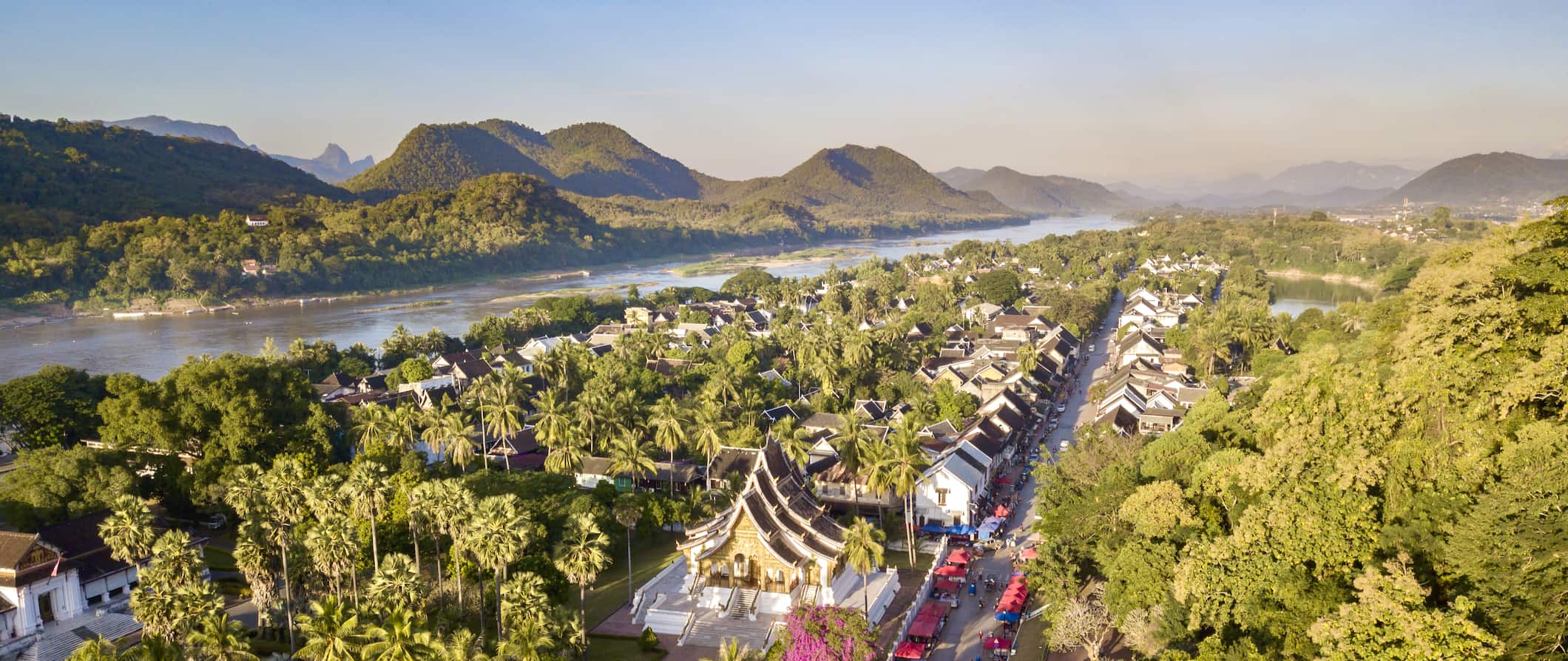
Getting around Laos can be a challenge. The roads are poor, and you have to navigate several mountain passes to get almost anywhere. Nothing is ever on time, and even short trips can turn into endless journeys.
Public transportation – Public transportation is available in some of the larger cities, with prices starting around 5,000 LAK and going up from there based on distance.
Bus – Buses are the most common way to get between cities in Laos. Ticket prices vary between 80,000-130,000 LAK for a 4-6-hour ride. Buses are pretty uncomfortable and many don’t have air conditioning, but they get you from point A to point B around the country without breaking the bank.
In busier towns, you can purchase your ticket from just about any tour operator. This includes transit from your hotel/hostel to the station. Otherwise, you can show up at the city’s bus station. A trip from Vientiane to Luang Prabang or Pakse shouldn’t cost more than 100,000 LAK.
There are also plenty of air-conditioned “VIP” buses. A “VIP” trip from Vientiane to Luang Prabang costs 410,000 LAK. Overnight buses cost 170,000-400,000 LAK depending on the distance. You can usually buy tickets for these buses from your hostel/hotel. You can use 12go.asia to compare prices.
If you’re looking to head into a neighboring country, a bus from Vientiane to Hanoi costs around 500,000 LAK. There is also a direct route between Luang Prabang and Chiang Mai starting from 425,000 LAK, but keep in mind the ride is at least 15 hours. A bus from Vientiane to Bangkok also takes about 15 hours and costs about 425,000 LAK.
Boat – One of the most popular ways to see Laos is via a slow boat between Huay Xai and Luang Prabang on the Mekong River. The journey takes two days. For short trips (like Luang Prabang to the Pak Ou Caves), you can get a river taxi for about 65,000 LAK.
Flying – I don’t recommend flying unless you are super pressed for time. Domestic flights are costly, and there are frequent cancellations. Even booking far in advance, a flight from Vientiane to Luang Prabang costs upwards of 500,000 LAK for a 50-minute flight. But if you must, these are Laos’ airlines:
- Laos Airlines
Car rental – Car rentals in Laos aren’t super affordable, costing around 750,000 LAK per day for a multi-day trip. Renters need to be at least 23 and have an International Driving Permit (IDP).
For the best car rental prices, use Discover Cars .
When to Go to Laos
October to April is the best time to visit Laos. This is when the country’s weather is consistently warm and dry. (Keep in mind the mountainous areas experience much cooler temperatures year-round compared to the other parts of Laos.) It’s also the high season, so you can expect bigger crowds and inflated prices. That said, the crowds here are much smaller than in neighboring Thailand and Vietnam.
Elsewhere, April and May tend to be the hottest months, with temperatures as high as 40°C (104°F). The humidity can be extremely uncomfortable during this time too.
The rainy season lasts from late May to October. It’s still a pleasant time to visit as rainfall each day never lasts long. During this time, the waterfalls flow heavier and wildlife becomes more active. There are also fewer tourists around during this time as well.
How to Stay Safe in Laos
Laos is a very safe country to backpack and travel around as violent crime against travelers is rare. Pickpocketing is your biggest concern. It often occurs in busy market areas (especially in Vang Vieng) and on transportation. Keep your valuables close and out of reach at all times just to be safe.
If you’re worried about getting ripped off, you can read about common travel scams to avoid here.
If you’re hiking or sightseeing, always stay on the marked trail. Some places are strictly prohibited because of unexploded landmines. This is especially true around the Plain of Jars. You shouldn’t have a reason to wander off into a dangerous area but pay attention to signs and markers.
When people get into trouble here, it’s mostly because they’re tangled up with drugs or the sex industry. Laos is strict about punishment when it comes to these offenses, so avoid them at all costs!
Solo female travelers should generally feel safe here, however, the standard precautions apply (never leave your drink unattended at the bar, never walk home alone intoxicated, etc.).
If you experience an emergency, dial 191 to contact the police.
When in doubt, always trust your instincts. If a taxi driver seems shady, get out. If your hotel or accommodation is seedier than you thought, go somewhere else. Make copies of your personal documents, including your passport and ID, in case of an emergency.
The most important piece of safety advice I can offer is to purchase good travel insurance. Travel insurance protects you against illness, injury, theft, and cancellations. It’s comprehensive protection in case anything goes wrong. I never go on a trip without it as I’ve had to use it many times in the past. You can use the widget below to find the policy right for you:
Laos Travel Guide: The Best Booking Resources
These are my favorite companies to use when I travel. They consistently have the best deals, offer world-class customer service and great value, and overall, are better than their competitors. They are the companies I use the most and are always the starting point in my search for travel deals.
- Skyscanner – Skyscanner is my favorite flight search engine. They search small websites and budget airlines that larger search sites tend to miss. They are hands down the number one place to start.
- Hostelworld – This is the best hostel accommodation site out there with the largest inventory, best search interface, and widest availability.
- Agoda – Other than Hostelworld, Agoda is the best hotel accommodation site for Asia.
- Booking.com – The best all around booking site that constantly provides the cheapest and lowest rates. They have the widest selection of budget accommodation. In all my tests, they’ve always had the cheapest rates out of all the booking websites.
- Get Your Guide – Get Your Guide is a huge online marketplace for tours and excursions. They have tons of tour options available in cities all around the world, including everything from cooking classes, walking tours, street art lessons, and more!
- SafetyWing – Safety Wing offers convenient and affordable plans tailored to digital nomads and long-term travelers. They have cheap monthly plans, great customer service, and an easy-to-use claims process that makes it perfect for those on the road.
- LifeStraw – My go-to company for reusable water bottles with built-in filters so you can ensure your drinking water is always clean and safe.
- Unbound Merino – They make lightweight, durable, easy-to-clean travel clothing.
Laos Travel Guide: Related Articles
Want more info? Check out all the articles I’ve written on Laos travel and continue planning your trip:

Is Southeast Asia Safe for Travelers?
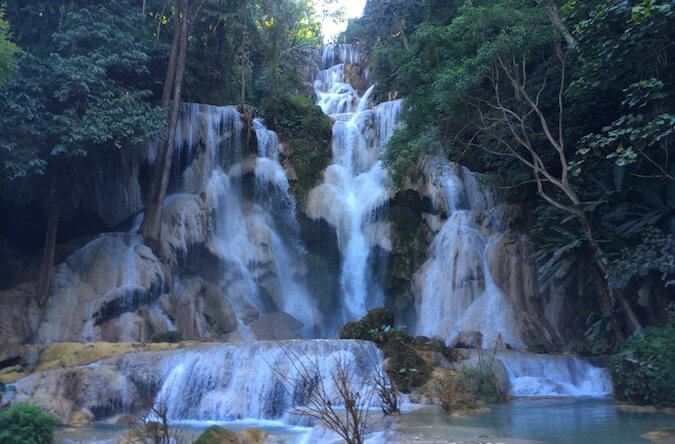
The Secret Pool of Kuang Si Waterfall
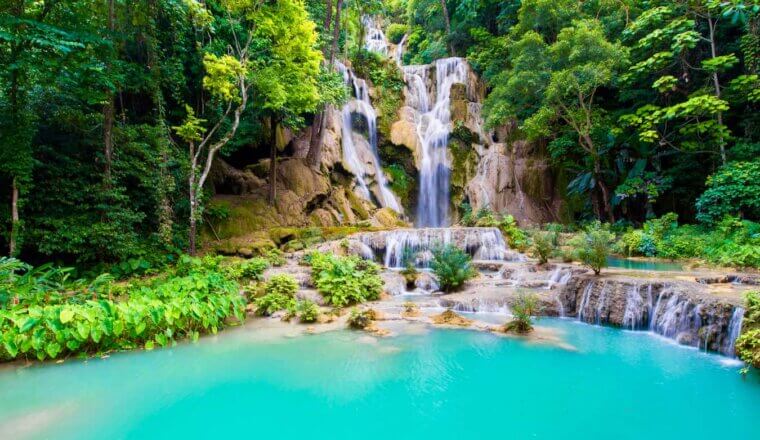
The Cost of Traveling Laos
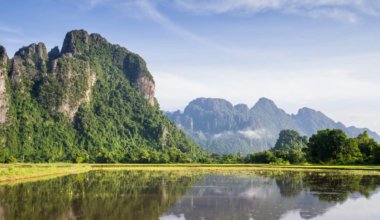
Vang Vieng: A Hedonistic Backpacker Town Reborn
Get my best stuff sent straight to you, pin it on pinterest.
- Where To Stay
- Transportation
- Booking Resources
- Related Blogs

Touropia Travel Experts
Discover the World
10 Best Places to Visit in Laos

Laos is a tranquil landlocked country in Southeast Asia. Often overshadowed by its neighboring countries – Thailand, Vietnam and Cambodia – for their more famous attractions, Laos has plenty to offer, with the benefit of fewer crowds.
This small Southeast Asian country is an affordable and exciting destination to visit. Explore the wild side of Laos with its lush undulating mountains, meandering rivers, and remote Laotian villages. Trek to isolated hill tribes, swim in fast-flowing waterfalls, and creep through underground caves – Laos is nothing if not an adventure!
10. Bokeo Nature Reserve [SEE MAP]
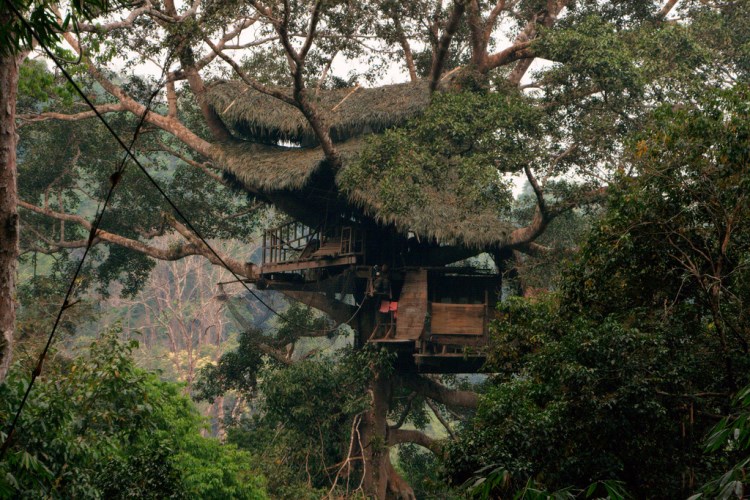
The Bokeo Nature Reserve was created to protect its population of the black-cheeked gibbon, rediscovered in 1997, which was previously thought to be extinct. A visit to Bokeo Nature Reserve is not complete without a stay at the Gibbon Experience, an eco tourism conservation project. Guests stay in tree houses and travel by zip line through the forests in search of the Black Gibbon.
Besides the elusive black gibbon, visitors to the reserve may also see elephants, bears, tigers and wild buffalo. The Gibbon Experience also works to rehabilitate and return to the wild animals that were captured by poachers. With mountains ranging from 1,600 to almost 5,000 feet in altitude, the reserve also is a good place to watch birds.
9. Nong Kiau [SEE MAP]
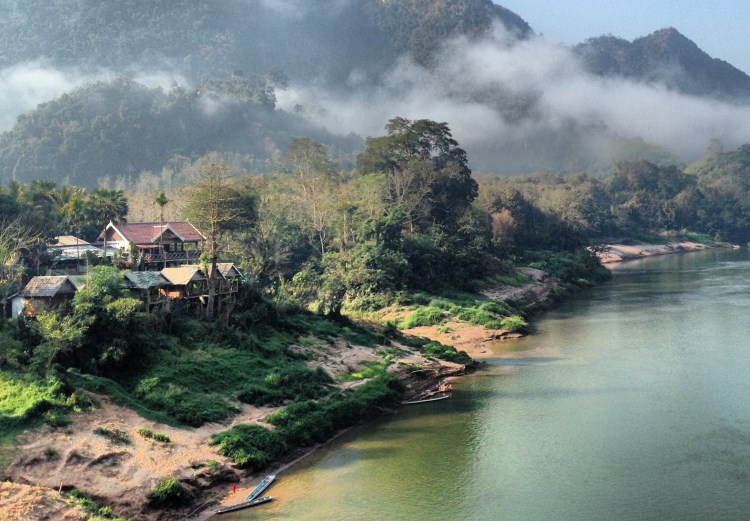
Nong Kiau, sometimes called Nong Khiaw, is a popular tourist destination in Luang Prabang Province because of its many walking, mountain climbing and biking opportunities. A must-see site is the bridge across the Nam Ou River that was built by China. The bridge connects the two parts of Nong Kiau, and is a good place to see stunning views of the river and mountains. Nong Kiau is a rustic village, so visitors shouldn’t expect truly luxurious accommodations. Spelunkers may enjoy exploring the Pha Tok Caves that are located about a mile from town. The caves housed villagers during the Second Indochina War.
8. Tham Kong Lo [SEE MAP]
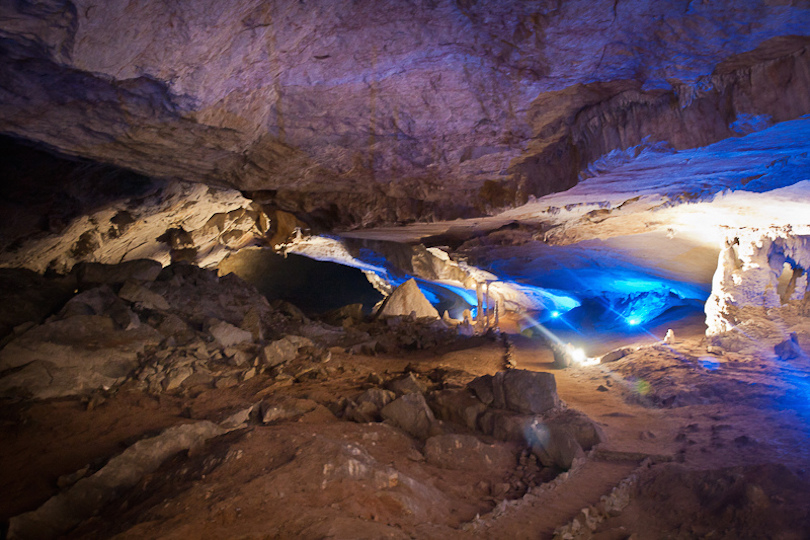
Tham Kong Lo is an incredible underground karst limestone cave tucked away inside Phou Hin Bun National Park in Central Laos. Also known as Konglor Cave – which means ‘beauty in the dark’ – the cave is accessible only by longtail boat. You can chug along one of the longest river cave systems in the world with your way illuminated by magical miner’s lamps.
The boats will stop at certain points, where you will be able to explore the cave more thoroughly on foot. Recently added colorful lights create a charming and theatrical light show to what was once a pitch-dark caving adventure.
Tham Kong Lo is not the most easily reached destination in the country: it’s an eight-hour bus ride on a pothole-ridden road from Vientiane. Yet visitors still travel from far and wide to witness its secret caverns, mysterious stalactites, and otherworldly limestone formations.
7. Luang Namtha [SEE MAP]
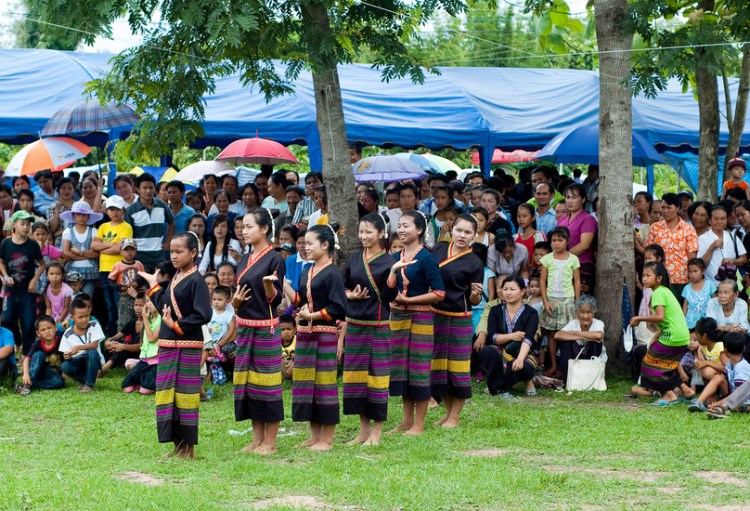
Luang Namtha, which means ‘the area around the Tha River,’ is the largest city in the Luang Nam Tha Province of Northern Laos. Located along the riverbanks of the Nam Tha, one of the dozen tributaries on the Mekong River, the town functions mainly as a stopover on the backpacker route between China and Laos – or as a way to break up the longboat journey between Huay Xai and Luang Prabang.
What makes a visit to this village so special is its easy access to the traditional hill tribes of Laos located in the Luang NamTha National Protected Area. There isn’t a whole lot to see in Luang Namtha itself, but it’s home to the Luang Namtha Museum – an anthropological museum where you can learn more about these fascinating local tribes. The little town is split into old and new; the former having been bombed during the 1970s war makes for an interesting discovery.
NPA trekking trips are common, and you can usually shop around in the village to find a good deal. Many include extra add-ons such as visits to waterfalls, mountain biking, and kayaking. For those who prefer to explore on their own, there are mountain bikes and motorbikes for hire so you can explore the surrounding jungle and villages at your own pace.
6. Wat Phu [SEE MAP]
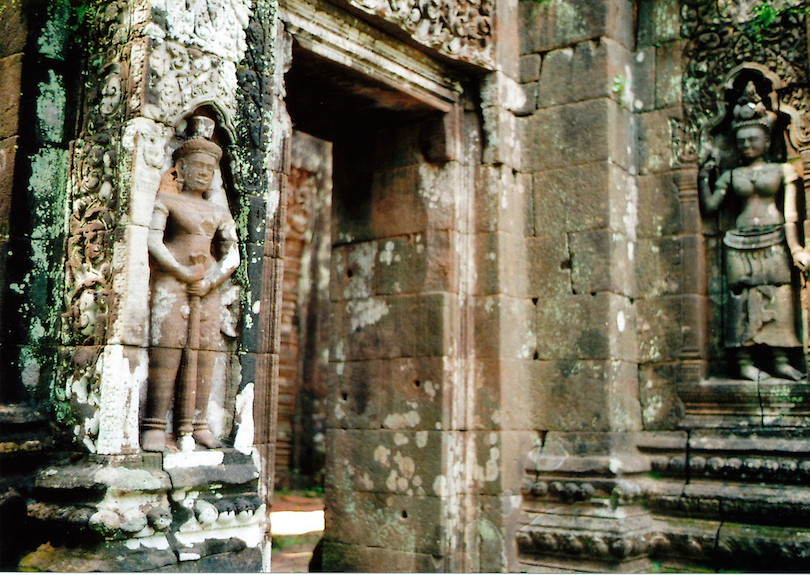
Wat Phu Champasak, also known as Vat Phou Champasak, is an ancient Khmer Hindu temple complex spread across six terraces and three levels. Located at the base of Mount Phou Khao, Wat Phu – which means ‘Mountain Temple’ – has buildings that are well over a thousand years old.
Over the years, many more structures were erected. It’s these more modern ruins from the 11th to the 13th centuries that can be seen at Wat Phu Champasak today. The highlight of the city is Wat Phou itself, an ancient shrine dedicated to Lord Shiva, one of the Gods of the Hindu Trimurti. It boasts intricate carvings, a sacred spring, and a set of beautiful Buddha images. The sanctuary was converted into a Buddhist monastery in the 13th-century – which it still functions as today.
If you’d like to stay longer and explore the surrounding landscape in Champasak, you can stay in the nearby cluster of villages with their French colonial mansions and Buddhist temples. Don’t miss one of the evening shadow puppet theater shows.
5. Si Phan Don [SEE MAP]
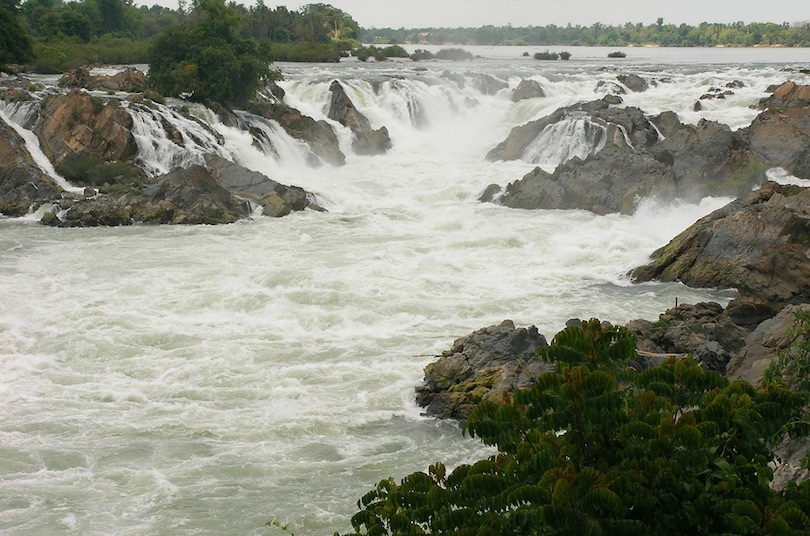
Si Phan Don, which means ‘Four Thousand Islands,’ is a series of different-sized islands dotted along the Mekong River in Southern Laos’ Khong District. The main island of Don Khong (the largest island) has a few temples and a museum, but there isn’t a whole lot to do on the islands, especially when half of them are underwater after the annual Mekong flooding.
But with their backdrop of rice fields, waterfalls, and farmland scattered with riverside huts, that’s all part of the charm of Si Phan Don. Sitting on the border with Cambodia, Si Phan Don’s culture has a mixture of Laotian and Cambodian charm. Spend your days spotting freshwater Irrawaddy dolphins off the coast of Don Khong and photographing the remains of Laos’ first railway, the Don Khon narrow gauge railway built by the French as a way to get around the massive Khone Phapheng Falls.
For those who can’t enjoy the slow life of this river archipelago, there are some activities to keep busy. Rent a bike and explore the two main islands – Don Det and Don Khon, where you can explore one of the big Mekong Falls on two wheels, by boat, or on foot.
4. Phonsavan [SEE MAP]
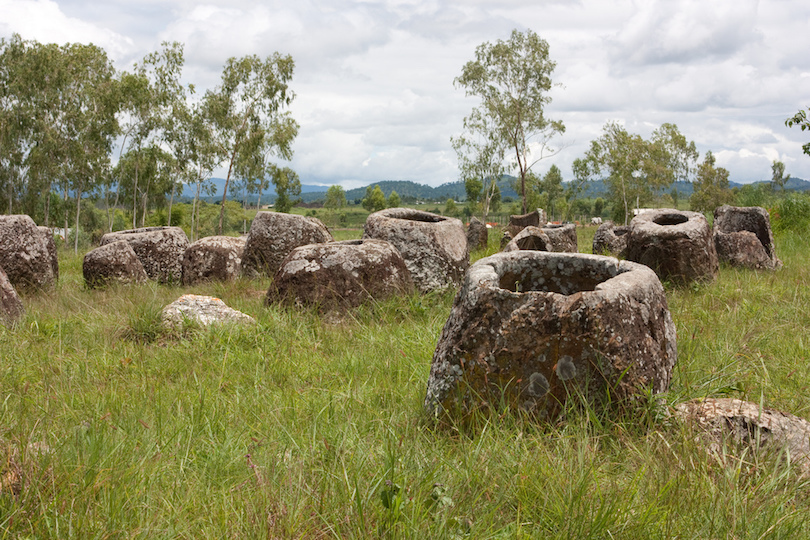
Phonsavan is the provincial capital of the Xieng Khouang Province in Central Laos, and the gateway to the Plain of Jars. Built in the 1970s to replace the old town that was destroyed during the Second Indochina War, the town is characterized by brightly colored wooden houses and cattle fields tended by Hmong cowboys.
Surrounded by undulating hills and pine forests, the scenic town of Phonsavan (which aptly means ‘Hills of Paradise’) has a great climate all year-round. The main attraction is the megalithic archaeological landscape in Laos that’s made up of thousands of stone, jar-like structures dotted about the valleys. Believed to have been used as graves or to store rice wine, the remains of these mysterious stone jars are one of the most famous prehistoric sites in Southeast Asia.
But there is so much more to Phonsavan than the Plain of Jars, especially if you love the outdoors. The outskirts of the town also offer some immense scenery to be discovered on a trekking adventure – from cascading waterfalls to secret caves and secluded pools.
3. Vang Vieng [SEE MAP]
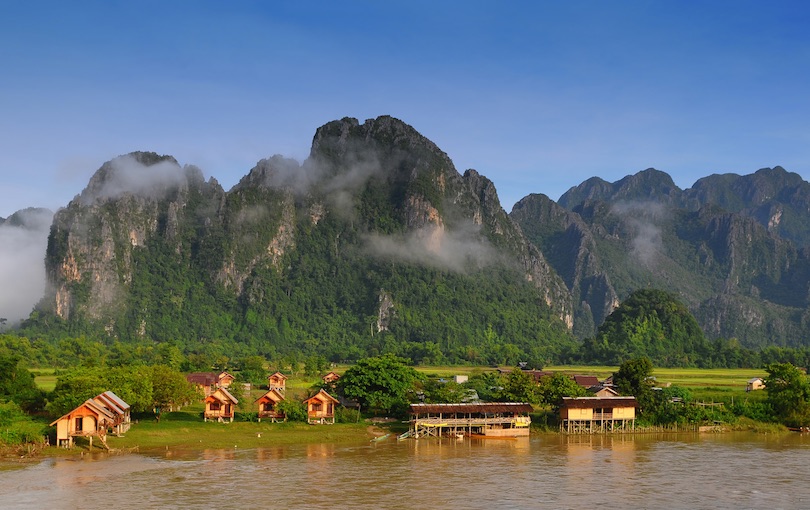
The reputation of riverside Vang Vieng precedes it. Surrounded by wild fields in Central Laos, Vang Vieng is a small tourist town popular with party-seeking young backpackers.
The town is home to all sorts of accommodation, from hostels to guest houses, as well as plenty of bars and restaurants that are open until late during the main tourist season. There are so many day trips to enjoy from Vang Vieng that can be booked at any of the travel kiosks in town, such as the trip to the aptly-named Blue Lagoon.
One of the most popular things to do in Vang Vieng is the infamous river tubing, where you can float down the river, stopping at various riverside bars along the way. Having met with disaster over the years (as you can imagine with young people swimming and drinking), the tubing bars have been restricted to just a few that are closely monitored by Laos standards.
When you’ve spent a sociable day floating and drinking down Vang Vieng’s scenic river, the limestone karst-filled mountains that surround the town are an amazing location for trekking and rock climbing, so come prepared for adventure!
2. Vientiane [SEE MAP]
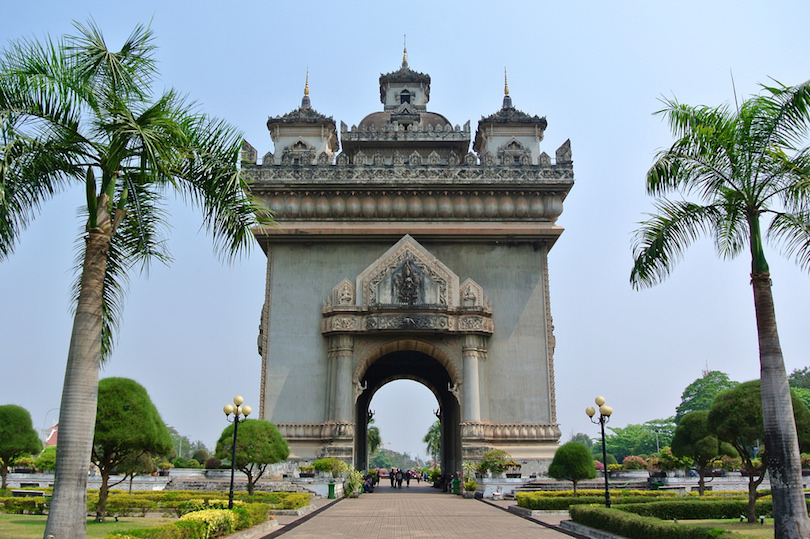
As Vientiane is the capital and largest city in Laos, it’s worth a visit. But you don’t need much more than a few days to enjoy all there is to do in this relatively small town.
Once a French trading post, Vientiane is usually used simply as a stopping point for those flying in or out of the international airport. There are several temples to explore, but the best way to experience Vientiane is with a stroll along the Mekong River at sunset, browsing one of the riverside markets along the way.
The most popular tourist attraction in this city , also known as “the city of sandalwood,” is a Buddhist stupa, Pha That Luang, which dates back to 1586. The stupa stands 49 meters (147 feet) tall and is believed to contain relics of Buddha. Wat Si Muang, another popular site, is built on the ruins of a Khmer Hindu shrine.
1. Luang Prabang [SEE MAP]
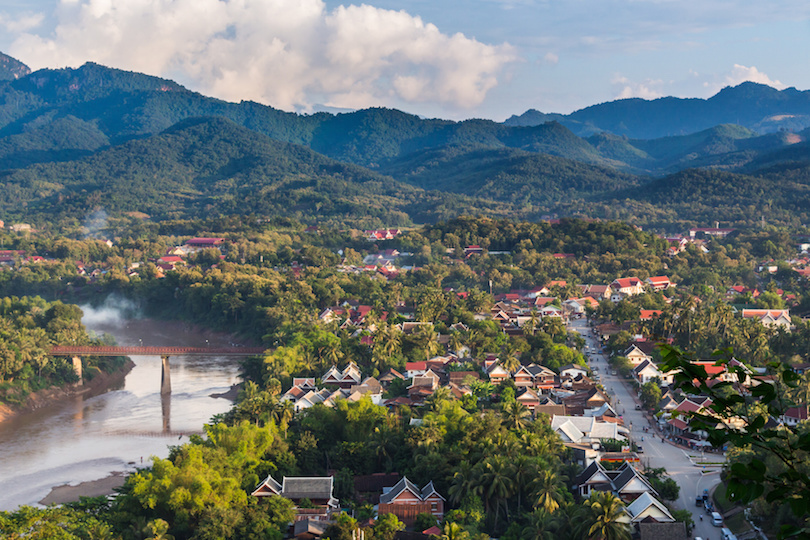
The most popular place to visit in Laos, Luang Prabang is an historic city that once served as the capital of the Kingdom of Laos. Today, it remains the unofficial tourist capital. Set at the point where the Mekong and Nam Khan rivers meet, Luang Prabang stands in front of a backdrop of a magnificent hilltop temple. All things considered, it’s probably one of the most picturesque cities in Southeast Asia. Small it may be, but Luang Prabang is packed with things to see and do .
While in Luang Prabang, you will want to wake up early to witness the daily tak bat, where hundreds of the community’s monks, clad in saffron robes, silently walk through the streets to gather alms. Explore the beautiful Pha Tad Ke Botanical Garden, home to more than 2,000 species of plants, and take your time bartering for souvenirs and rice wine at the local street market.
Luang Prabang is a great base for exploring some of Laos’ most famous attractions on a day trip. The most popular of these is a visit to the glorious Kuang Si Falls, a multi-level waterfall with multiple fast-flowing pools you can swim in – if you dare.
Map of Laos
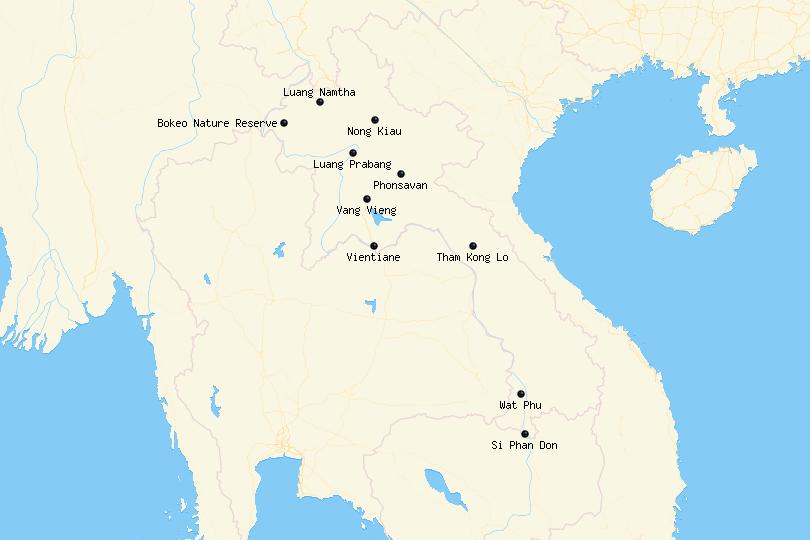
Share this post:
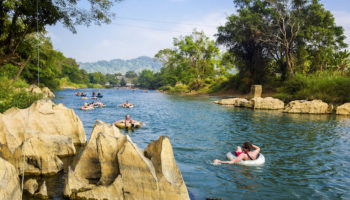
15 Top Attractions & Things to Do in Laos
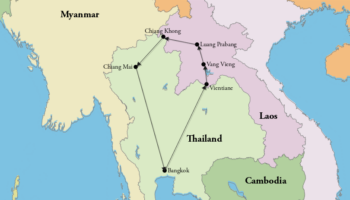
How to Travel from Northern Thailand to Laos
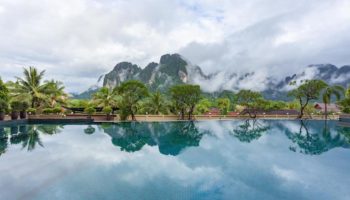
Where to Stay in Vang Vieng: 8 Amazing Hotels
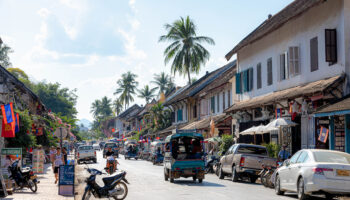
17 Top Attractions & Things to do in Luang Prabang
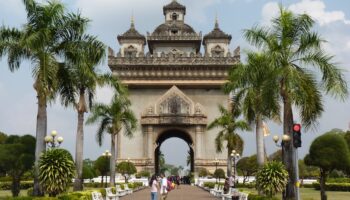
12 Best Things to do in Vientiane, Laos
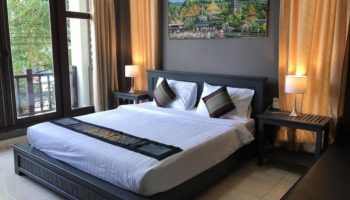
Where Stay in Vientiane: 8 Amazing Hotels
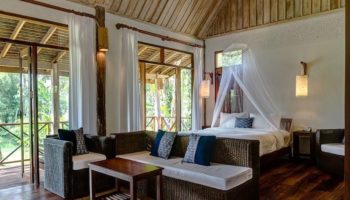
Where to Stay in Luang Prabang: 8 Amazing Hotels
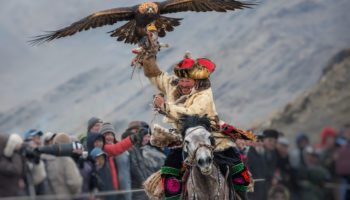
15 Best Things to Do in Mongolia

10 Best Seychelles Luxury Resorts
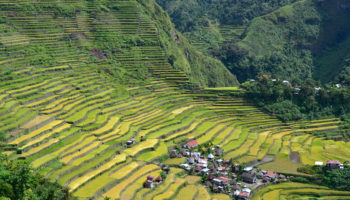
29 Best Places to Visit in Southeast Asia
Reader interactions.
October 9, 2016 at 7:52 am
it’s a great places, northern Laos will become my next destination
June 3, 2015 at 12:45 am
this is such a great list! i’m heading to Laos tonight for the next few days (or weeks…) and am so glad I found this article to help plan my trip! many thanks!
Leave a Reply Cancel reply
Your email address will not be published. Required fields are marked *
This site uses Akismet to reduce spam. Learn how your comment data is processed .

9 Little-Known Things to See and Do in Laos
- February 27, 2021
- Last updated: April 3, 2021
- Adventure , Asia , Destinations , Laos
Home » Travel Blog » 9 Little-Known Things to See and Do in Laos
Planning to visit Laos? Read on our tips on little-known things to see and do in Laos so you can get the best of your trip there.
Many travelers to Southeast Asia pass through Laos, but most cases are simply for a short visa renewal trip. You can find out more about the Laos visa with a service like Byevisa .
Famous places in Laos, including Luang Prabang, Vang Vieng or the infamous,Vientiane, haven’t got the best reputation among travelers. They can be touristy, full of party lovers, lacking character, you name it.
But fear not—Laos has much more to offer, and if you plan your travels according to the density of real hidden gems, this article is for you. You’re going to find here a shortlist of little-known things to see and do in Laos, including natural, architectural, cultural, and historical spots.
If you are looking for a place to stay in Vietnam, we recommend booking it through Booking.com , Hotelscombined or TripAdvisor , one of the best websites to compare prices.
Always make sure you travel with travel insurance! Be adventurous, but not careless. Check out some of the most reliable insurance companies out there: True Traveller if you’re European and World Nomads if you’re from elsewhere.
If you love animals and you prefer going local during your travels, try housesitting, which is an amazing way to travel the world while taking care of the pets whose owners are on vacation. If you use TrustedHousesitters with this link you’ll get 25% off on annual membership.
Planning on combining traveling to Laos with a trip to Thailand? Check out our comprehensive travel guide THAILAND INDEPENDENTLY .
Like it? Pin it!
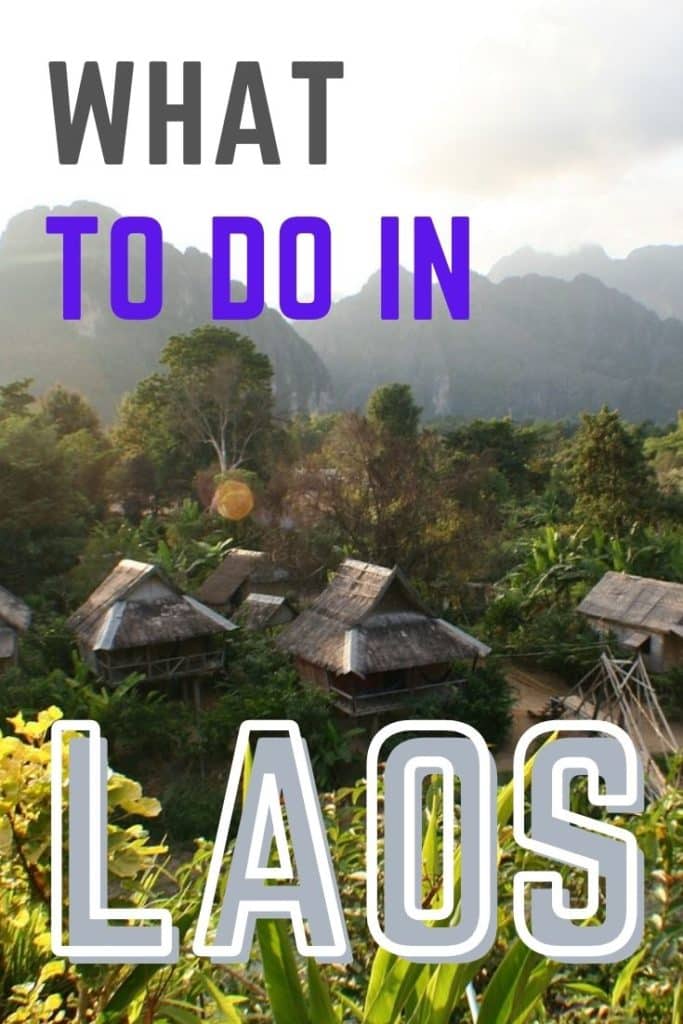
Little-known things to see and do in Laos
Villages in the north.
Head about 60 km (37 mi) north of Luang Namtha. There, close to the border with the Chinese province Yunnan is the small town of Muang Sing. Nowadays it is popular among trekkers who arrive here to explore some of the routes in the jungle forest and visit a former opium market in the town. (All of this is pretty amazing, and also full of beautiful Laotian textiles)
If you’re planning to include learning about hill tribes during your travel in Laos, leave Muang Sing and venture to the villages like Muang Long. Should you be interested in learning more about the local traditions, you can visit the famous khao soi noodle village of Ban Sili Heuang or check out the production of rice whiskey in Ban Patoy village.
The Rediscovered Buddha Cave with around 300 statues
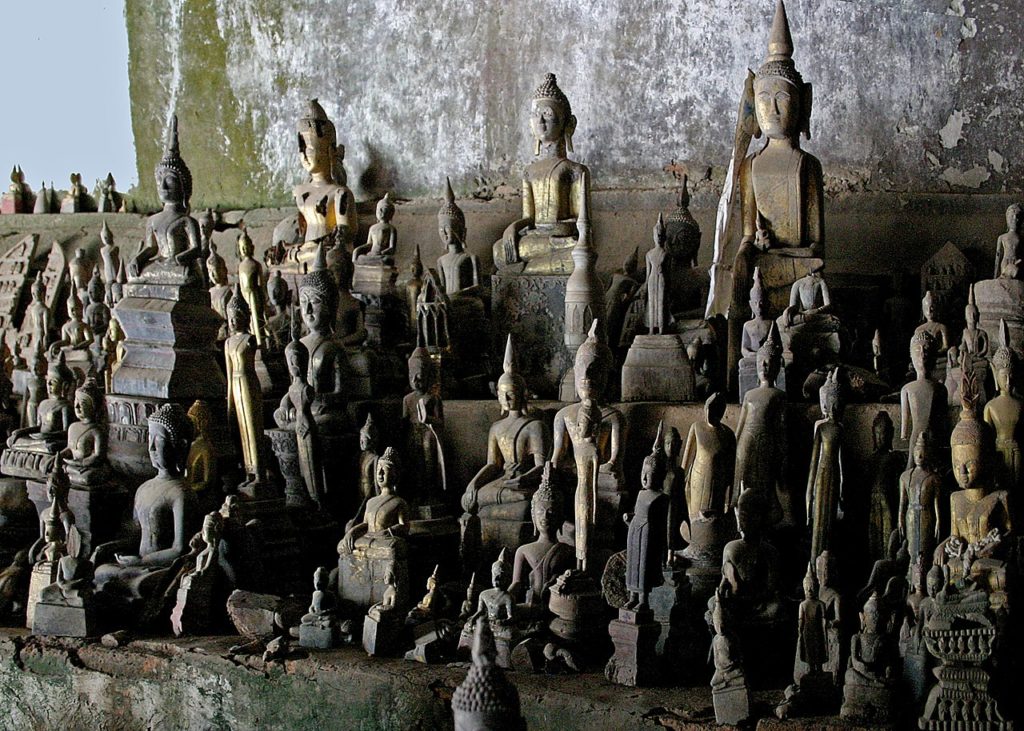
Thakhek? Well, even though this sleepy border village between Laos and Thailand has nothing exciting to offer, if you are willing to spend more than half a day here, you’ll be able to visit a very unique place.
The rediscovered cave, Tham Pa Fa, or the Buddha Cave, was found by a local villager in 2004. There are a few legends about how he discovered a hidden cave with hundreds of statues, which you’ll hear about on your visit. The cave is now accessible for tourists and worth a visit.
Join one of the local tours in Laos:
- Luang Prabang: Kuang Si Falls & Hmong Village Trekking Tour
- Pak Ou Caves, Whisky Village & Kuang Si Falls Day Trip
- Vientiane Highlights & Buddha Park Full Day Tour with Lunch
- Mekong River: 2-Hour Luxury Sunset Cruise with Canapés
Songran in Laos
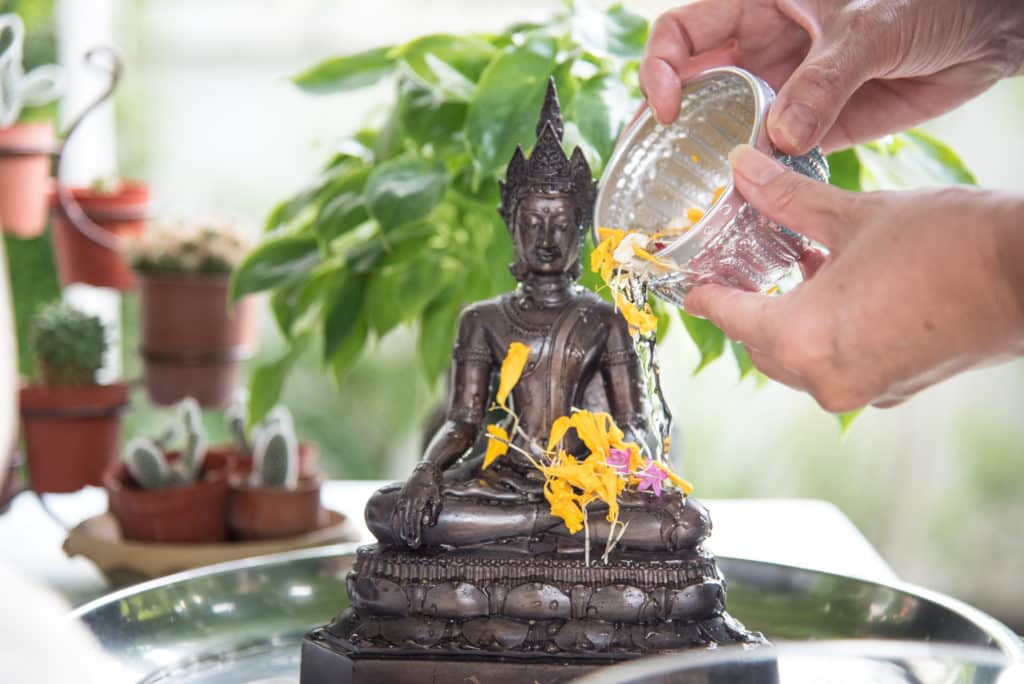
You might have heard of the New Year celebration aka “water festival” in Thailand, which tends to turn into a few days of splashy madness, especially in bigger cities. Given that Laos is a Buddhist country, the tradition of celebrating New Year is the same, however, with less chaos in the streets.
Here, you’ll be able to experience the religious ceremonies in a more intimate atmosphere, with respect to the traditions. Water-gun fun on the streets is not completely absent here, but it’s nothing compared to Thailand.
Coffee fields
Once again, Thailand might overshadow Laos when it comes to coffee tourism, but interestingly enough, Laos has a rich coffee history that dates back to the 1900s, during the colonial era of the country.
Nowadays, thanks to the Bolevean Plateau and other areas in Laos, there are plenty of local tours that can take you to a plantation and explain the cultivation and production process. Check the local agencies in the town of Paksong.
Vieng Xai caves
Forget exploring a dark hole among the karst stones while being on a boring boat tour. Vieng Xai is a phenomenal complex of caves, where thousands of civilians and the leadership of Pathet Lao resided during the ‘Secret War’ (1964-1973).
The caves are not attached to each other, so you’ll need either to rent a bike at the entrance, or hire a driver who can take you around. There is the option of getting an audio guide, which is highly recommended so you can fully understand the purposes of particular caves and the extensive underground system.
Heading to Asia? Read on!
- Traveling to Laos: the Good, the Bad and the Ugly
- How We Survived a Slow Boat Trip to Laos
- Things to do in Bangkok: 8 Awesome Experiences Not to Miss
- Where to Stay in Bangkok: The Best Hotels and Neighborhoods
- Where to go in Vietnam: Must-See Places for Your Vietnam Itinerary
- How to Visit Halong Bay from Hanoi, Vietnam
- Where to Stay in Ho Chi Minh City: Best Hotels and Neighborhoods
Wat Phu complex
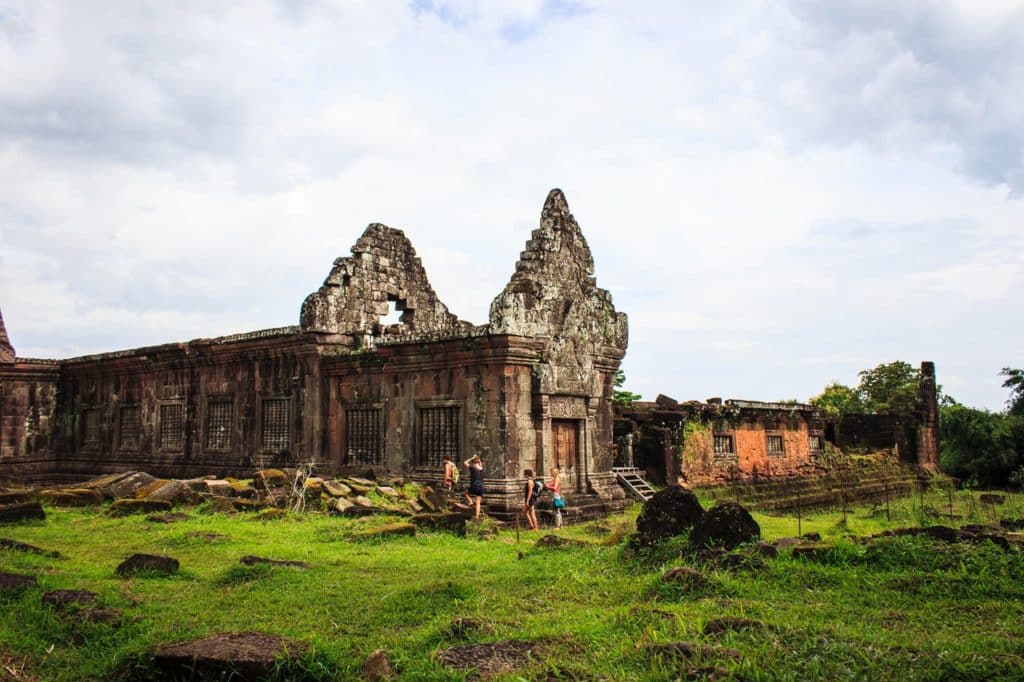
If you’re trying to escape Luang Prabang and its perpetual overflow of foreign tourists, you’re going to immensely enjoy Champassak. Despite the fact that it has been on the radar of many travelers recently, this southernmost province of Laos has kept its peace and beauty intact.
You’ll not only appreciate its laid back vibes, but also the stunning Khmer remains of the Wat Phu complex from the 5th century. To get there, you’ll need to get to the town of Pakse, which is a great place to spend a few days.
Bokeo Nature Reserve
Waking up to a stunning tree top view, watching layers of mist floating below your feet…. You can experience this and much more in the Bokeo Nature Reserve, which is a protected area where black gibbons, who had been considered extinct, were discovered in the late 1990’s.
At the moment there are a few wooden huts where you can observe the jungle forest. If you feel like getting more adventurous, you can check out some trekking options here as well. Keep in mind that the shorter hikes (2-3 hours) will include more zipline activities and less trekking,. The longer routes will take you deeper into the forest.
Join some of the local tours in Laos:
- Luang Prabang: Guided Tour of Mt. Phousi with Local Cuisine
- Luang Prabang: Vintage Tuk-Tuk Morning Tour
- Luang Prabang: Kuang Si Falls and Mekong Sunset Cruise
- Luang Prabang: 3-Hour Hmong Embroidery Class with Transport
Tat Kuang Si Bear Rescue Centre
At first glance, it might look like a small zoo. However, the caged black bears in the open enclosures have been rescued from poachers who would hunt them to use their different animal components on the black market; they are used mainly in Chinese medicine.
The center is situated only 30 km from Luang Prabang, and if you plan to visit (crowdy) Kuang Si waterfalls, you won’t miss the bears, as the enclosures are right at the bottom of the trail leading to the falls.
COPE Museum (Cooperative Orthotic and Prosthetic Enterprise)
Laos isn’t a country where you’d want to roam freely around in the jungle with no professional guide, not to even mention taking some unmarked paths. Why? 80 million unexploded submunitions out of 270 million ones that were dropped by the US army between 1964-1973.
The COPE center supports victims of these unfortunate explosions, including providing rehabilitation services, prosthetics, etc. The entrance is free, but you can leave a donation, which is very welcome considering it will be used for a good cause.
Hopefully you’ve found these tips inspiring and now have a better idea about some of the lesser known places in Laos worth visiting. This landlocked country can easily compete with its neighbours, especially if you’re into revealing untouched natural spots.
Pack & travel:
- Best Camera for Travel Photography in 2021
- Best Camera Lenses for Travel Photography: Tips For Your Next Trip
- The Best Carry On Travel Backpack: A Practical Guide
- Best Hiking Backpack: A Practical Guide
- Vivobarefoot Stealth II: A Detailed Review
- Tep Wireless Review: a Portable WiFi Hotspot For Travelers
Ivana Greslikova
- Published: February 27, 2021
You may also like...

The 4 Reasons To Hire A Yacht For Your Vacation As A Travel Influencer
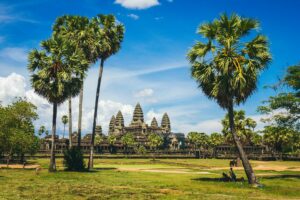
The Ultimate Asia Bucket List
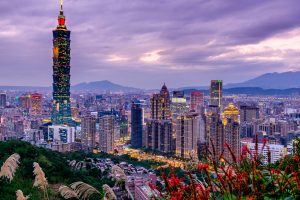
Things to Do in Taipei, Taiwan: Tips on Attractions, Food and Best Hotels
SHARE WITH YOUR FRIENDS!
This post may contain affiliate links. Please visit our Privacy Policy for more info.
Useful links
AFFILIATE DISCLOSURE
Nomad is Beautiful is a participant in the Amazon Services LLC Associates Program, an affiliate advertising program designed to provide a means for us to earn fees by linking to Amazon.com and affiliated sites.
2024 © All rights reserved - Nomad Is Beautiful
Web by Nimble.help (EN) | (SK) | Graphic design & Logo: Gabriela Holcer
Northern Thailand & Laos Itinerary 2019
Explore the bustling city of Bangkok, then hop on a night train up to the lush, green north of Thailand to visit the stunning temples of Chiang Mai. Drive the winding, scenic road to Pai and spend a few days eating delicious street food, watching the sunset, and swimming under waterfalls. Make your way to Laos and travel through the north of the country taking trips along the Mekong river, hiking to stunning peaks, and soaking in the beautiful landscape. Here’s the best 3-week itinerary through Northern Thailand and Laos!
- 2 Nights in Bangkok
- Night train to Chiang Mai
- 3 nights in Chiang Mai
- 3 nights in Pai
- 1 night in Vientiane
- 3 nights in Vang Vieng
- 3 nights in Luang Prabang
- 2 nights in Nong Khiaw
- 2 nights in Muang Ngoi
Before you go:
- Read this post to find out about visa requirements in both Laos and Thailand
- Find out what vaccinations you need to get here
- Learn about common scams in Thailand, and how to avoid them
- Make sure you’ve packed the right stuff!
Bangkok: 2 Nights
Daily Budget (excl accom) : £20 per day per person Accommodation : Dang Derm in the park £26 per night.

A city of culture, adventure and excitement, Bangkok has a very special place in my heart. On the surface it seems like a typical chaotic, noisy city, but if you dig a little beneath the surface there is so much more to be discovered! Most itineraries suggest one night in Bangkok, but if it’s your first time to visit I recommend staying for two – or even three if you have the time!
Things to do in Bangkok
I have written a few posts about Bangkok, which you can check out here .
- Spend your days visiting stunning temples, taking boat tours on the Chao Praya River, and haggling for souvenirs in the markets .
- Spend your nights meeting other travellers on Khaosan road, or discovering hidden bars around the city .
- Don’t miss trying out the amazing restaurants in the city !
Accommodation in Bangkok
We stayed at the Dang Derm in the Park hotel on Khaosan road, where we managed to book a deluxe king suite for just 1,140THB / £26 / €30 per night. This was our first time staying in the Dang Derm and I was really impressed! It’s right on the busy backpacker street of Khaosan road (our favourite place to stay in the city!) and features a huge rooftop pool with a bar and restaurant for when the days get too hot to explore.
Because the hotel is based right on Khaosan Road, where bars open until the small hours of the morning, the rooms at the front of the hotel can be noisy. If you’re planning to party, or you’re not disturbed by noise then opt for one of the cheaper double rooms. Otherwise stay in one of the more expensive rooms like the suite which are at the back.
If you’d rather not be so close to the nightlife then check out the Casa Vimaya Riverside Hotel . It’s a little bit more expensive than other hotels we’ve stayed in, but it’s a gorgeous hotel and you can’t hear any noise from the bars. It also has a stunning rooftop bar and beautiful riverside terrace where you can have breakfast.
For budget-friendly accommodation, check out the following hostels near the Khao San Road;
- Feel Like Home Dormitory & cafe : A chilled out, family-run guesthouse that’s a 15 minute walk from Khao San Road. The location allows you to be close to the action, but also escape the noise in the early hours of the morning. Dorm beds start from £3 a night, and continental breakfast is included.
- Mint Hostel : This modern, stylish hostel offers dorm beds from £4 per night with a free breakfast. There’s free tea and coffee all day, plus a rooftop terrace where you can socialise with other guests. Mint is a 10 minute walk from Khaosan road.
- Playground hostel : This is a party hostel, with a popular bar downstairs that fills up every night. Playground is a good place to meet other backpackers and have a few drinks before heading out to enjoy the bars on Khaosan. Beds start at £4 with no breakfast.
Night 3 : Take the Overnight train to Chiang Mai
Transport : 1092THB / £25 / €28 each for second class tickets Food : Spent 180THB on dinner from a restaurant near the station

Night trains are a must-do in Asia, and a way to see a different side of life, away from the tourists. On your last evening in Bangkok, head to Hua Lamphong station and hop on the night train to Chiang Mai.
Book your bed in advance as beds fill up quickly, and you don’t want to get stuck in a hard seat for 13 hours! Second class beds will be in a shared carriage, and first class tickets will get you a private, lockable cabin for two. The best place to book your ticket is on 12Go.Asia , and there are three trains to choose from;
- Depart Hua Lamphong at 20:10pm and arrives in Chiang mai at 7:15am
- Depart at 19:35pm and arrives at 8:40am
- Depart at 22:00 and arrives at 12:10pm
Stay tuned on my full guide to booking your night train in Thailand.
Chiang Mai: 2 Nights
Daily Budget (excl accom) : £15 per day per person. Accommodation : La Belle Nuit House 600THB / £14 / €15.90 per night

You”ll arrive into Chiang Mai early in the morning, so go straight to your accommodation to drop off your bags (and have a shower if they’re kind enough to let you!). There will be many tuk tuk drivers waiting at the entrance to the station to bring you to your hotel, expect to pay between 50 and 100 THB per person for the trip.
Things to do in Chiang Mai
If you’re staying within the old city walls, then eat in local restaurants, markets, and food stalls to keep your costs down. If you feel like splashing out or having a few drinks, hit The UN Irish pub in town. I have a post coming up with the best things to do in Chiang Mai so subscribe below to be notified when it’s live.
Accommodation In Chiang Mai
There are a lot of budget accommodation options in Chiang Mai. If you’re a first time visitor then I would recommend staying within the old City walls as it’s easy to explore. Here are some places to check out;
- Eden Walking Street Hostel : This is a budget hostel in a great location right by Sunday walking street. Dorm beds start at £6 per night, breakfast isn’t included but there is free tea, coffee and drinking water. This place gets great reviews from backpackers due to its great location and friendly staff.
- To Bed Poshtel Hostel : 5-minute walk from Saturday Night Market at Wau Lai road, To Bed Poshtel offers a range of options for budget backpackers. Single dorm beds are £6 per night, and double dorm beds start at £8 . Twin rooms are £19 per night. A free buffet breakfast is included in the room price, and the facilities are very well reviewed by guests.
- Oxotel : If you’re travelling with a partner then check out this stylish flashpacker hostel. Double rooms start at £23 with breakfast, and the property gets fantastic reviews across all booking websites. Rooms are basic, but there are some great shared spaces and a cafe on site where you can get to know other travellers.
- Lanna Tree Boutique Hotel : This three-star hotel offers cozy en-suite double rooms for £56 per night in a great location. The boutique hotel has a stunning swimming pool and breakfast is available for £3 extra per night. You can walk to popular sights, and bicycles can be rented from reception if you want to go further afield.
If you have been to Chiang Mai before and you would like to chill out for a few days away from tourists, look into staying in Nimman. This is a quiet, trendy area where most expats live and is super chilled out. It’s sort of like the Canggu of Chiang Mai – think hipster brunch, boutique stores and crossfit boxes.
You can eat well, hang out in cool bars, go to local markets and easily get a taxi to tourist spots. We stayed in La Belle Nuit guesthouse in Nimman in a private double room with shared bathroom for £14 per night.
Stay tuned for my full 2-day itinerary in Chiang Mai.
Pai: 3 Nights
Daily Budget (excl accom) : £10 per day Accommodation : £12 per night Transport: 200thb / £4.90 / €5 per day

How to get from Chiang Mai to Pai
The road between Chiang Mai and Pai is famous for its 762 bends, twisting around through the lush, green northern Thailand landscape. The most common way to get between the two is by minibus, but the most fun way is to drive it yourself!
We heard some nightmare stories about people being sick during the journey and since I tend to get car sick, we decided to drive it ourselves instead. That way we could stop whenever we wanted, and we got to really enjoy the fantastic scenery.
The drive takes around 4 hours, with a 30 minute stop for lunch, and it really wasn’t as bad as I expected! The roads were wide, and in good condition so we found it really easy to do the journey.
We rented our bikes in Nimman, but scooters are widely available for rent around Chiang Mai. Make sure the scooter is in good condition, turn it on and make sure it starts up first time and give the brakes a test. Also ensure you are given proper helmets that will protect you well. Full head helmets with a visor are the best ones.
How to get around Pai
The best way to get around Pai is to hire a scooter as most of the attractions are quite spread out. If you don’t already have a scooter you can rent one in the town for a few pounds per day – you will see signs for rental as you walk through the town.
If you would rather not drive then every tour office, guesthouse and restaurant in town has signs offering group tours to popular sights. You don’t need to book these far in advance, you can book same day if you like.
Accommodation in Pai
We stayed in Pai Country Hut , in gorgeous little wooden bungalows for £12 per night with a good breakfast included. The room was fan-cooled, and the bed was surprisingly comfortable considering how basic the huts were.
Location-wise, this was a great find. It’s just across the Pai river from the walking street, but in a quiet spot so you couldn’t hear a thing at night. The staff were excellent and let us extend our stay without any problems.
If Country Hut is full, or you have a bigger budget, here are a few other accommodation options in Pai:
- Tribal Pai Backpackers : Dorm beds start at just £3 in this popular backpacker hostel which is loved by solo travellers. There’s a cool chill-out area and fun bar where you can meet people and chill out in between sightseeing.
- KK Hut : If you like the idea of having your own wooden hut, but are on a limited budget then check out KK Hut. Simple huts start at just £4 per night and offer a lot more privacy than dorm rooms. Bathrooms are shared and the rooms are simple, but at this price you’re getting a good deal!
- Hotel Lasai : This modern and stylish 3-star hotel offers stunning poolside double rooms for £34 per night. The heat in Pai can be sticky and humid, and there were a few times I wished for a pool! Rooms have a private balcony, sun loungers outside, and get great reviews for cleanliness.
- Tarnjedton Pai Resort : If you’d like to stay in a wooden hut but have a bigger budget, then this is the place to stay. These comfortable air-conditioned wooden huts are a lot more upscale than the ones we’re used to, and will set you back £40 per night with breakfast. They also have two-bedroom villas available for £86 per night which sleep up to 6 people. This place gets a fantastic 9.5/10 on Booking.com with great reviews from guests about the owners.
Stay tuned for my full itinerary for Pai, where I break down everything we did there – and some tips on how to get some of the best places to yourself!
Vientiane: 1 night
Daily Budget (excl accom) : £10 per day Accommodation : £10 per night at Green Box Capsule Hostel & Hotel Transport: 3000THB / £70 / €79 for the one way flight from Chiang Mai to Udon Thani (booked the night before so it would be cheaper further in advance)

How to get from Pai to Vientiane
There are a few different ways to get from Northern Thailand to Laos. I’ve covered all of them in this post. All options involve getting back to Chiang Mai first, so you can drop off your bike if you rented one.
Our trip from Pai to Vientiane wasn’t the cheapest, but that was because we wanted to get to Laos ASAP. We drove back to Chiang Mai and caught a flight with Nok Air to Udon Thani which is close to the border between Thailand & Laos. From there we hopped on a mini bus at Udon Thani airport which took us directly to the Laos border for 200THB / £4.60 / €5.30 per person. There’s a desk right across from arrivals where you can book the bus, and it left around 20 minutes after we booked our seats.
Crossing the border from Thailand to Laos
The process at the border was fast and efficient. Head to the first desk and pick up your forms, then go to the next with the filled out forms, your passport, and your visa fee and you will be directed to a third window to wait for your visa. You can pay in Kip, Baht, Euro or USD – and the fee is different depending on where you come from. Check out my visa post to find out more about the cost .
Once we made it through the border we got a taxi to our hotel – it was late so there weren’t many options, but you can also get a bus. We had to haggle a LOT to get our fare down to a reasonable amount, so be prepared for that!
Accommodation in Vientiane
We stayed at Green Box Capsule Hostel , in a double bed capsule very close to the main sights, bars, and restaurants in the town. The hostel was basic, but for £10 per night with breakfast, it was very well priced. I’d recommend staying here if you’re on a tight budget and would like to be close to everything in Vientiane. If you have a little more cash to play with, then check out these options:
- Barn 1920s Hostel : This 20’s themed hostel offers basic dorm beds for £6 a night. They boast an exceptional 9.6 on Booking.com, and are in a fantastic location for sightseeing.
- Sailomyen Hostel : Another very popular and well-reviewed hostel in Vientiane, Sailomyen has been gaining great reviews from backpackers since 2013. Dorm beds start at £8 a night with breakfast included. Again location is great for sightseeing on foot.
- New Usouk Boutique Hotel : This charming boutique hotel offers double rooms for £24 per night. Guests loved the location, and the comfortable beds.
- S 2 Modern Boutique Hotel : Double rooms in this stylish hotel start at £30 per night, with a highly rated breakfast included. The rooms are clean, fresh and bright, as this hotel is newly opened but an instant hit with guests.
- Le Thatluang D’oR a Boutique by D Varee : How often can you stay in a four-star hotel for just £60 a night? This hotel is a little far from the center of Vientiane but easily reached by tuk tuk. I’m recommending it for anyone who wants to stay somewhere indulgent for a mid-range price. The French colonial building is breathtaking, as is the sophisticated decor and massive swimming pool. Even if you can’t afford to stay here, I recommend checking out the listing just to see how stunning it is.
Stay tuned for my post ’24 hours in Vientiane’ to find out how to see the best of Laos’ capital city in just one day!
Vang Vieng: 3 nights
Daily Budget (excl accom) : £10 per day Accommodation : £10 per night Transport: 200thb / £4.90 / €5 per day

How to get from Vientiane to Vang Vieng
We took a minibus from Vientiane to Vang Vieng, which took around 4 hours and cost 60,000 Kip each. We booked it through our guesthouse which is how most people tend to book theirs, or you can go to the local bus station and buy a ticket there.
The journey was bumpy, and the van was cramped, but I had downloaded some shows on Netflix so it passed pretty quickly. You will be dropped off in the center of Vang Vieng and we walked to our accommodation, but there are Tuk Tuks waiting around to bring people to their hotels.
How to get around in Vang Vieng
There’s a motorbike rental company just across from where buses drop you off in the town, so you can pop across and rent one as soon as you arrive. They charge around 80,000 Kip per day, which is more expensive than we usually pay but was the average in Vang Vieng. You will definitely need a scooter to get around so it’s well worth hiring if you want to explore the area!
Accommodation in Vang Vieng
We stayed at Magic Monkey Guesthouse , in a lovely little double bed hut with an en suite for £10 per night. A very simple breakfast is included, and there is a kitchen and bar on site which are open throughout the day. The gin & tonics are huge, and lethal (You have been warned!). This was a good place to meet other people, guests used to gather around the small outfoor fire pit or bar at night.
Despite these positives I can’t recommend Magic Monkey outright as we had a few bad experiences there. The kitchen couldn’t seem to remember Tim’s allergies and served him food he was allergic to a lot. The lock on our door didn’t work so we had to leave it open and money was robbed from our room. Also the laundry service spilled bleach over our clothes and ruined them.
If you’d like to keep your money and clothes, here are a few other options for accommodation in Vang Vieng;
- Vang Vieng Rock Backpacker Hostel : This popular hostel offers dorm beds for as little as £3 per night. This is a very social hostel, so it’s great for solo travellers and those wanting to meet new people.
- Jennin Backpackers hostel : A small, basic hostel, Jennin is one of the bestsellers in Vang Vieng. This is probably because beds are just £5 and they have a swimming pool! This is much needed in the muggy heat of Vang Vieng.
- Vieng Tara Villa : Beautiful wooden villas set in the middle of a rice field, this is a stunning place to spend your time in Vang Vieng. Villas are £59 per night, with breakfast included. The resort is a 10 minute walk from Vang Vieng town, and there is a free shuttle supplied by the hotel.
- Nivana Archipel Resort : If you want to get away from the crazy parties of Vang Vieng then this is the place to go. This stunning three star resort offers two bedroom wooden villas with a private beach, garden and terrace, for £64 per night.
Stay tuned for my post ’10 things to do in Vang Vieng’!
Luang Prabang: 3 nights
Daily Budget (excl accom) : £10 per day Accommodation : £10 per night at Chitlatda Central Bila House Transport: 200thb / £4.90 / €5 per day

How we got from Vang Vieng to Luang Prabang
We booked a minibus through our hostel for 50,000 Kip per person, and this trip was a lot more enjoyable than our journey from Vang Vieng! There were just 3 other people in the minibus so we had plenty of space to stretch out and sleep on the way. The bus took 2 bathroom stops and a lunch / coffee stop – but I would bring snacks on board if I were you.
How we got around Luang Prabang
LP is a very walkable city, so for most of our time there we walked to all of the sights. To see the Kuang Si falls we hired a motorbike through our guesthouse for 70,000 kip and drove out to the falls.
Cycling is a popular way to get around Luang Prabang. We rented some from our guesthouse and took a trip across the Mekong to see the villages on the other side of the river. The bikes we rented didn’t have working brakes or gears, so it was a slog in some places – but we still managed it!
Accommodation in Luang Prabang
We stayed at Chitlatda Central Bila House in a double room with en suite for £10 per night, including free hot breakfast. The guesthouse was very central, and really close to everything we needed to see. There were bars and restaurants just steps away, and we could get to the river within a few minutes.
The rooms were basic and clean, with daily cleaning if you would like it. The guesthouse is run by a really lovely family who help you out with pretty much anything you need, from booking minibuses and hiring scooters to laundry and a cheap airport drop off. We researched prices before we committed to booking anything through them, but it was always one of the cheapest.
The accommodation we usually stay in is very budget, and this was no exception. If you have a bigger budget and would like to stay somewhere nice then check out these hotels I found.
- Chill Riverside Hostel & Cafe : This popular hostel offers dorm beds for £5 per night, which includes breakfast. There are female-only dorms which are the same price, and there’s a restaurant and bar on site where you can relax and meet other people. The hostel is close to Night Market, National Museum and Wat Xieng Thong, and the riverside setting makes it the perfect place to relax.
- Chitdara 2 Mekong : If you’d rather not stay in a hostel, double rooms at this traditional guesthouse start at £24 with breakfast. Located along the Mekong and close to the walking street market, this is walking distance from pretty much everything you need to see in Luang Prabang. Rooms are bright, comfortable, and clean – this place gets great reviews online from guests.
- Ssen Mekong Boutique Accommodation : This gorgous 2-star boutique hotel offers comfortable double rooms for £40 per night. Located along the Mekong river in the main town center, the location is fantastic. Breakfast is included, and bikes and day trips can be booked through reception.
- Maison Dalabua : Perfect if you have a bigger budget and are looking for a little luxury. This stunning 4-star hotel offers stylish ‘Grand Deluxe’ double rooms for £110 per night. Surrounded by lotus ponds and tropical gardens, with a beautiful swimming pool and spa on site – this is peaceful tranquility at its best. The hotel is just a 5 minute walk away from the town, so location-wise it gets a 10/10.
Stay tuned for my full itinerary for Luang Prabang
The following two towns were ones we didn’t make it to because of timings, but they were on our original itinerary so I’ve include them here too!
Nong khiaw : 2 nights.
Daily Budget (excl accom) : £10 per day Accommodation : From £8 per night
About Nong Khiaw
A beautiful little rustic town set on the banks of the Nam Ou river, this is a place to go if you want to chill out completely. Backpackers tend to finish up their trips in Laos with a few days in Nong Khiaw or Muang Ngoi (below). Accommodation usually comes with a private balcony and hammock so you can spend your evenings watching the sunset and reading a book.
There are lots of things to keep you busy in Nong Khiaw, if that’s what you want. Hike, trek and take boat trips to nearby villages, and visit the famous Pha Tok & Pha Kuang Caves. All activities can be arranged by your guesthouse once you check in.
How to get from Luang Prabang to Nong Khiaw
You can book a minibus to Nong Khiaw from any guesthouse or tour operator in Luang Prabang town. The journey takes around 3-4 hours. If you took a bus from Vang Vieng then check with your driver if he also does daily trips to Nong Khiaw – he might give you a good price! You should expect to pay 50,000 LAK per person.
If you want to save a little money, you can get there by public transport instead. Catch a local bus from the Luang Prabang bus station to Pak Mong and get a tuk tuk from there to Nong Khiaw.
How to get around in Nong Khiaw
The village is really small, so it’s possible to get around on foot. You can also rent bicycles from your guesthouse to explore the area if you prefer.
Accommodation in Nong Khiaw
There isn’t as much choice for accommodation as larger towns like Luang Prabang, so prices are a little higher. Rooms usually come with a private terrace and focus on allowing guests to chill out completely.
- Sythane Guesthouse : The cheapest accommodation I could find in Nong Khiaw , double rooms here start at £8 per night. The fan-cooled rooms have a private terrace with a hammock that has gorgeous mountain views. Rooms and facilities are simple and basic, which is expected given the price. Reviews are around the 7.5/10 mark.
- Nam Ou River Lodge : This two star lodge is set along the Nam Ou river with gorgeous views from the private balconies of each room. Double rooms start at £14 per night and are simple but clean and comfortable. There is a restaurant on site that offers Lao food overlooking the river.
- Ban Lao Sunset Bungalow : Get your own riverside bungalow for £20 per night, including breakfast. As you would expect, the private balconies offer stunning views of the sunset. This is a favourite of mine in Nong Khiaw .
- Viewpoint Resort : Located a little higher up than the rest of the properties I found, the highlight of this 3 star resort is the amazing views from the bedrooms. Queen rooms start at £43 per night with breakfast, and have floor-to-ceiling windows to allow you to take in the views. There is also a cute outdoor seating area where you can eat or have some wine in the evening while watching the sunset.
Muang Ngoi: 2 nights
Daily Budget (excl accom) : £10 per day Accommodation : From £13 per night
About Muang Ngoi
A charming village north of the river from Nong Khiaw, Muang Ngoi is even more isolated as it’s only accessible by boat. This was once a sleepy village where backpackers used to go to see traditional Laos life, but it’s firmly on the backpacker trail so things have changed a little.
Even though Muang Ngoi has gained popularity with tourists, it doesn’t appear to have lost its charm and is still a good place to escape for a few days. If you really want to see local life then head to nearby villages. There is a rich history here so if you do any hikes I’d recommend using a local guide to find out more about the place.
How to get from Nong Khiaw to Muang Ngoi
Muang Ngoi is a 1-hour boat ride from Nong Khiaw. Boats leave daily at 11:00 and 14:00, costing 25,000 kip per person.
Accommodation in Muang Ngoi
- Rainbow Guesthouse : This is a basic, friendly, family-run guesthouse that offers some of the cheapest rooms in Muang Ngoi. Double rooms with private terrace start at £13 with breakfast. This place is very budget so it’s a little tattered, but the staff are friendly and views are fantastic. Plus it’s cheap!
- Riverview Bungalows & Guesthouse : £16 per night will get you a simple wooden hut with a private balcony overlooking the Nam Ou River. Sit in your personal hammock and read a book, or head to the on site restaurant and bar to meet other guests. Tours and boat trips can be arranged through reception.
- Ning Ning Guesthouse : Riverside bungalows here start at £20 per night, with breakfast. Rooms have floor to ceiling windows so you can see the stunning views from your bed, which makes it worth the price alone. There’s a riverside restaurant where you can eat or drink looking out over the views. Guests found the beds to be very comfortable here.
Fly home from Luang Prabang
There you have it! I hope you found this helpful for planning your trip to Laos and Northern Thailand. If you have have comments or questions, feel free to leave them below.
Thanks for reading! Steph x
stephmylifetravel
How to get from chiang mai to laos by boat, bus & plane, how to book a night train in thailand, you may also like, stephmylife group tour schedule 2024, 24 travel destinations to visit in 2024, sri lanka travel guide 2023, 2023 guide: how to book the train from..., best budget accommodation in thailand, best restaurants in bangkok, travel guide bali: the nusa islands, monsoon season in bali, 10 awesome things to do in pays des..., khao sok national park travel guide.
Any chance that you will be posting more about Vientiane, Vang Vieng and Luang Prabang soon? ???? Found your other guides so amazing and useful already!!
Hi, Thanks for such a comprehensive blog on this trip which sounds amazing. if i have 9-10 days, which places would you recommend should absolutely be done, or which can be alternately scratched.
Leave a Comment Cancel Reply
Save my name, email, and website in this browser for the next time I comment.
Sign me up for the newsletter!
This site uses Akismet to reduce spam. Learn how your comment data is processed .

A Singaporean's Adventures at Home and Abroad
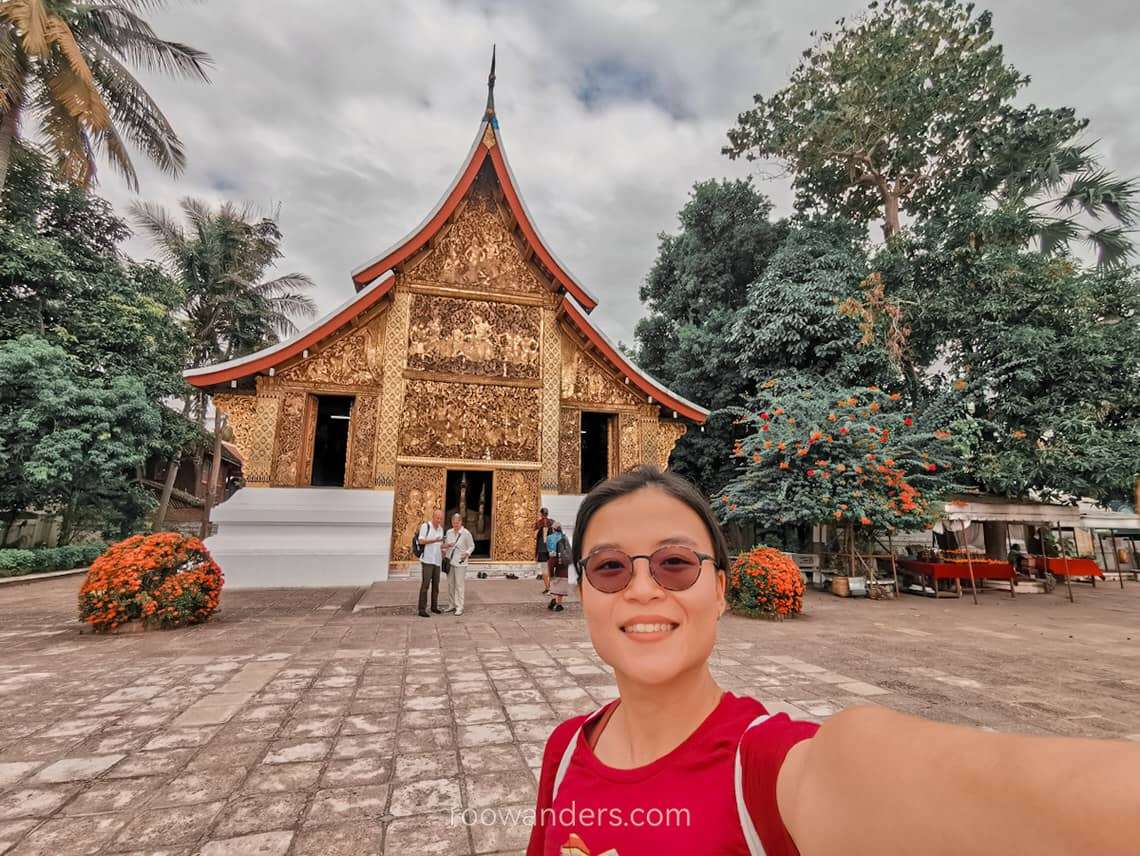
Travelling in Laos Guide for Beginners
Sai Bai Dee from Laos – my 42nd country and last country in Southeast Asia north of Singapore.
Visiting Laos has been a part of my plan since 2018, but somehow didn’t materialise until 2023 – 5 years later !
Having been to its neighbouring countries of Vietnam , Thailand, Cambodia and China – I visited Shangri La ! – I could attest that this country is very safe for solo female travellers, with tons of activities to do. Everyone’s polite and friendly, and it is still relatively less visited than the other SEA countries.
Thinking of visiting Laos soon? Here’s what to expect!
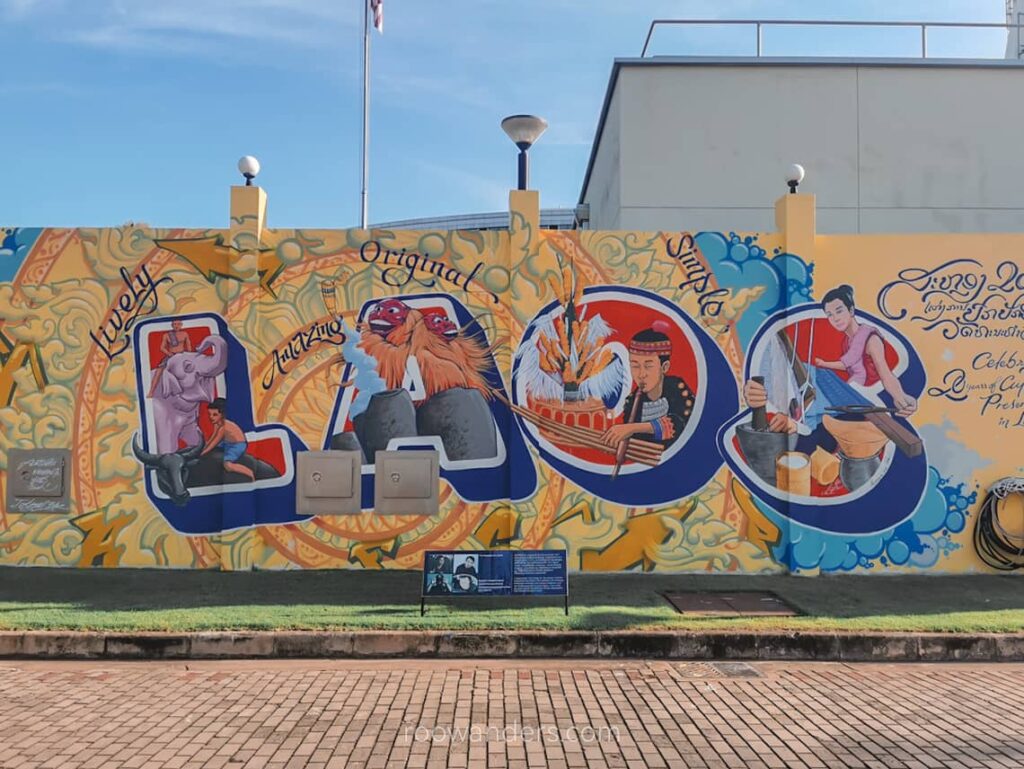
I visited Northern Laos in Nov 2023. In case you’re wondering, what’s missing now are Brunei and Timor Leste to complete the SEA countries. I almost visited Brunei when I was in Miri in July 2022 , but the country was still closed due to the pandemic. This post contains affiliate links that cost nothing to you but support my blog! It may also be updated periodically. Cheers!
Immigration Matters
As a citizen of a member country in ASEAN, I am exempted from a visa, since Laos is also a member state. Citizens from Brunei, Cambodia , Indonesia , Malaysia , Myanmar, Philippines , Singapore , Thailand, and Vietnam have a maximum of 30 days of visa-free entry in Laos .
Apart from that, countries like Japan, South Korea, Switzerland, Luxembourg, Russia and Mongolia also enjoy visa-free entry of 15 or 21 days .
For the rest, you could apply for a Visa on Arrival at the entry ports or online here at the official website . Have some spare passport photos, proof of accommodation and a US$ 50 ready for the visa. An outward-bound ticket may be needed. The visa grants 30 days of travel within the country.
Entry and Exit form
Just to point out, everyone needs to fill in a long sheet of paper consisting of two parts indicating your entry and exit points. Details include passport information, accommodation and transport number.
Hand in the entry portion during immigration, and keep the exit portion with you until your departure. Both portions have the same unique ID. I’m not sure what might happen if you lose your exit form, though some say that filling in another blank exit card would do the trick.
Travelling into Laos
Laos is a landlocked country surrounded by Kunming, China , and Myanmar at the north, Vietnam at the east, Thailand at the west, and Cambodia at the south. The longest river in Southeast Asia – the Mekong River – flows through all six countries, resulting in a variety of transport options.
Most international travellers would have flown into the country. For those in Singapore, there are direct flights by Scoot three times a week into Vientiane. I flew in and out of the country on Saturdays. Other budget options include changing flights to Bangkok and taking Air Asia into Luang Prabang.
Most international travellers would have flown into Wattay International Airport in the capital Vientiane, Luang Prabang International Airport in the northernmost part of Laos, or Pakse International Airport in the southern part of Laos.
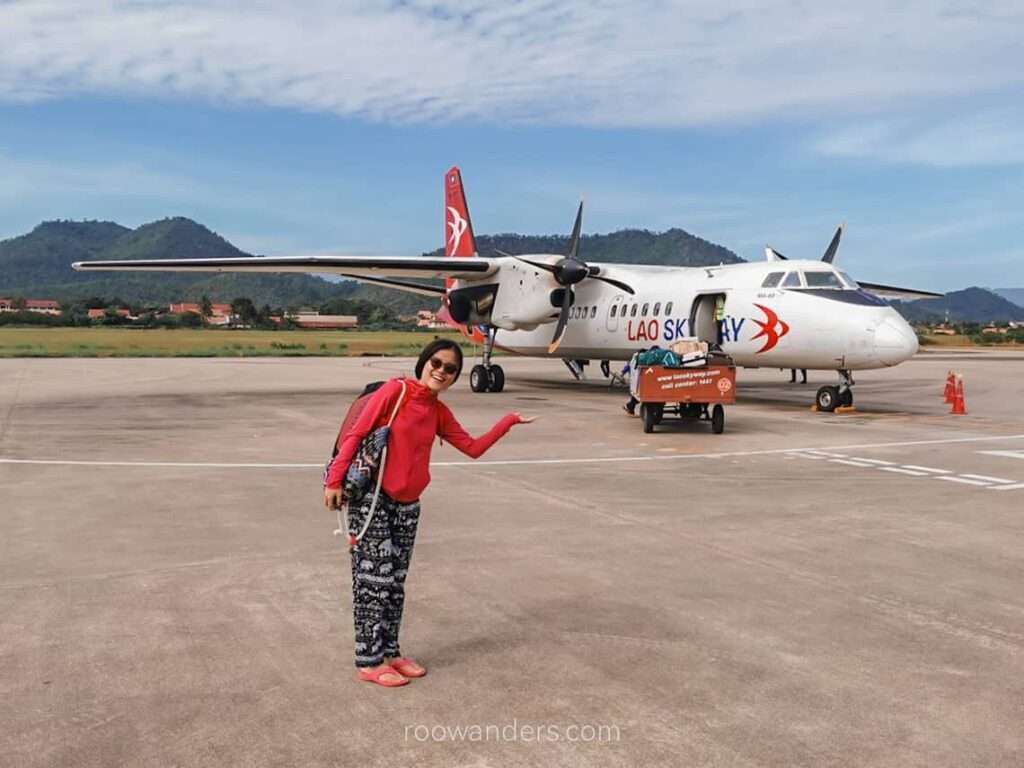
Another popular mode of transport is the 2D1N slow boat from Thailand to Laos. There are tour operators who could arrange for a hassle-free way of travelling via the slow boat from Chiang Mai, Chiang Rai, or Pai to stops between Huay Xai and Luang Prabang in Laos.
This is definitely on my cards soon.
If you’d like to stretch your money, there are plenty of cross-country sleeper buses into and out of Laos. Note that the journey could be long and arduous.
Most accommodations, at least in my hostel, can arrange bus tickets. You could also purchase them online from 12Go .
You could cross over from Kunming, China, to Laos, or vice versa, via the Laos-China Railway . Travelling via train into and within Laos is the most comfortable and fastest way to travel, but getting a ticket independently can be a chore .
There’s also a sleeper train from Bangkok , Thailand, to Laos via the Friendship Bridge over the Mekong River. I’ve never taken a sleeper train in Thailand, but it may be similar to the sleeper I took in Vietnam on the Reunification Express Line .
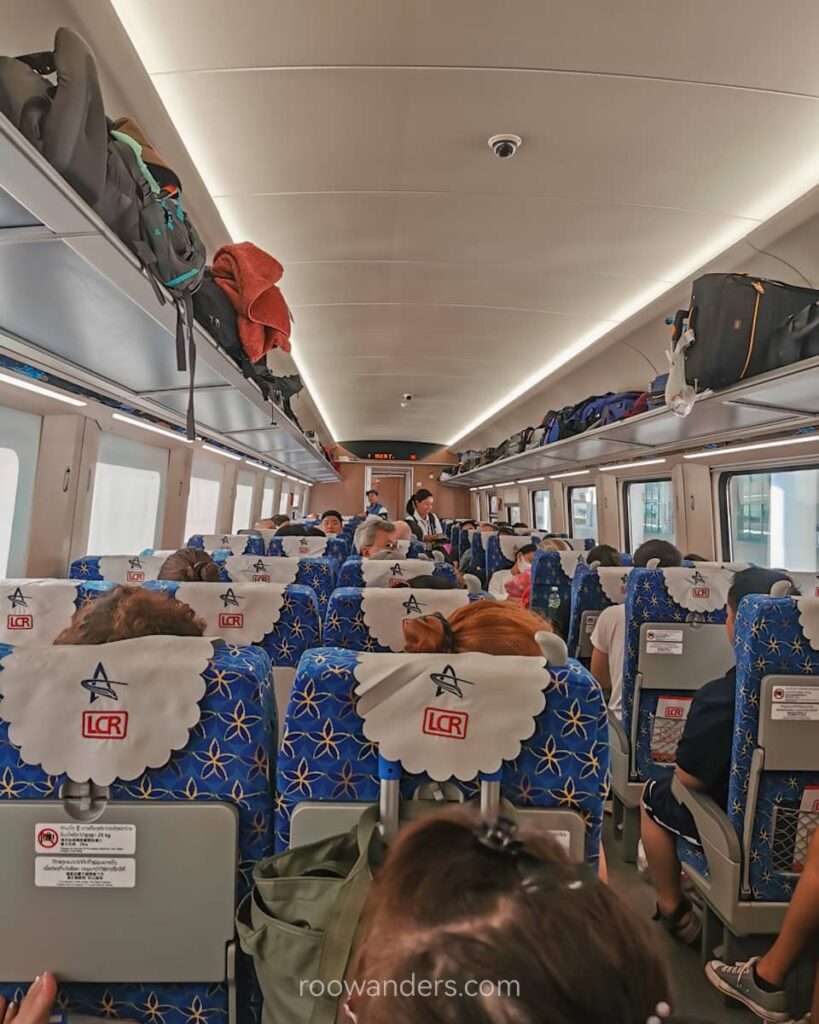
Best Time to Visit
The dry and cool months of November to January are generally the best period to travel in Laos. Daytime temperatures are agreeable, though early mornings and late nights can be a little chilly. I visited in the middle of November for a week and encountered only one sudden downpour in Luang Prabang. This is the best time for a guided hike – some areas may still contain unexploded bombies, more about this in another post – in the forest of northern Laos.
Expect heavy rainfall from June to October . Travelling during the peak rainy season can be hazardous or even impossible with road closures and floods. Even if you were to get to your destination, certain attractions may be closed – for instance, the wet cave of Vang Vieng. In exchange for the wetness, you’d get roaring waterfalls and full rivers.
The period between March and May coincided with the country’s slash-and-burn season . You’d have acrid smog everywhere that paints the sky a dusty orange, and fill your clothes and hair with particles and a lingering burnt smell. A friend of mine visited in April 2023 and had to wear a mask throughout her trip.
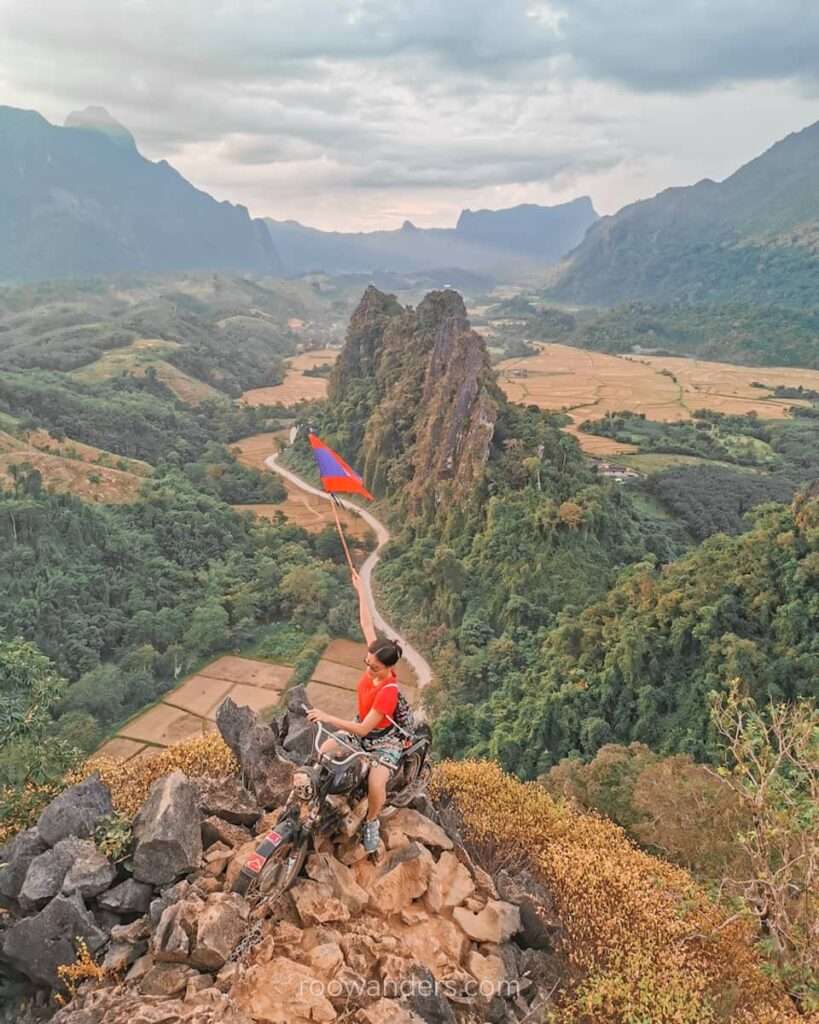
Administrative Matters
Cash is king in Laos. Clean and crisp USD, and occasionally the Thai Baht, are accepted in most establishments, but the Laotian kip is still the preferred way to go. Some places with tourist presence accept cards, but cards incur additional charges.
You could draw your cash in all ATMs. The best rates are usually at the airport. Maximum cash per withdrawal is 2500k kip for BCEL , with another 20k to 30k kip transaction fee. My cash withdrawal using YouTrip totalled up to S$165 at Wattay International Airport (Nov 2023).
I tried to draw my cash using Trust from BCEL, but it didn’t work. In the end, I had to go with YouTrip . Trust works as a credit card with no cash withdrawal or forex charges, while YouTrip works as a prepaid card and free cash withdrawal for the first S$400 of the month. If you haven’t had a Trust or YouTrip card yet, do me a favour and sign up with me under codes SURW9MK5 (download the Trust app for iOS or android ) and here (Youtrip).
Laotian Kip is nearly worthless beyond its borders, so make sure you use them all before leaving.
Data and SIM
For those coming from Singapore, telcos like Simba with its 1 GB free roaming work. APAC pack for Giga does not.
There’s wifi in all touristy places, but don’t expect the local noodles shop to have one.
Buying a SIM card is easy , and the cost is very low. My 5 GB data package SIM for 10 days cost a mere 30k kip at Wattay International Airport.
Having a Laotian SIM works wonders, as you can now use your Laos number to create accounts for ride-hailing, other transport, and most importantly, the frustrating Lao-China Railway app. To check your data balance, dial *123#.
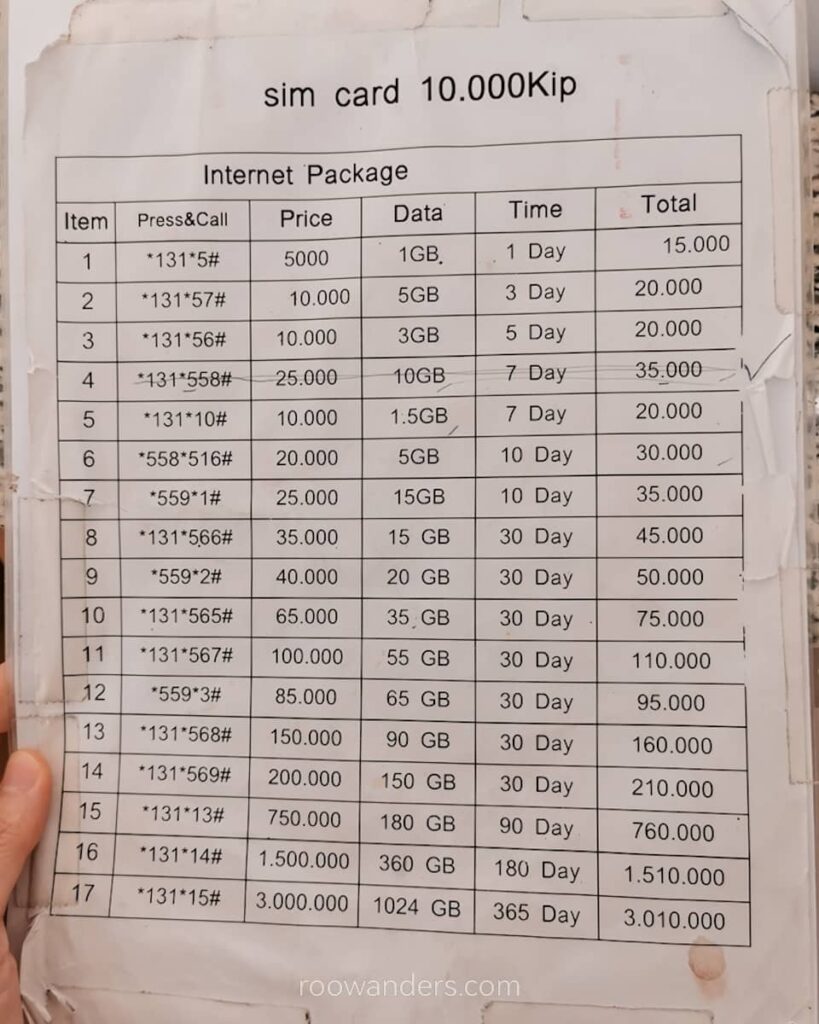
Travelling within Laos
I walked everywhere within Vientiane and Luang Prabang to get to the sights and eateries. Unlike the roads of Thailand or Vietnam, Laotians do not honk all the time, and there are proper pedestrian crossings.
Ride Hailing/ Taxi
Loca , a Thai-owned company, is like the Grab of Laos. You could use the app for payments, order takeaways, and call for a ride. However, this service is still predominantly used only in Vientiane and Luang Prabang . I accumulated enough points from two Loca rides to exchange for a free iced Americano in a partnering cafe.
Xanh SM is another new ride-hailing contender. Unlike Loca, Xanh SM owns its fleet of cyan taxis. The VinFast electric cars are new, quiet and travel smoothly within Vientiane . As my visit coincided with the month of their launch, we enjoyed one free ride on the first weekend, and two 50% off rides on the following weekend. They accept cash only.
Make sure you download their apps and create an account for each before using them, as this process takes time.
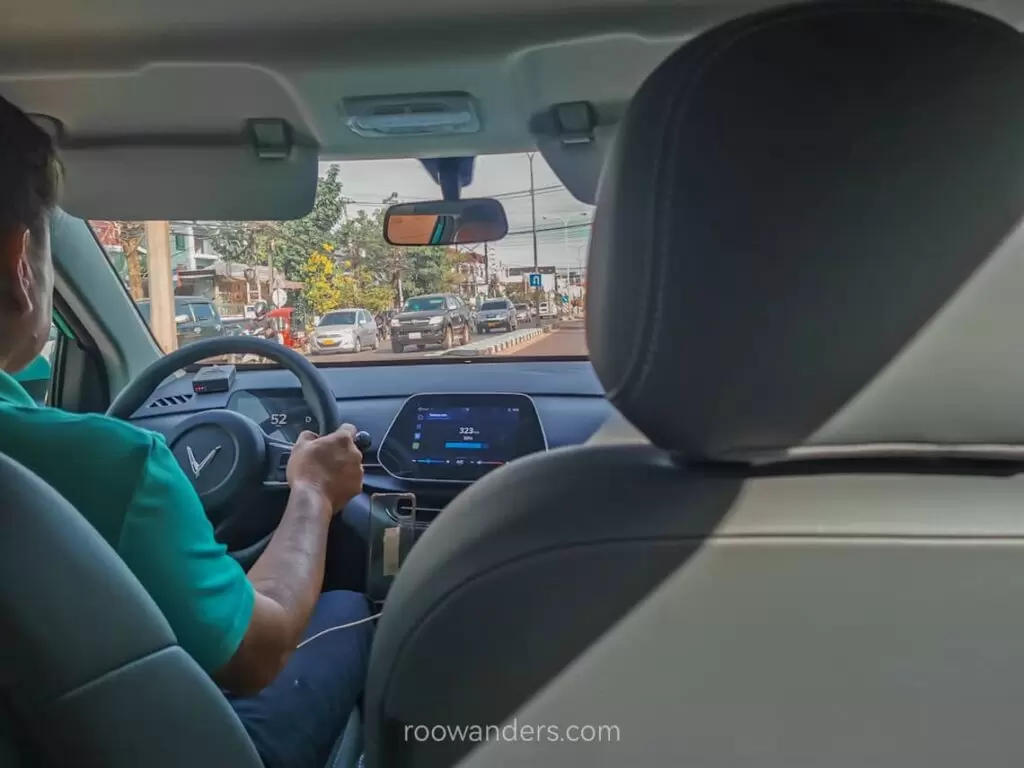
If you’re travelling in a larger group, consider hiring a tuk-tuk. Depending on their size, a tuk-tuk can carry a max of three or 10 individuals.
I’ve taken the tuk-tuk thrice during my week-long trip – from Vang Vieng Railway Station to Vang Vieng for 30k kip, and vice versa, and from Luang Prabang Railway Station to Luang Prabang for 40k kip.
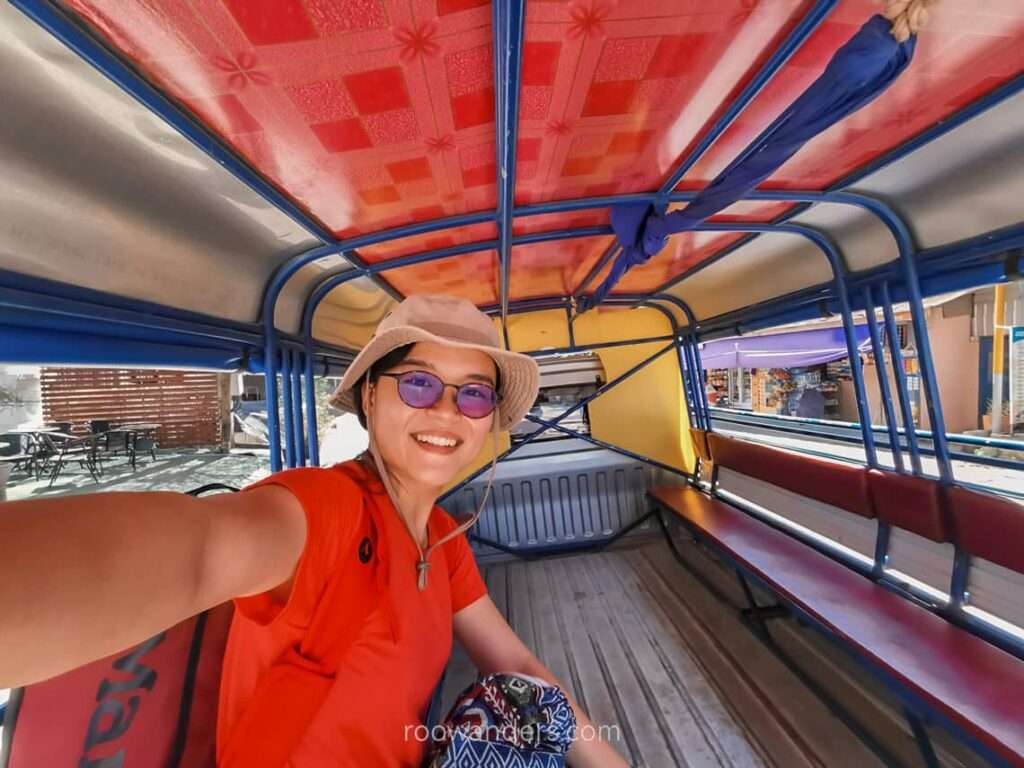
Riding a motorbike in Laos gives you ultimate freedom . Plus, they’re not that expensive, with rates going from 120k kip to 150k kip per day.
Too bad for me, I have no knowledge, no licence and no courage. Lucky for me, I found another traveller with an international licence and sufficient know-how on Southeast Asian battered roads. We covered an extensive distance with the bike in the outskirts of Vang Vieng and Luang Prabang.
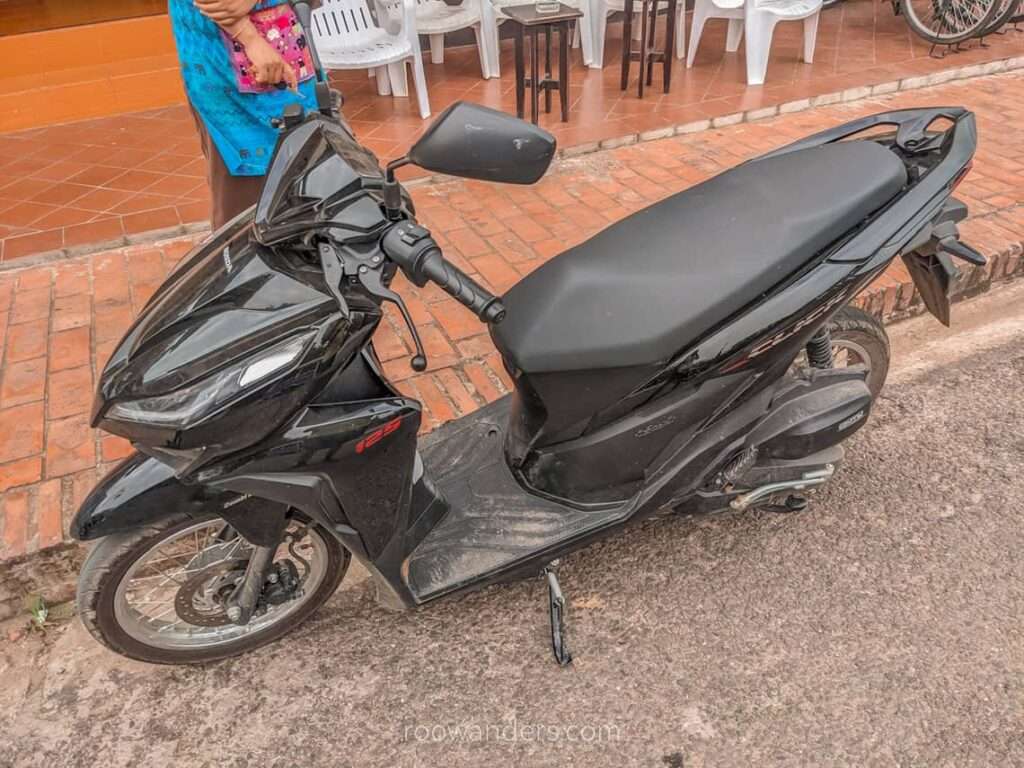
For those without a motorbike licence, fret not. You could rent a bicycle. Make sure you get yourself a mountain bike for the rough roads. There’s also the option of electric bikes.
What to Wear
If you haven’t known yet, Laos is a Buddhist country with so many temples and Buddhas you could get temple fatigue.
Dress conservatively and modestly, covering your knees, shoulders and chest when visiting religious sites. You may wear bikinis for blue lagoons and the waterfalls, but remember to change back before leaving the park.
Key places to visit
Here’s a brief summary of what to expect in the key places of attraction.
- Vientiane . The capital city of Laos has temples, a grand monument with a fountain called Patuxai, and a COPE visitor centre. A place where most international travellers would land via flight if not Luang Prabang.
- Vang Vieng . The next natural spot to visit from Vientiane for those on a classic week-long trip. Many imposing karsts and caves. Home to adventurers. You could paramotor or ride a hot air balloon here.
- Luang Prabang . Used to be the royal capital of the country. Many old temples date back to the 16th century. Beautiful street houses facing the river. A perfect base to launch into hikes around Northern Laos.
- Luang Namtha. A trekking destination. For those looking for an even more laid-back countryside vibe.
- Nong Khiaw. Another spot for adventure seekers. Offers opportunities to rock-climb, kayak and trek.
- Phonsavan. For the mysterious millennia-old Plains of Jars sites.
- Thakhek. There’s an adventurous 500 km loop through the countryside with the Kong Lor Cave as a key highlight of the 4 – 6 days trip.
- Pakse. Has an international airport, and another exciting 300 km loop peppered with numerous waterfalls known as The Bolaven Plateau Loop .
- Si Phan Don (4000 islands). A laid-back little town with numerous waterfalls. Spot the elusive freshwater Irrawaddy dolphins !
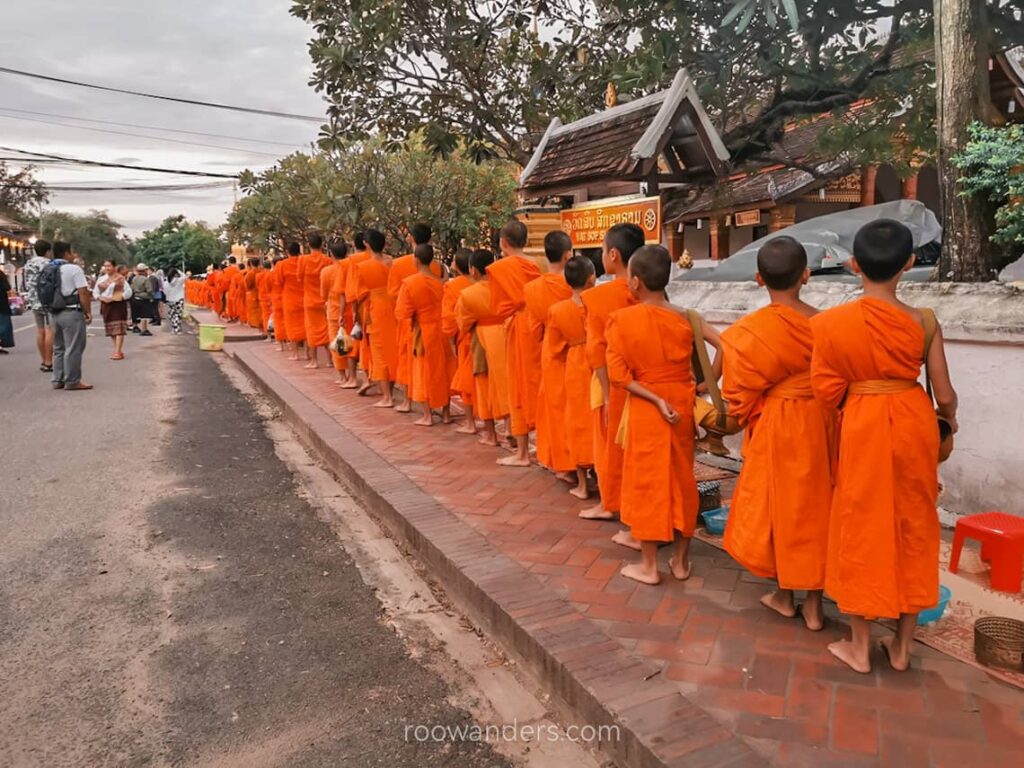
Food to try
For me, Laotian cuisine is like a little bit of Vietnamese and Thai food. No surprise since they’re neighbours.
There are lots of noodles, rice dishes, and baguette sandwiches. Thai food tends to be more intense (spicier/ sweeter/ more sour), while Vietnamese food is more bland in comparison. All are still tasty.
Here’s what I had in Laos. Bear in mind I’m a soup and noodles lover, so my list tunes towards that.
- Khao Piak. Chewy rice noodles in starchy soup. You could choose to top it with meat. Comes with a serving of raw vegetables and herbs, shrimp peanut concoction dipping sauce and lime. Similar to pho, but the chewy rice noodles are a phenomenon, and can only be found in Laos, at least in my travels.
- Khao Soi. Soupy rice noodles delight served with fermented soybean paste mixed with crushed tomatoes. Might be a little spicy.
- Pho. Similar to Vietnamese pho.
- Noodle Soup. Could be rice noodles or yellow noodles. With different meaty toppings to go with. Usually served with a small plate of bean sprouts and lime. Similar to the noodle soup I have in Singapore.
- Khao Piak Khao Gai. Soupy porridge. Had it for breakfast. Comes with an egg and slivers of chicken.
- Laap. Stir fry minced meat – either beef, pork, chicken or fish – with loads of basil and herbs. Eaten with rice.
- Or Lam. A very hearty thick stew originating from Luang Prabang that is mildly spicy and contains a variety of herbs like lemongrass, citronella, Lao chilli wood, garlic and dill, chunks of meat and sticky rice.
- Crispy Mekong fish. Mekong fish – likely the catfish – fried to crispy perfection to go with chilli dipping sauce.
- Kaipen. Seasoned and deep-fried river weed. Delicious when paired with chilli dips.
- Naem. Fermented pork dish. It’s made from a porky mixture that’s been steamed and then hung under the sun for 1 – 2 days.
- Larb Pla Meuk. I had this for my first meal in Vientiane at a night market. BBQ squid paired with lots of herbs and spicy savoury sauce. You could find this dish in Thailand too.
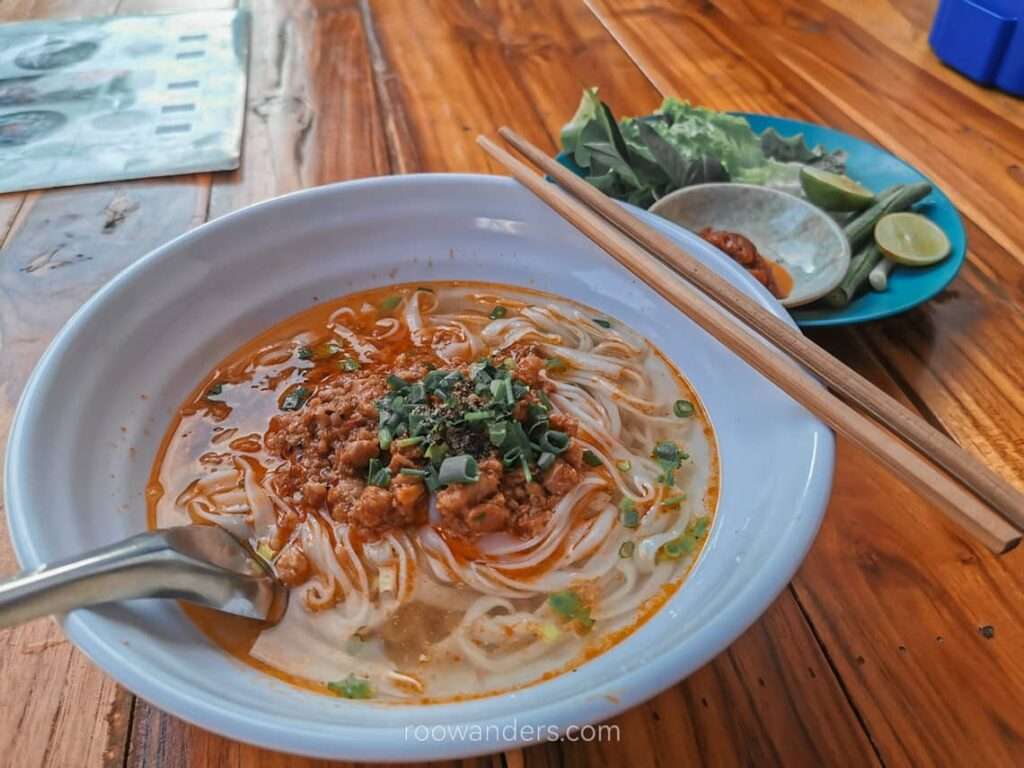
There’s more to the list that I did not get to try:
- Ping Hua Jai Kai. Grilled chicken hearts threaded on a stick.
- Naem Khao. Crispy deep-fried rice with pork, dried coconut and herbs.
- Sai Oua. Herbal Pork Sausages. Sausages made with loads of herbs and pork.
- Khao Jee Pate. Similar to the Banh Mi in Vietnam, and Num Pang in Cambodia.
Phrases to Remember
Lao sounds and looks similar to Thai . I’ve learnt to recognise the Thai numerals and certain useful phrases and found them handy in Laos. Use some basic Lao with the locals to break the ice and infuse some friendliness. If not, English and body language can still get you across.
Here are some useful phrases to help in your visit:
- Sai Bai Dee. Hello.
- La Kone. Goodbye.
- Khop Jai. Thank you. Add Lai Lai or Deu at the back to signify very much.
- Doi/ Bow. Doi means yes, and Bow means no.
- Khaw Toot. Sounds like Khor Thot in Thai, which means Excuse me, or I’m sorry.
- Baw Pen Nyang. Similar to Mai Pen Rai in Thai. Essentially, no worries .
- Soon. Zero.
- Neung. One.
- Saam. Three.
- Jet. Seven.
- Pet. Eight.
- Phan. Thousand.
- Meng. Ten thousand.
My One Week Itinerary
If you have only a week to spare – like me – and this is your first time travelling in Laos, focus your travel on the conventional Vientiane, Vang Vieng and Luang Prabang belt . Those looking to skip the temples could look into setting Luang Prabang as the base to get to hiking spots further north.
A summary of my itinerary below.
Day 1: Land in Vientiane . I landed late and toured the night market and vicinity.
Day 2: Vientiane to Vang Vieng . Toured Vientiane by foot before taking the mid-morning train to Vang Vieng. Rented a motorbike with a travel buddy to Tham Chang Cave, Nam Xay Viewpoint , Tham Poukham Cave and the Blue Lagoon.
Day 3: Vang Vieng. My travel buddy went for an early morning hot air balloon. We then rented a motorbike to visit the cluster of caves north of Vang Vieng (tubing into the Water Cave, trekking into Loup and Hoi Cave), and an elephant sanctuary. You could sign up for a tour that includes all those plus kayaking and zipline.
Day 4: Vang Vieng to Luang Prabang . Took the train to Luang Prabang, explored some temples, the royal palace-now-museum, and UXO museum, had coffee in a cafe, climbed Phousi Hill for sunset, and listened to Laotian folktales.
Day 5: Luang Prabang. Rented a motorbike to tour Pak Ou Caves and Tad Sae waterfall.
Day 6: Luang Prabang. Travelled to Kuang Si Waterfall , Buffalo Farm and had lunch at a rice plantation.
Day 7: Luang Prabang to Vientiane. Woke up early to spectate the alms, followed by another hike to Phousi Hill to catch the sunrise. Flew back to Vientiane in the afternoon, and caught the fountain show at Patuxai.
Day 8: Fly out of Vientiane. Rounded up the remaining attractions in Vientiane including COPE visitor centre and Pha That Luang. Flew out in the late afternoon.
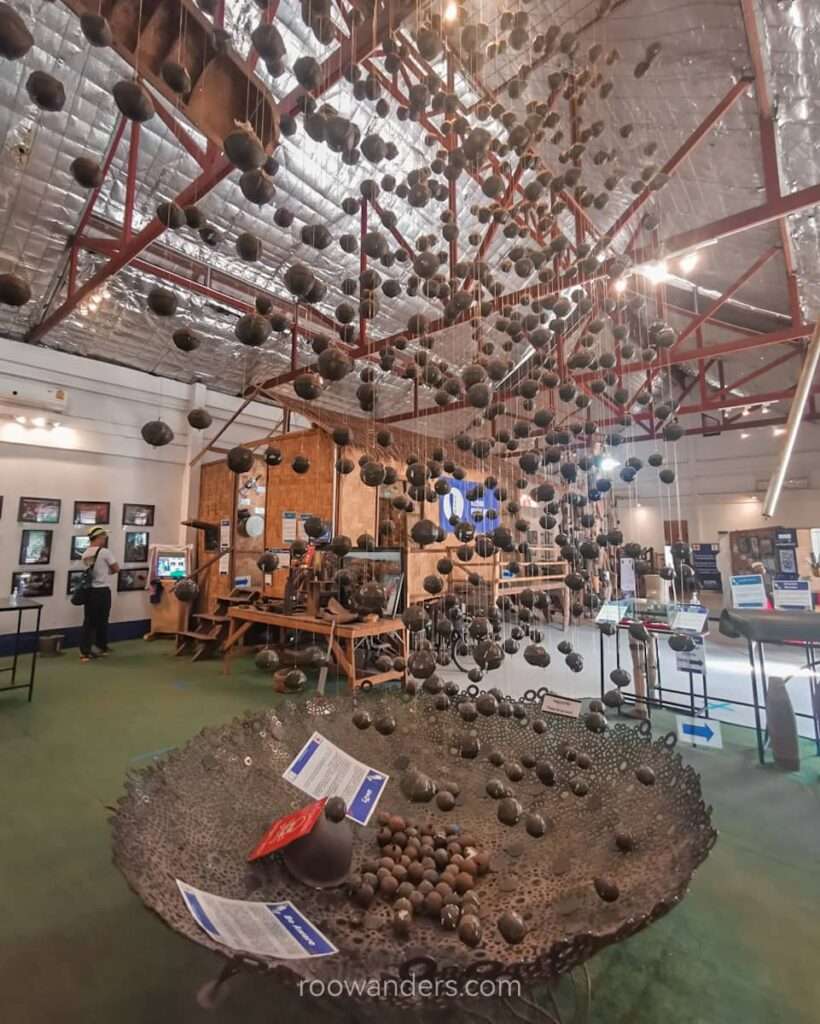
Laos is a delightful place to travel. While each of the Southeast Asian countries has its unique appeal, I found Laos – at least the places I’ve visited – less busy and practises a slower pace of life. And that was a nice contrast to the most hectic Southeast Asian country I came from!
This post serves as a tidbit and guide on what to expect for a Laos adventure. I expect myself to return to Laos again in the future, perhaps via the slow boat from Thailand to trek, and maybe another trip for the loops in the south. Till then! ✨

You May Also Like
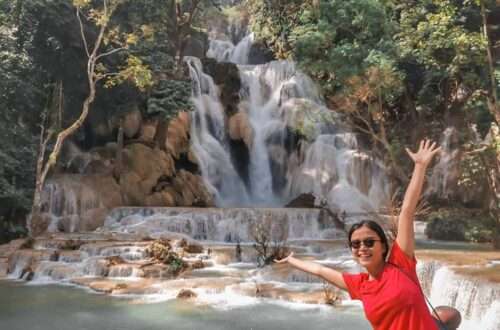
Kuang Si Falls: A Perfect Day Trip from Luang Prabang
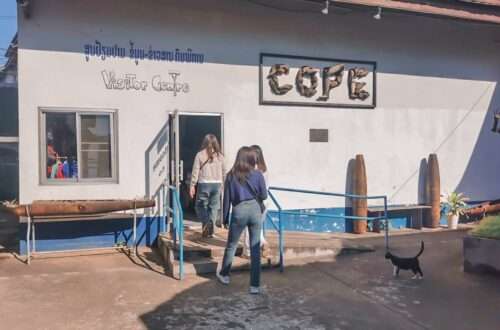
Visiting the COPE Visitor Centre, Vientiane
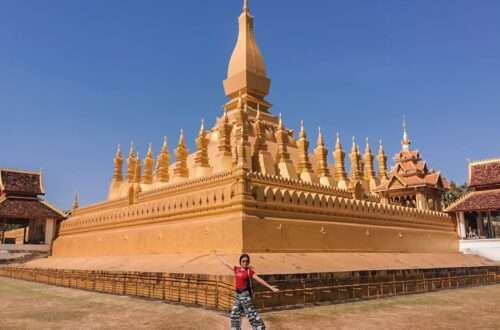
Vientiane To Dos: A Comprehensive Guide
Leave a reply cancel reply.
Your email address will not be published. Required fields are marked *
Save my name, email, and website in this browser for the next time I comment.
This site uses Akismet to reduce spam. Learn how your comment data is processed .
- Customized Tour
Laos – All things about Laos Country
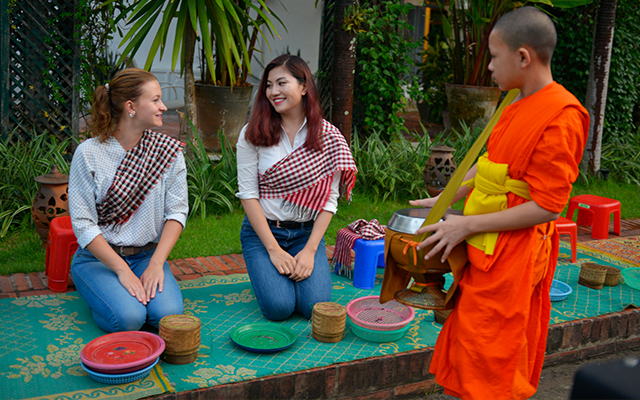
About Laos Country: 15 Things You Need to Know Before Visiting
Laos is one of the least explored countries in Southeast Asia, but it offers plenty of beautiful places to visit . With stunning waterfalls and nature-blessed beauty from North to South, travelers can explore natural landscapes, diverse cultures, and fantastic local life. Here you will find a list of things you need to know about this mystical country.
I. Location
Ii. time zone, iii. the best time to visit laos, crossing overland, flights to laos, v. language, vi. currency, credit cards & exchange money, vii. what to eat in laos, bus & minivan, ix. internet, x. electricity socket, xii. highlights of laos, xiii. safety, xiv. accommodation options.
Laos is located in South East Asia. It shares borders with Thailand, Myanmar, China, Vietnam, and Cambodia. It is the only landlocked country in the area, with the Mekong River as the primary body of water.
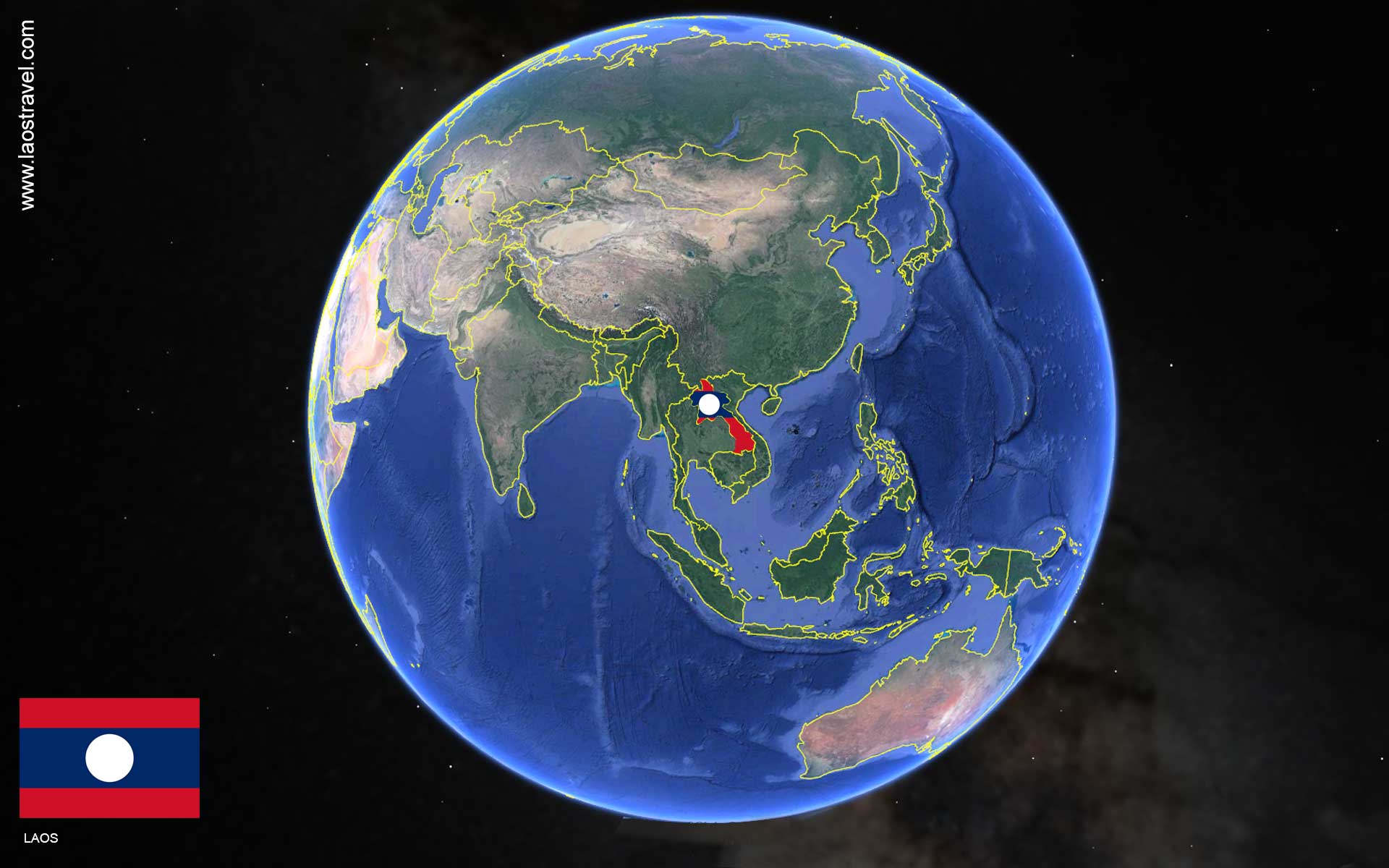
Laos is located in Southeast Asia
Time zone in Laos is GMT + 7 (UTC+07:00). It is 7 hours ahead of London, 15 hours ahead of Vancouver, 12 hours ahead of New York, 3 hours behind Sydney, and 5 hours behind Auckland.
Due to the shape of the country which stretches from China to Cambodia, the weather conditions vary from the North to the South. Due to higher elevation, the north of Laos is generally cooler and less humid than the South.
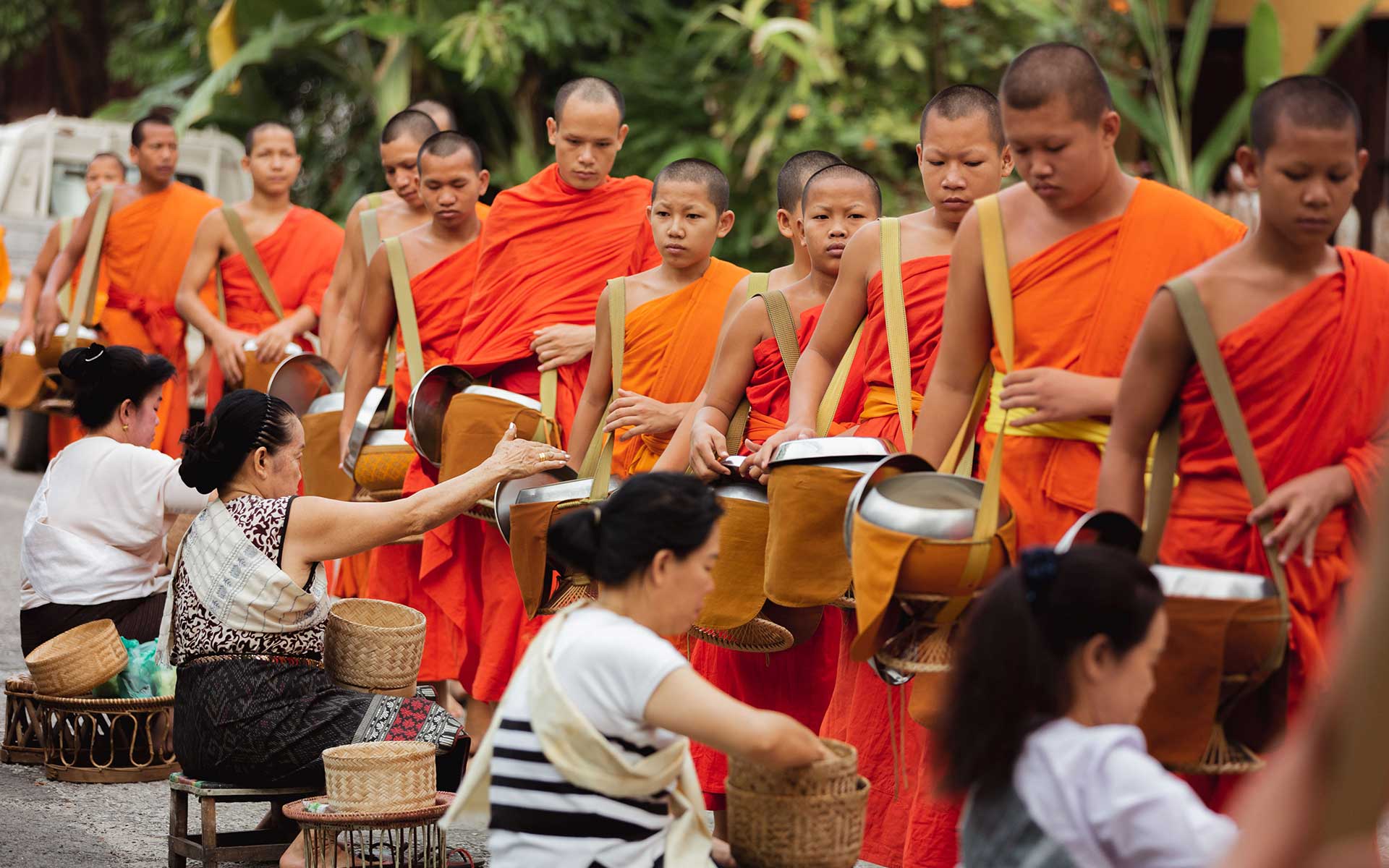
Almsgiving in Luang Prabang, a sacred ceremony for the locals and the monks.
Like most of Southeast Asia, Laos has a tropical climate with two distinct seasons: wet and dry. The rainy season runs roughly from May to September and the dry season from October to April. The coolest and driest months are from November to February when the temperature is under 30 degrees Celcius. This period is considered to be the best time to visit Laos. During this period, hotel price goes up and occupancy is always high.
Temperatures reach their peak in April and May when they rise to 35-40 degrees Celcius in the daytime. After that, rainfall tends to come in short and heavy bursts, which turns to a more constant downpour in the later months.
IV. Get in & Get out
As Laos is a landlocked country, besides flights, it is easy to reach it on land through neighboring countries.

Travelers can get into Laos through land border crossing points
Except for Myanmar, travelers can enter and exit Laos through many border points with Thailand, Vietnam, Cambodia, and China. If you plan to visit North Laos first, you can cross borders with China, Vietnam, and Thailand. The most popular border point is through Chiang Khong in Thailand to reach Huay Xay, Laos where you take a slow boat to Luang Prabang.
In case you want to enter or depart from the South of Laos, there is a border crossing with Cambodia at Nong Nok Khiene. It is 6km only far from 4000 islands in Champasak.
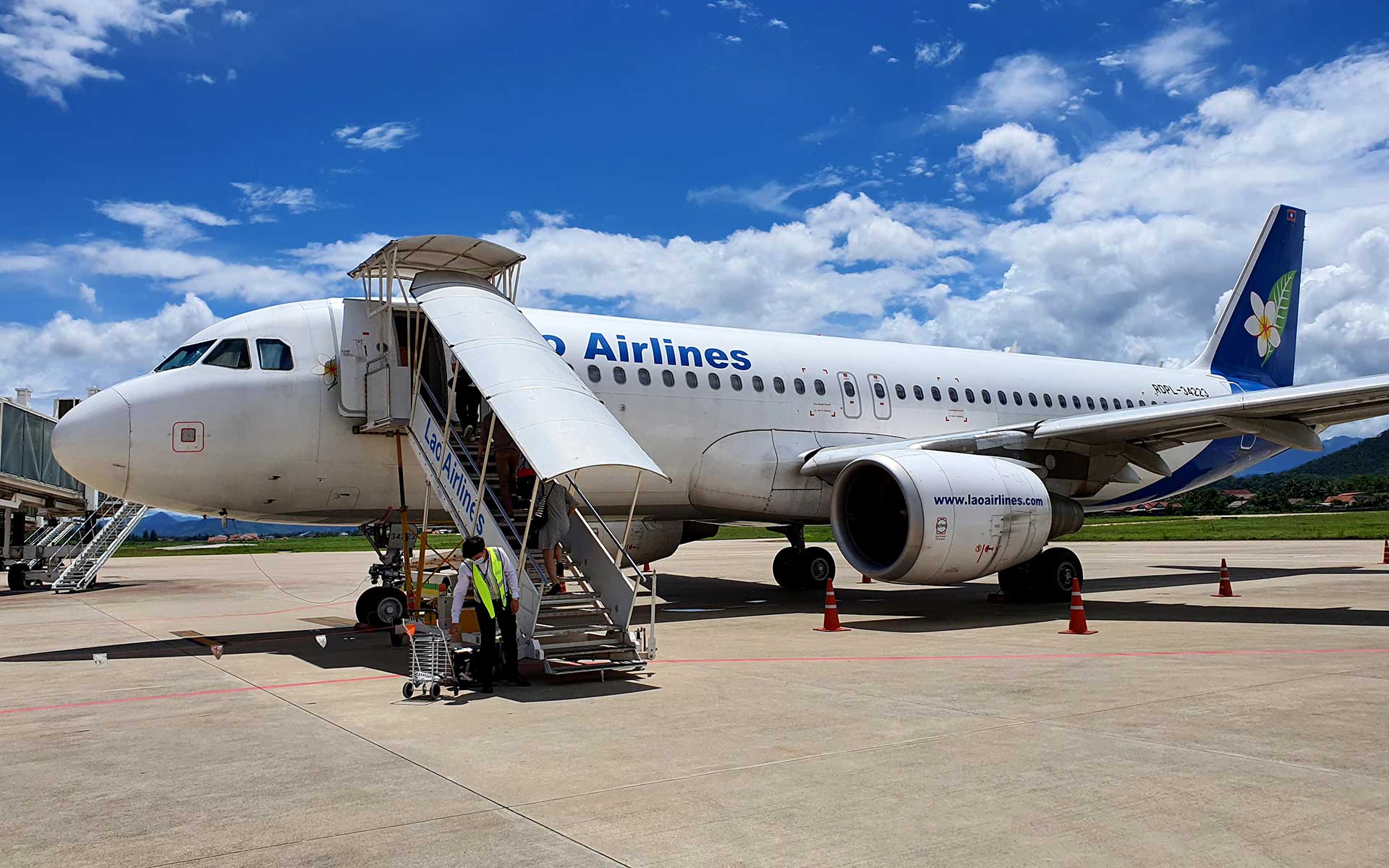
Most flights in Laos are operated by Laos Airlines.
Laos has four international airports as Luang Prabang, Vientiane, Savannakhet, and Pakse. Travelers mainly fly into either Vientiane or directly into Luang Prabang. Both airports have international flights as well as connections throughout Southeast Asia. Travelers who come from Euro or US need to transit in Thailand or Vietnam to connect with flights to one of these airports. Choosing which airport to use depends on your itinerary while in Laos.
The flights to Pakse and Savannakhet are limited as only Laos Airlines operates flights through these airports.
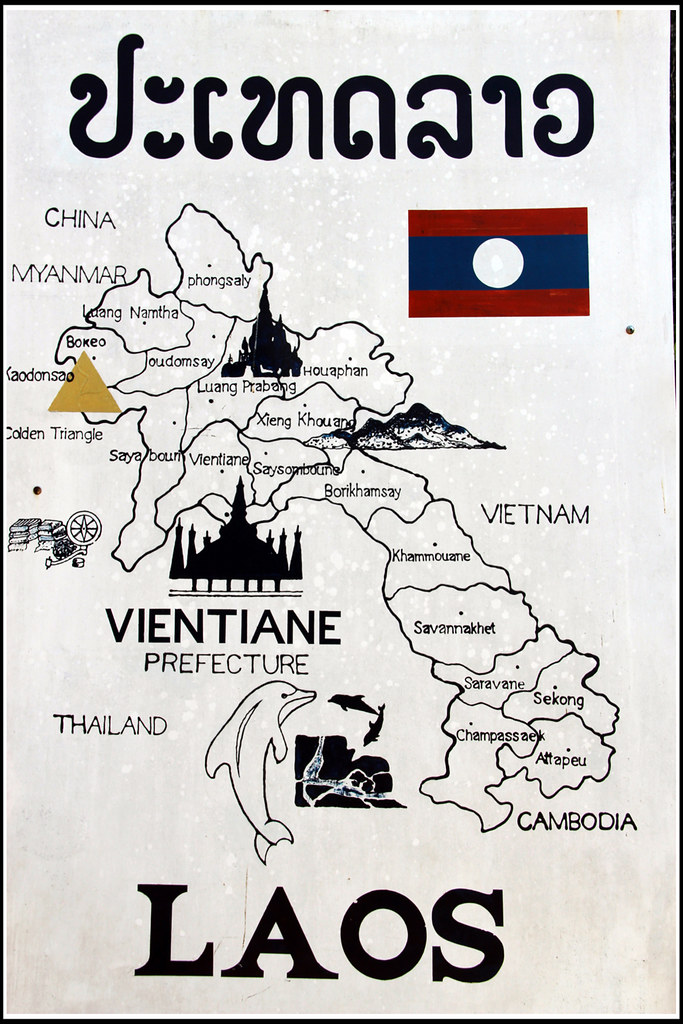
A map of Laos
The official language of Laos is Lao, a Southeast Asian language closely related to Thai. Laos was once a French colony, but French is no longer widely spoken. English is used in main tourist destinations and bigger cities. However, do not expect everyone to speak and understand English, especially in the countryside. Therefore, you will have to rely on non-verbal communication, something the Laotians are very good at.
In the North where many Chinese immigrants and ethnic minorities live, Mandarin and minority languages are spoken as well. Learn more about Laos languages here
The local currency in Laos is Lao Kip. The Kip is available in 50,000K, 20,000K, 10,000K, 5000K, 2000K, 1000K, and 500K notes; there are no coins in circulation. The Lao Kip is a weak currency with an exchange rate of around 8.800 LAK to 1 USD. Be aware that banknotes are very similar to each other and will cause mistakes if you don’t pay attention to them.
USD and Thai baht are also widely accepted. Although Laos law forbids the use of foreign currencies to pay for goods and services, many big hotels, restaurants, and shops still accept Thai baht or US dollars in place of kip, usually at a fairly decent exchange rate.
ATMs are available in Laos but only in main cities like Vientiane, Vang Vieng, Luang Prabang, Xieng Khuang, and Pakse. As in Thailand and Cambodia, every time you withdraw money w ith a foreign card, you get an ATM charge of up to 20 000 kips (2.5 USD).

Currency exchange shop in Laos
Major credit cards (Visa and Mastercard) are accepted at upmarket hotels and restaurants in Vientiane and Luang Prabang and in a limited number of other tourist centers. You will be charged up to 5% to pay directly with it.
Money exchange can be done at banks or money exchange shops. Most towns have a bank with basic exchange facilities – usually dollars and baht. Travelers’ cheques are now accepted at many banks and a wide variety of international currencies can often be changed, including euros and sterling. The changing fee is around $1 per cheque. Money changers are common in larger towns, and rates are generally a little lower than the banks.
In general, cash is still a king in Laos. If you arrive in Laos from overland or going to remote areas, make sure you have some Cash (Thai Bath, US$, EUR) along to exchange to local currency. It’s not possible to convert money to or from kip outside of Laos. Be sure to exchange all your kip before leaving the country.
Lao cuisine is heavily influenced by Thai food but has fewer options of street foods. Popular dishes that you can find everywhere are simple noodle soups, curries and rice. Instead of regular steamed rice, Lao people eat sticky rice. This is glutinous rice that’s rolled into balls, then serve with meat and vegetables. Laotians like their food spicy, but they separate chili on the side for everyone to add. Be sure to try the larb, the national dish of Laos. It can be described as a type of spicy, cold meat and papaya salad.
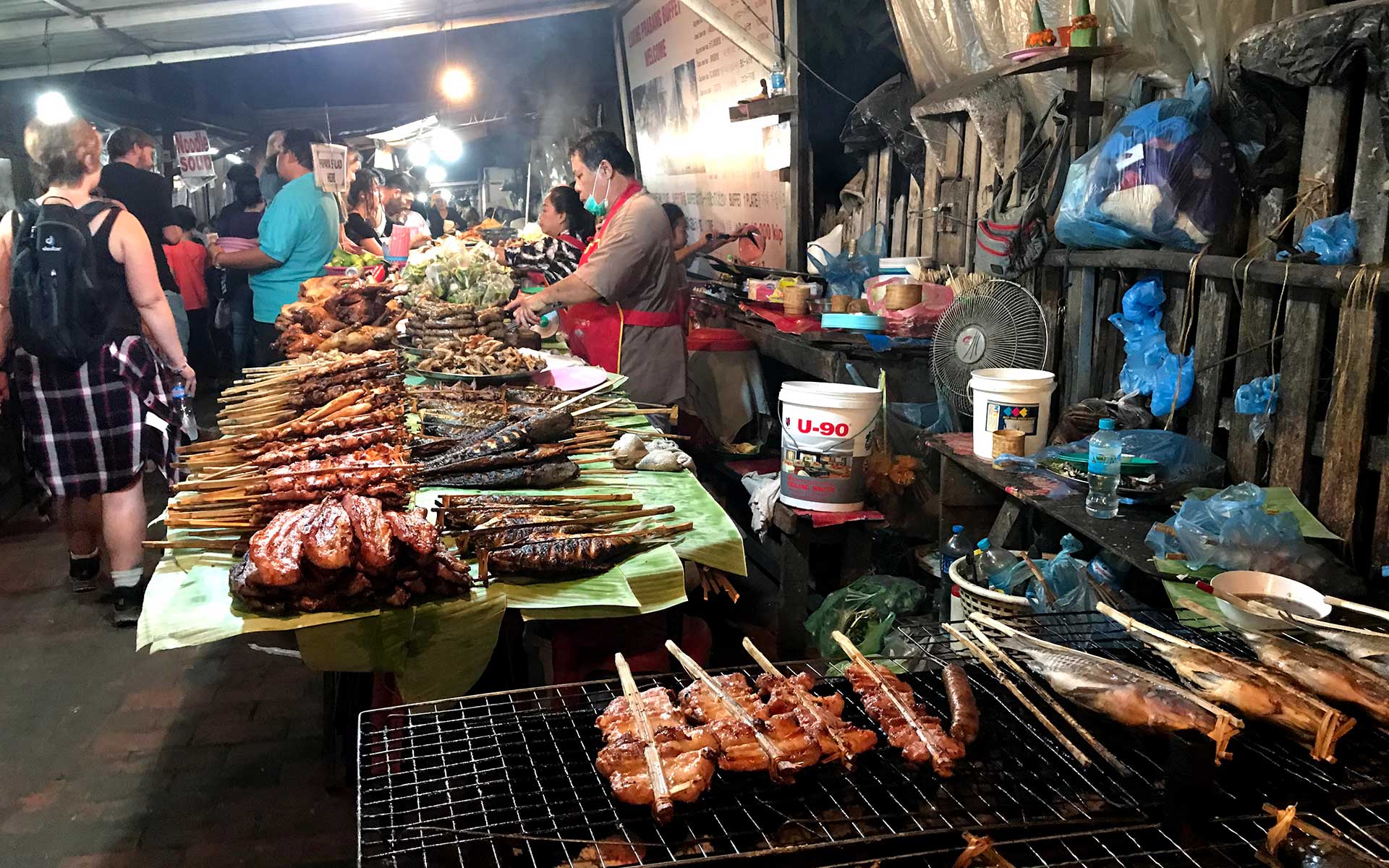
Food stalls at a night market
French influence is also visible. It means you can find bread, pastries, cookies … everywhere. There are fantastic fusion French restaurants in Vientiane and Luang Prabang. All food in Laos gets washed down with Beer Lao, the national rice beer or Lao Lao, rice whiskey.
VIII. Get around the country
The train is not available in Laos. Over the years, there have been plans and aborted attempts to build a railroad system in Laos but for now, you cannot get around by train. As a tourist, you have several options for getting around in Laos as flights, boats & buses.
Flights within Laos are scarce. The aviation in Laos nearly has no competition when Laos Airlines operates most of the domestic routes. There is another airline called Lao Skyway but its schedule is very limited and the flights are not reliable. As the result, airfare in Laos is quite high if compared to neighboring countries as Thailand or Vietnam.
Vientiane is the biggest city where you can look for flights to remote areas such as Luang Namtha, Oudomxay. From Luang Prabang or Pakse, it is possible to fly to the main attractions only.

Nice view of Laos nature from the airplane.
The river systems in Laos are often the next best way of getting around locally in Laos. Tourists prefer traveling by boat between Huay Xai border and Luang Prabang. It is relaxing, much smoother than the bus, and you get to see the amazing views of northern Laos and the Mekong. In the South of Laos, you can travel by boat from Pakse to visit highlights as Wat Phou temple or 4000 islands.
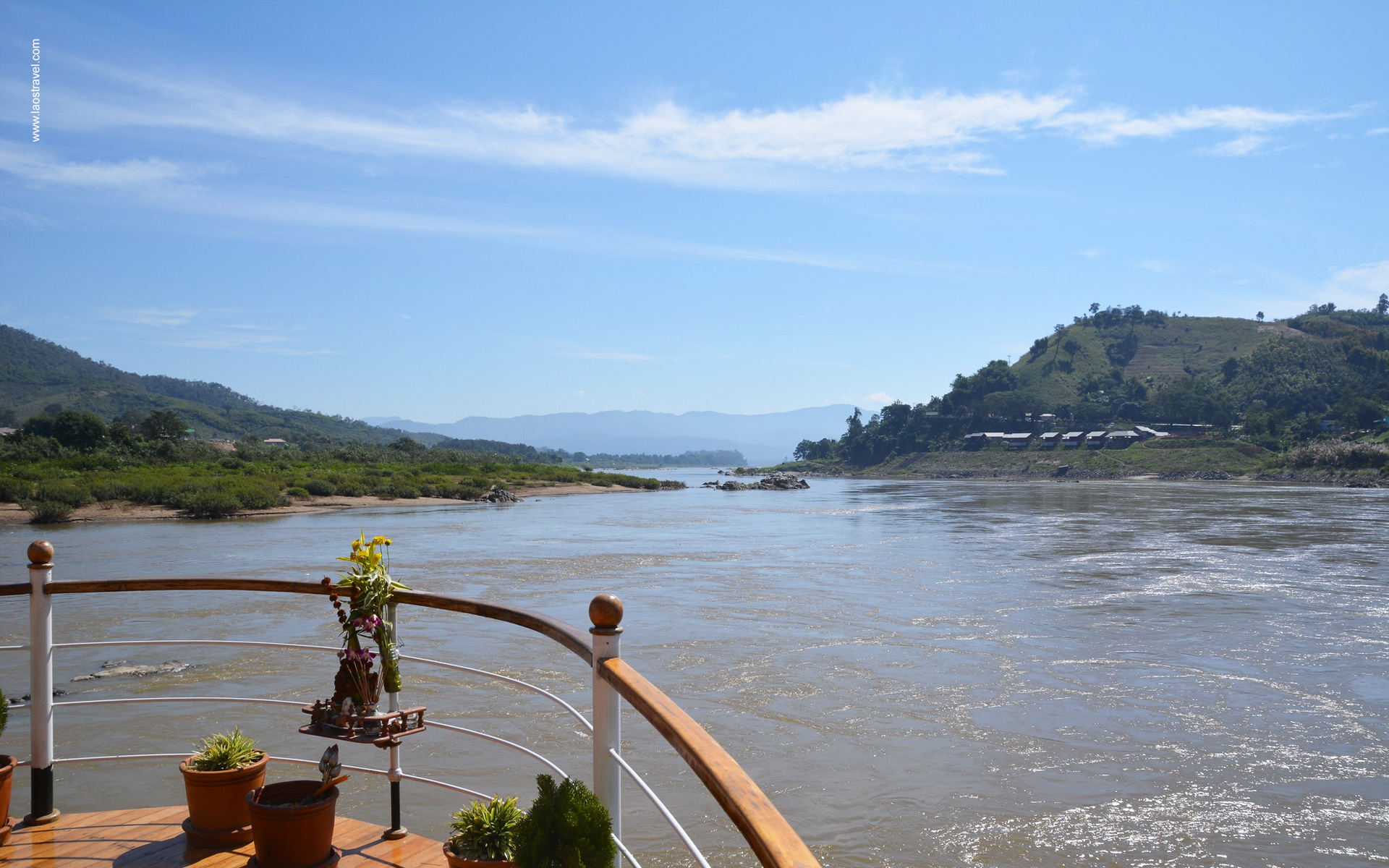
Boat trip on Mekong river with stunning view of surrounding mountains
Buses and minivans are the most popular means of transportation for both tourists and locals as few people own a car. Big touring buses drive between bigger cities and tourist destinations. Tourist buses are quite comfortable with standard flatbeds. Although buses are more comfortable, minivans are faster and sometimes the only option.
Traveling overland in Laos is very slow. A simple 200 km bus ride can take all day. Road condition is not good. Normally, drivers cannot drive faster than 60 km/h. In some routes in the north, they may drive at only 15 or 20 km/h. Another thing that makes the trip take so long is that the bus driver stops anywhere to let people on and off.
However, it is more affordable and exciting to travel overland. If you are not in a rush, taking the local bus or minivan is a fun cultural experience. In Laos, people can seat on small plastic chair which are places in the corridor if all seats are full. I believe it will be something new for you. Besides, you can see that buses transport everything, from motorbikes in the top of the bus to live animals in the luggage compartment.
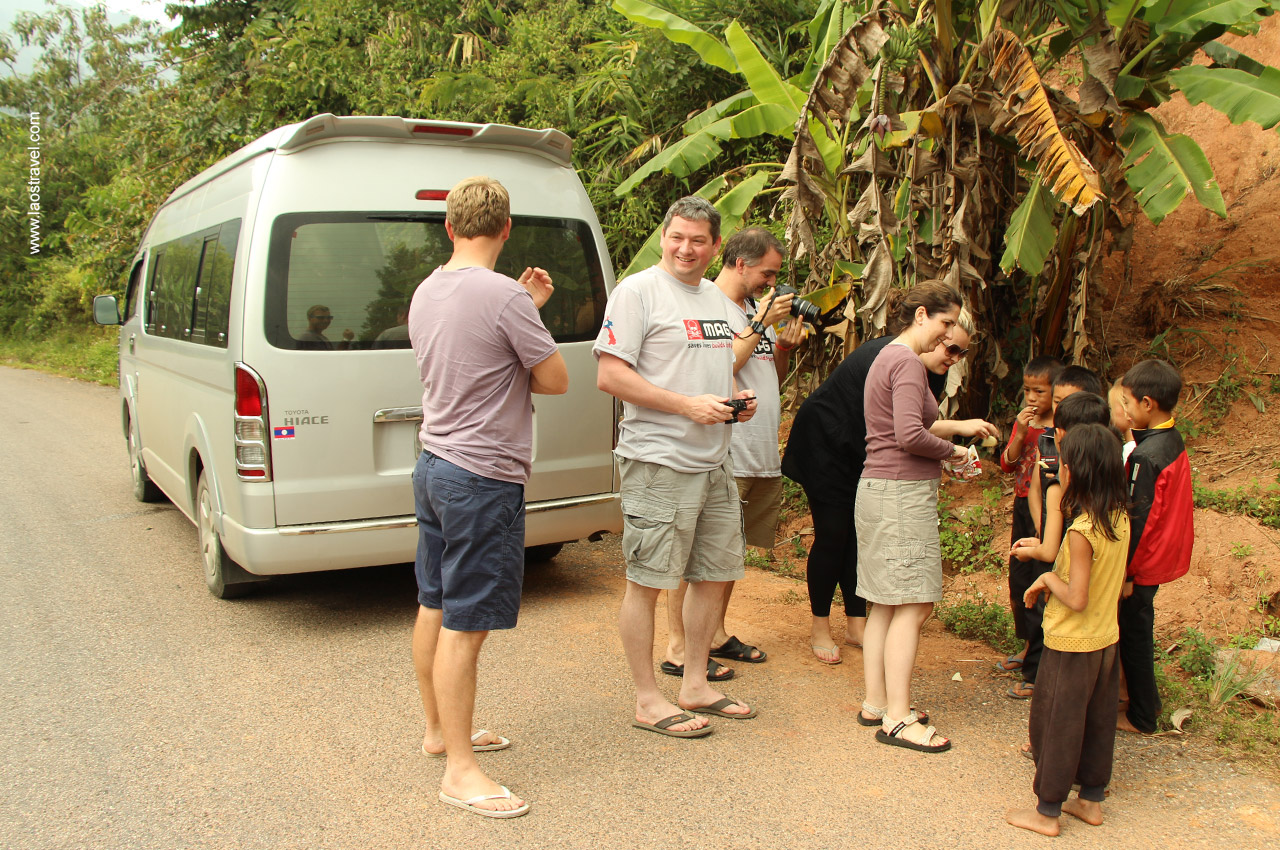
Travel by private car with Laos Travel
Once at your destination, you have a choice of walking, tuk-tuk or motorbike. Motorbikes are a fun mode of transportation to explore your surroundings with, but it is recommended only when you have experience with unpaved roads in Southeast Asia. Another option is to take a tuk-tuk for short rides or even hire a driver for the day to drive you around as a guide.

Data package price in Laos
The internet in Laos is quite widespread throughout the country via several options. Many hotels offer decent Wifi connections. However, some remote areas don’t have hotels with free Wifi or some hotels require you to head down to the lobby to access it. It is not a problem as you can use 3G/4G SIM card instead. Unitel and Lao Telecom are the two largest telecom providers in Laos. They both have 4G coverage countrywide, so they are better than other providers. It is easy to buy their SIM card when you arrive.

Two – prong socket in Laos
In Laos Electricity is 230V, with a frequency of 50hz . Power outlets are two-prong round or flat sockets. A power adapter should not be needed if you come from North America or Europe. To avoid to buy new adapters for everywhere you go, you can use Travel Adapter.
Visa to Laos is quite simple. Whether you enter the country by air or through border crossing, you can get 30-day Visa on arrival. A few countries are exempt from a visa for Laos altogether, so always check beforehand.
To receive the visa, your passport must be valid for at least six more months and have a blank page. You also need two passport–sized photos and cash to pay for Visa fee. The fee ranges between 30 and 42 USD, depending on your nationality. Often you will end up paying another dollar or two in “administrative fees”.
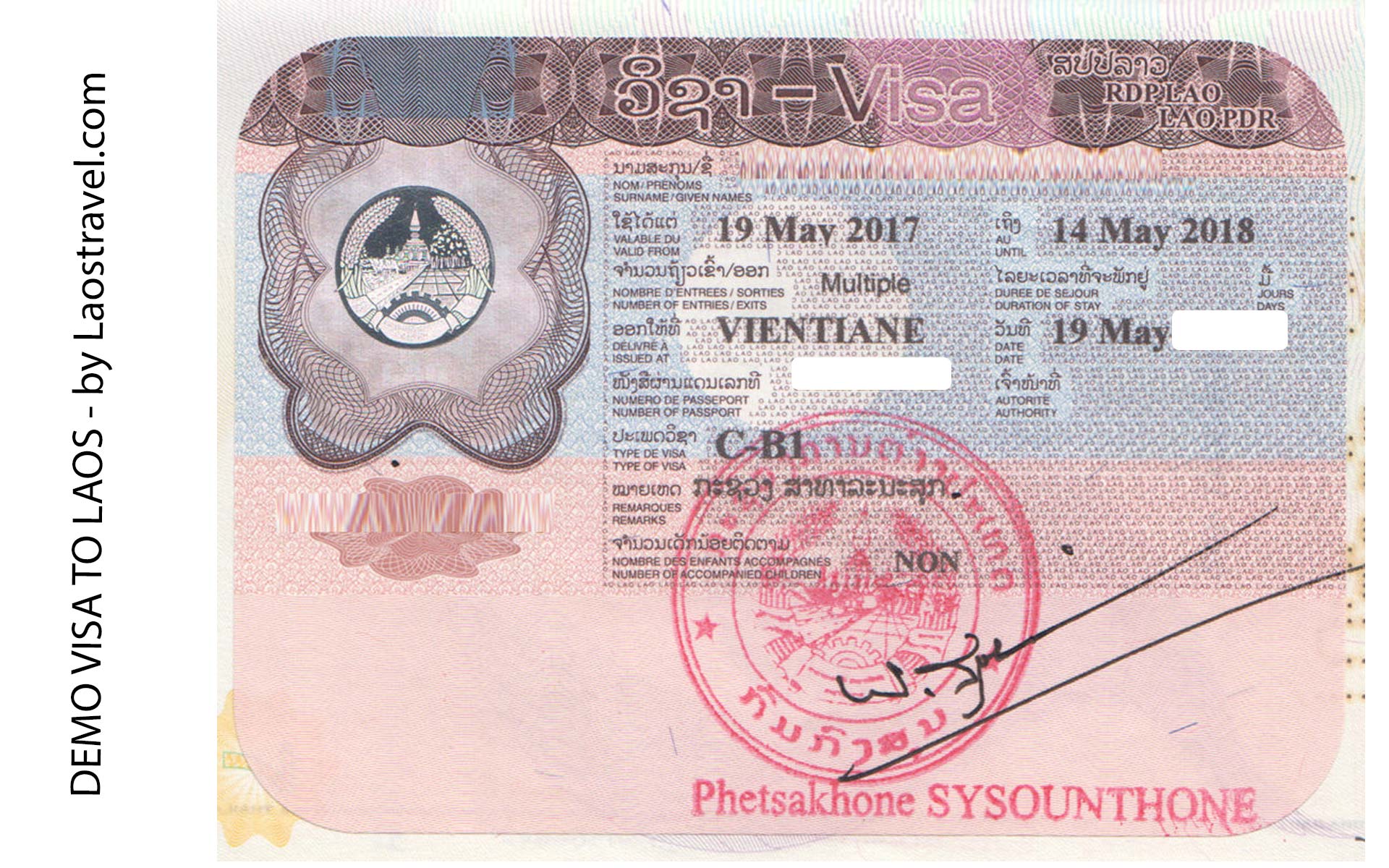
Laos is a beautiful country with diverse landscapes and impressive cities. The north is widely regarded as the most beautiful part of the country, with jungle, waterfalls and mountains. This is also where the three main cities of Laos, Vientiane, Luang Prabang and Vang Vieng are located. Vientiane is the capital, but much smaller and quieter than Bangkok or Hanoi. Vang Vieng is a paradise for outdoor sports. Luang Prabang is the UNESCO World Heritage protected city centre with beautiful colonial architecture and traditional Buddhist temples.
In the North, it is a pity if you miss Plain of Jars. It is a collection of large stone jars interspersed throughout the Xieng Khouang plain in the Lao Highlands.
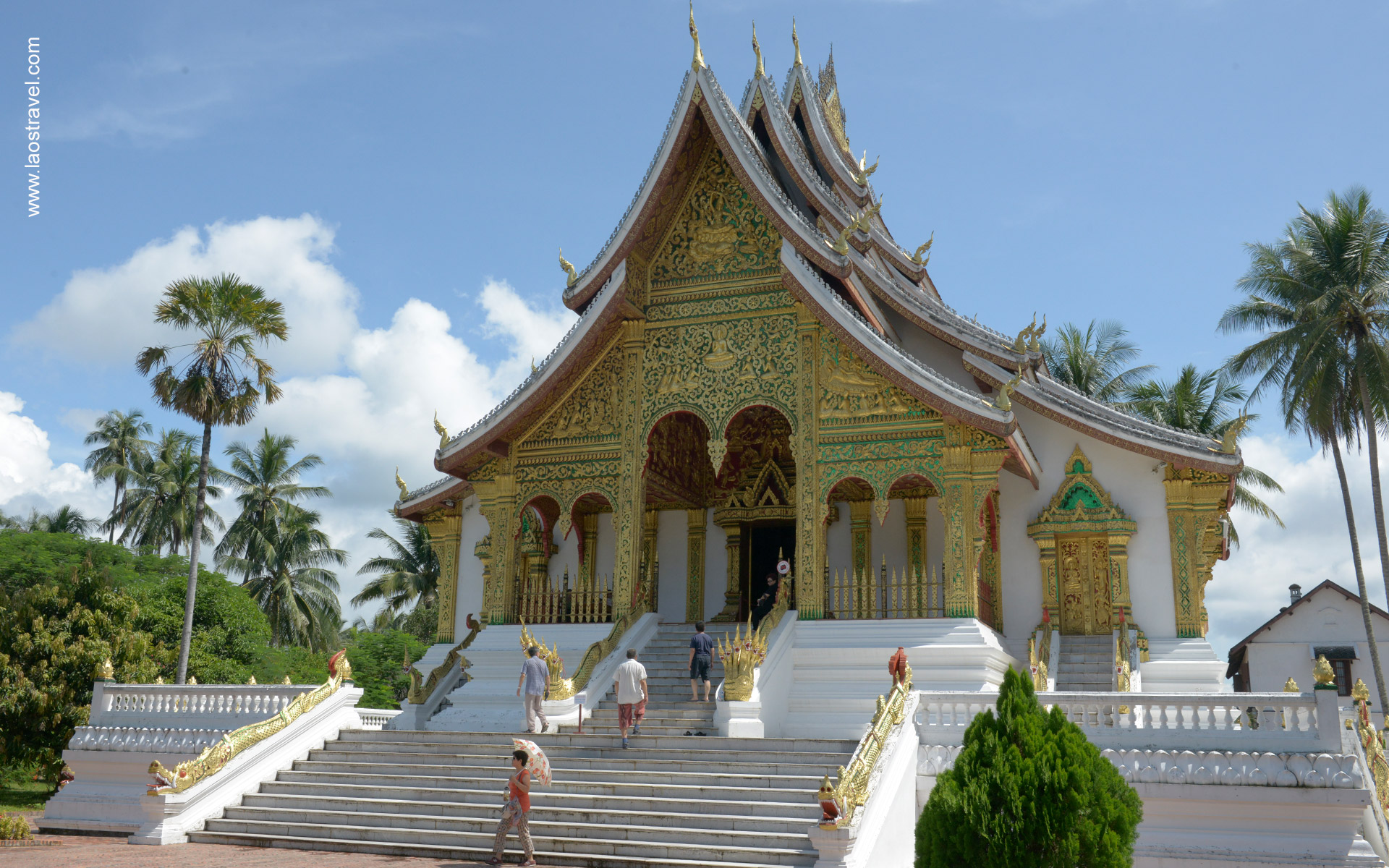
Royal Palace, Luang Prabang
Towards the south, Pakse is well – known for UNESCO World Heritage Wat Phou, a ruined Khmer Hindu temple complex. Even further down lie the 4000 islands, where you’ll find the only beaches in Laos. Although the islands in the Mekong delta may lack salty air, but they still bring laid-back island vibes. Besides, you can visit the biggest waterfall in Southeast Asia, Khone Phapheng Falls here.
Laos is a relatively safe country with low crime rates. However, in busy places such as Vang Vieng, Vientiane and Luang Prabang, you should keep an eye on belongings and watch out for pickpockets. The low quality of the roads makes traffic the most dangerous aspect. Be especially careful when renting and driving motorbikes and always wear a helmet.
During the Vietnam War, Laos became the most bombed country in the world. Millions of unexploded cluster bombs are still strewn across the country. Always respect warning signs in the destinations you go.
Accommodation in Laos have four types to choose from: hotels, hostels, guesthouses and homestays. Regular western hotels and hostels are available in the bigger cities. Hotels in Laos are usually not as modern as in Thailand and Vietnam but prices are higher. Basic hotels costs around US$ 40 – 50 per night while luxury hotels can be around US$ 200 per night.
In the countryside and villages, you will not have other choice than guesthouses and homestays. Traditional Laotian guesthouses are a bit old-fashioned but comfortable and usually very affordable. Homestays are a great option if you want to interact with locals and experience their life. These are a common type of accommodation on treks and village tours.
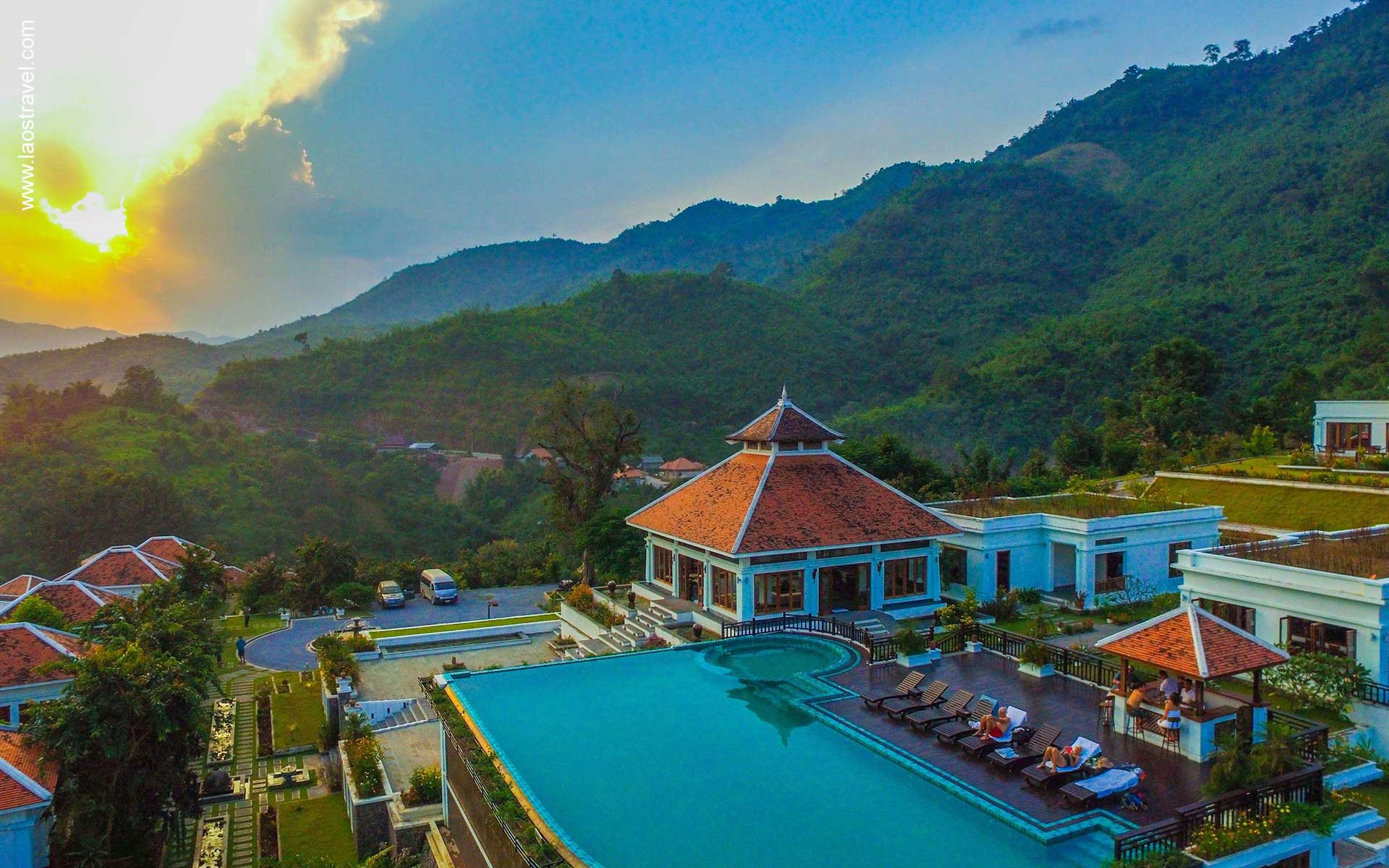
Relax by pool and immerse yourselves in unspoiled nature
XV. Culture
Laos is a Buddhist country, which heavily influences daily life and culture.
According to Buddhist custom, touching someone’s head or pointing your bare feet at them is considered very rude. Feet are considered low and unclean, so do not step over any part of people who are sitting or lying on the floor, as this is also considered rude.
When you visit Buddhist monasteries, there are strict rules you must follow: dressing conservatively, remove footwear and hat. Women should never touch Buddhist monks or novices (or their clothes), or hand objects directly to them. When giving something to a monk, place it on a nearby table or passed to a layman who will then hand it to the monk. Don’t touch Buddha images. When sitting on the floor of a monastery building that has a Buddha image, never point your feet in the direction of the image.
Laotians tend to be calm, warm-hearted and friendly people who always have a smile on their face. They often go out of their way to help visitors. Avoid raising your voice and showing anger emotions to them. The Laos people like to balance between work and relaxation. They love to spend quality time with friend and family, often accompanied by plenty of food and drink. Especially in rural areas, you may find people inviting you to join them for a meal or to celebrate a birth or marriage.
It is polite to join them and to accept at least one drink if it’s offered to you. It gives you a chance to experience local life, gives Lao people a good impression of the tourists and learn more about the world.
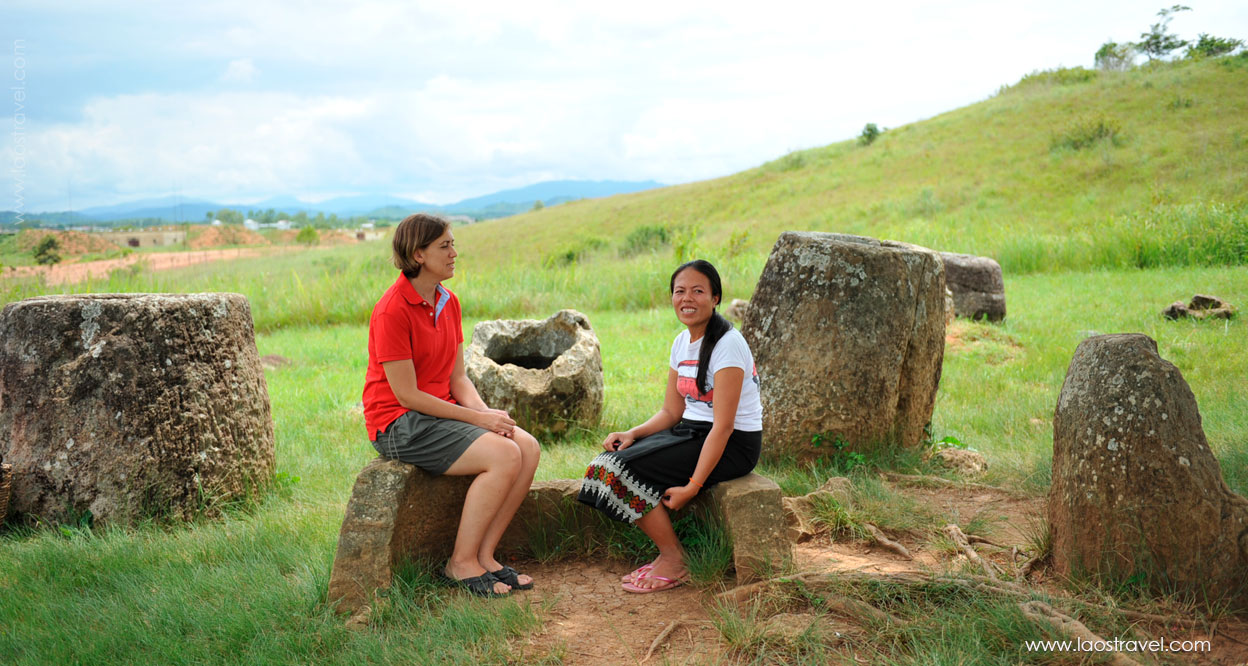
Plain of Jars, Xieng Khouang
Although no one will expect you to speak fluent Lao, it is nice to say few basic words and phrases, such as “sabai di – hello” and “khop chai – thank you” with smiles on your face.In Laos, greetings are usually accompanied by the gesture known as a ‘nop ’. People place two hands together in a prayer position at chest level. This indicates the level of respect for another person and is an acknowledgement of seniority.
A nop may also be used as an expression of thanks or regard. Most Laos people reserve the nop greeting for each other, preferring to shake hands with Westerners. Foreigners can receive a nop from the staff of upmarket hotels or fancy restaurants. In any case, it is best to reply with a smile and nod of the head.
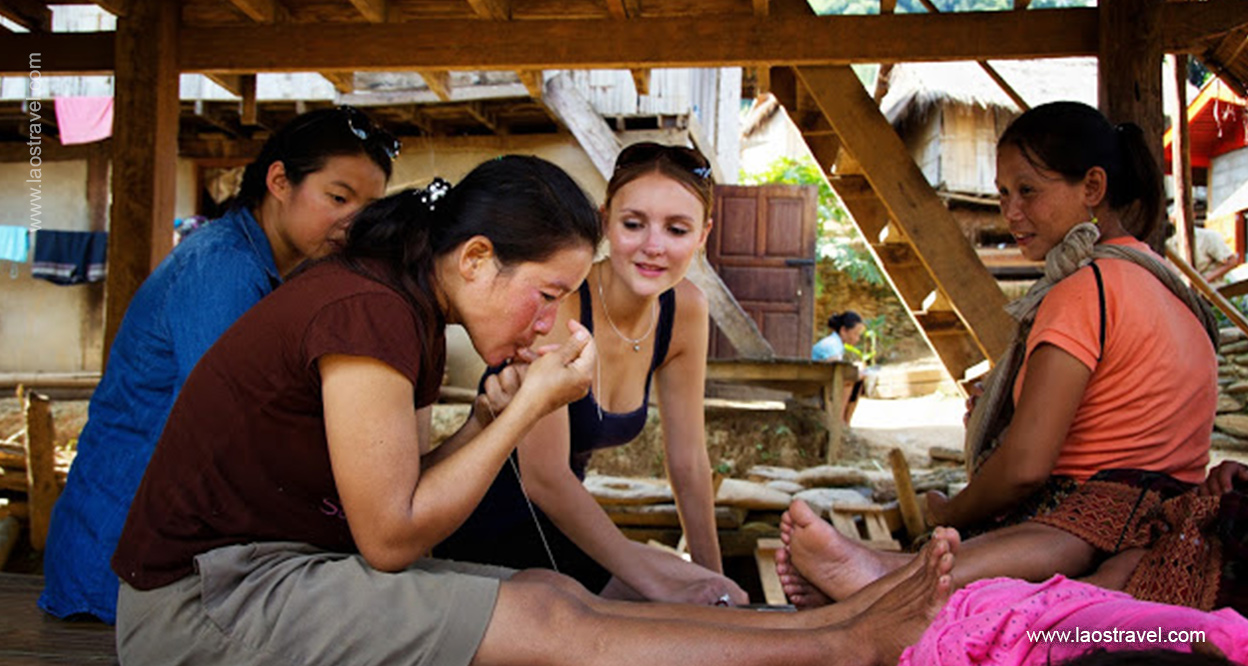
Local people are friendly, calm & warm – hearted
Laos is very traditional country, so body-revealing clothes should be avoided including shorts and sleeveless shirts. Conservative dress is always recommended. The Lao dislike foreigners who come to their country and dress in what they deem a disrespectful manner. This includes men appearing shirtless in public, and women bearing their shoulders and thighs. When in urban areas or visiting Buddhist monasteries or holy sites, visitors should cover your body from shoulders to knees.

Dress modestly in Laos
Related Posts
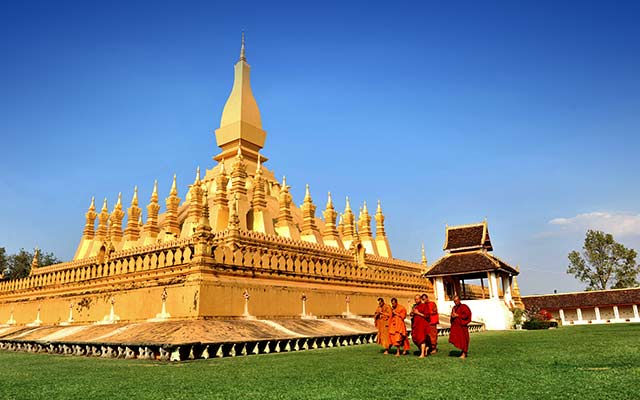
27 Top-Rated Tourist Attractions in Laos
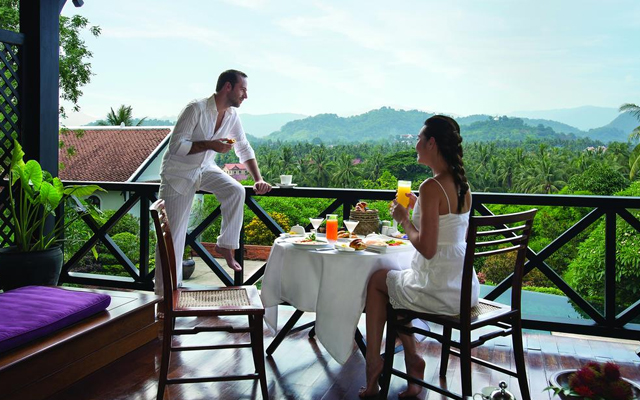
Places to Visit in Laos: A Travel Guide
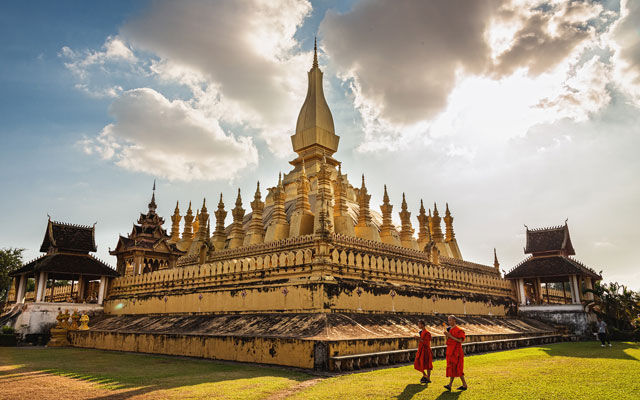
The Best Things To Do & See in Laos in 2024
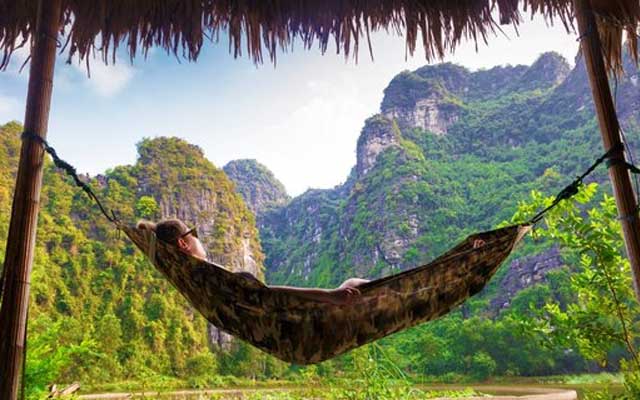
5 best Laos private tours you should know
Leave a Comment Cancel comment
Request a free quote, thank you we have received your travel request. you will receive an email shortly. please check your email and verify the information. your request will be processed after your confirmation..
You have chosen a tour duration longer than 20 days. Please specify the exact number of days you want to travel in the message box below, so that we can have enough information and make a program for you. Thank you for your cooperation.
You have selected a number of travellers greater than 20. Please let us know the exact number of people in your group in the message box below so that we can quote you accurately. Thank you for your cooperation.
You have selected a number of travellers and duration greater than 20. Please let us know the exact number of people in your group and the exact number of days in the message box below so that we can quote you accurately. Thank you for your cooperation.
Our Recommendations
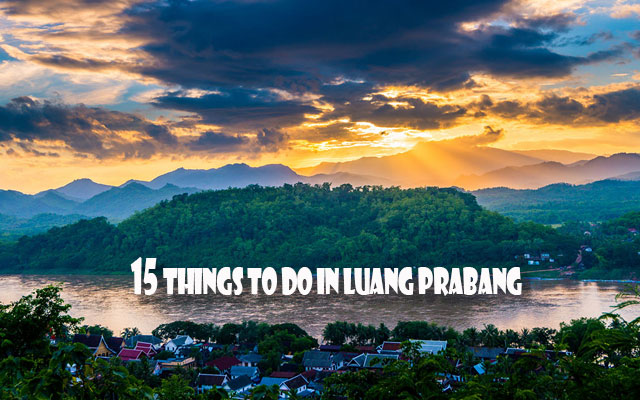
Things to do in Luang Prabang
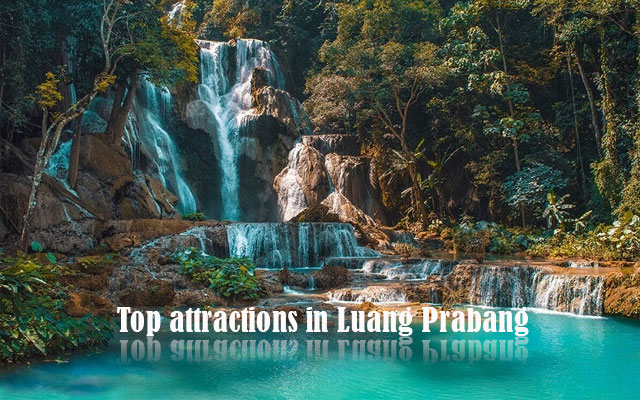
15 Top-Rated Tourist Attractions in Luang Prabang, Laos
You may also like

Laos Flag Meaning & Full List Of National Flag of Laos Since 1353
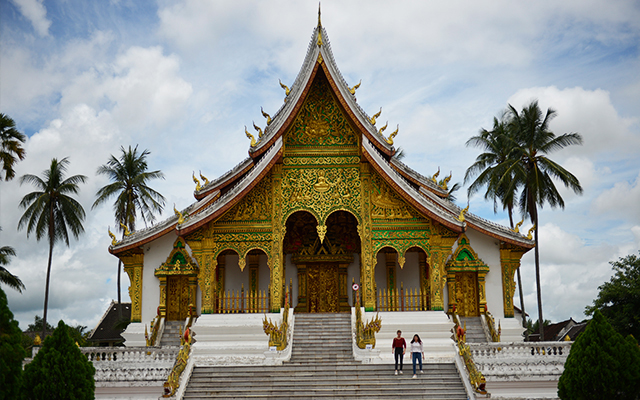
How to Travel from Siem Reap to Luang Prabang?
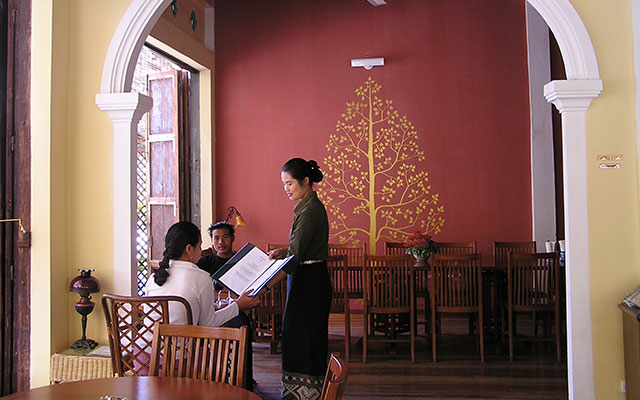
Best restaurants in Luang Prabang, Laos
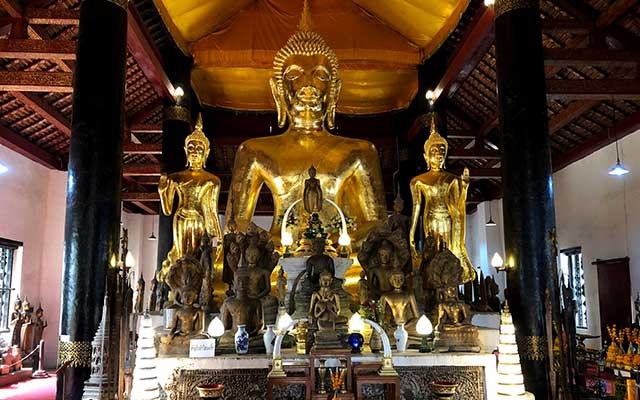
Wat Visoun, Luang Prabang

(LEAD) N. Korean delegation visits Laos: KCNA
(LEAD) NK delegation-Laos
SEOUL, March 31 (Yonhap) -- A North Korean delegation led by a senior official visited Laos and stressed the North's policy of bolstering defense capabilities, the North's state media reported Sunday.
Kim Song-nam, director of the international department at the North's ruling Workers' Party of Korea, met Thongsavanh Phomvihane, head of the Lao People's Revolutionary Party's external relations committee, last Friday, according to the report.
Laos is the final leg of Kim's three-nation trip that also took him to China and Vietnam.
Kim also paid a courtesy visit to Thongloun Sisoulith, the secretary general of the Communist Party of Laos.
During the meeting, Kim said North Korea would bolster "comrade-like and strategic" cooperation with Laos, according to the report.
Kim's trip appears to be aimed at strengthening North Korea's ties with countries sharing the socialist ideology after South Korea established diplomatic relations with Cuba last month. Pyongyang has long boasted brotherly ties with Cuba.
Laos is scheduled to host an annual regional security meeting, the ASEAN Regional Forum, later this year.
North Korea has not sent its foreign minister to the forum since 2019, and the North's delegation's visit to Laos raised speculation on whether the North's top diplomat, Choi Son-hui, would attend the security gathering this year.


IMAGES
VIDEO
COMMENTS
Day 3: Luang Prabang to Vang Vieng. One of our many drone stops along Route 4 en route to Vang Vieng. The next stop on your Northern Laos itinerary will be Vang Vieng. To get there, you can catch a bus from Luang Prabang for about $9 USD per person, or by driving.
Northern Laos. The Luang Nam Tha Museum contains a collection of local anthropological artefacts, such as ethnic clothing, Khamu bronze drums and ceramics. There are…. 1. 2. Discover the best attractions in Northern Laos including Vieng Xai Caves, Nam Ha NPA, and UXO Information Centre (MAG).
Northern Laos. Laos, Asia. Whether it's for trekking, cycling, kayaking, ziplining or a family homestay, a visit to northern Laos is for many the highlight of their trip. Dotted about are unfettered, dense forests home to big cats, gibbons and a cornucopia of animals, with a well-established ecotourism infrastructure to take you into their heart.
Follow me to the Northern part of my favourite South East Asian country. 4 best places to visit in Laos, Northern part. Overview. Vientiane. Kasi. Vang Vieng. Luang Prabang. Average budget for a solo travel in Laos. 10 to 25$ a day, on a budget.
Home Travel Asia Southeast Asia Laos Northern Laos Itinerary: The Perfect 10-Day Loop. This loop Northern Laos itinerary starts and finishes in Vientiane, Laos' capital city. It doesn't exactly look like a loop on the map because you actually need to take the same road to leave and go back to Vientiane.. The itinerary covers the two main gateways in the north of Laos - Vang Vieng and ...
Plan a wonderful trip with our Northern Laos travel guide. The most comprehensive tourist guide for Northern Laos, Laos with advice on things to do and see, places to visit and more. ... The cultural and ethnic ancestors of the Lao people, the Tai, originated just to the north in China's Yunnan province. The People of Laos. Northwestern Laos ...
The best time to visit Nong Khiaw is from November up until March. Outside of these months, it can get very hot and especially very wet. The north of Laos can receive up to 600 milliliters of water per square meter in July and August. I visited Nong Khiaw in January and the weather was perfect for hiking.
While Laos is firmly on the Banana Pancake Trail, you can still travel independently and get off the beaten path. Rent a motorbike or a bicycle and explore. Talk to locals. Eat at places that aren't #1 on TripAdvisor. Regardless of how busy the north of Laos is becoming, there are still places waiting to be discovered. Nong Khiaw and Muang Ngoi
A perfect one week Laos itinerary can be enjoyed in Laos' lesser known southern parts, which ranked high on our travel radar. Easy to combine with Cambodia's jungle covered templed in Siem Reap! Our Southern Laos itinerary included stops in sleepy Paksé (2 nights), the Jungle of the Bolaven Plateau (3 nights) and the relaxed shores of Don ...
This site is owned by Apa Digital AG, Bahnhofplatz 6, 8854 Siebnen, Switzerland. Rough Guides® is a trademark owned by Apa Group with its headquarters at 7 Bell Yard London WC2A 2JR, United Kingdom. Far North Laos - Plan your trip to Laos with Rough Guides and get travel tips and information about where to go and what to do.
Laos itinerary for 2 weeks. This route is an expansion of the classic Laos route, taking in more of the north. If you have the time I highly recommend it, as you'll be visiting a few less-trodden places and see a different side of Laos. Many travelers consider the north of Laos the most scenic.
Hidden Charm of Northern Laos. Luang Prabang - Nong Kiau - Muong La - Luang Nam Tha - Muong Sing. 10 Days/9 Nights. . Any trip to Laos is even better with a detour through the mountains of the North! Northern Laos loop hosts off-beaten paths, free-dust roads, breathtaking natural scenery, original hill tribe villages, pristine life ...
Luang Prabang is located in the mountainous north of Laos in a valley at the confluence of the Mekong and Nam Khan rivers. As a UNESCO World Heritage Site, the town is brimming with ancient architecture that fuses together traditional Lao styles with colonial French builds. ... When Vang Vieng first arrived on the Laos travel scene it rose to ...
Best Time: The cool dry season from November to February is generally the best time to visit Laos. We travelled to Laos in early February, for warm to hot days and cool (ish) nights (at least by South East Asia standards!). Rainfall: Like many places in Asia, Laos has a dry season (October to April) and a wet season (May to September) .
Costs of Traveling in Laos. Travel on a budget in Laos, from $180 − $270 USD weekly per person, mid-range $300 − $950 USD, and high-end from $930 − $1640 USD. However, costs depend on factors like accommodation, transportation, and activities. We did not include flights. Check flight prices here.
Go north if you want to visit Laos' popular tourist spots including sacred Buddhist temples, old French-colonial heritage districts, and gorgeous riverside scenery. Make your way down south for majestic waterfalls, spectacular caves, and thousands of river islands where you can experience life in the countryside.
As mentioned, many people incorporate their trip to Laos in a longer South East Asia trip - sometimes following the banana pancake trail. So most people fly into Bangkok and travel to Laos from there; you can reach most major cities from either Bangkok or Chiang Mai in northern Thailand.. From Bangkok, you can take a train to Nong Khai and cross the border to Laos, or there are direct buses.
Laos is a landlocked country steeped in nature, food, history, and Buddhism. The country is wrapped in a mountainous landscape, making it one of the most beautiful places in all of Southeast Asia. While it lacks the beautiful beaches of neighboring countries, adventure travel is big here. You can go zip-lining, kayaking, hiking, and cave tubing ...
Wat Si Muang, another popular site, is built on the ruins of a Khmer Hindu shrine. 1. Luang Prabang [SEE MAP] The most popular place to visit in Laos, Luang Prabang is an historic city that once served as the capital of the Kingdom of Laos. Today, it remains the unofficial tourist capital.
1 Little-known things to see and do in Laos. 1.1 Villages in the north. 1.2 The Rediscovered Buddha Cave with around 300 statues. 1.3 Songran in Laos. 1.4 Coffee fields. 1.5 Vieng Xai caves. 1.6 Wat Phu complex. 1.7 Bokeo Nature Reserve. 1.8 Tat Kuang Si Bear Rescue Centre.
Northern Thailand & Laos Itinerary 2019. by stephmylifetravel November 21, 2023. Explore the bustling city of Bangkok, then hop on a night train up to the lush, green north of Thailand to visit the stunning temples of Chiang Mai. Drive the winding, scenic road to Pai and spend a few days eating delicious street food, watching the sunset, and ...
Sai Bai Dee from Laos - my 42nd country and last country in Southeast Asia north of Singapore. Visiting Laos has been a part of my plan since 2018, but somehow didn't materialise until 2023 - 5 years later! Having been to its neighbouring countries of Vietnam, Thailand, Cambodia and China - I visited Shangri La!! - I could attest that this country is very safe for solo female ...
Laos is one of the least explored countries in Southeast Asia, but it offers plenty of beautiful places to visit.With stunning waterfalls and nature-blessed beauty from North to South, travelers can explore natural landscapes, diverse cultures, and fantastic local life.
North Korea has not sent its foreign minister to the forum since 2019, and the North's delegation's visit to Laos raised speculation on whether the North's top diplomat, Choi Son-hui, would attend ...
Sky-gazers across North America are in for a treat on April 8 when a total solar eclipse will pass over Mexico, the United States and Canada.. The event will be visible to millions — including ...